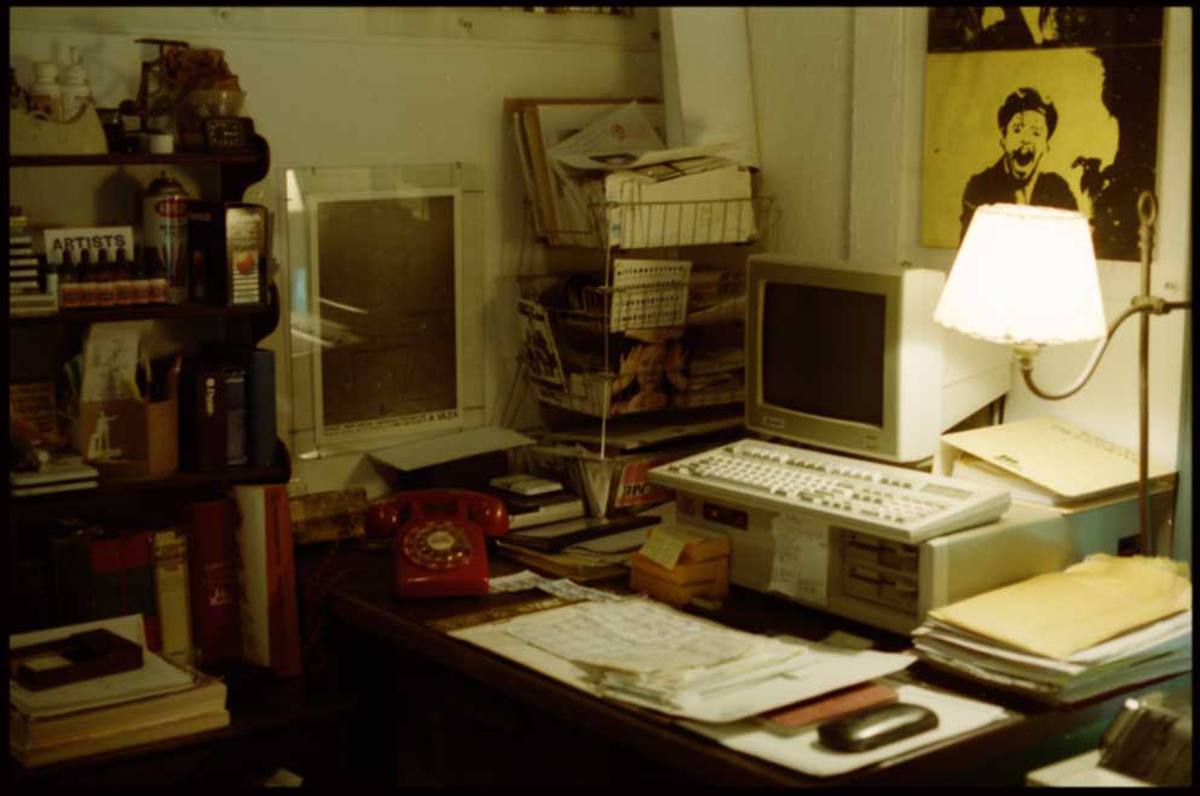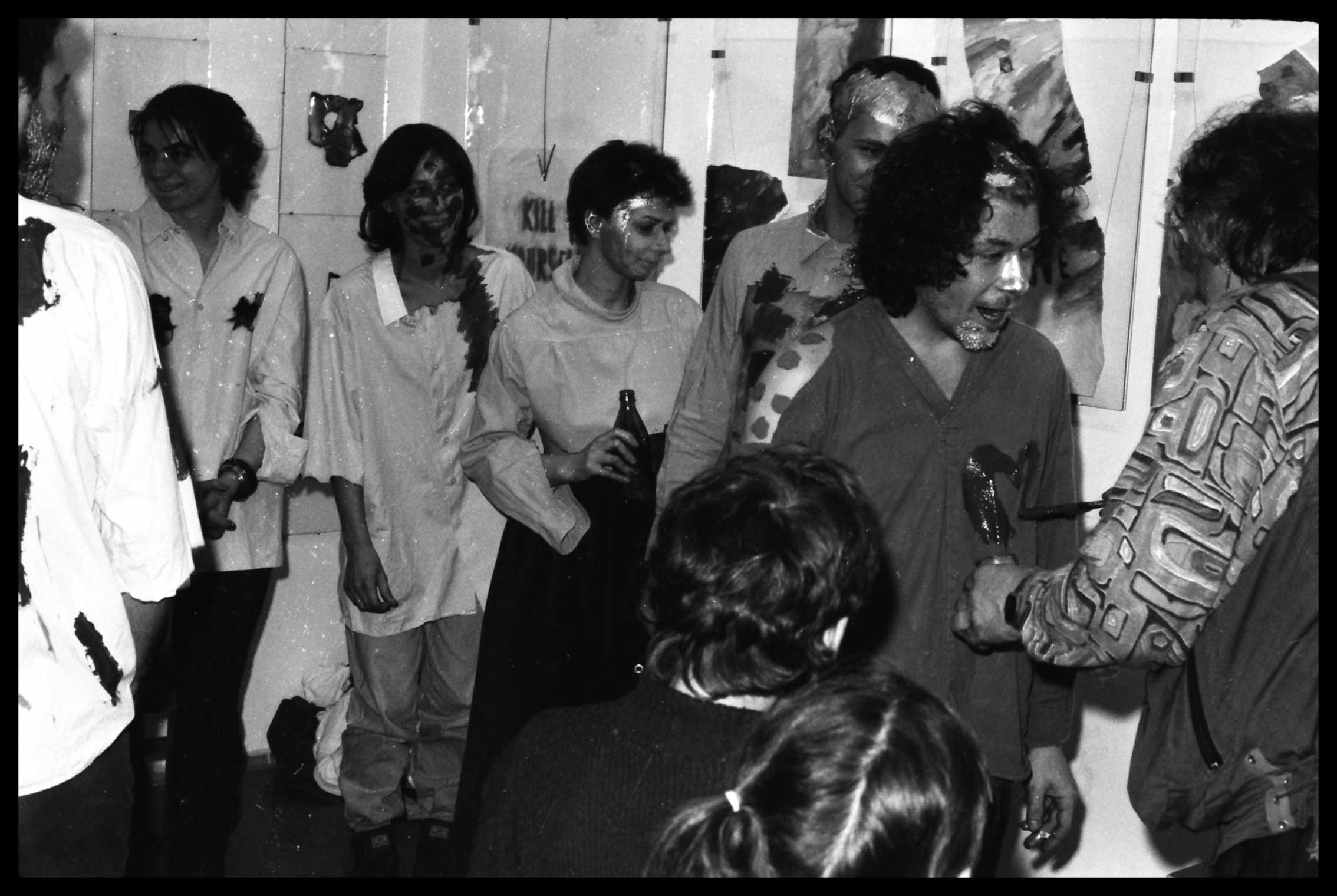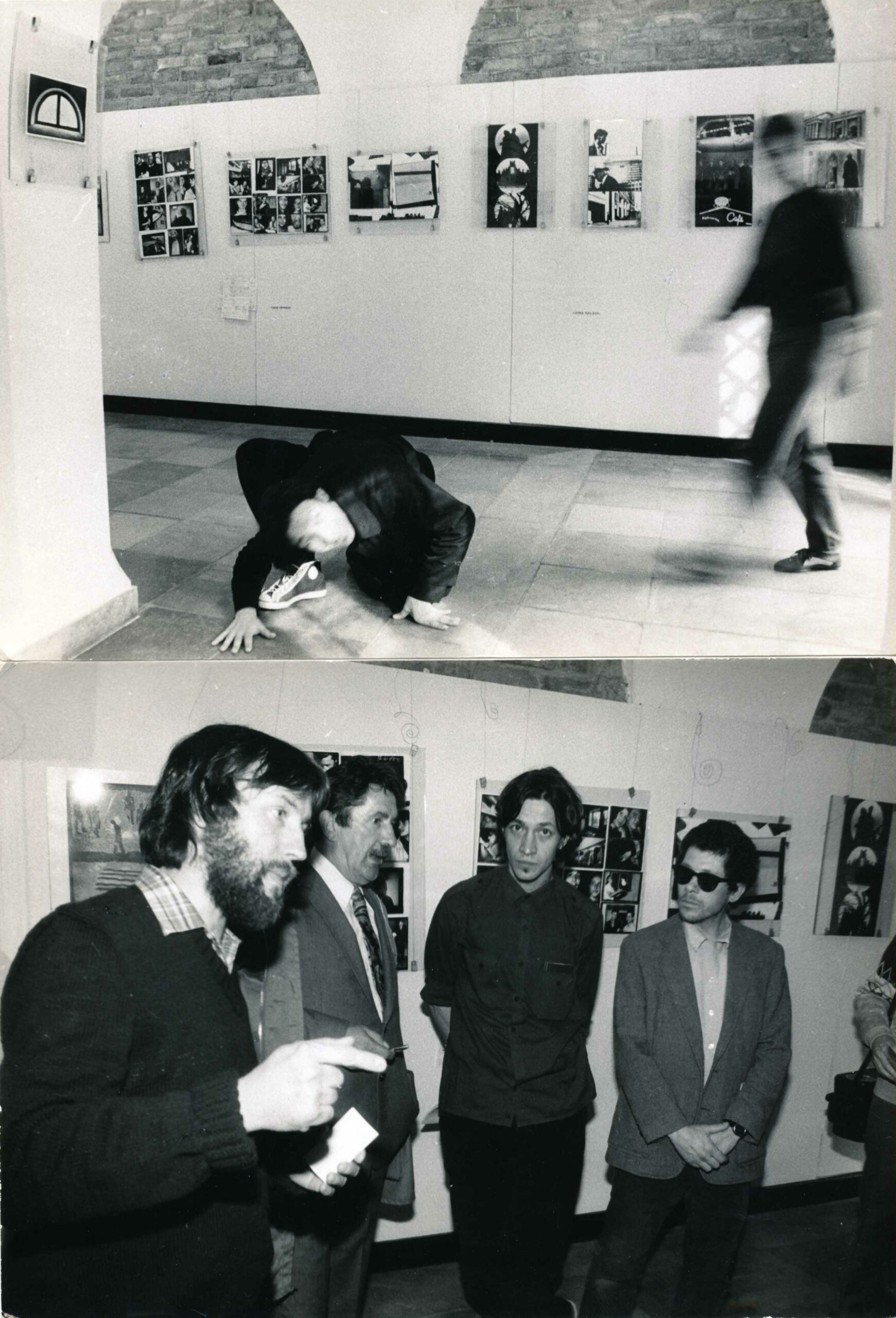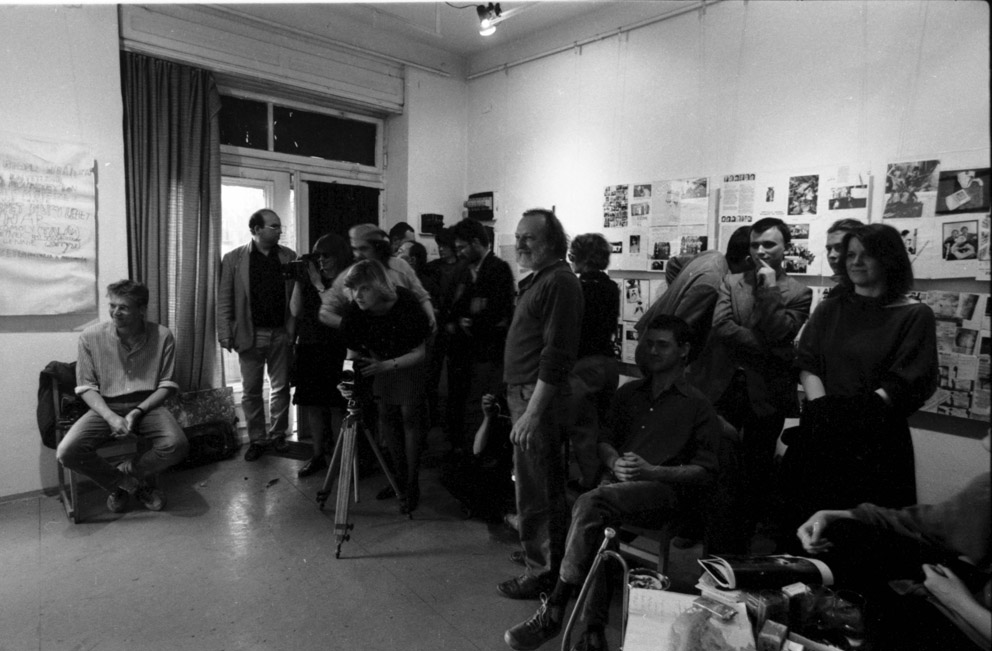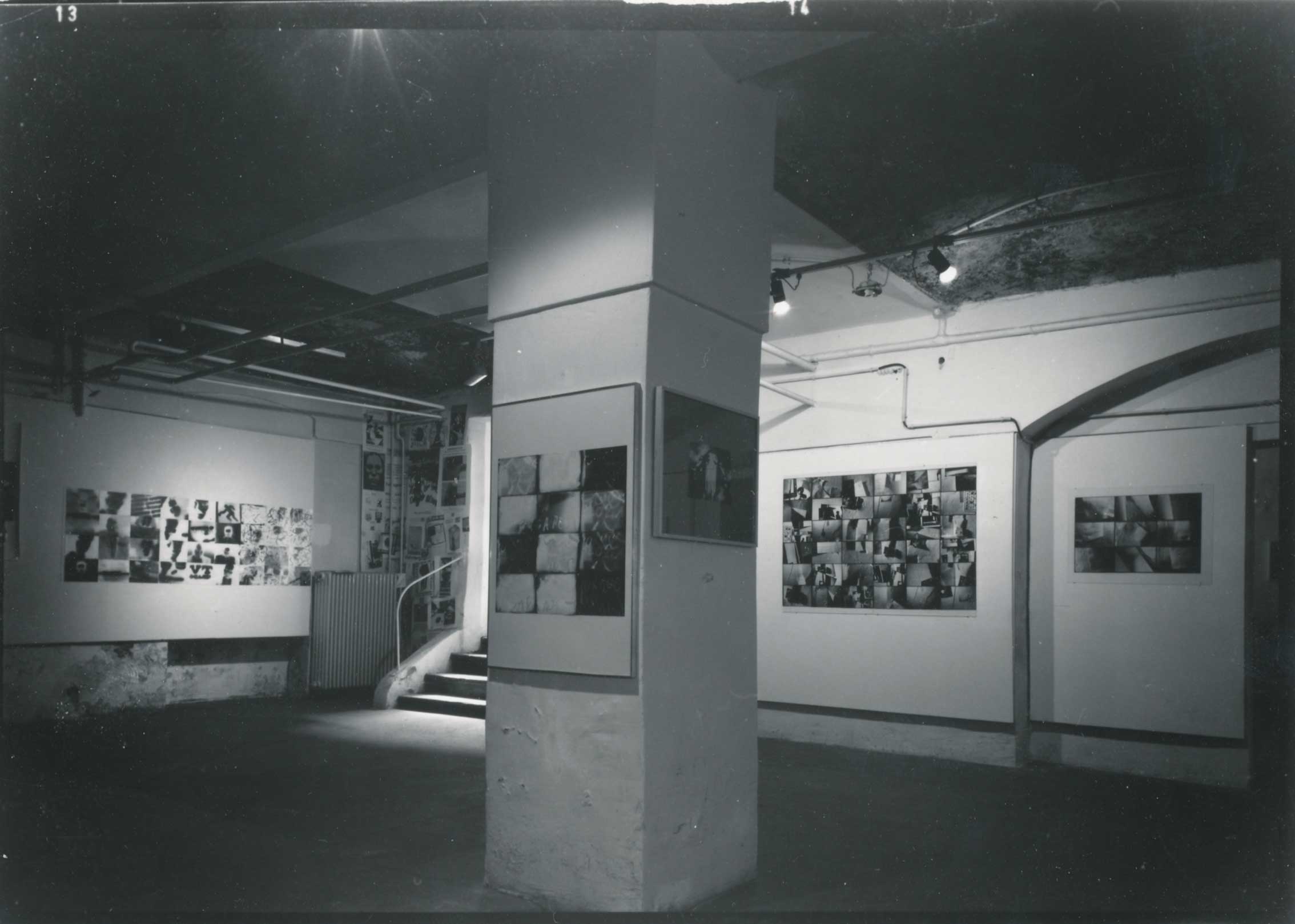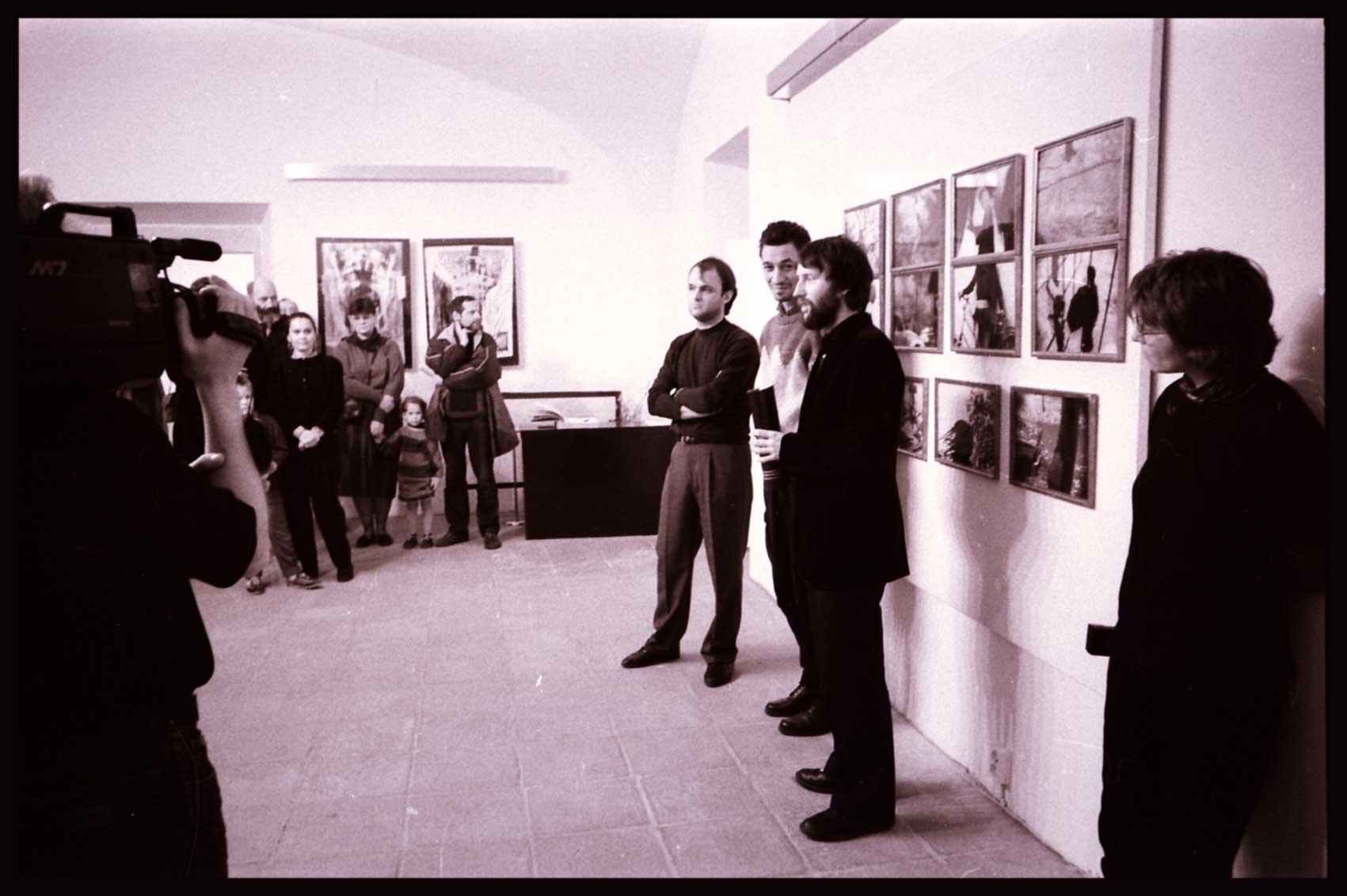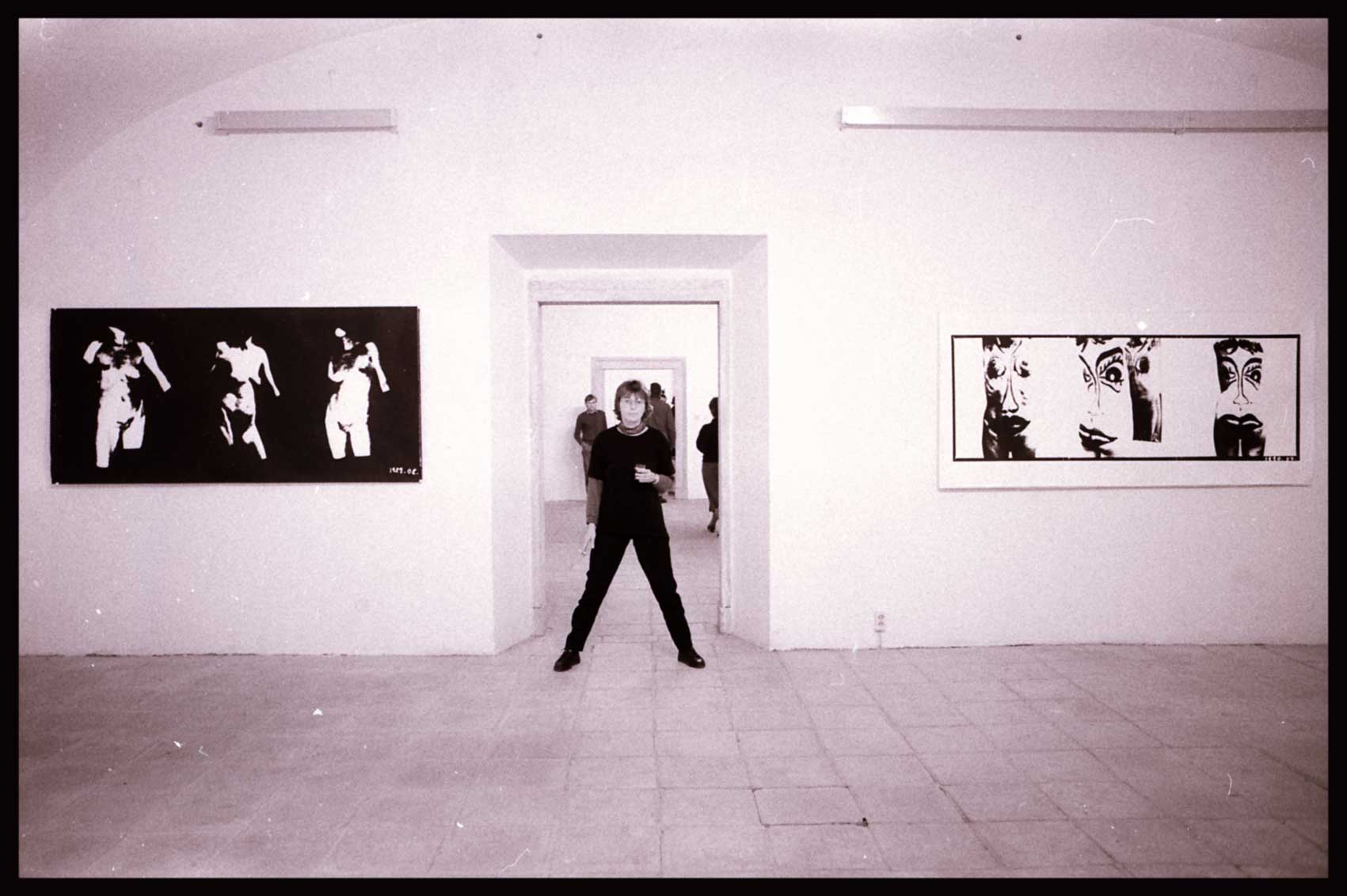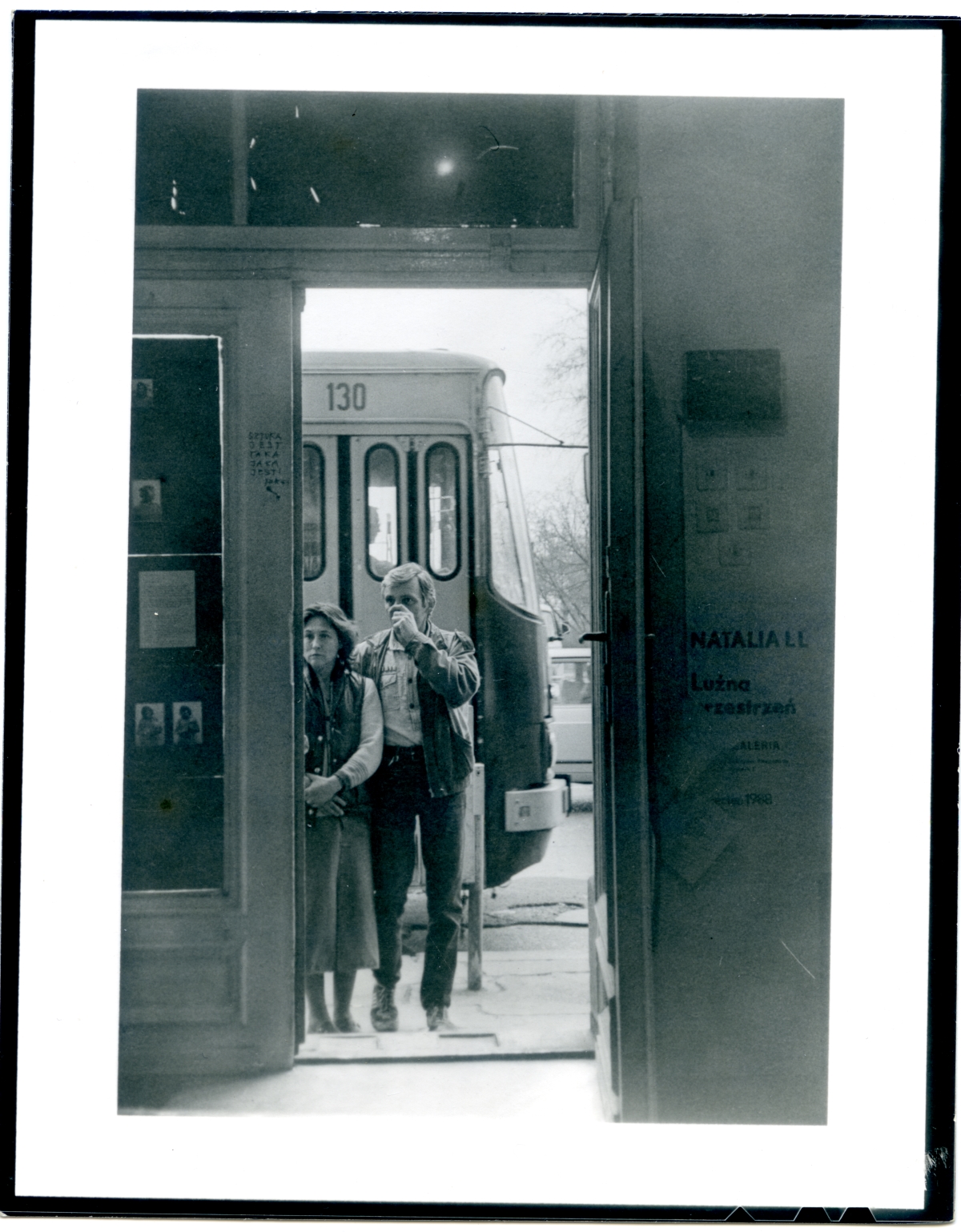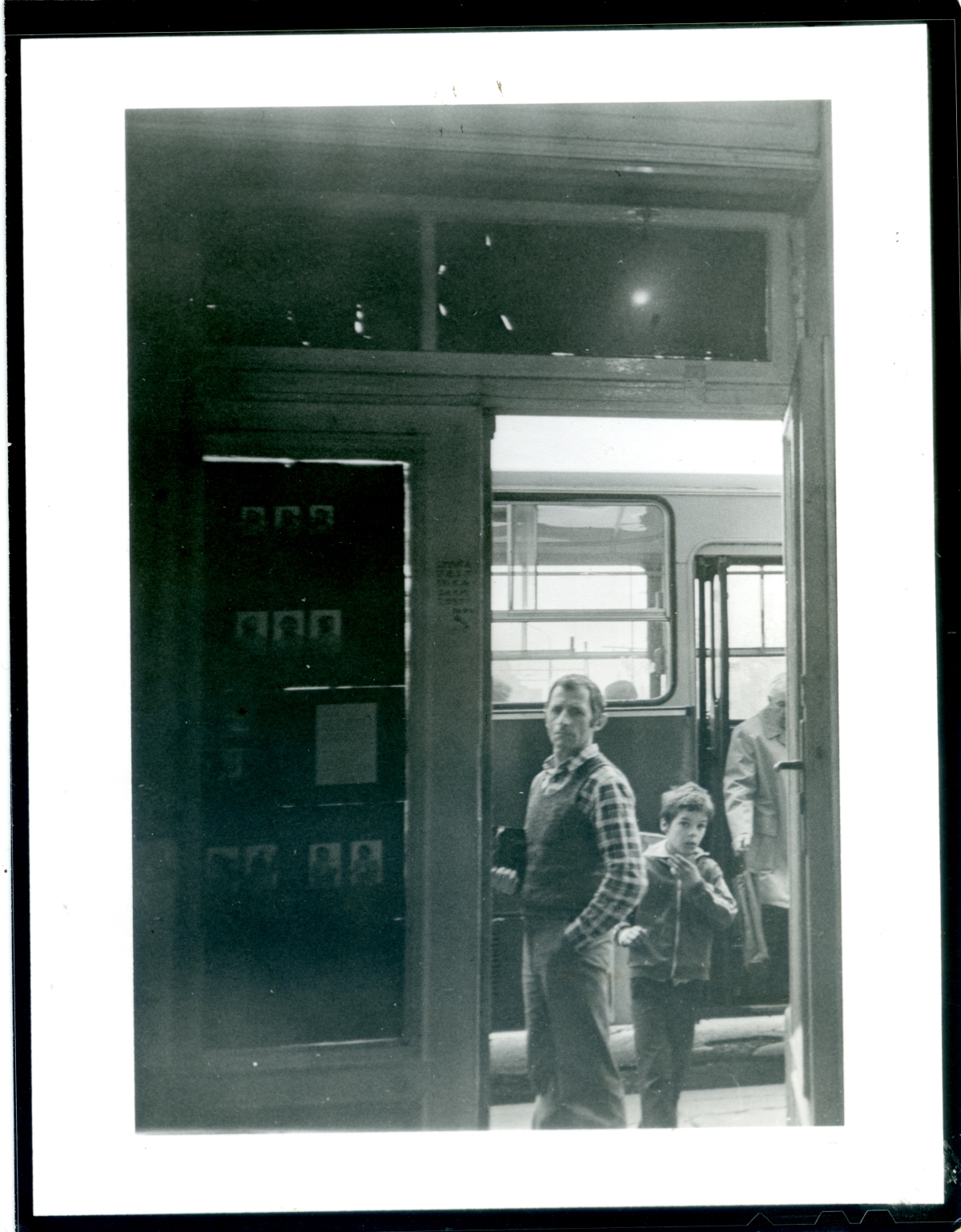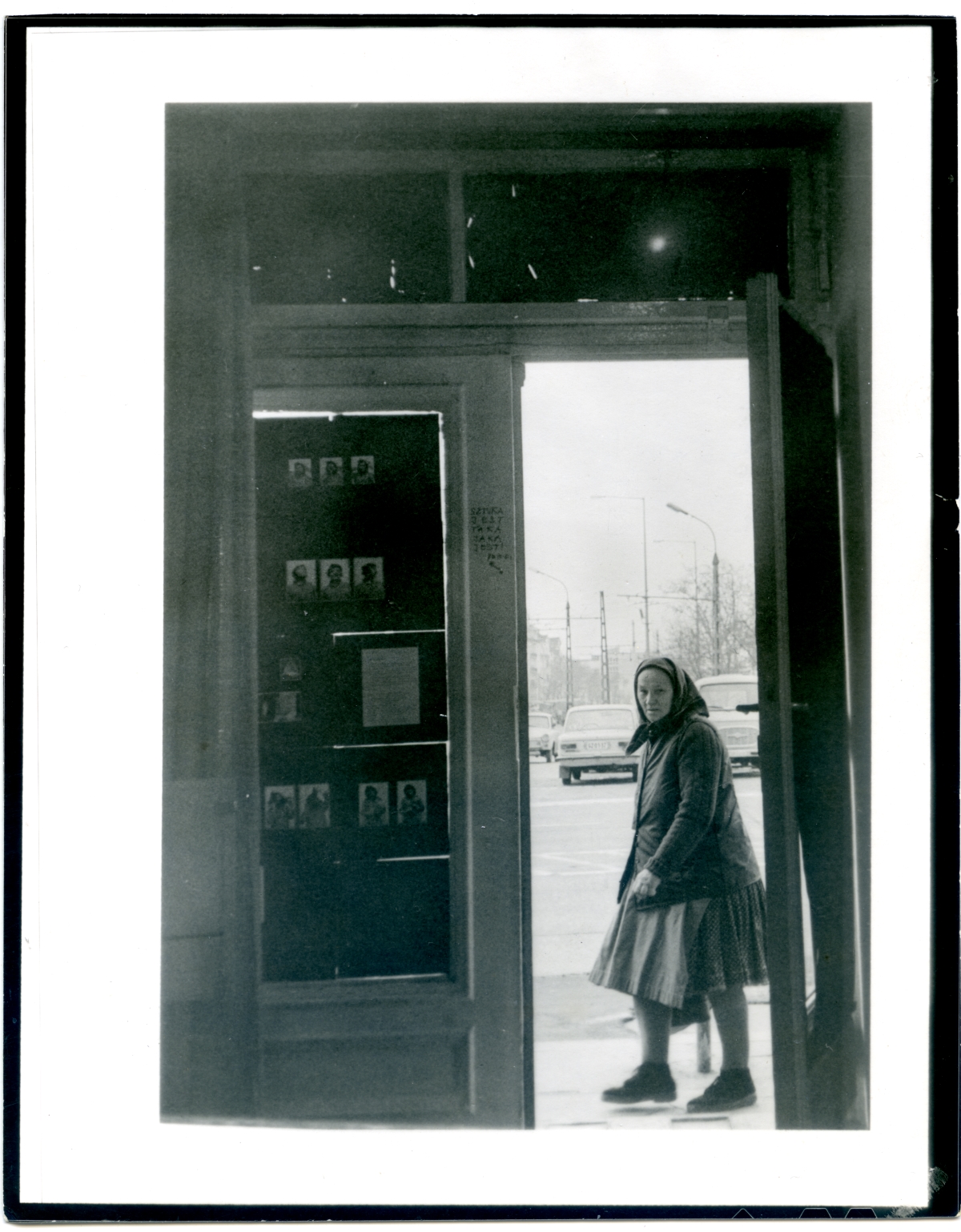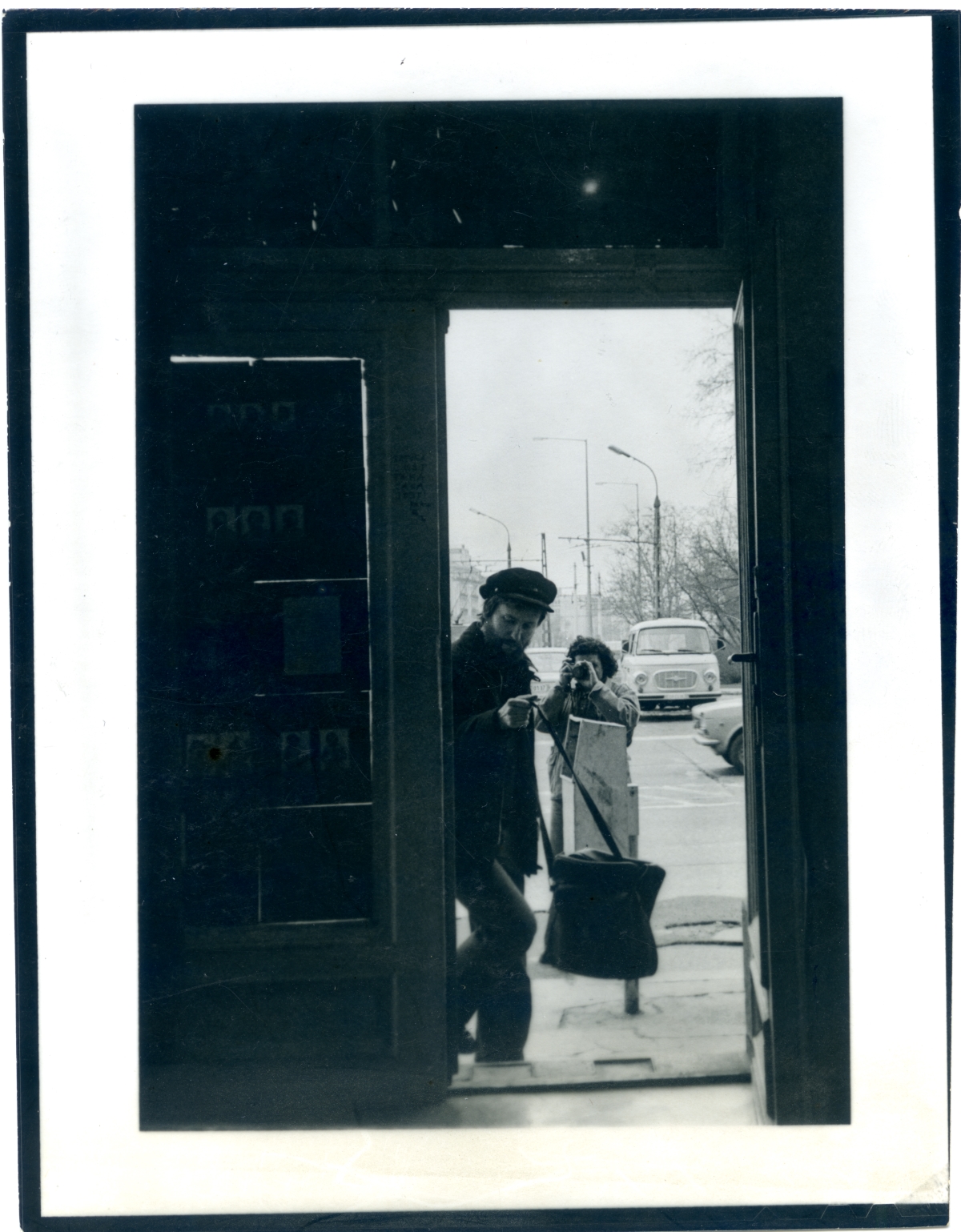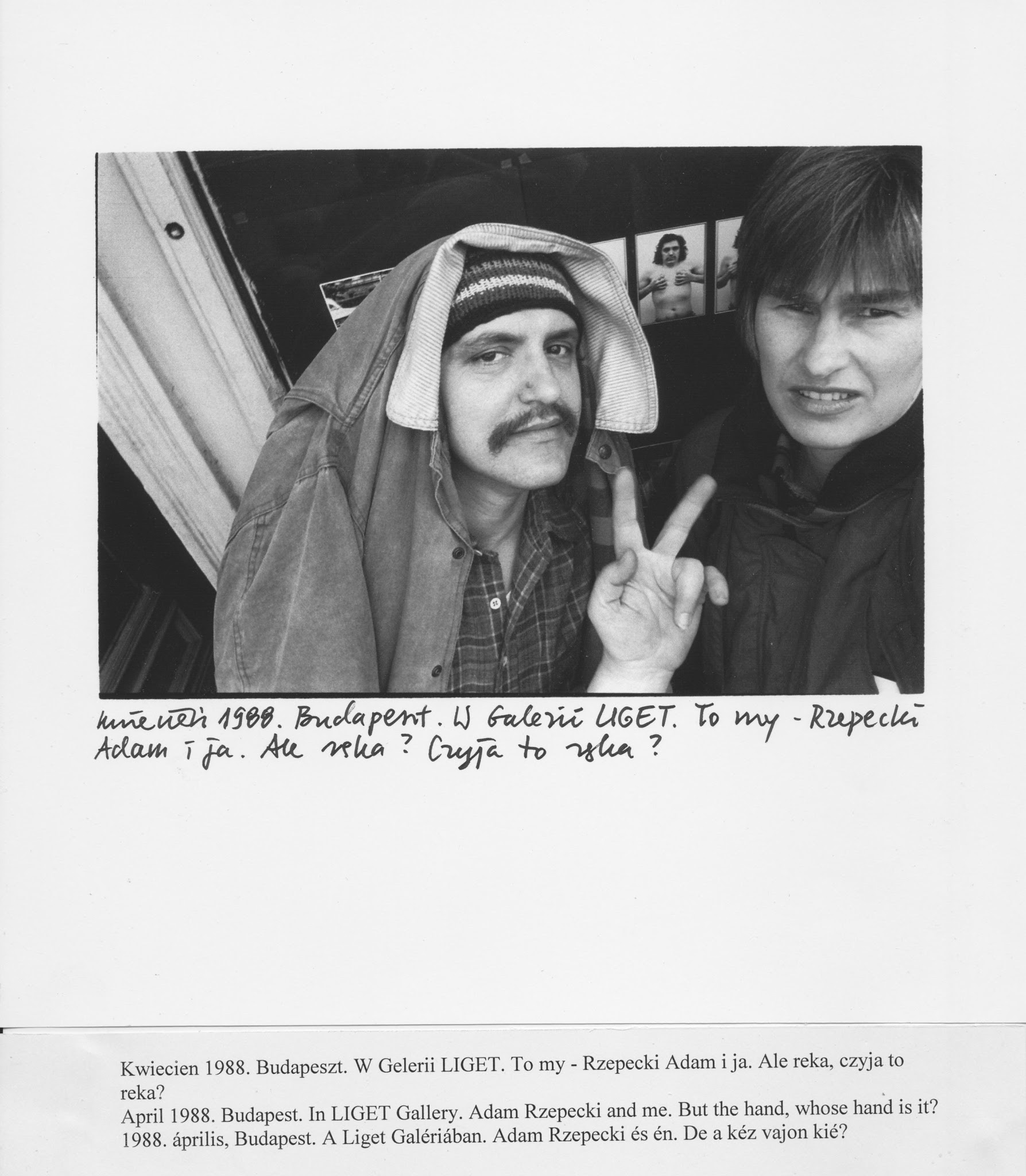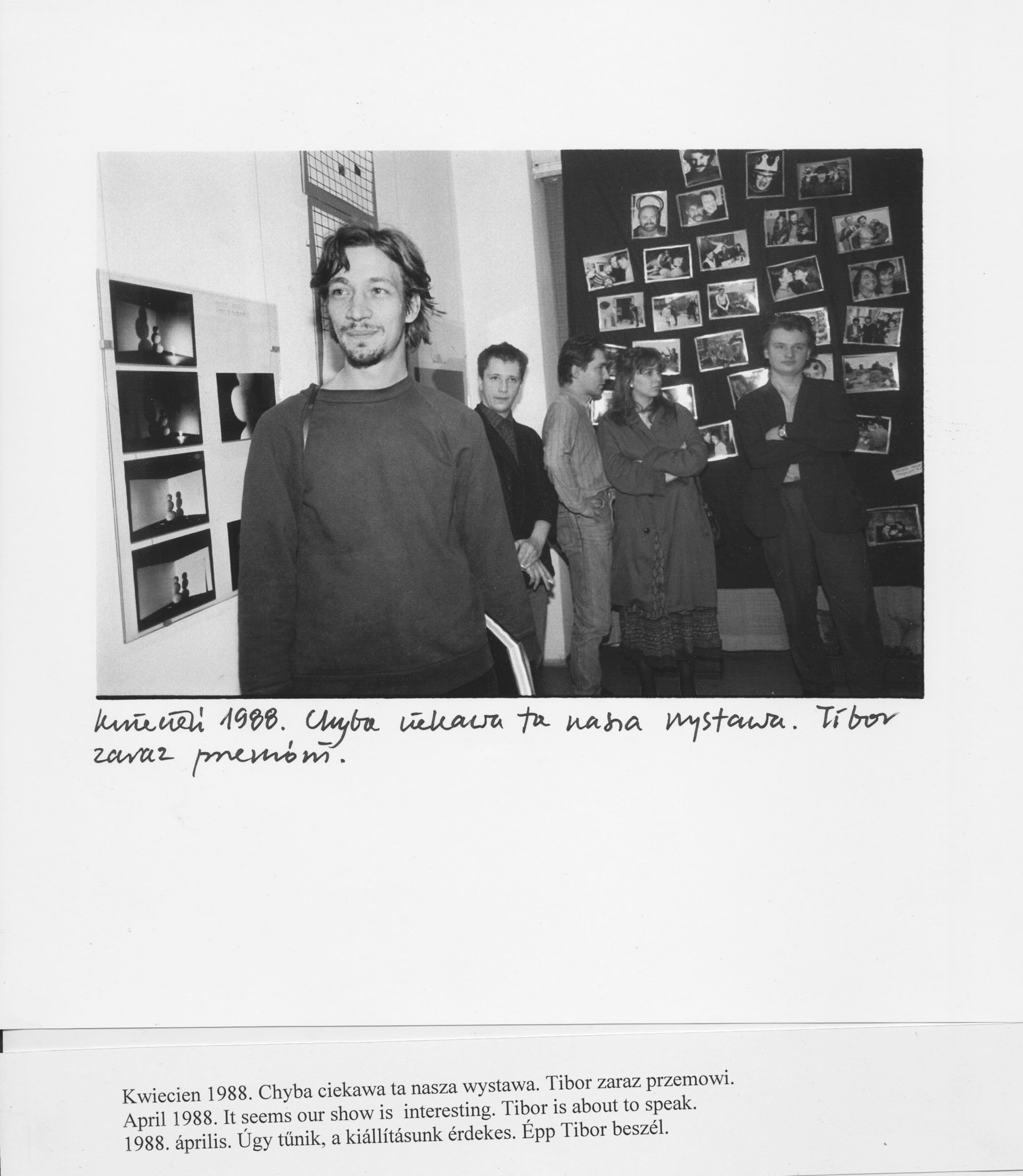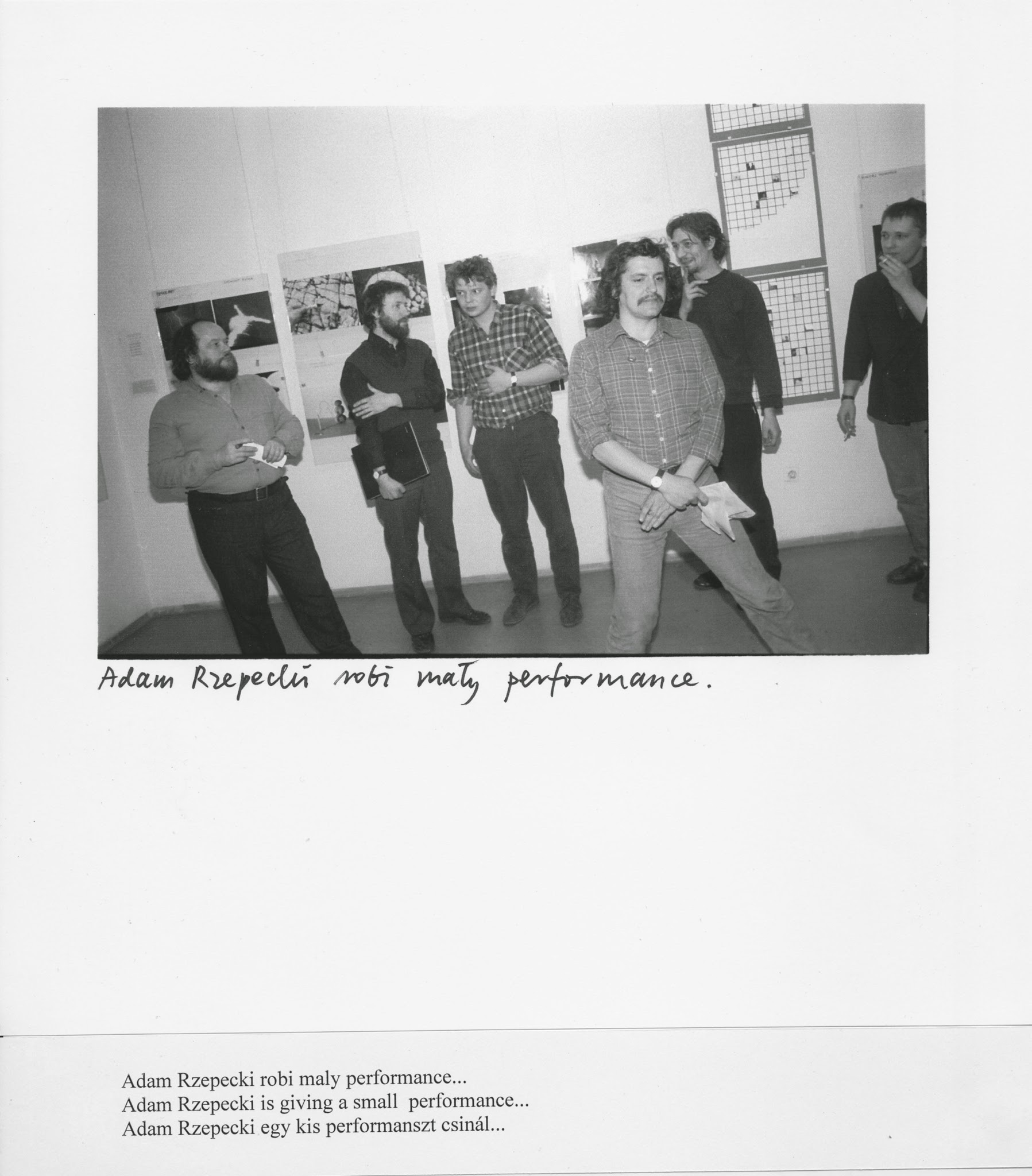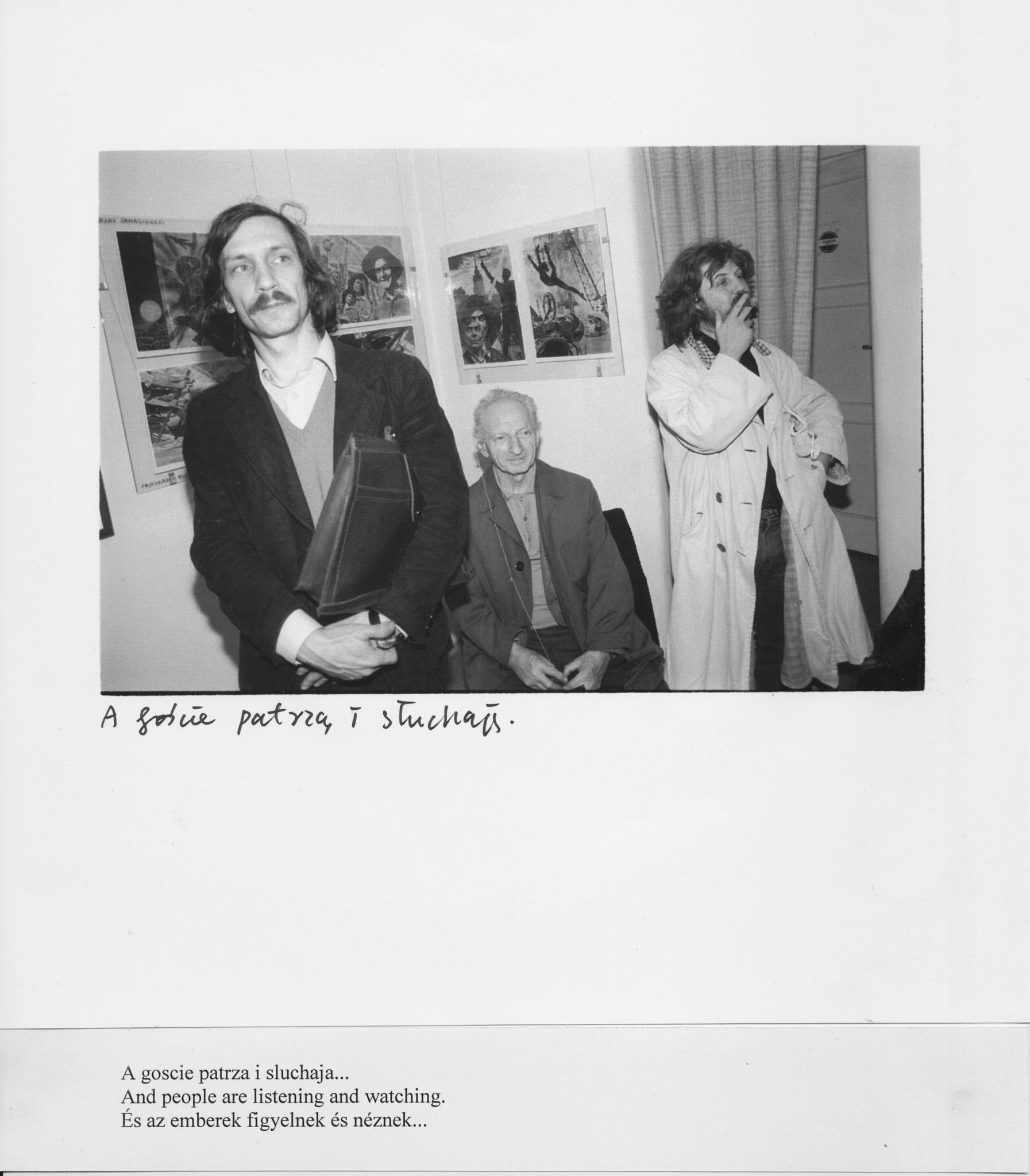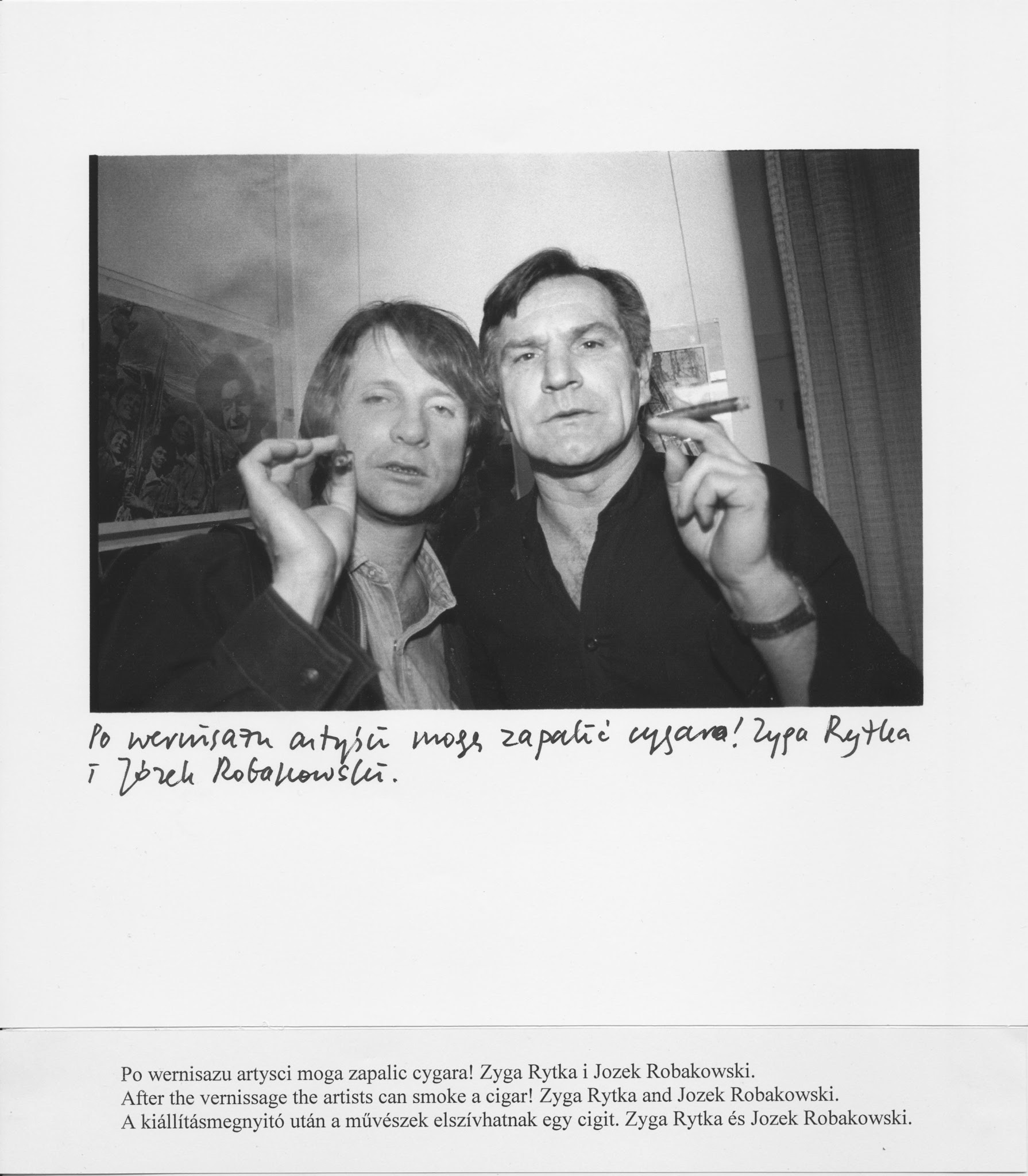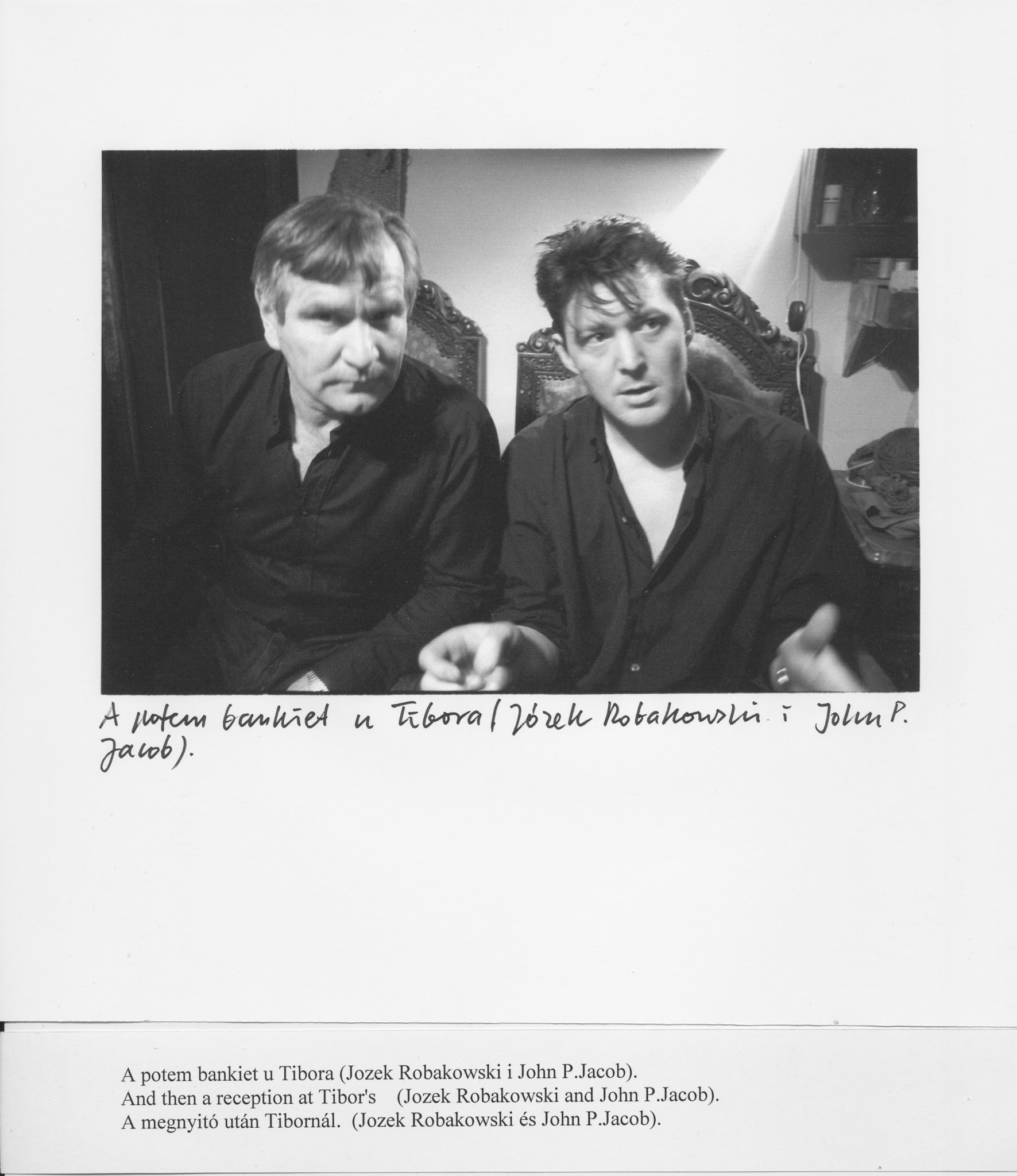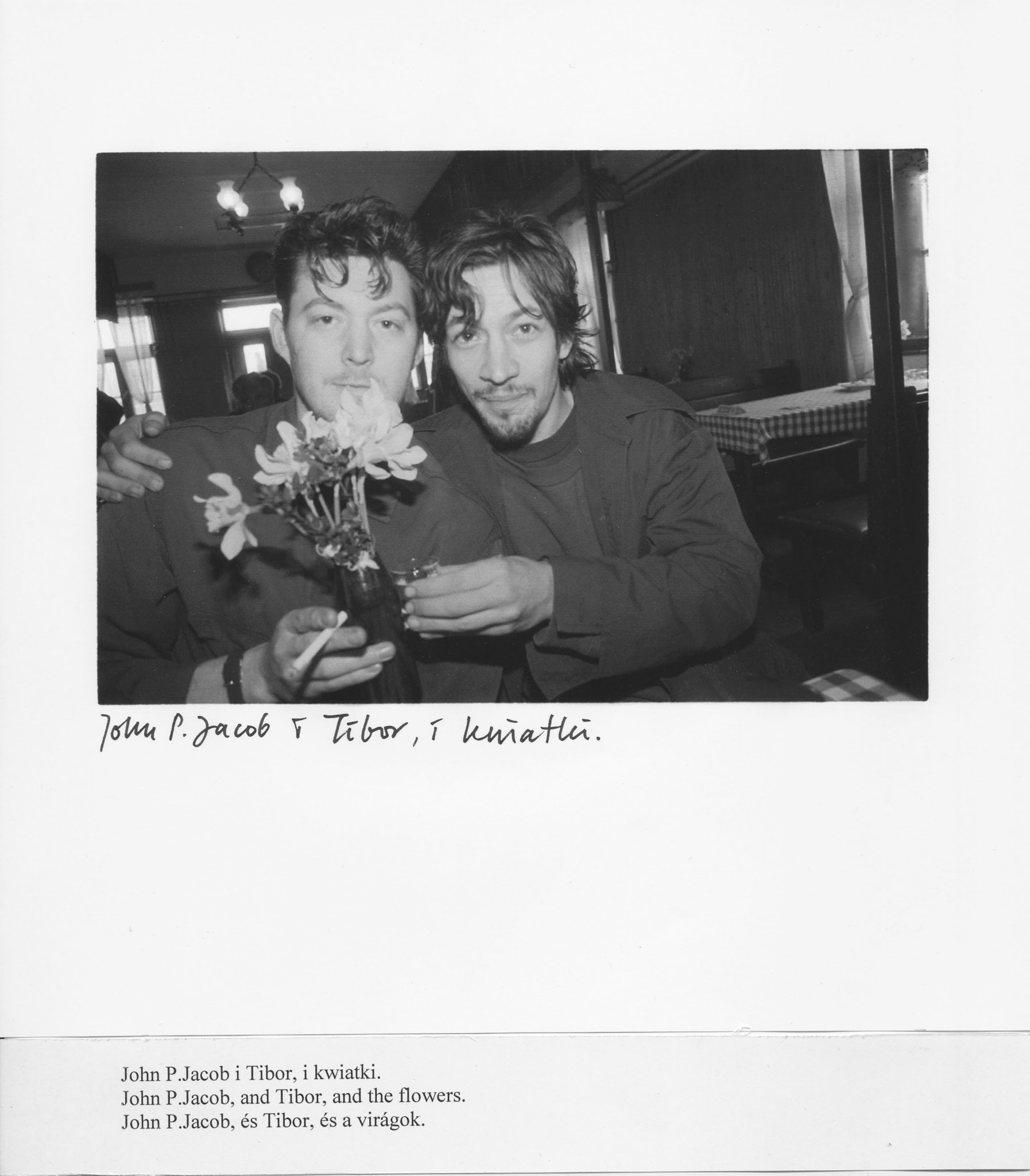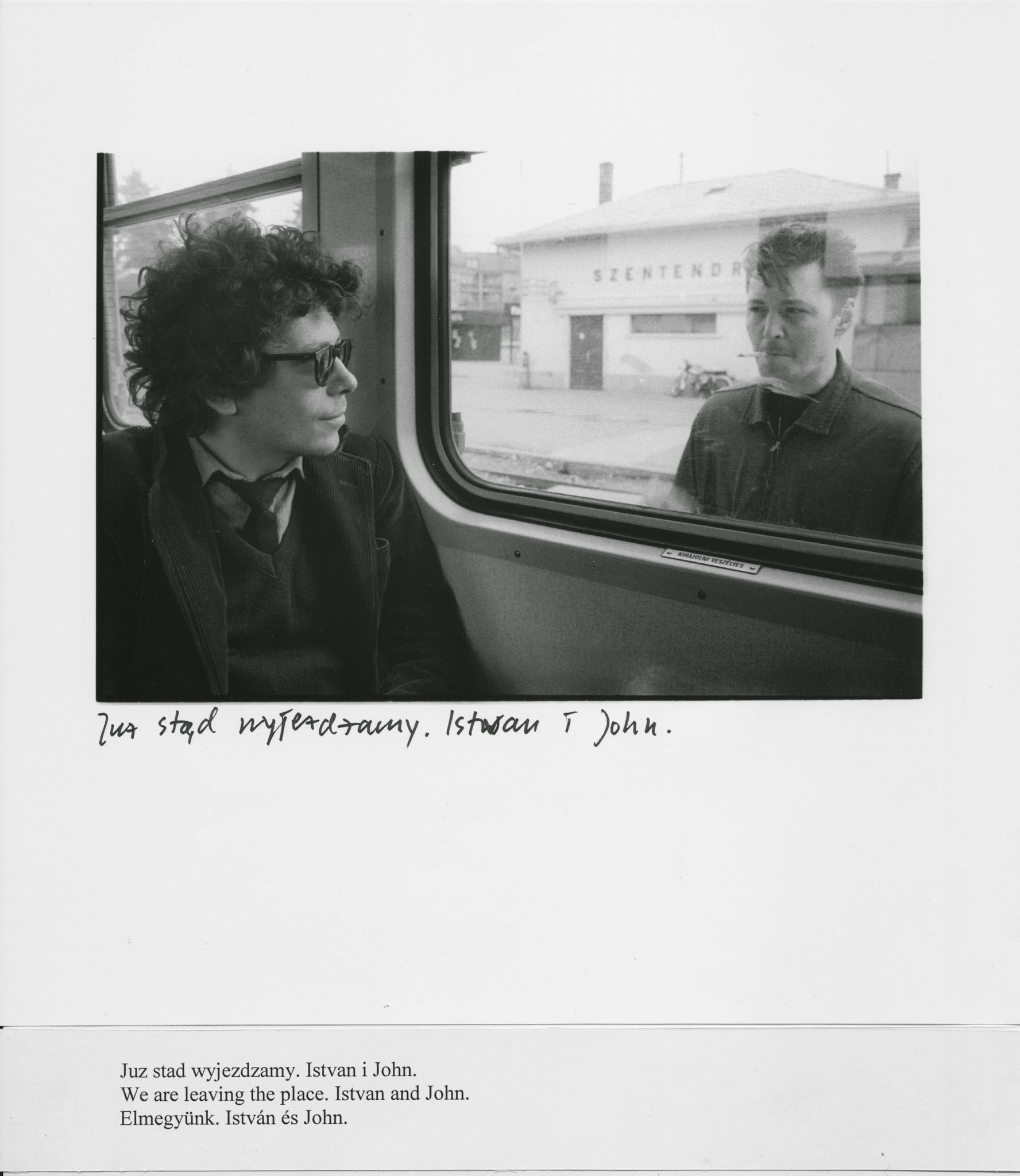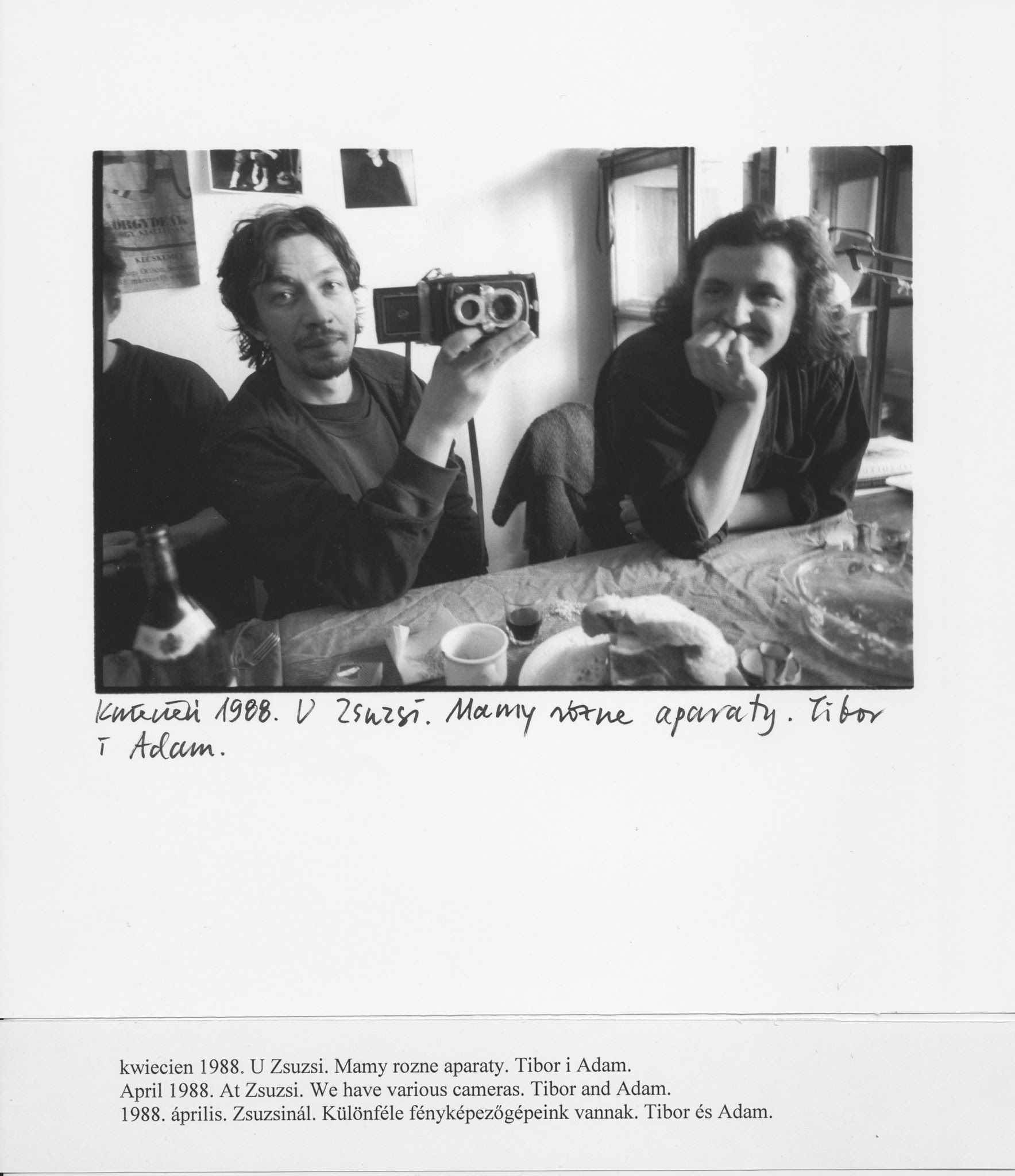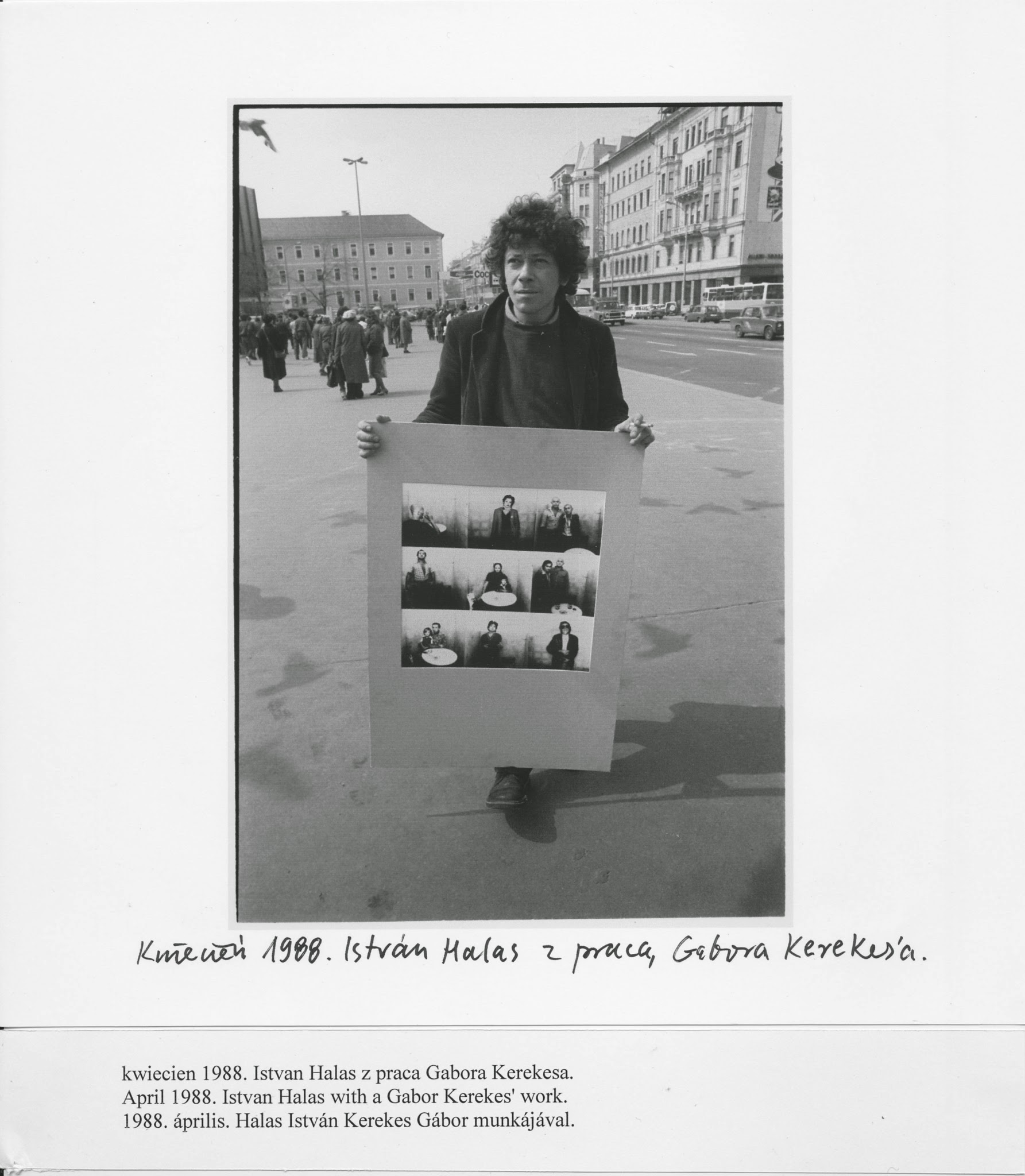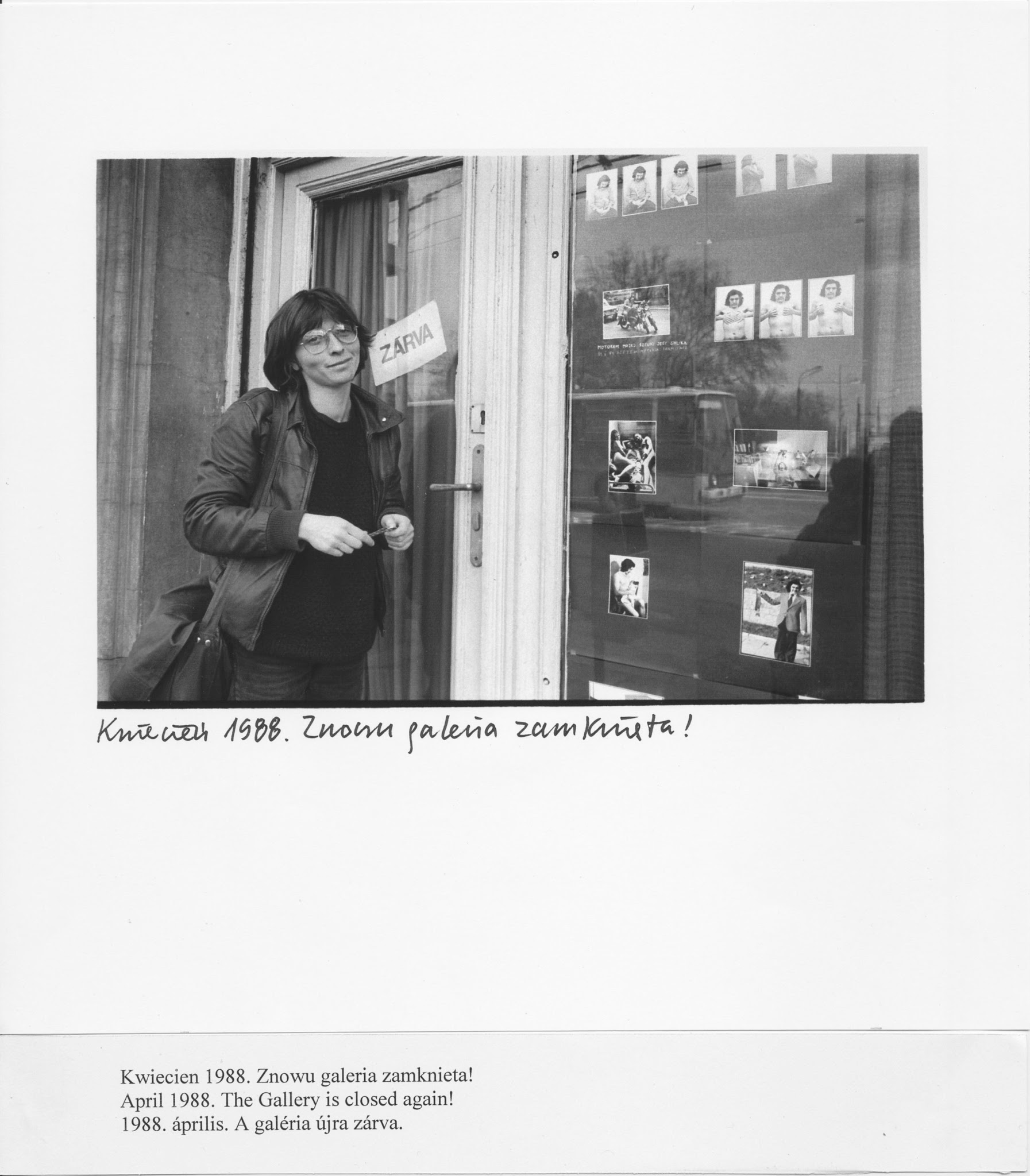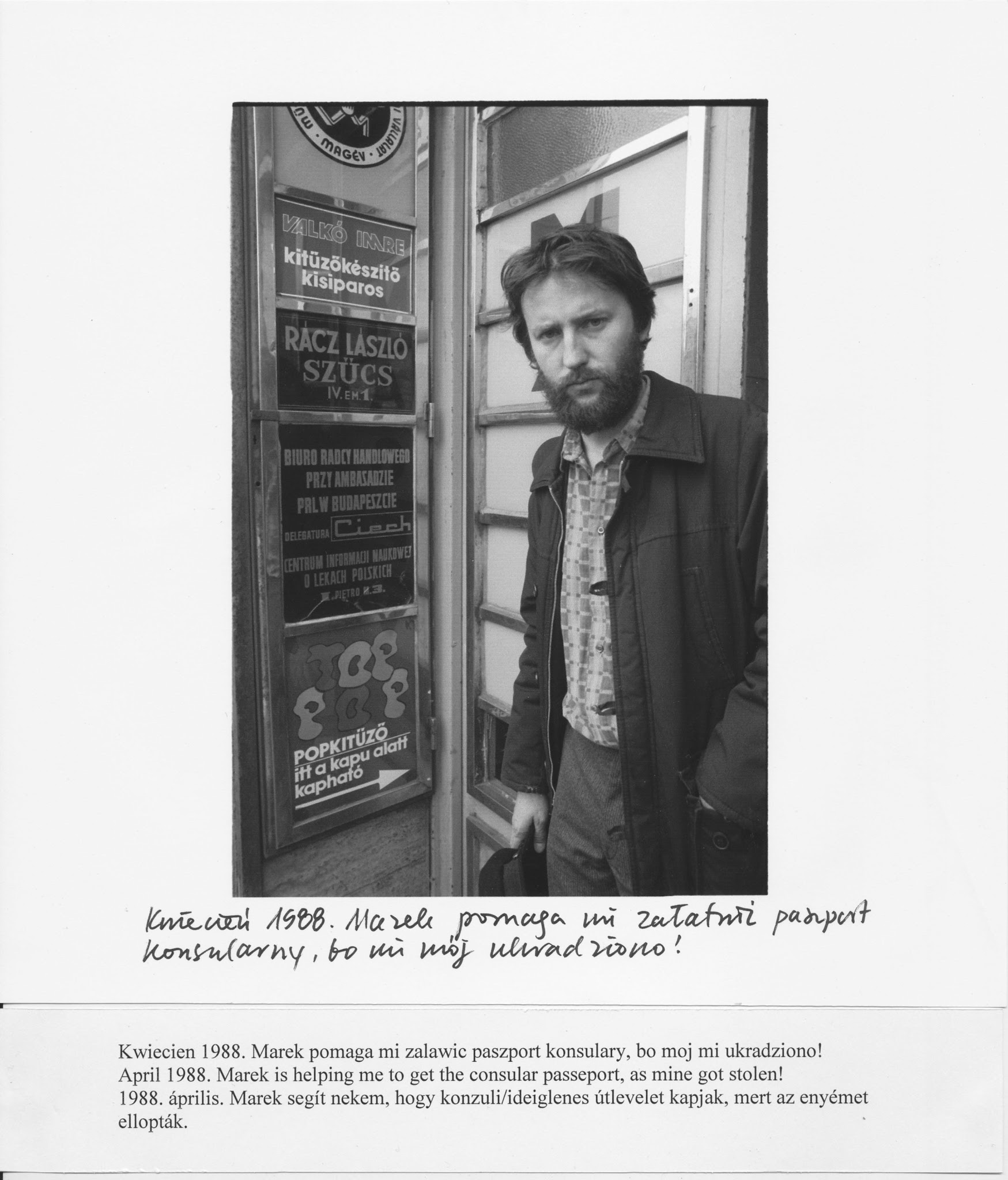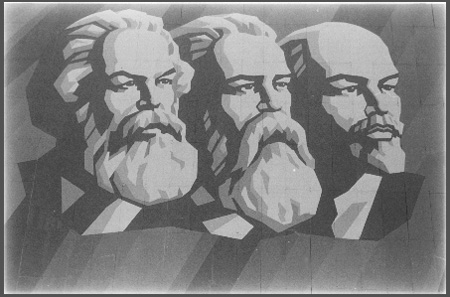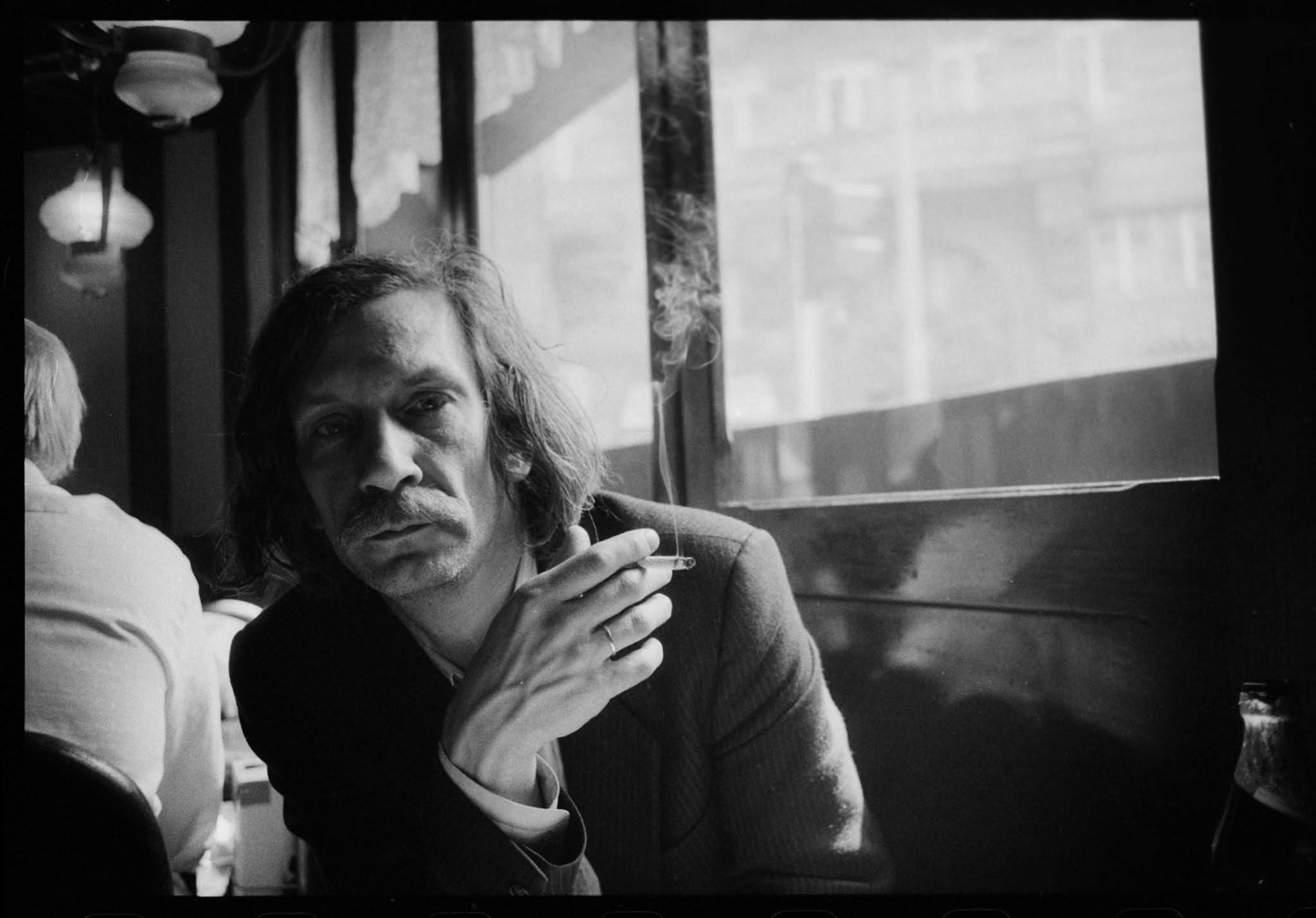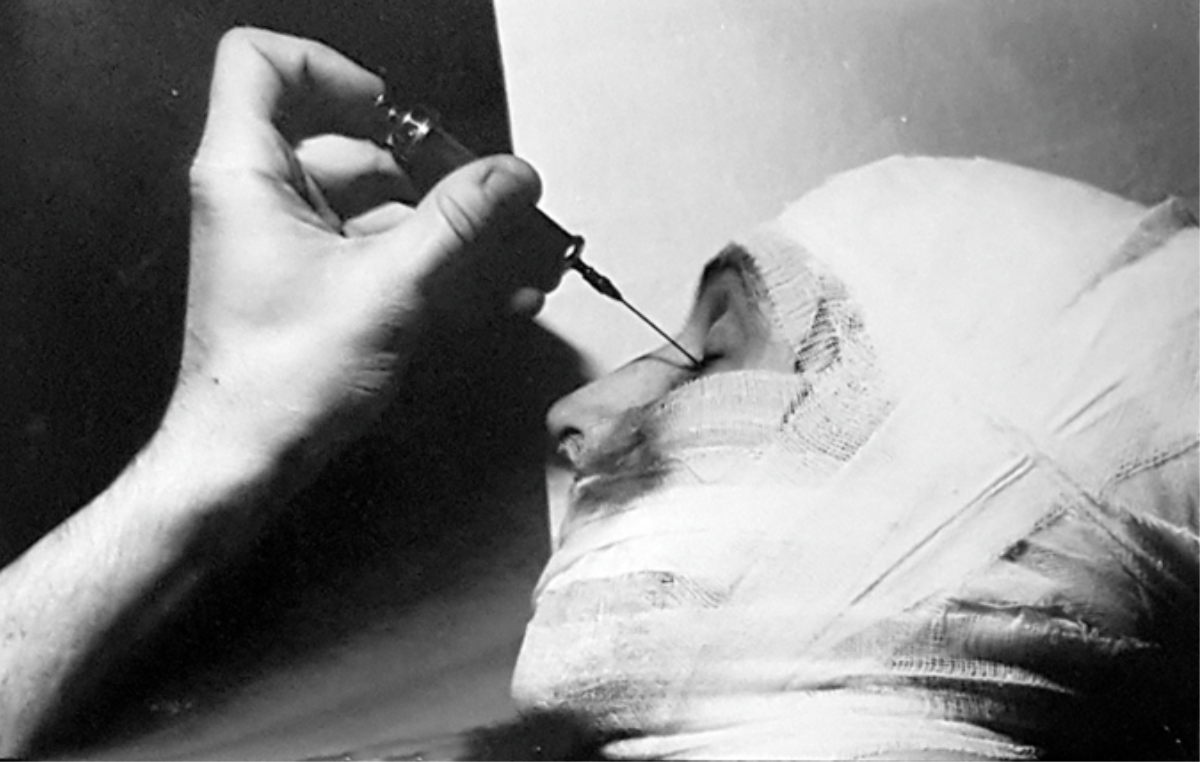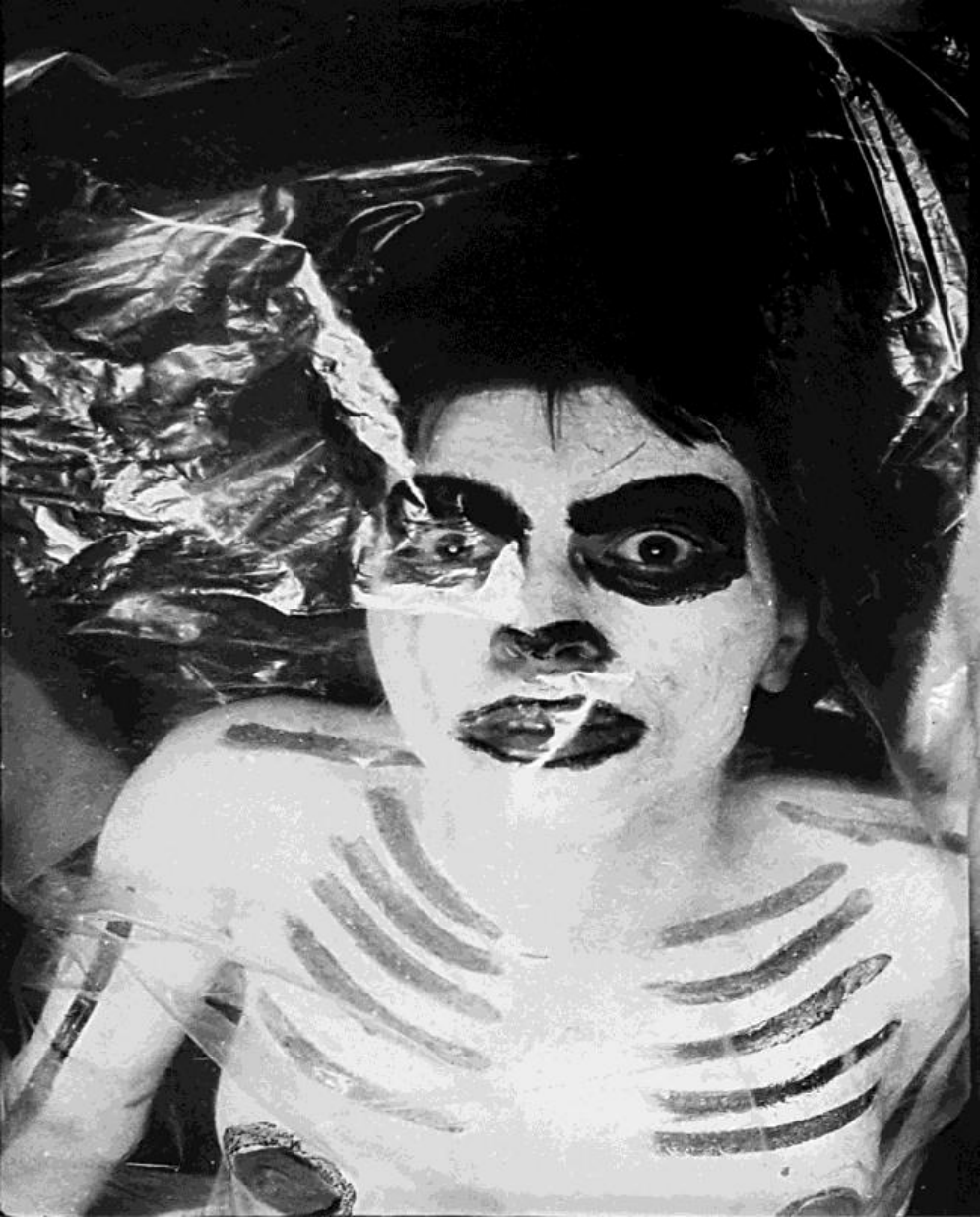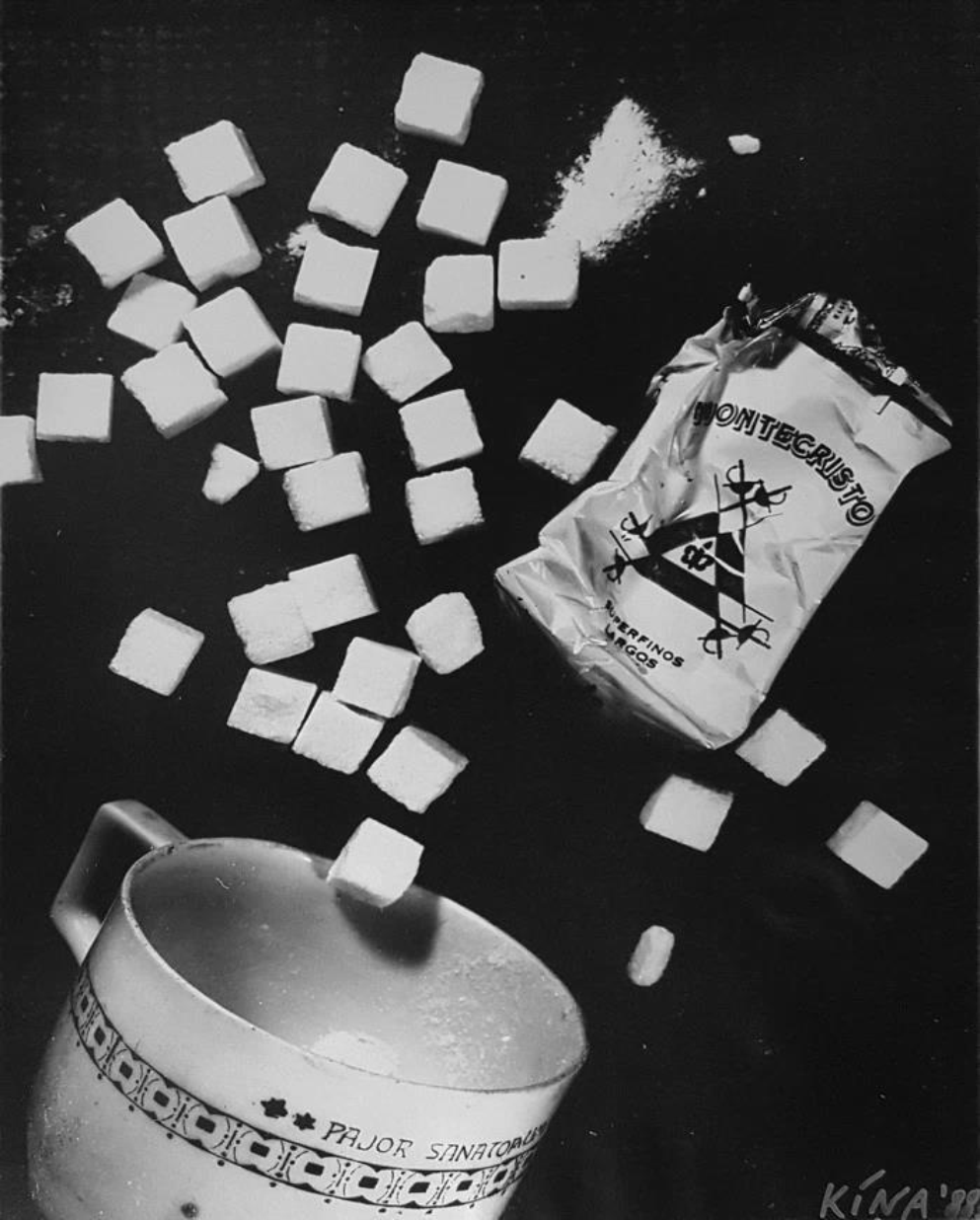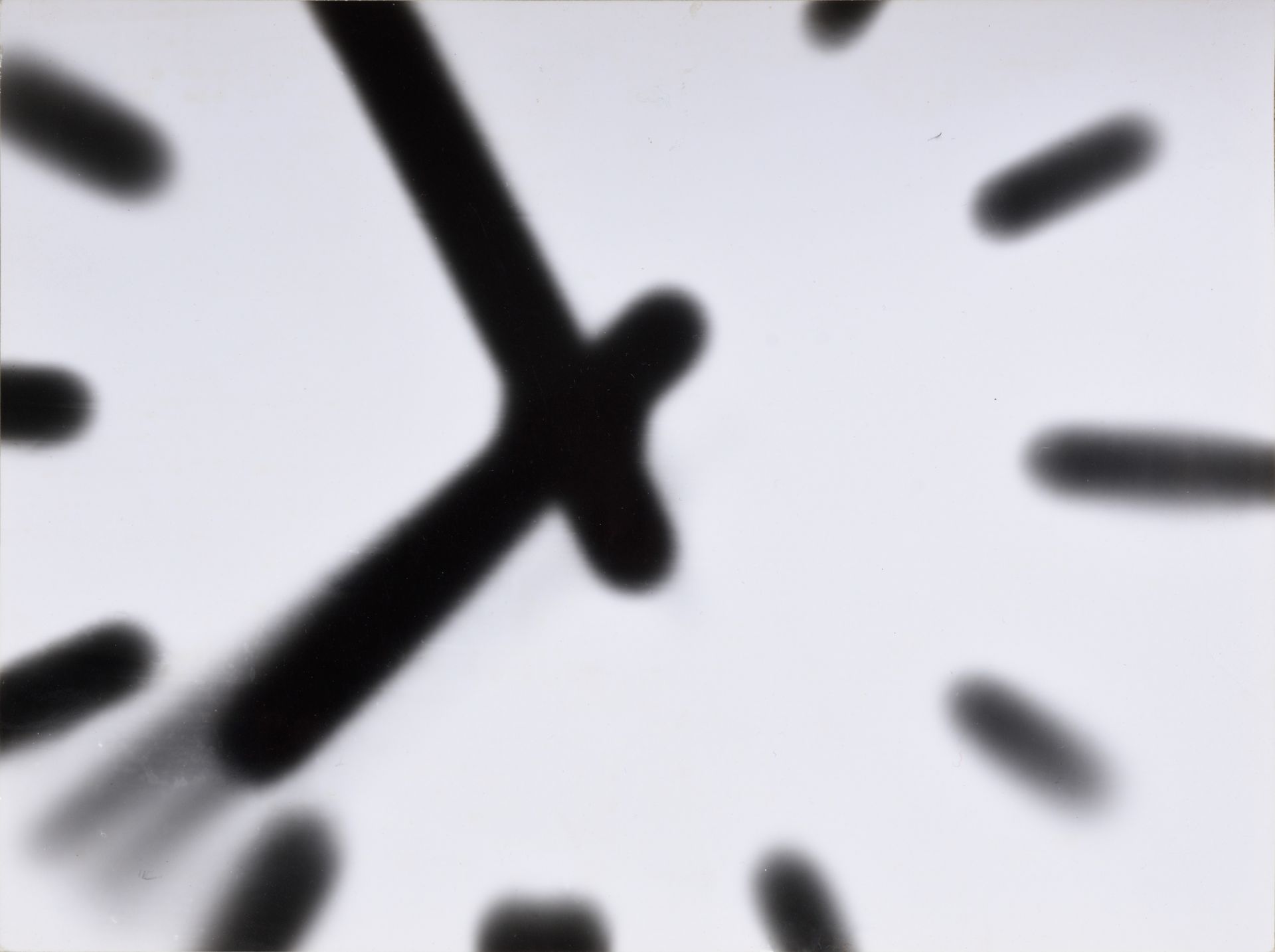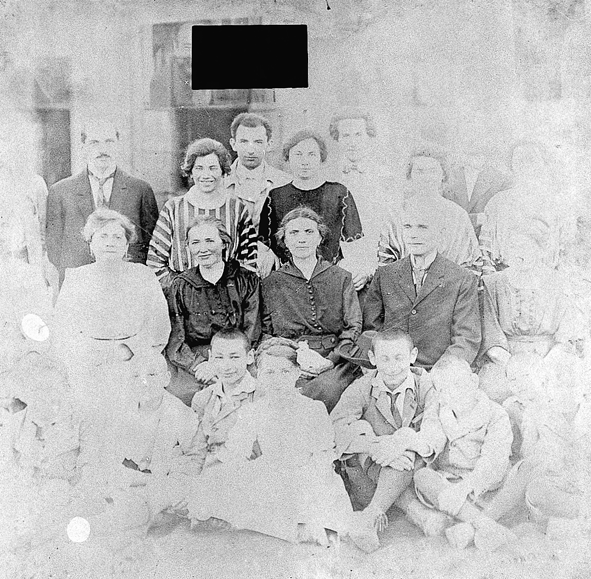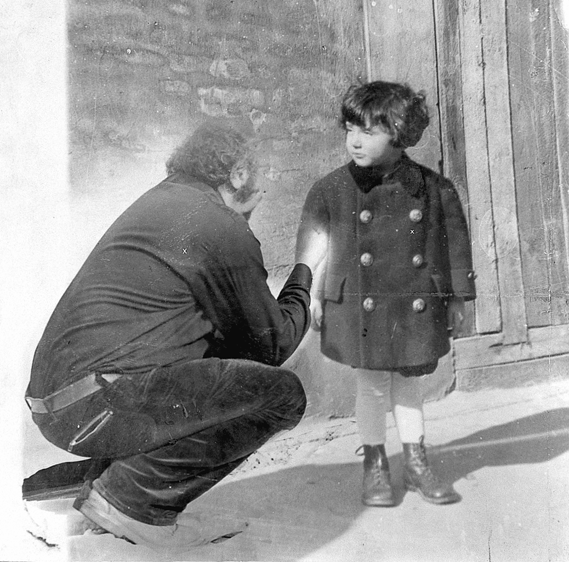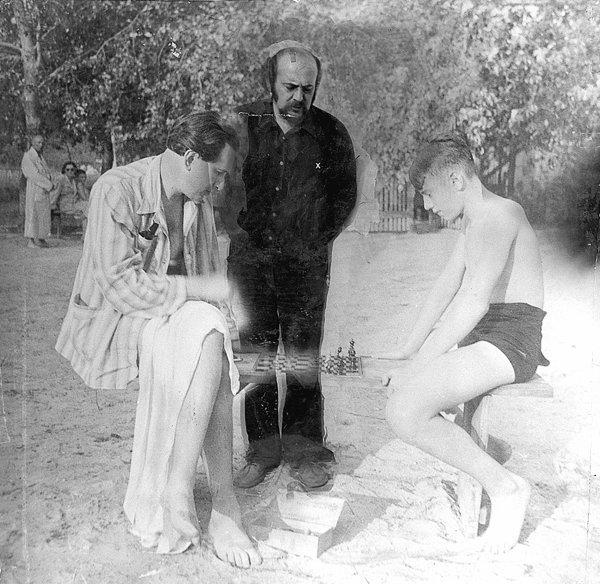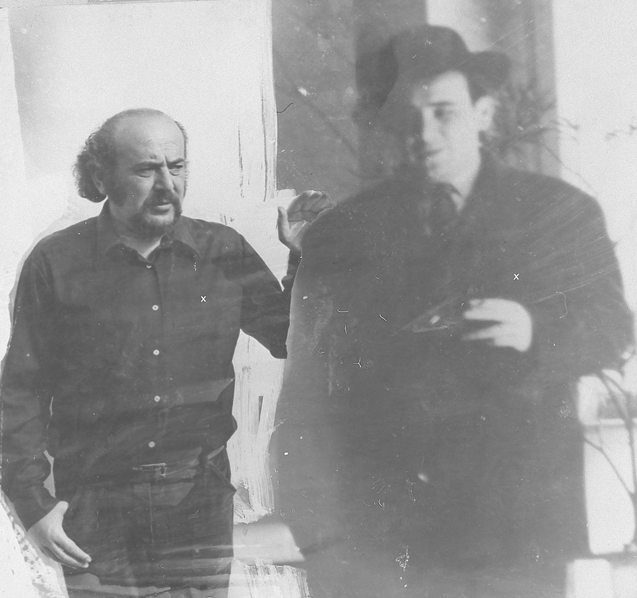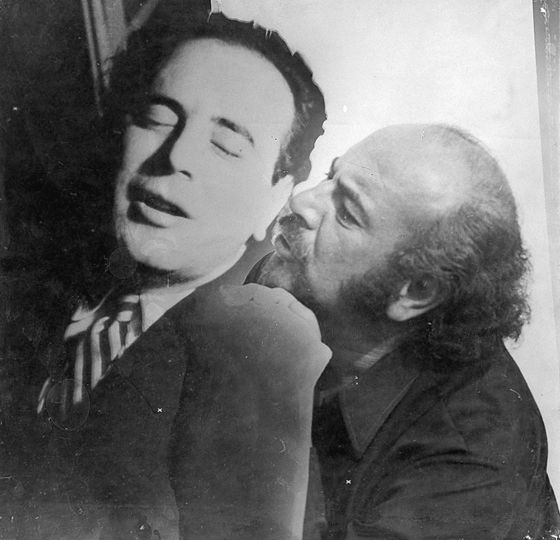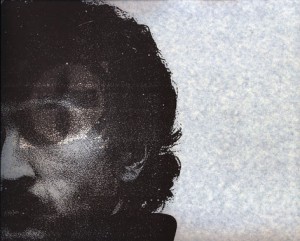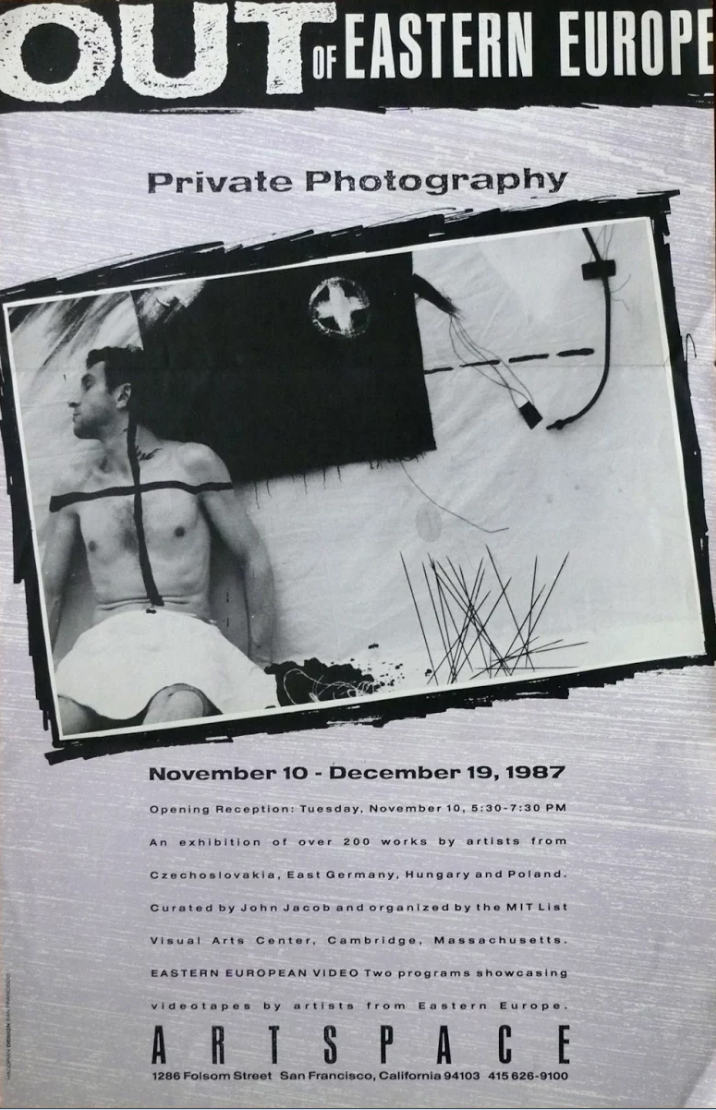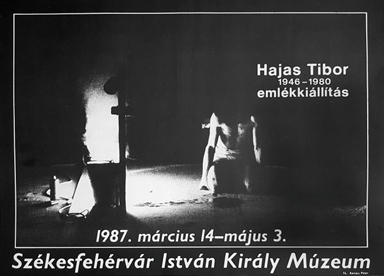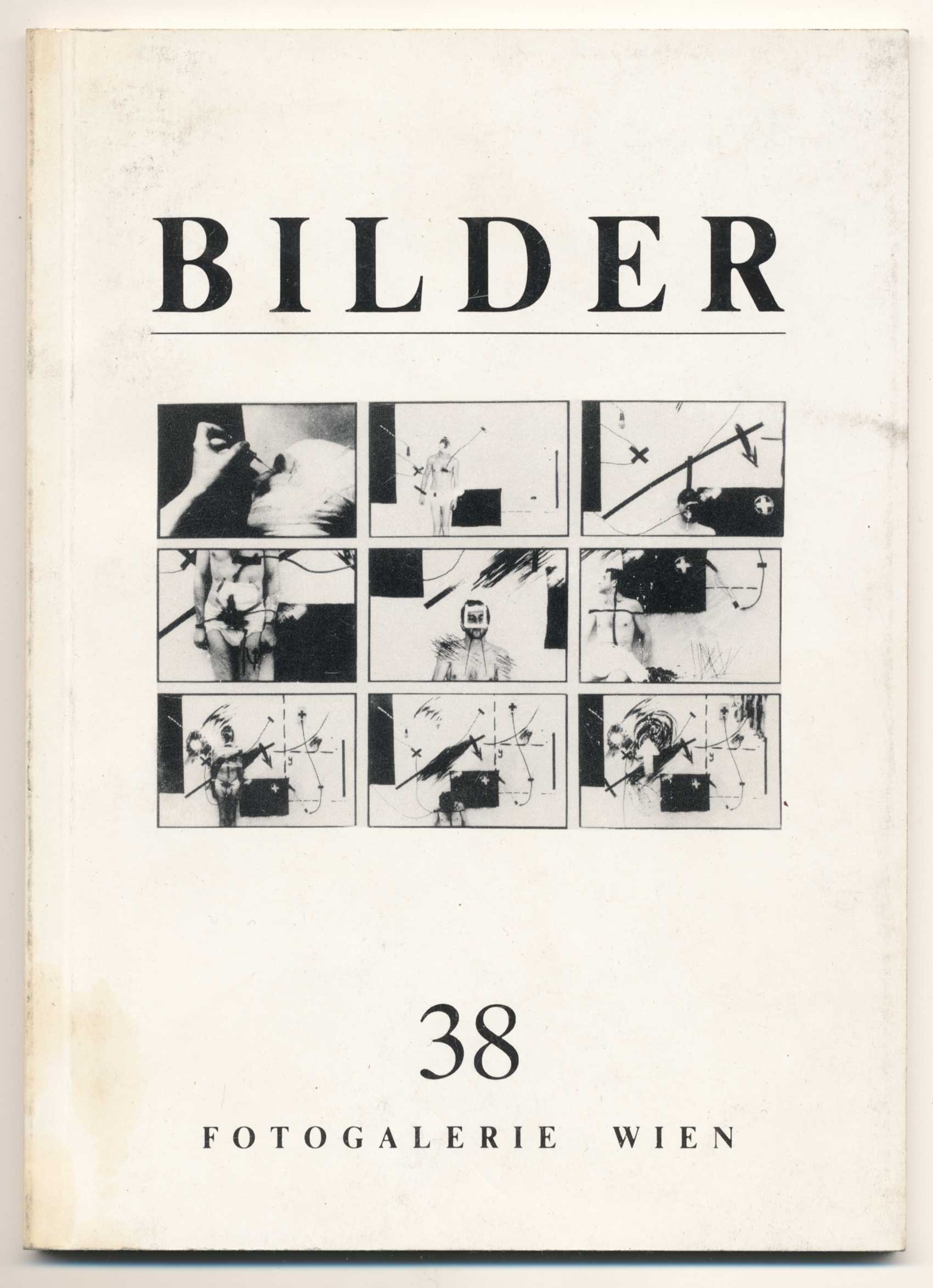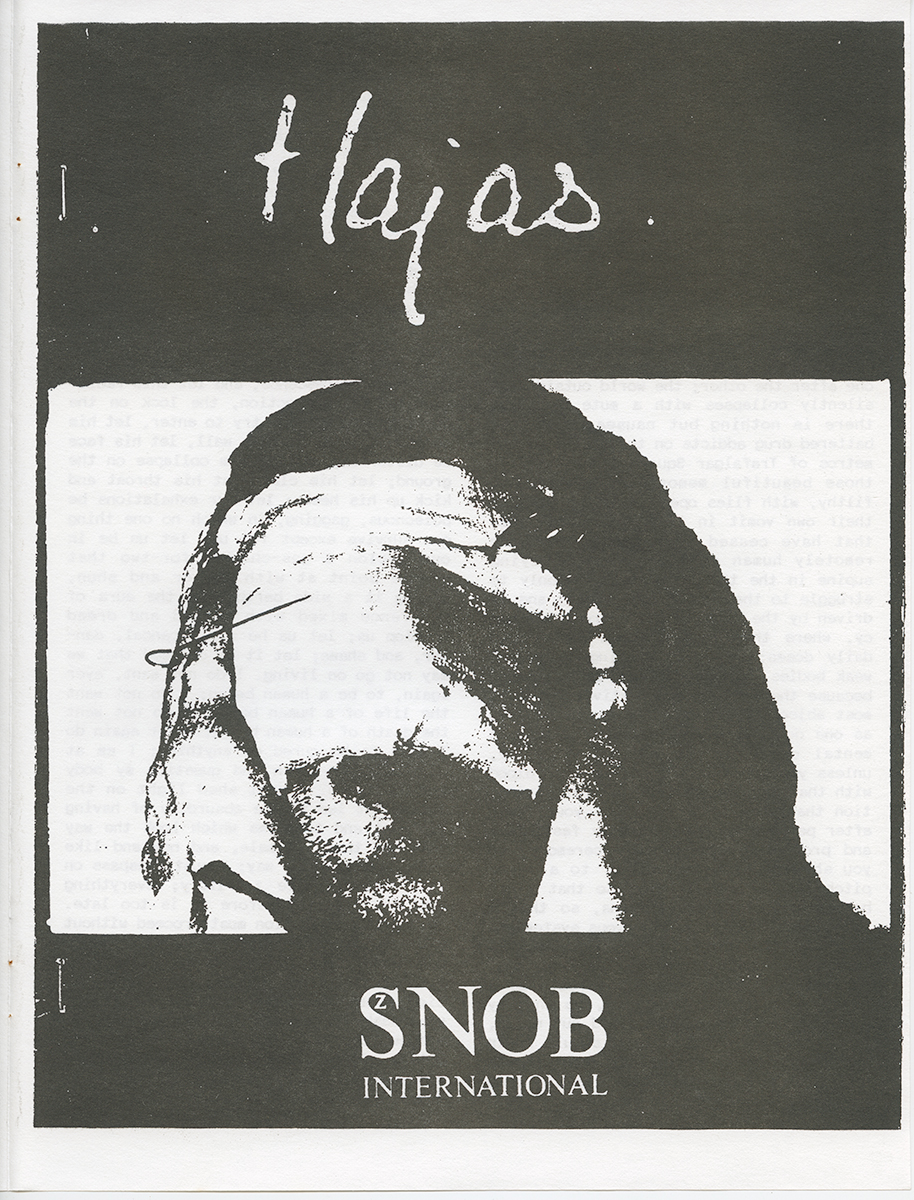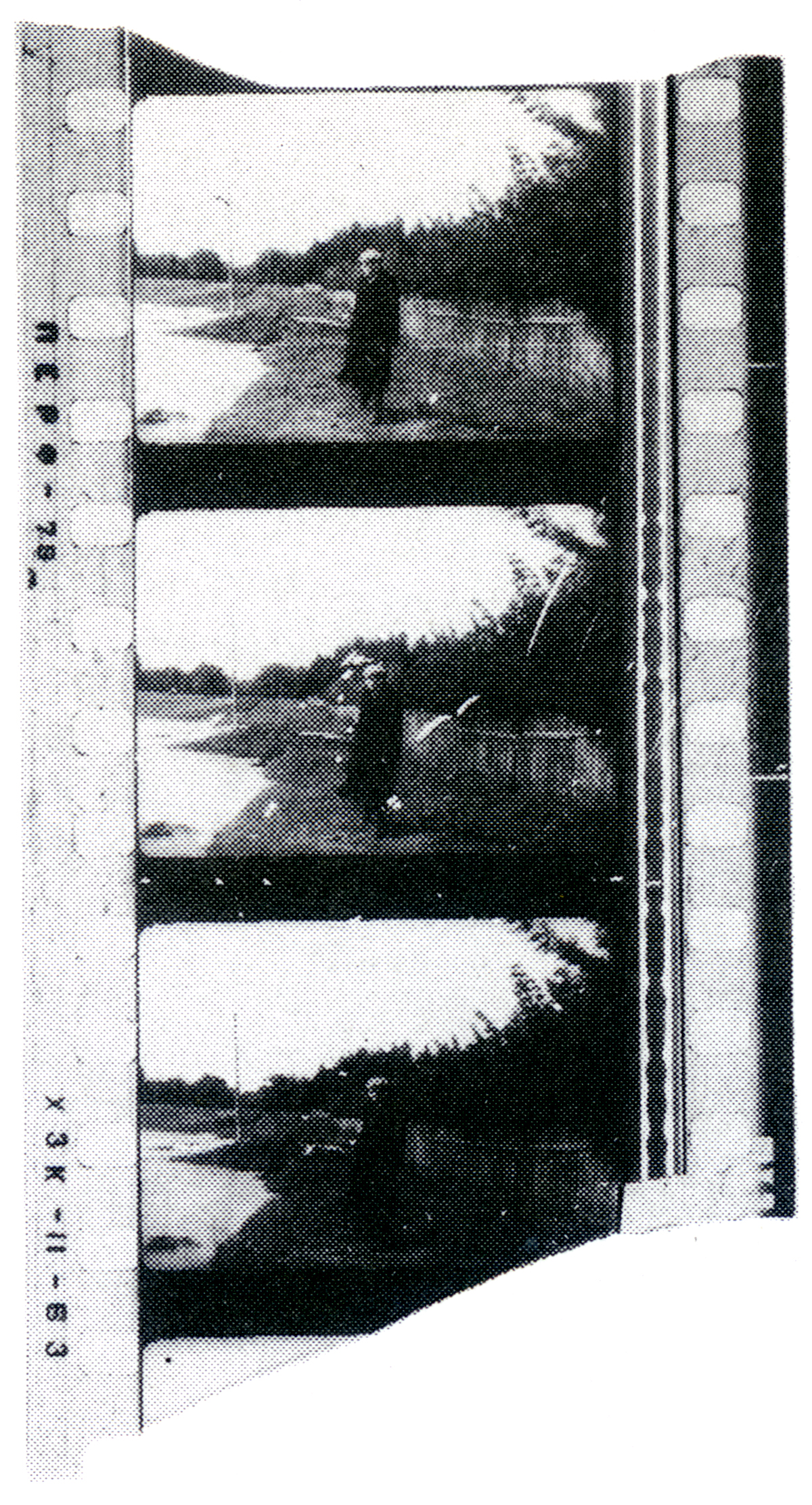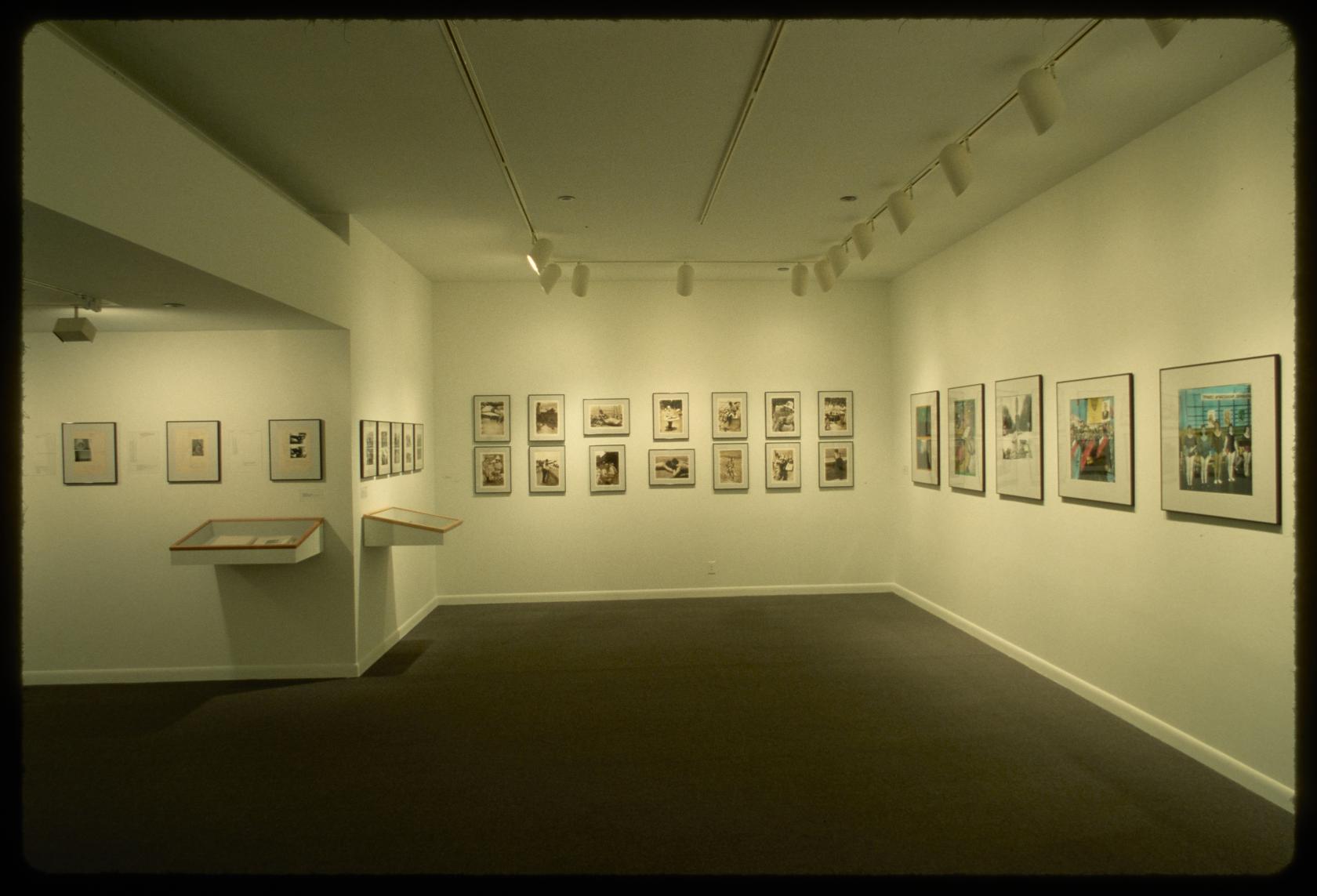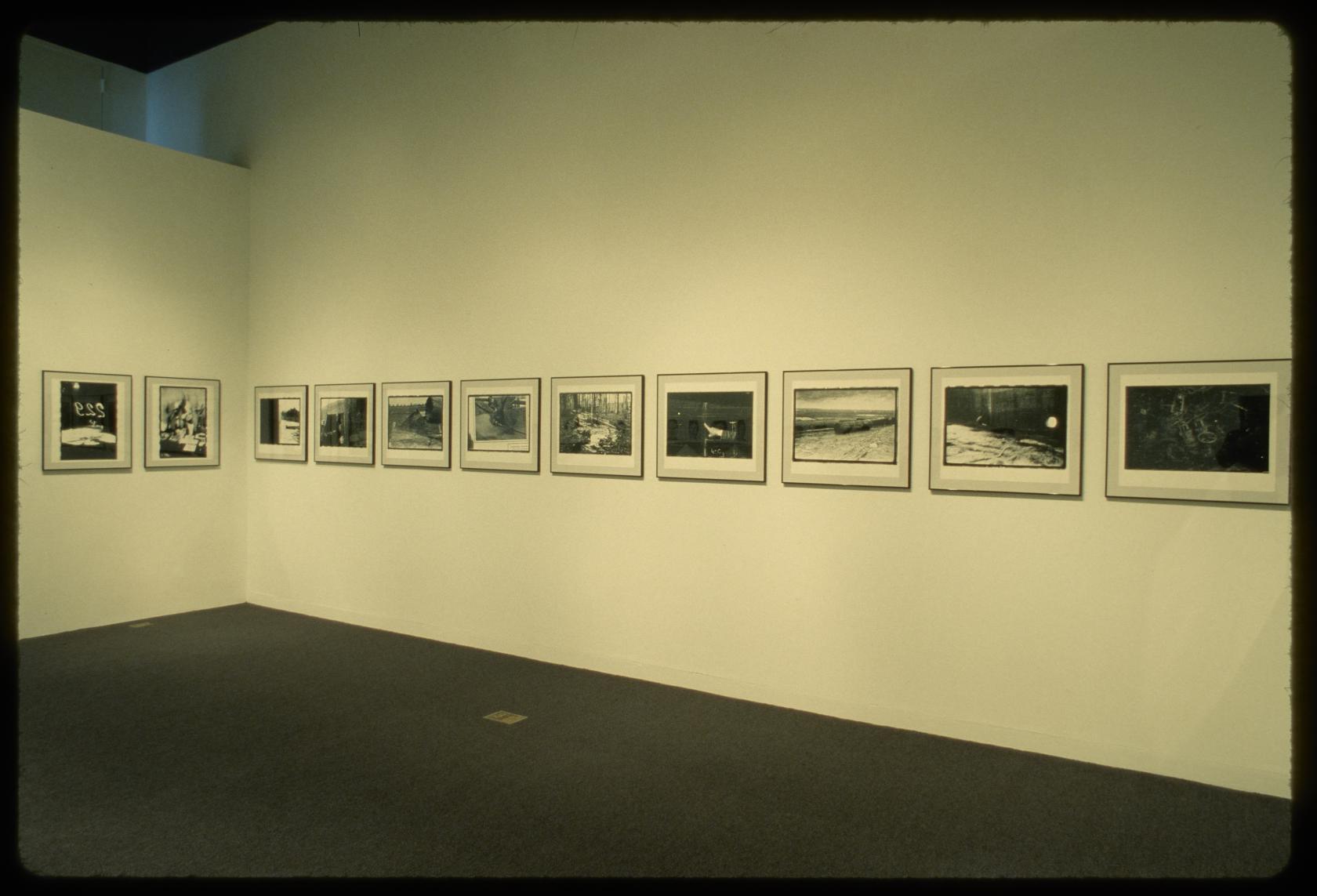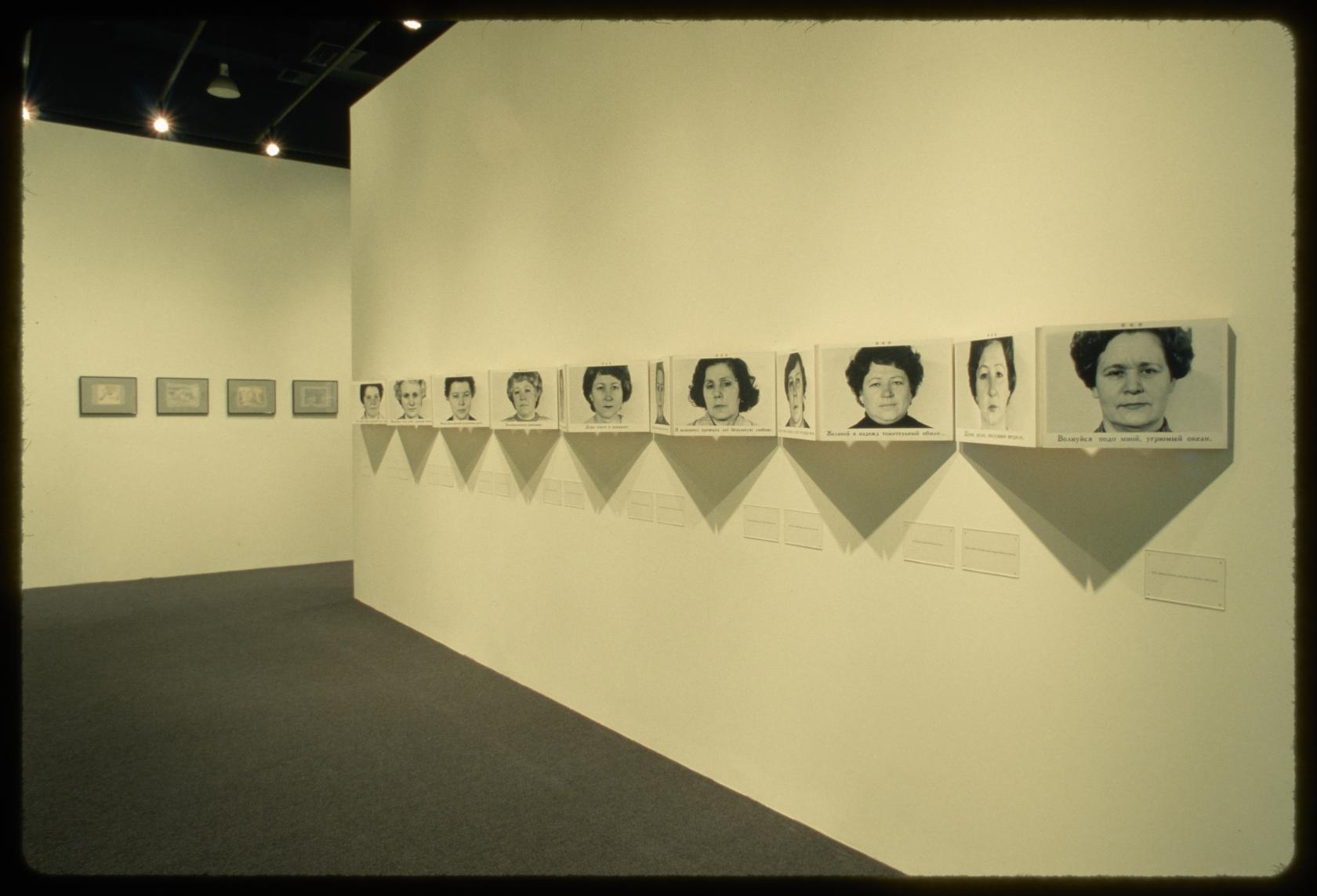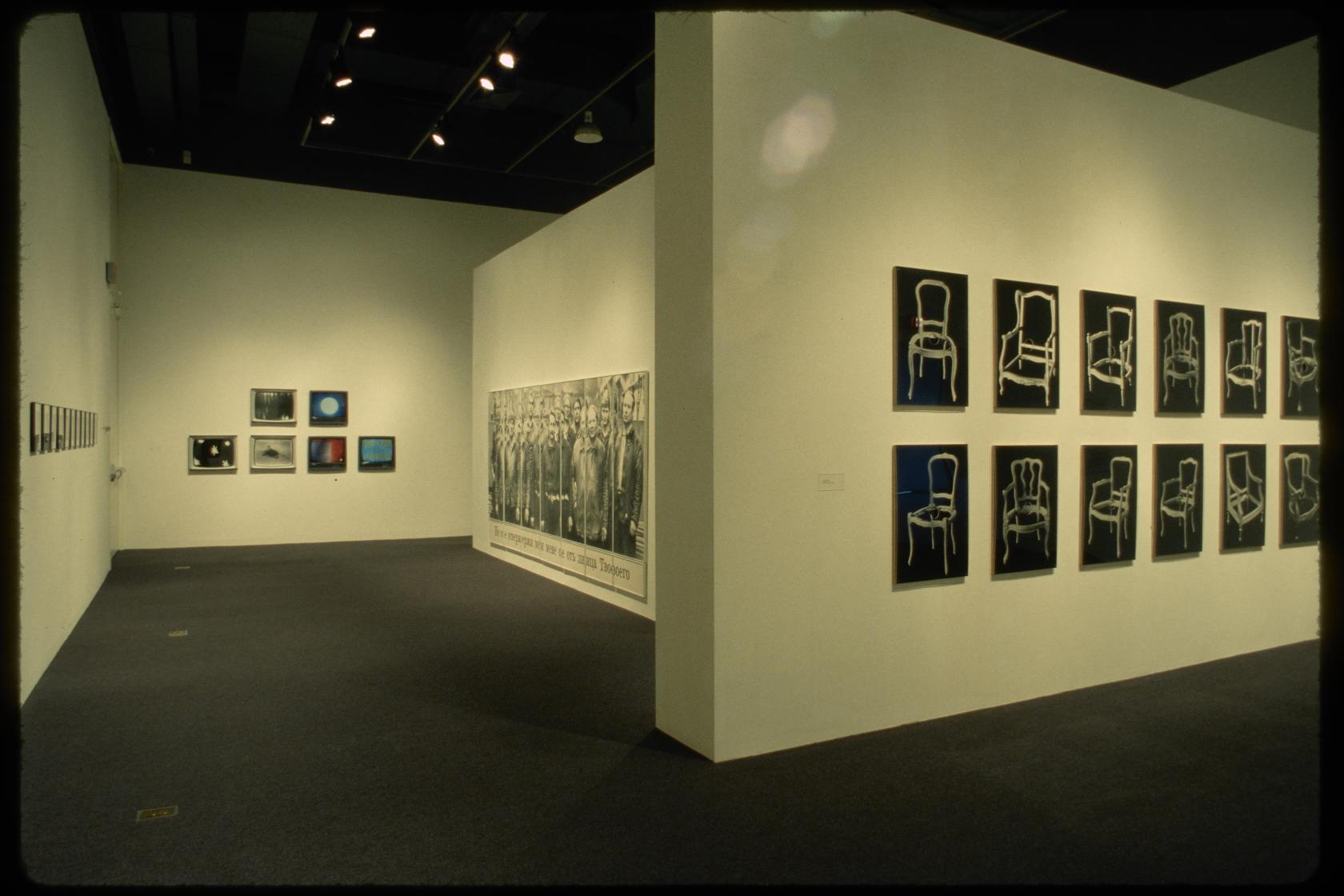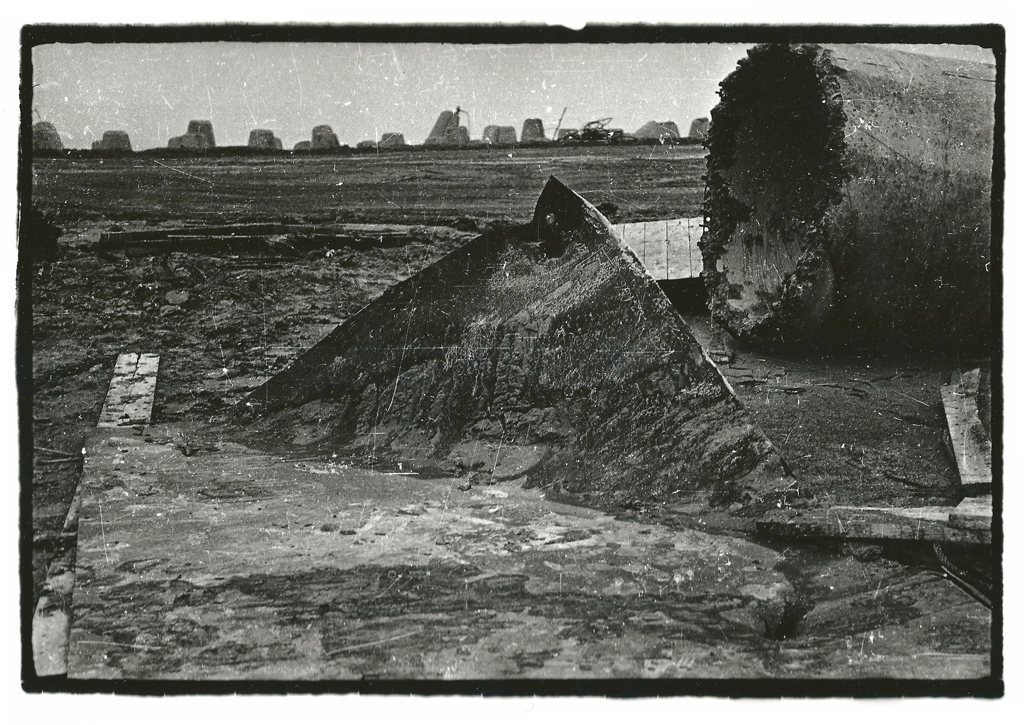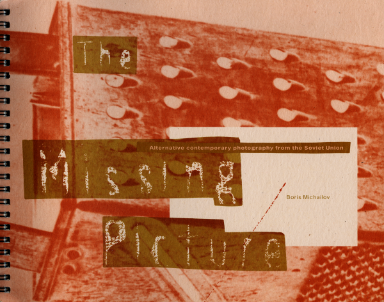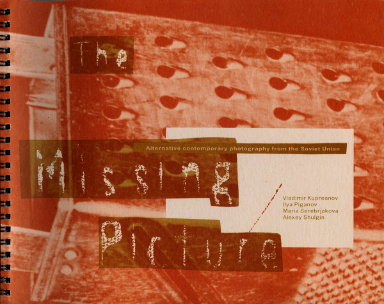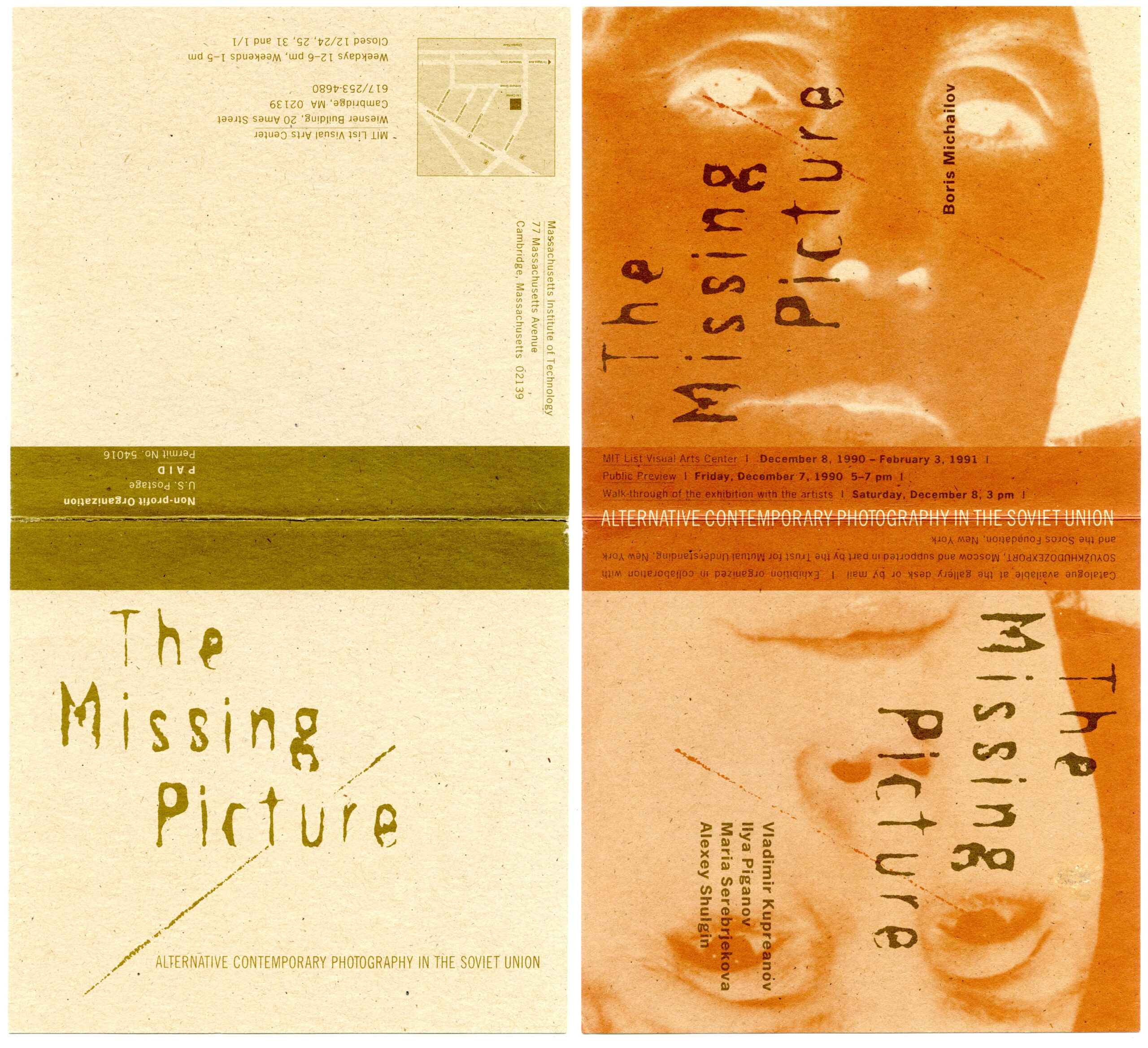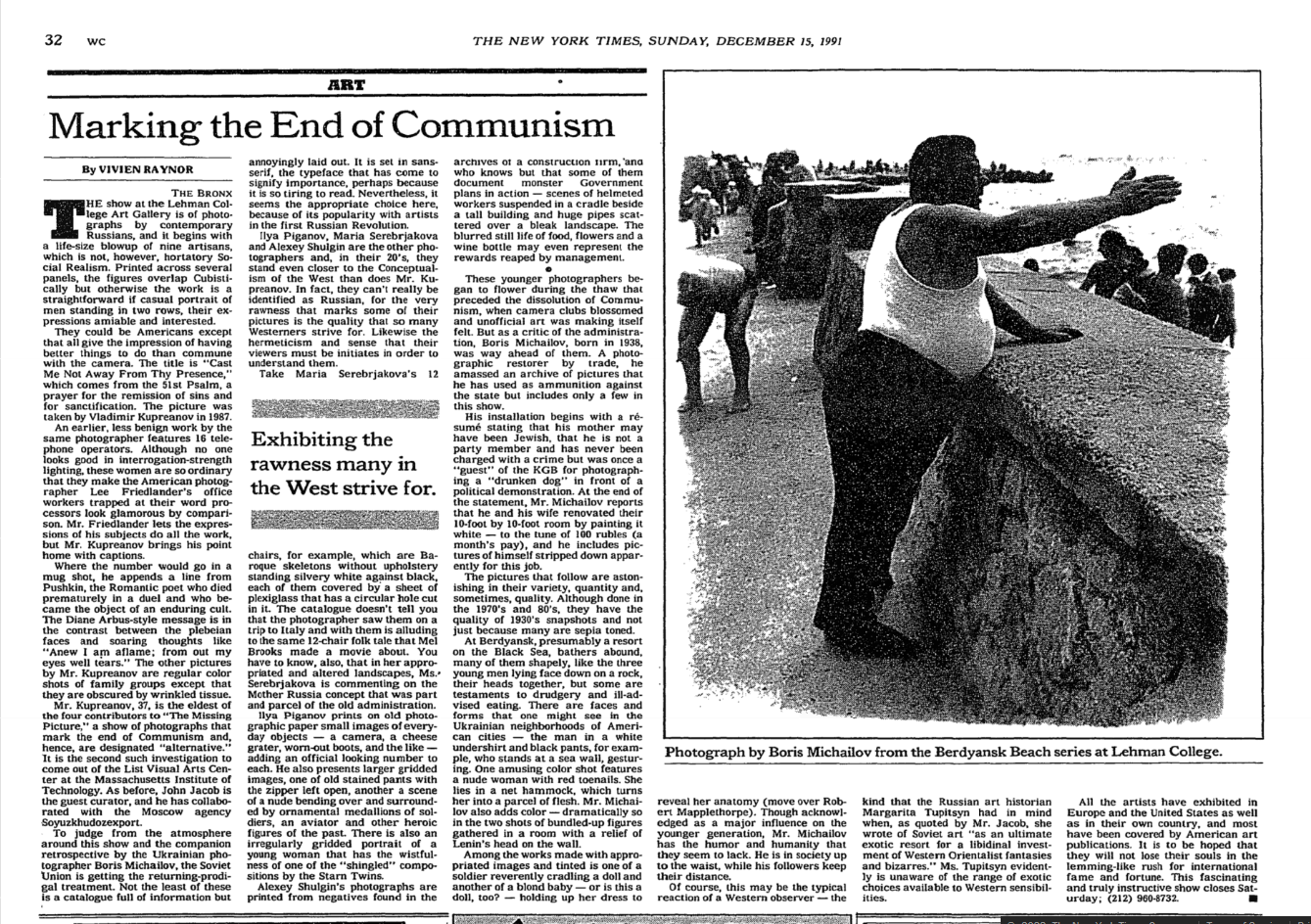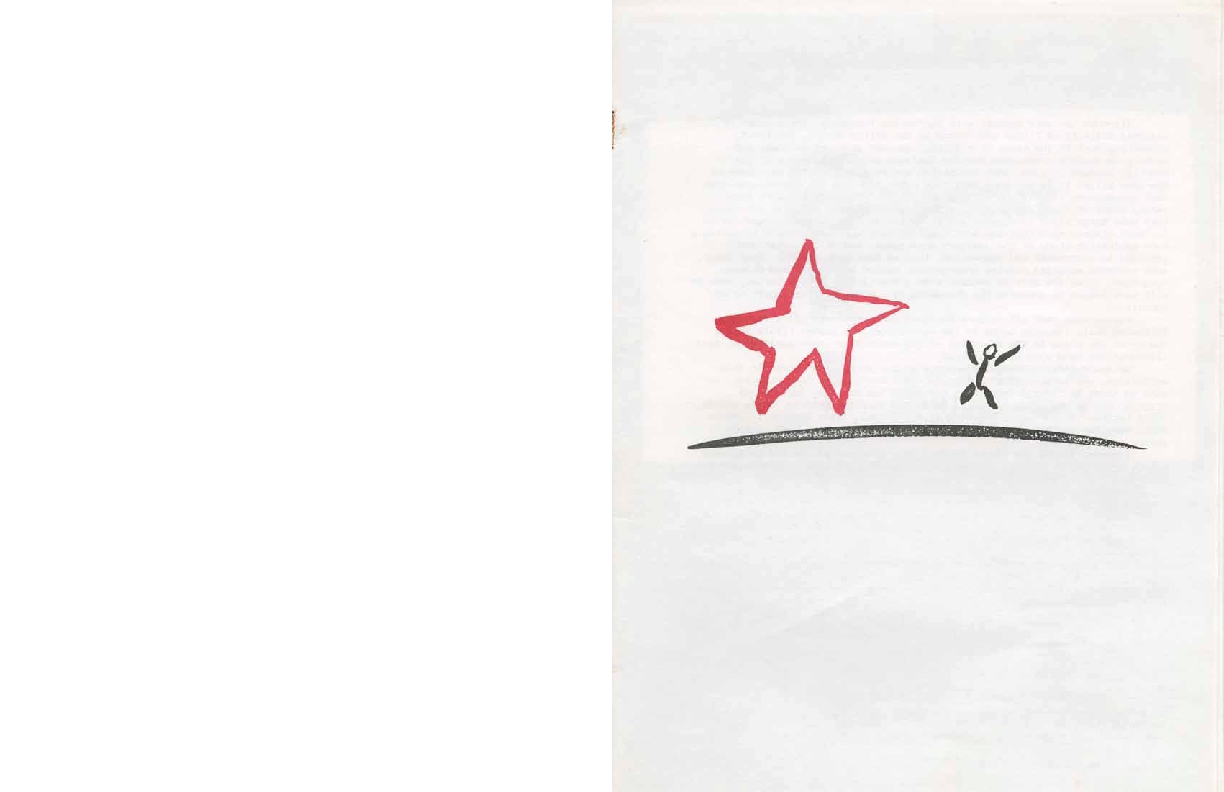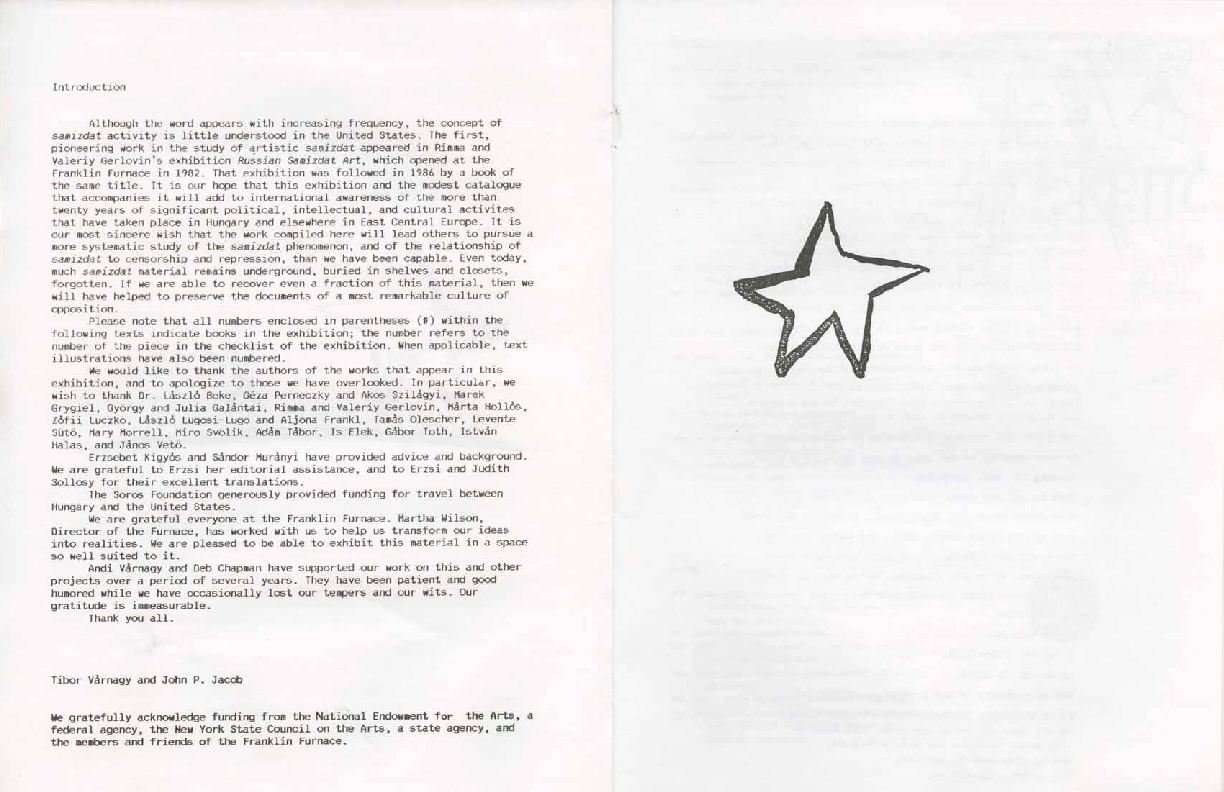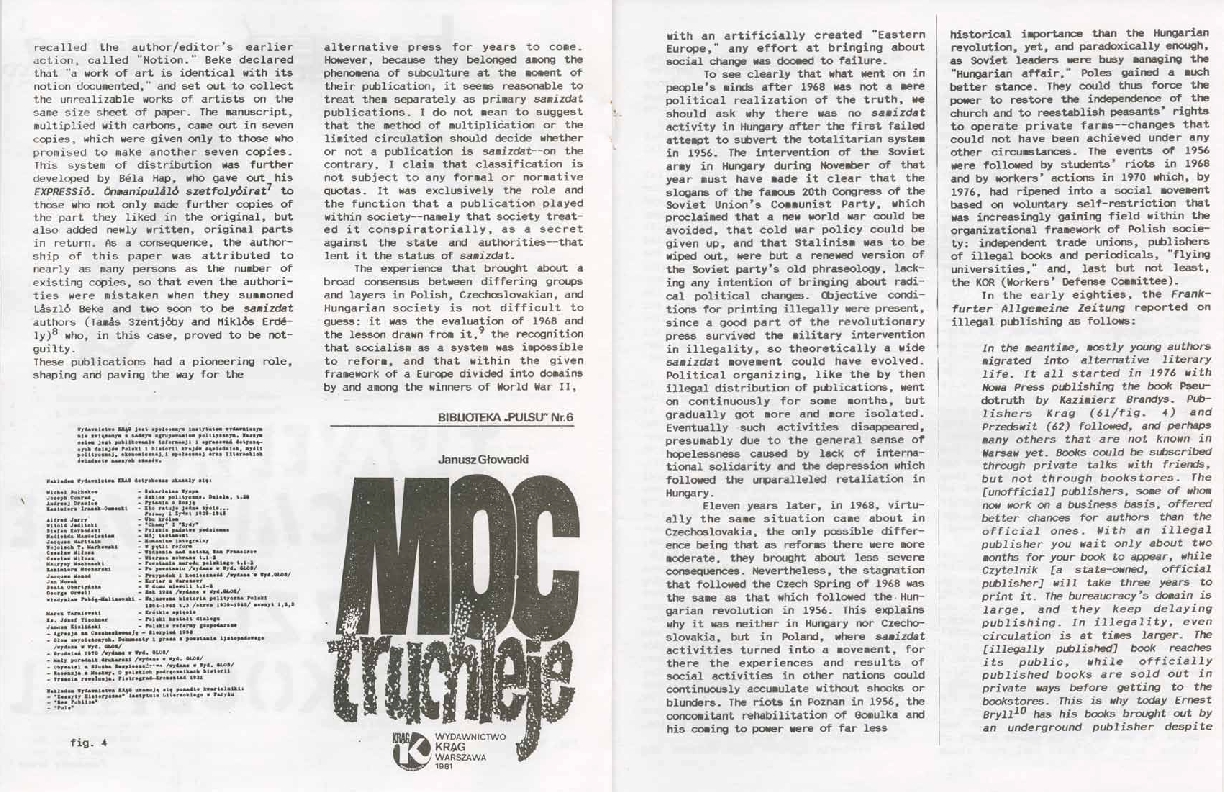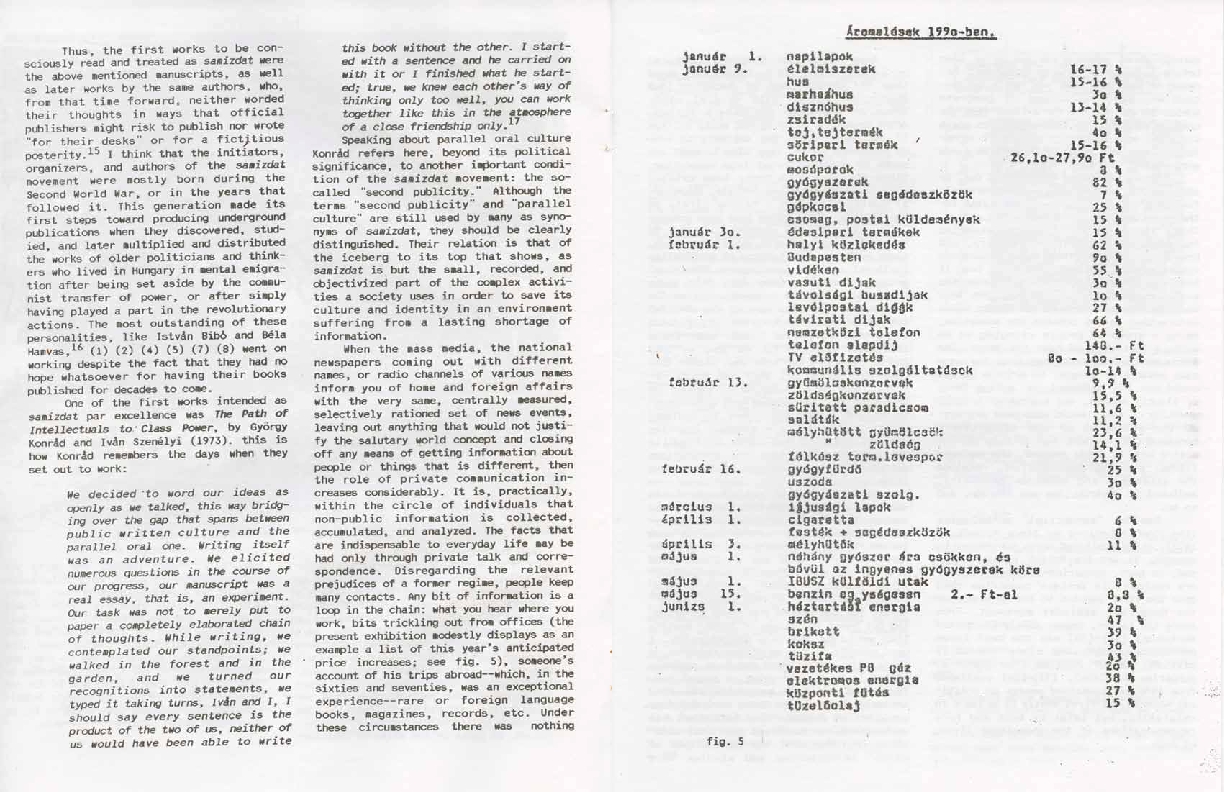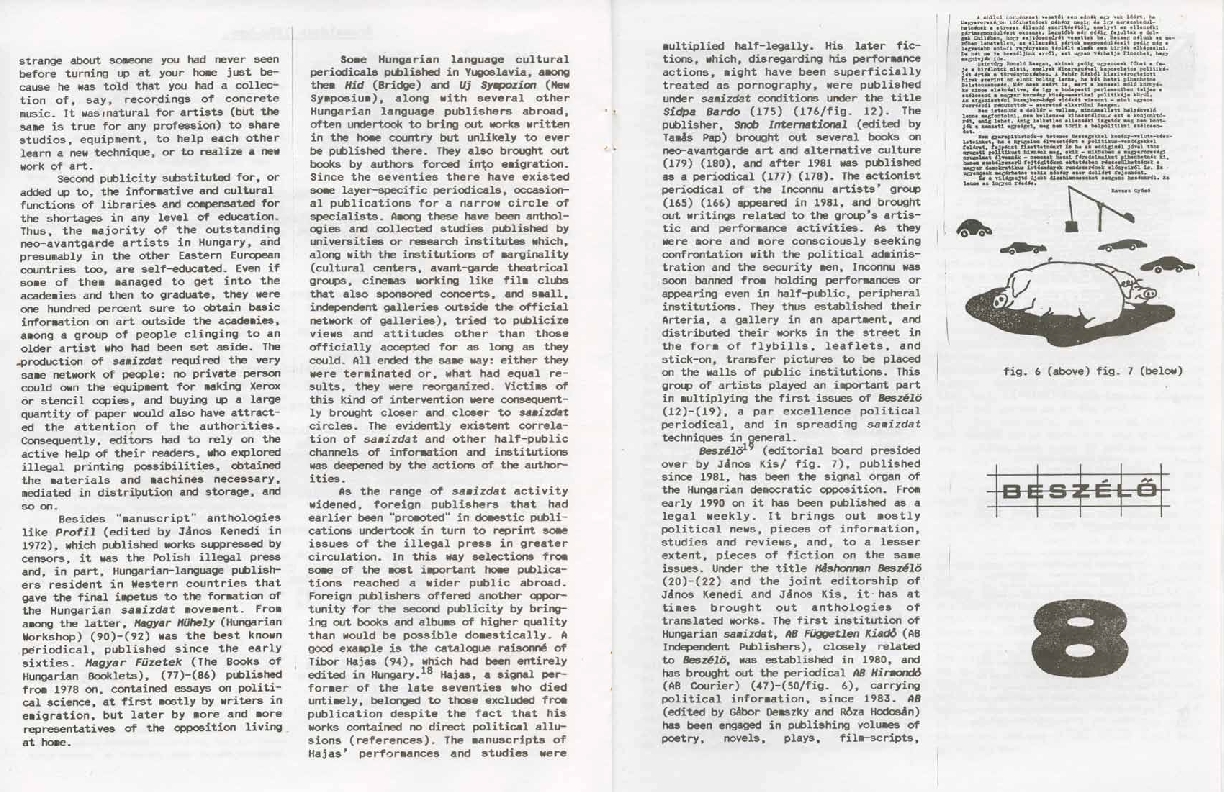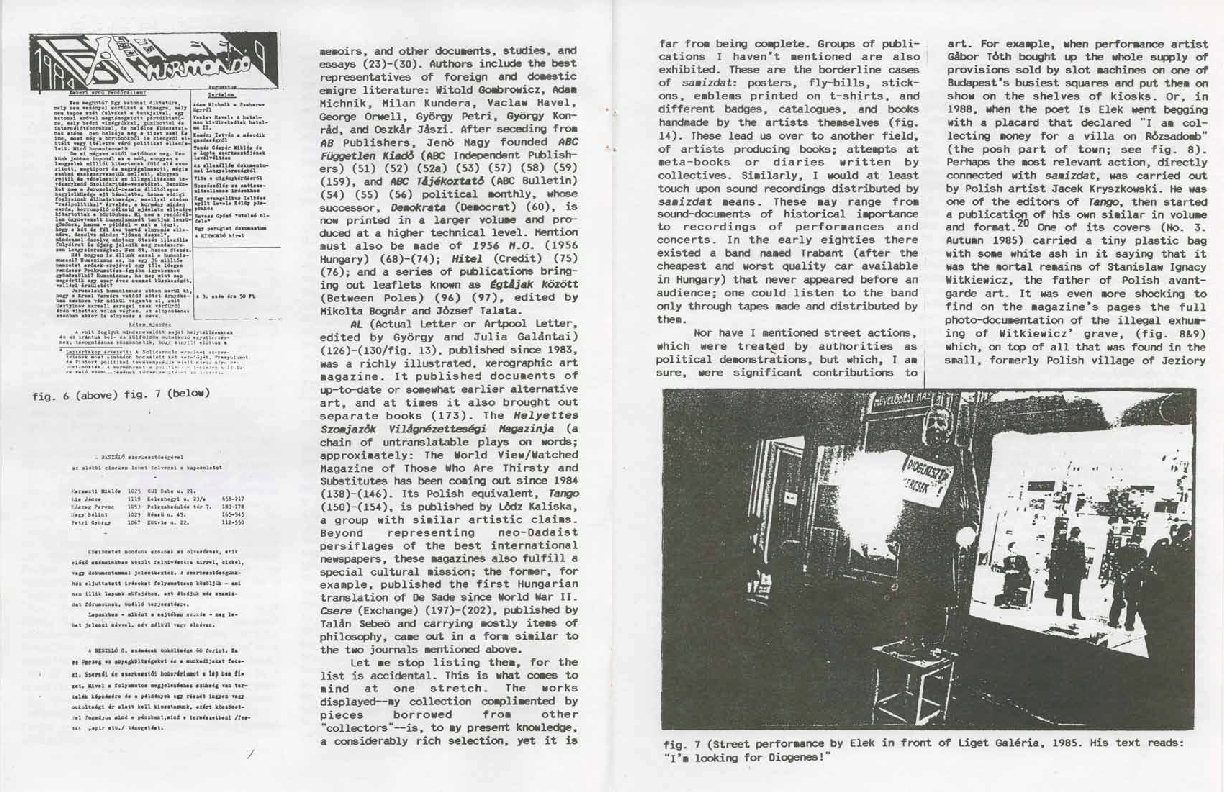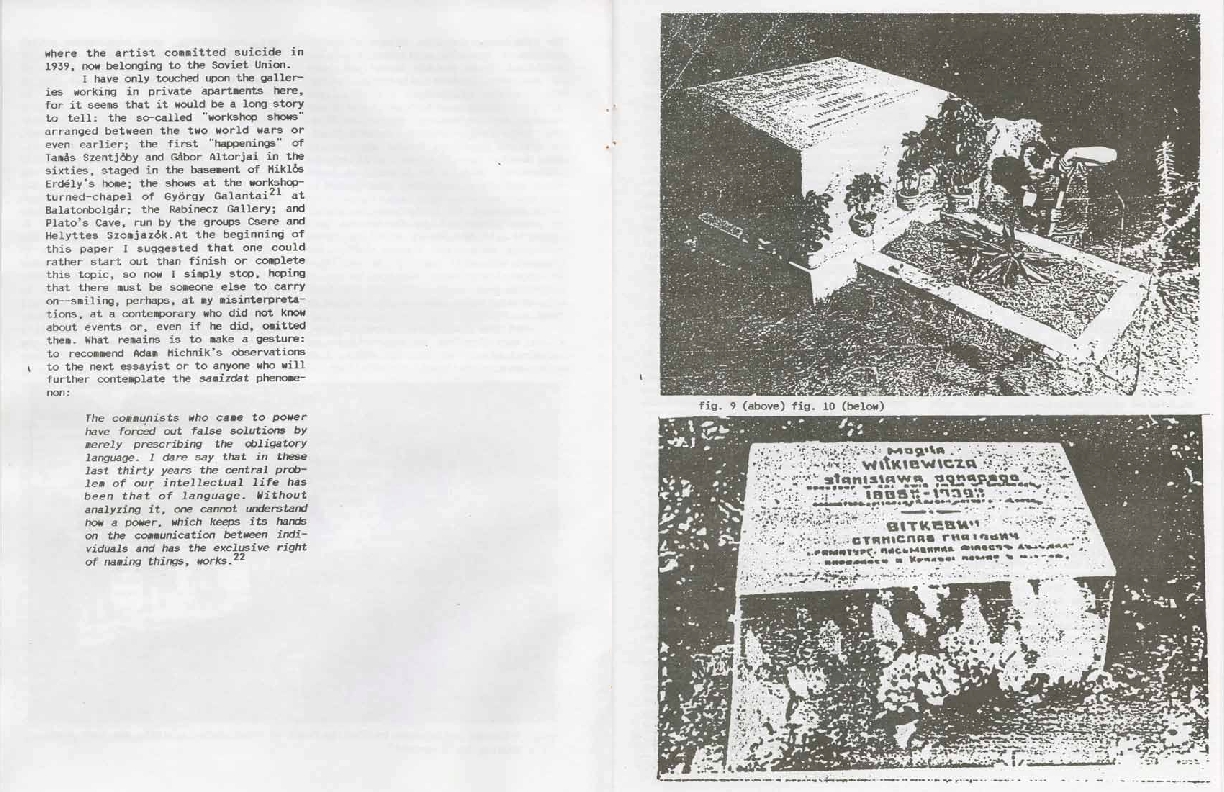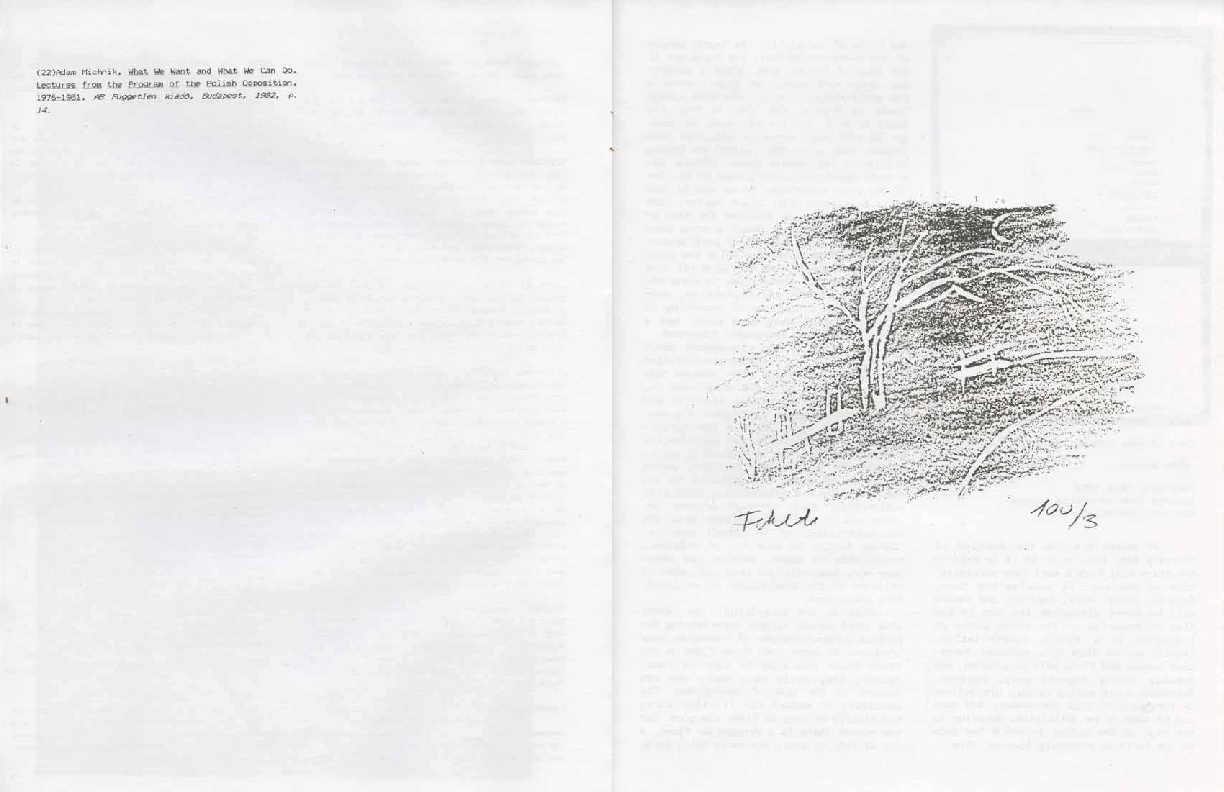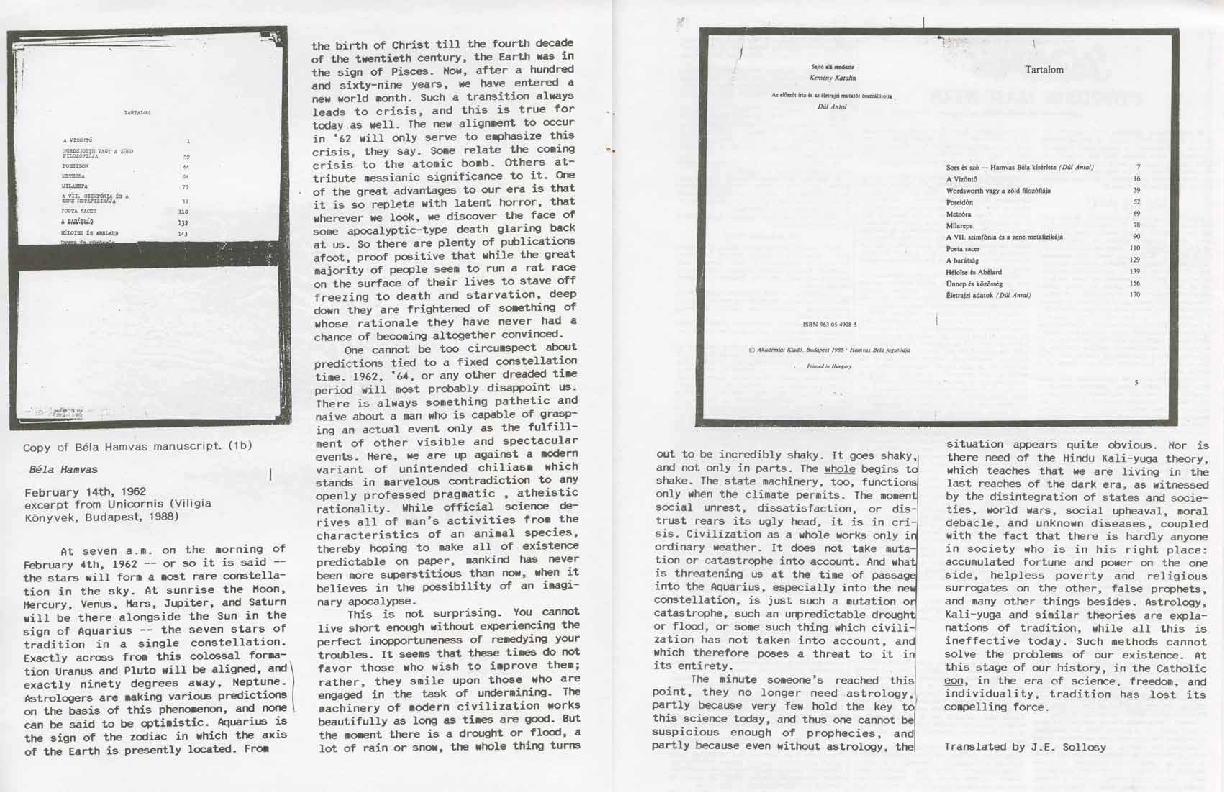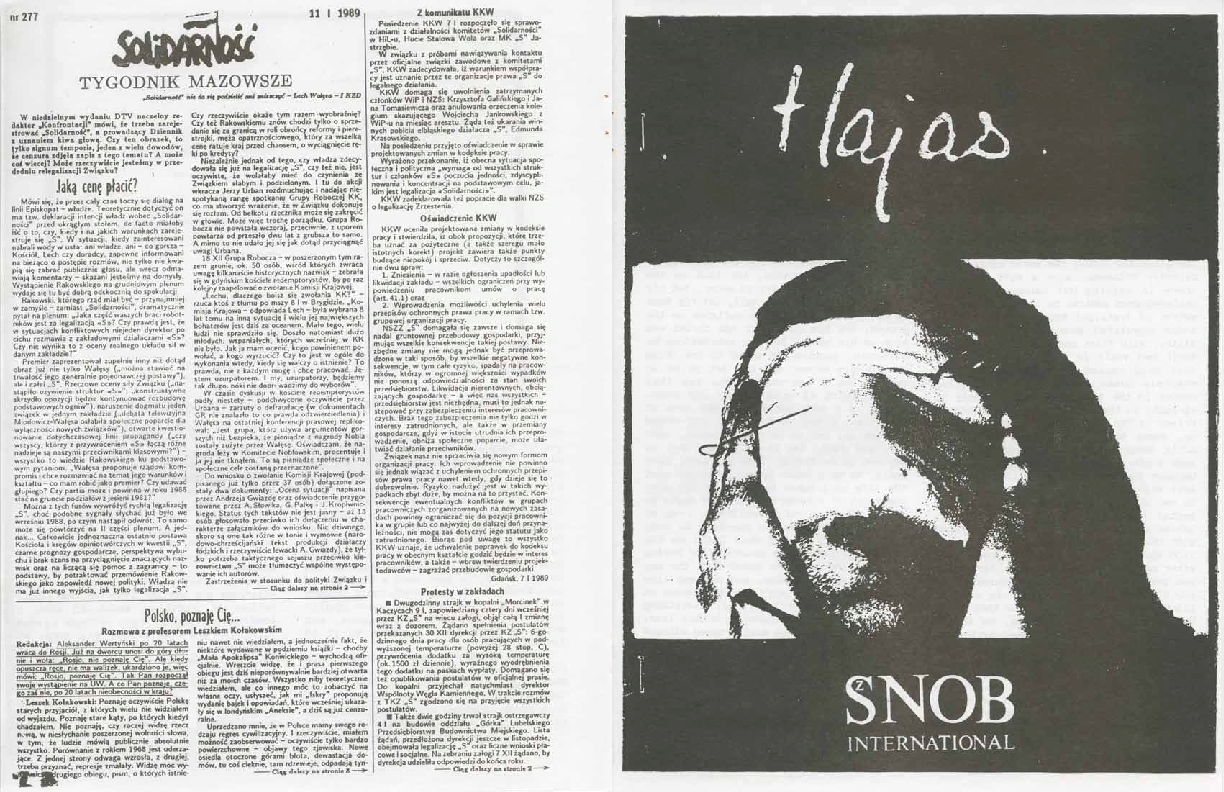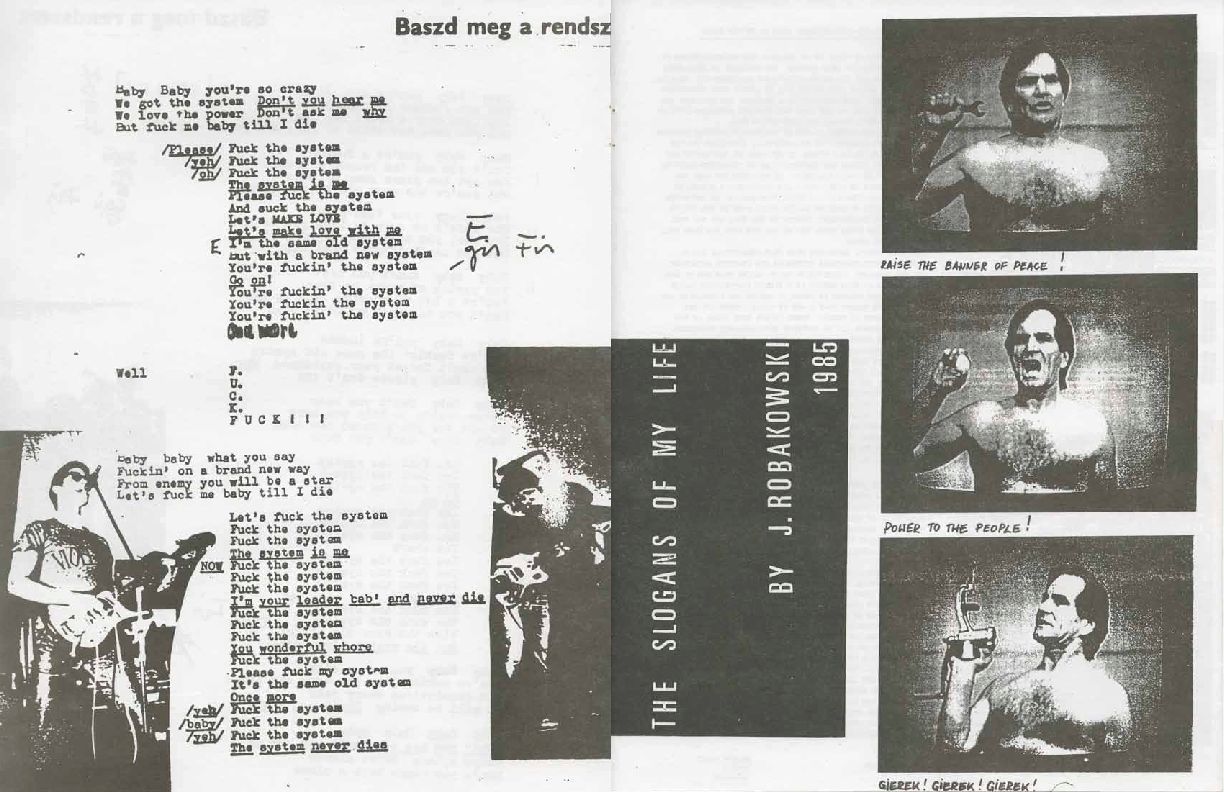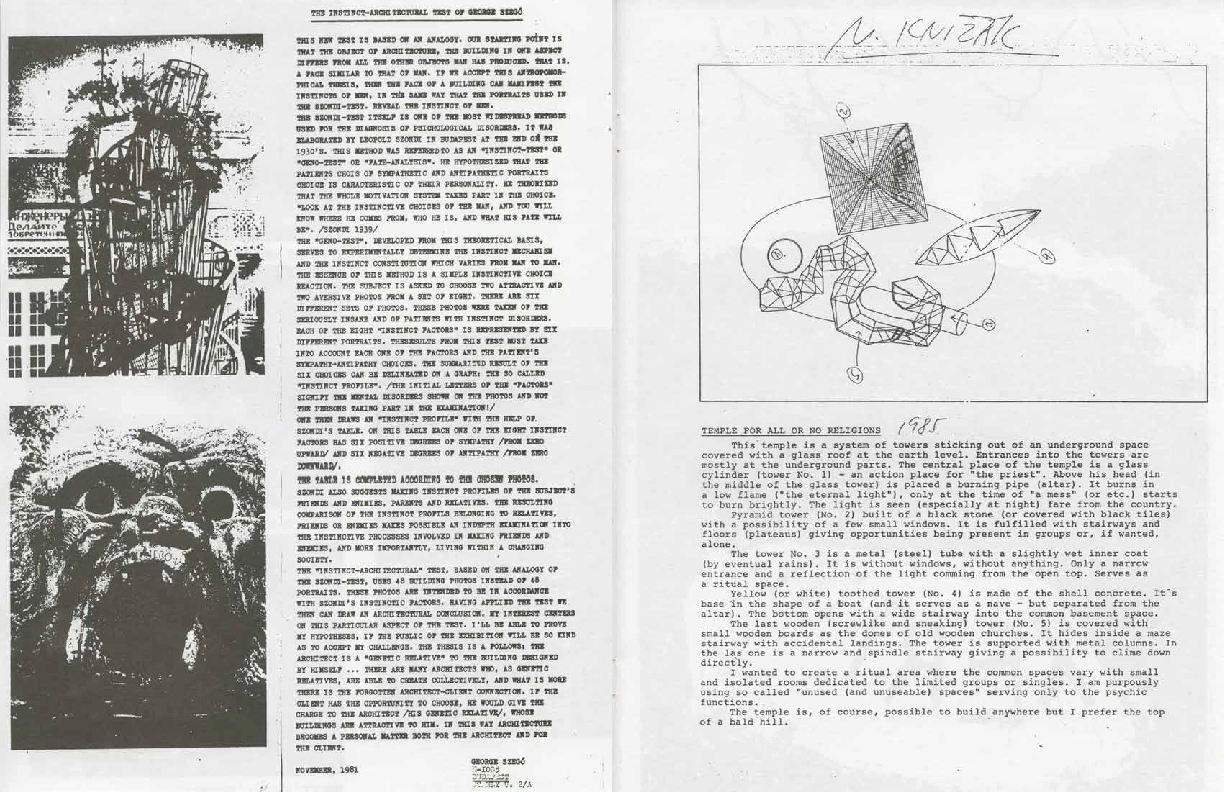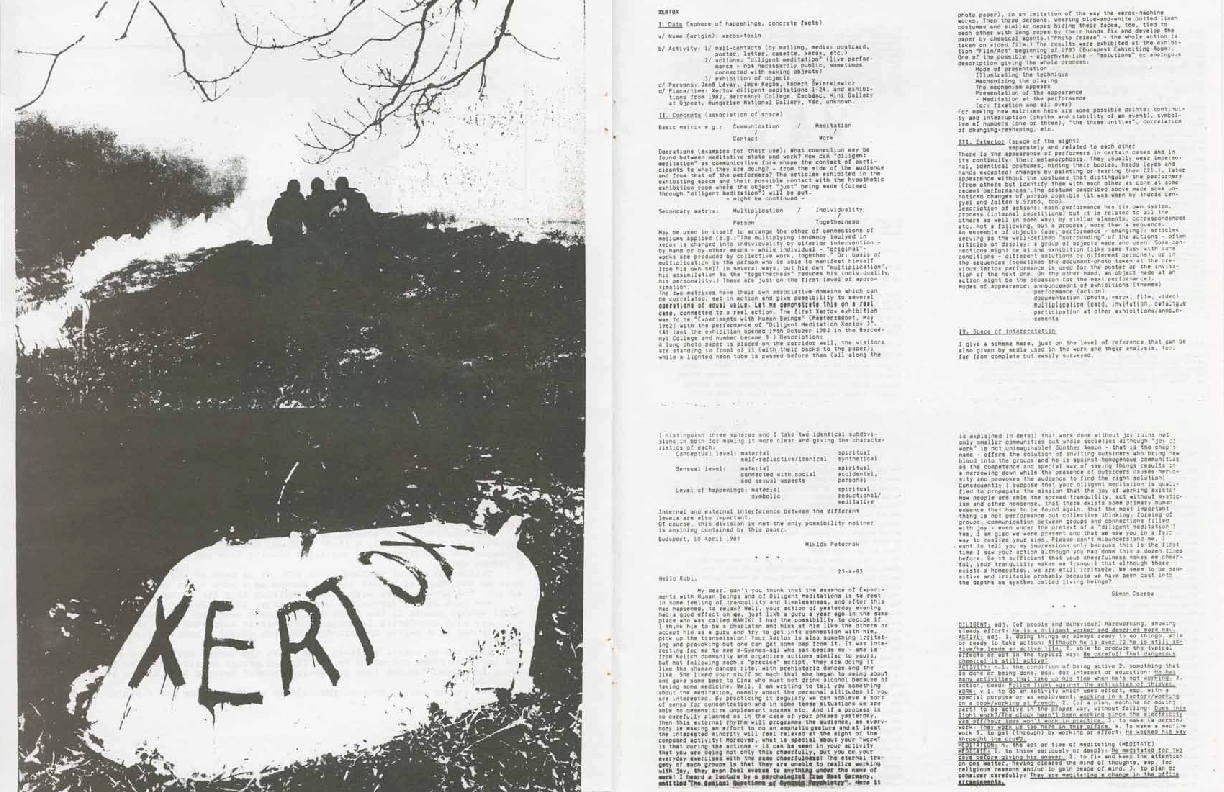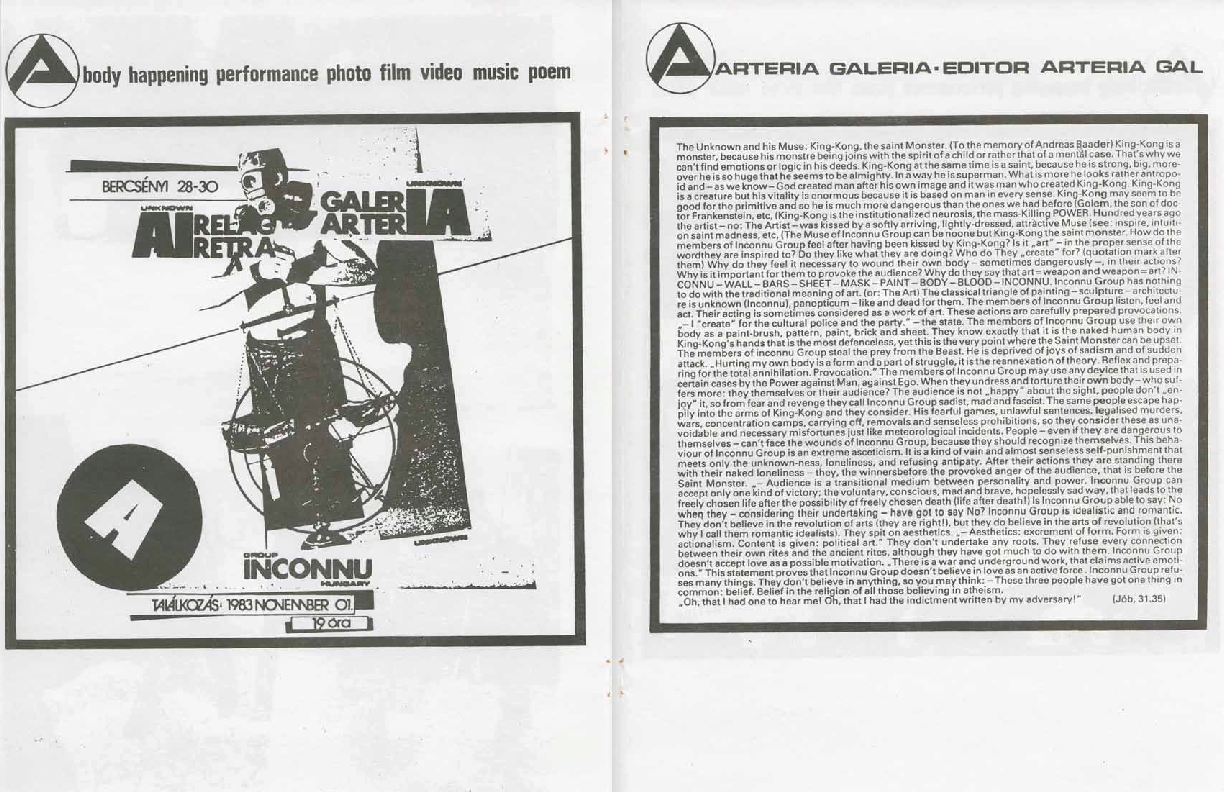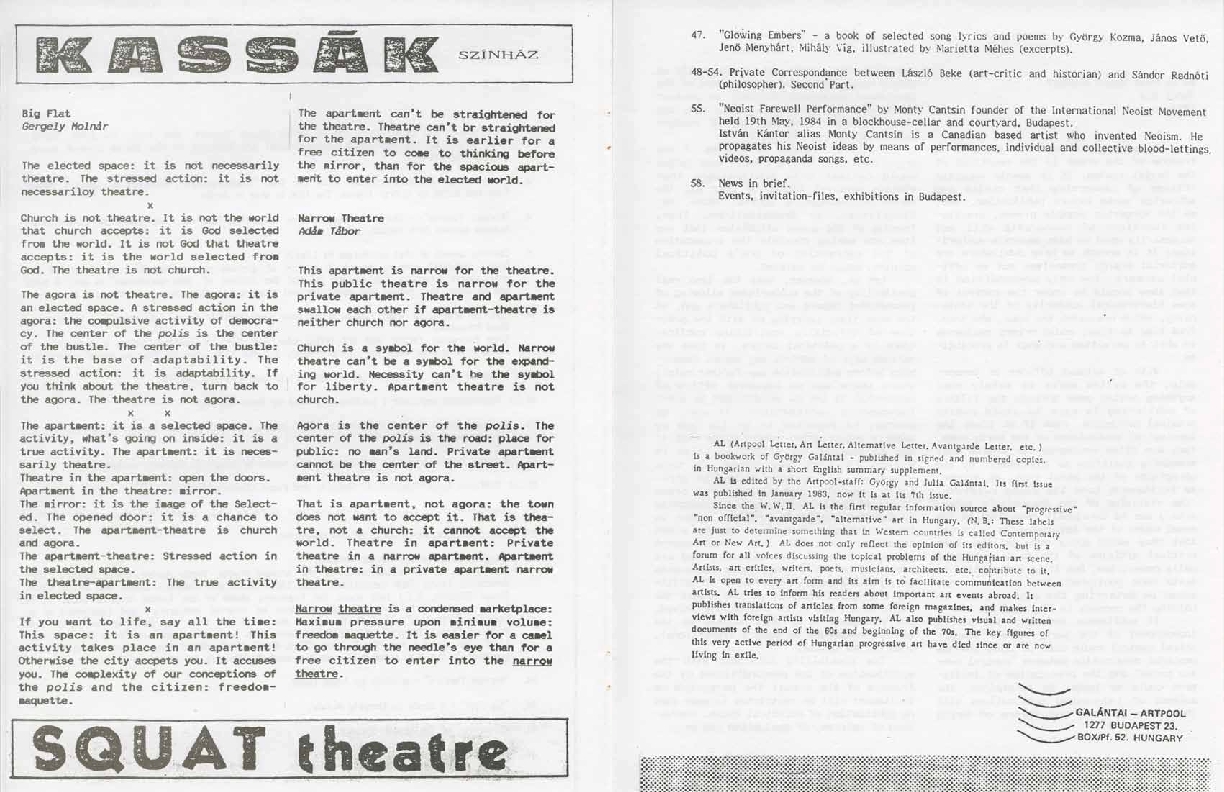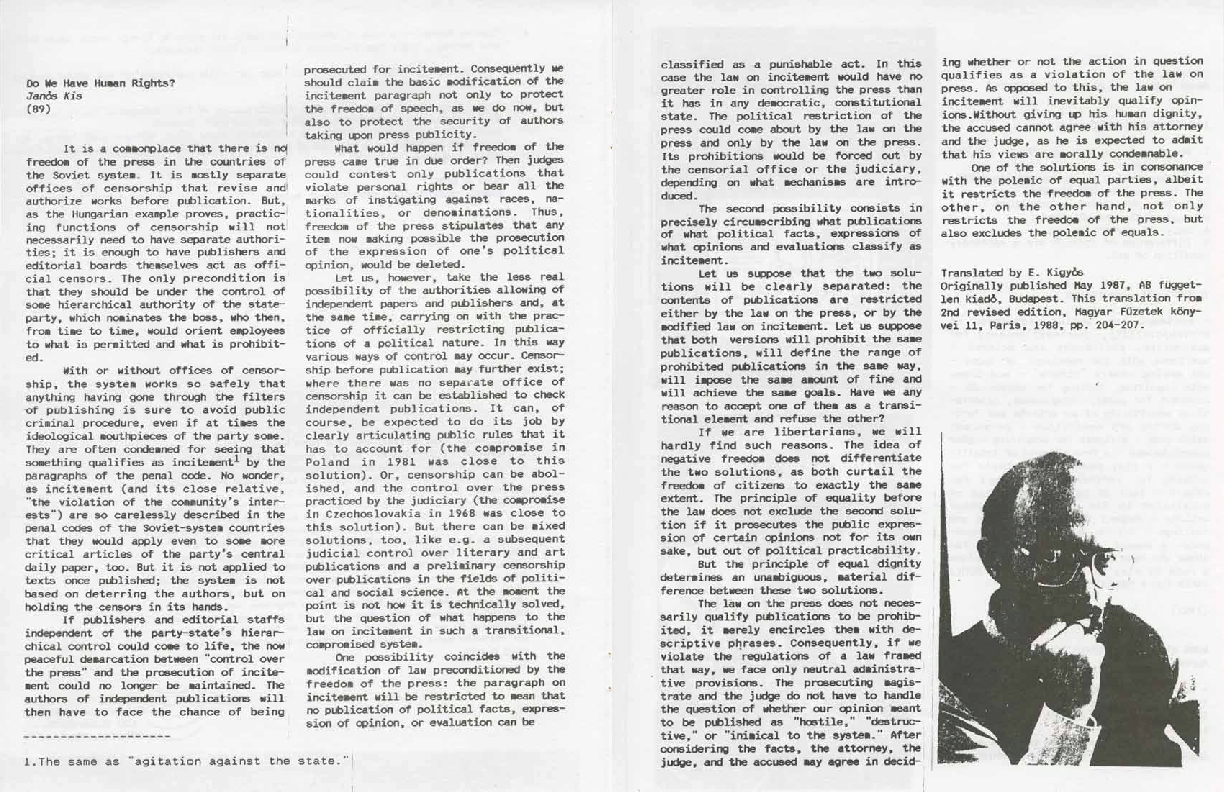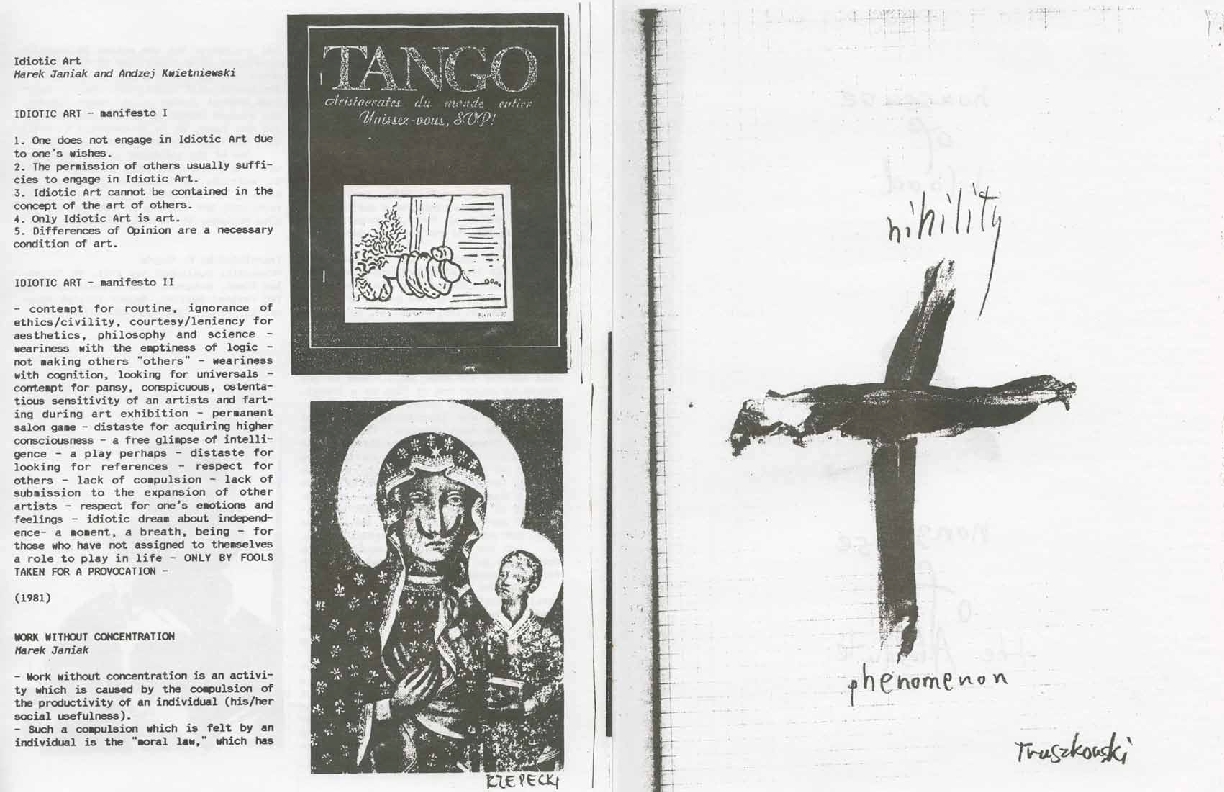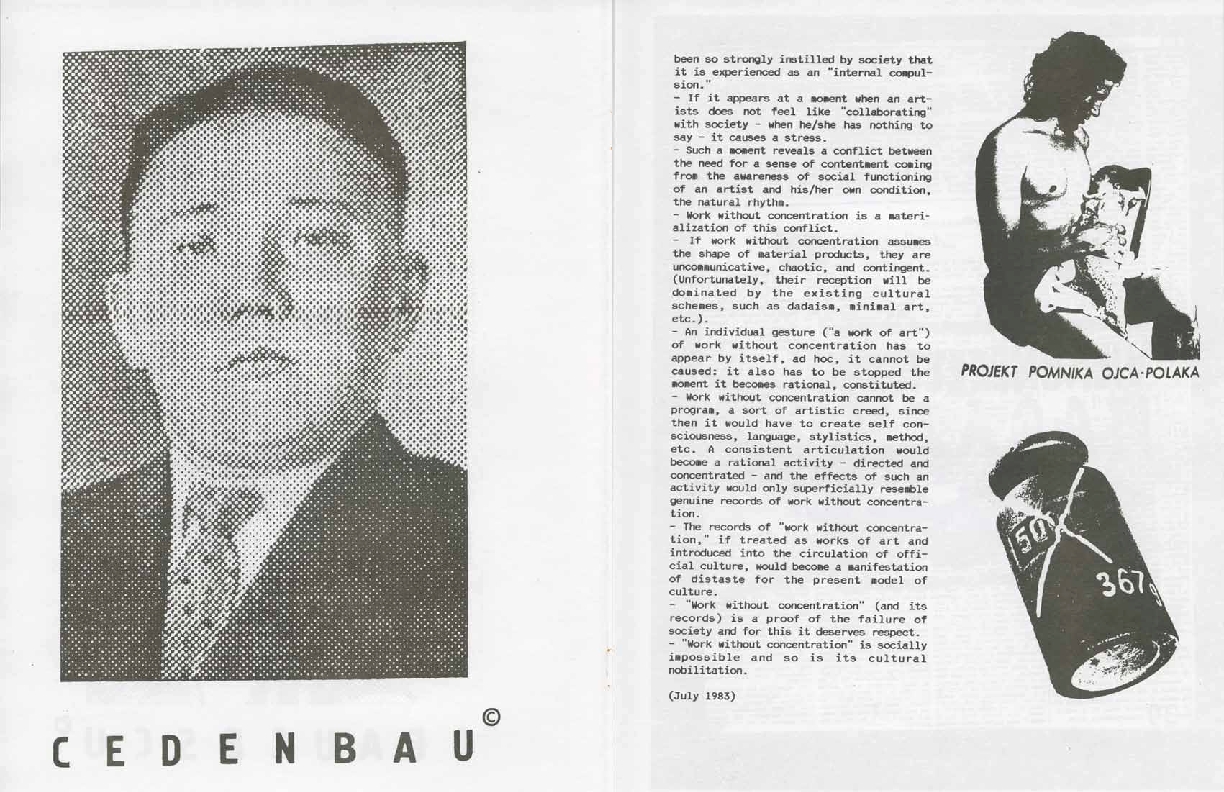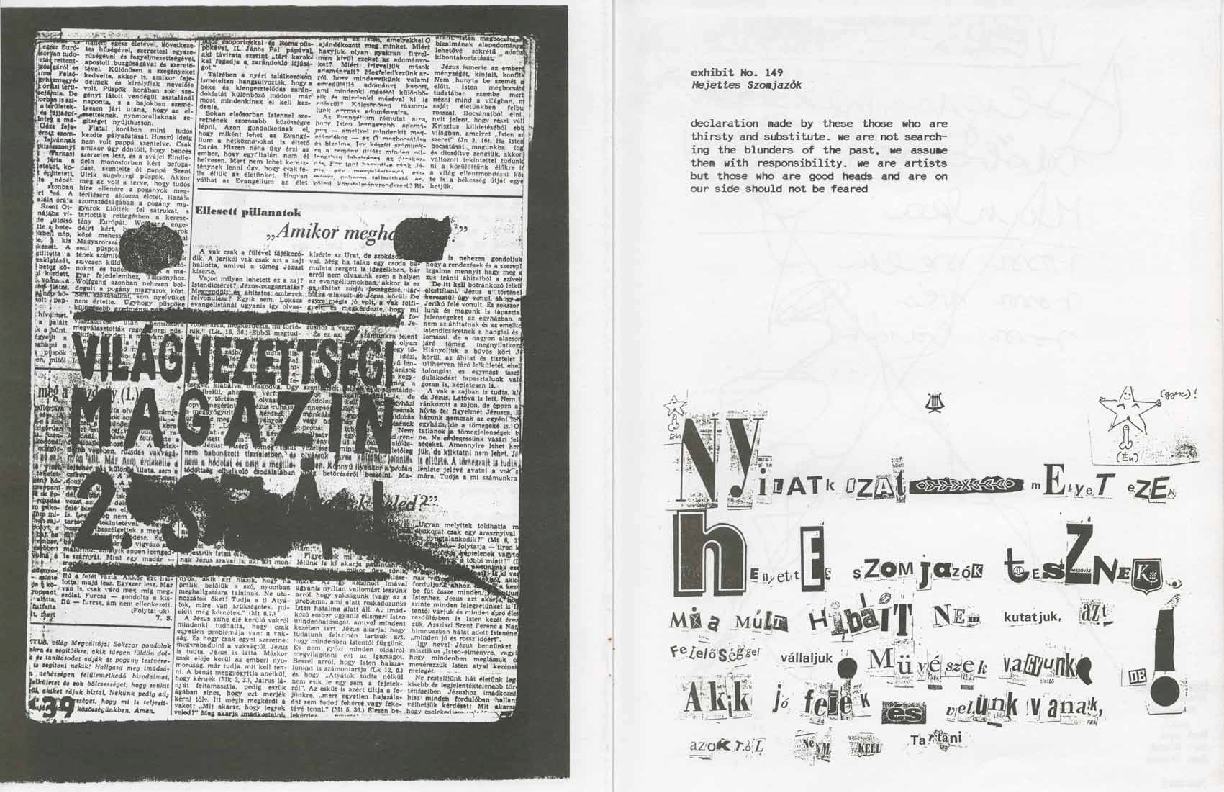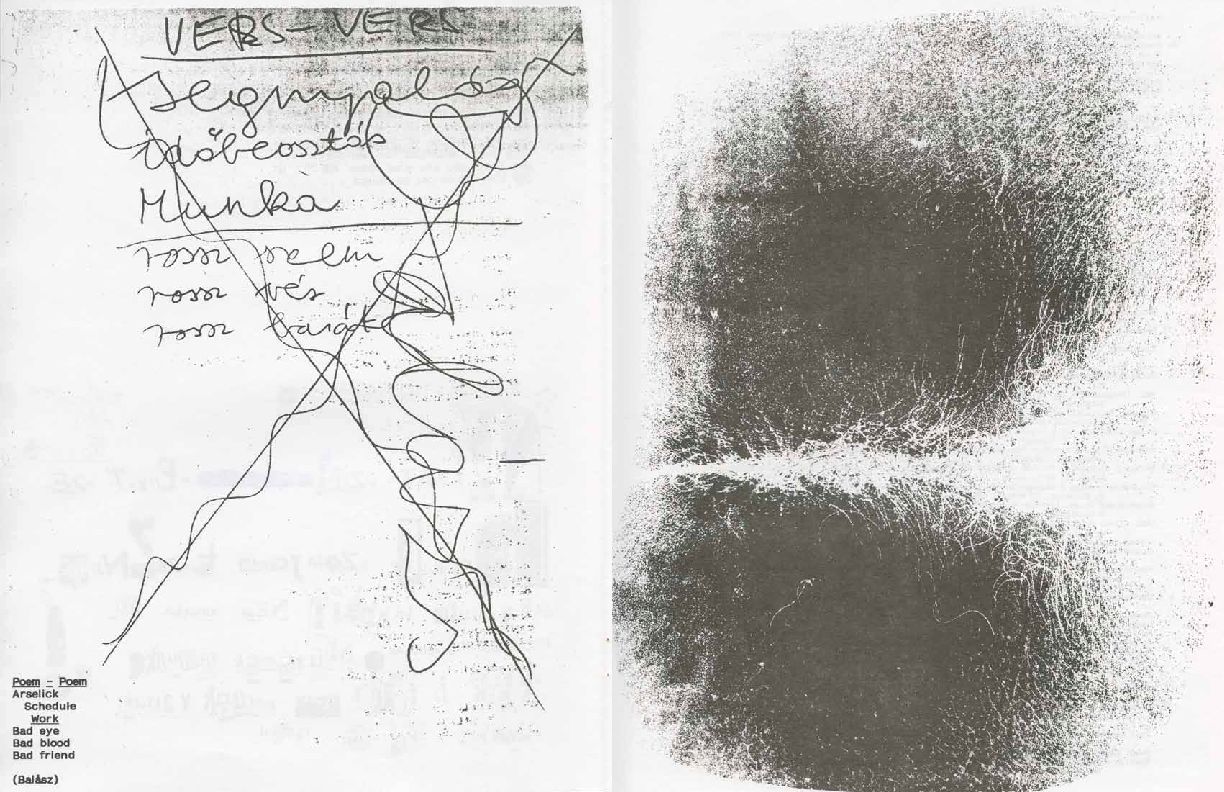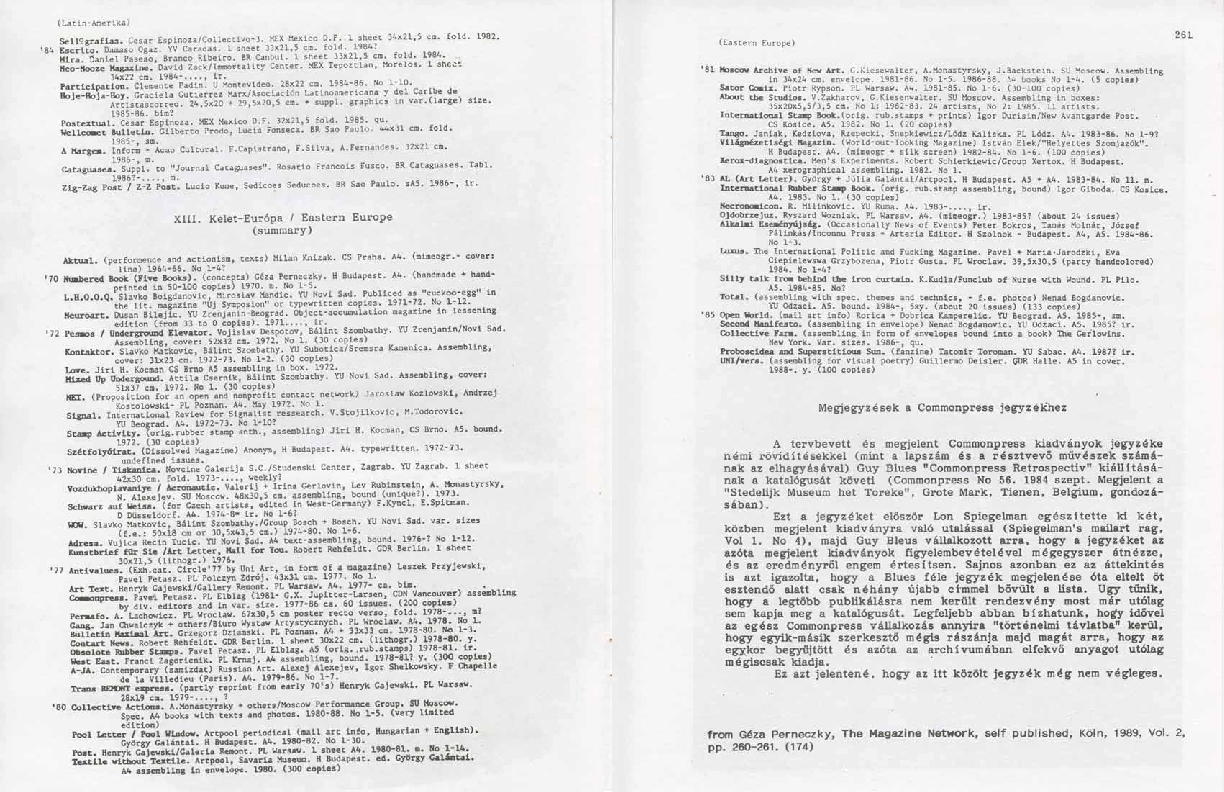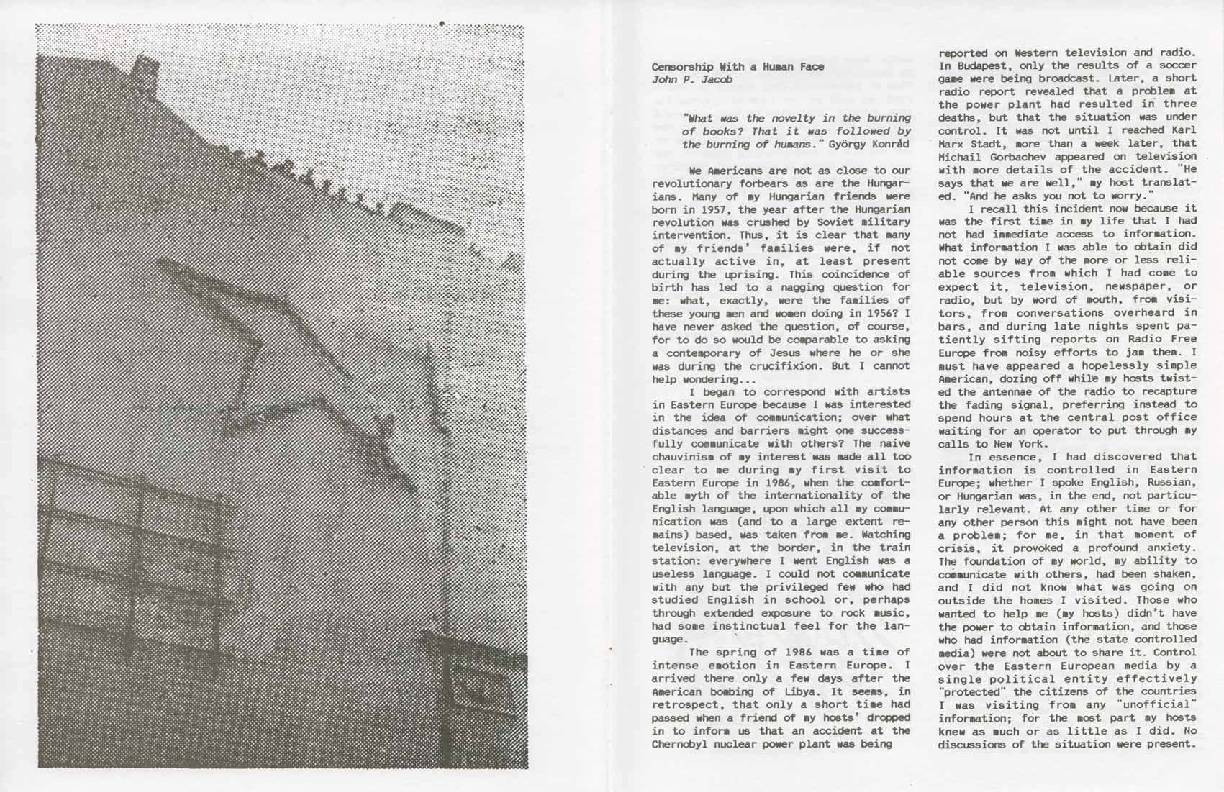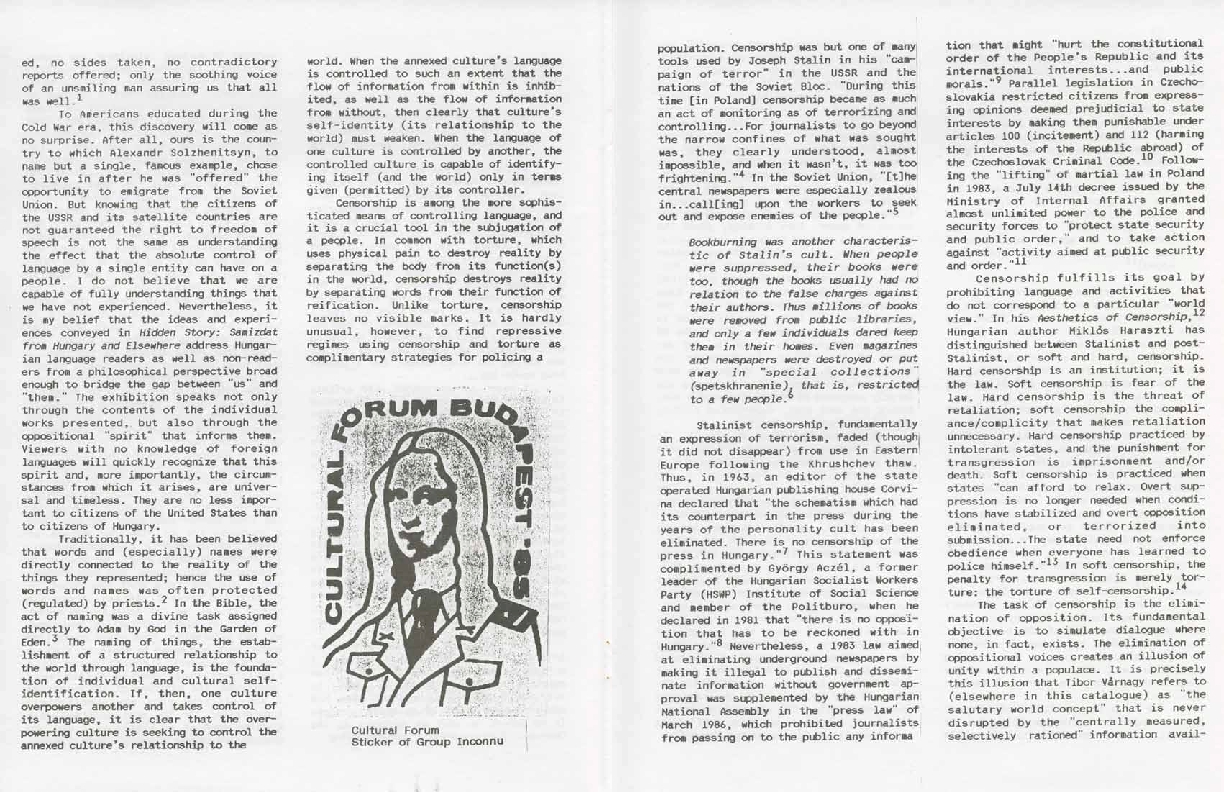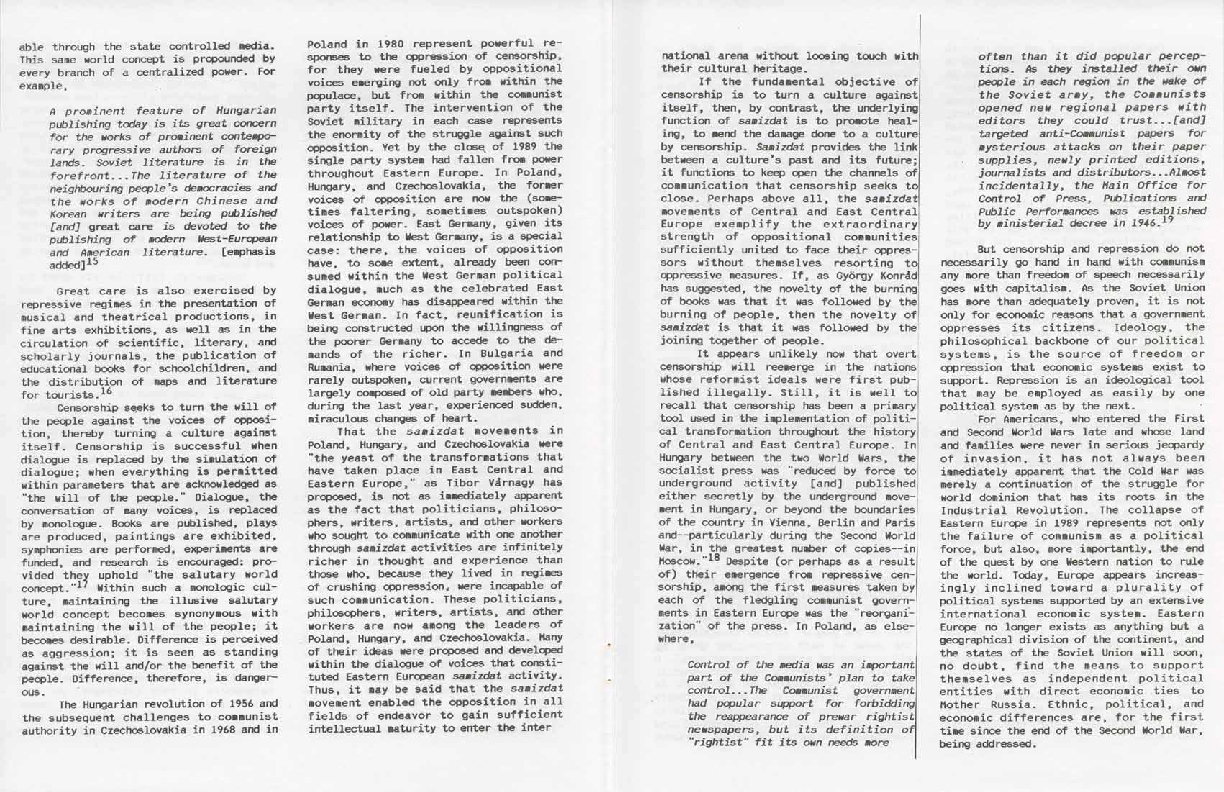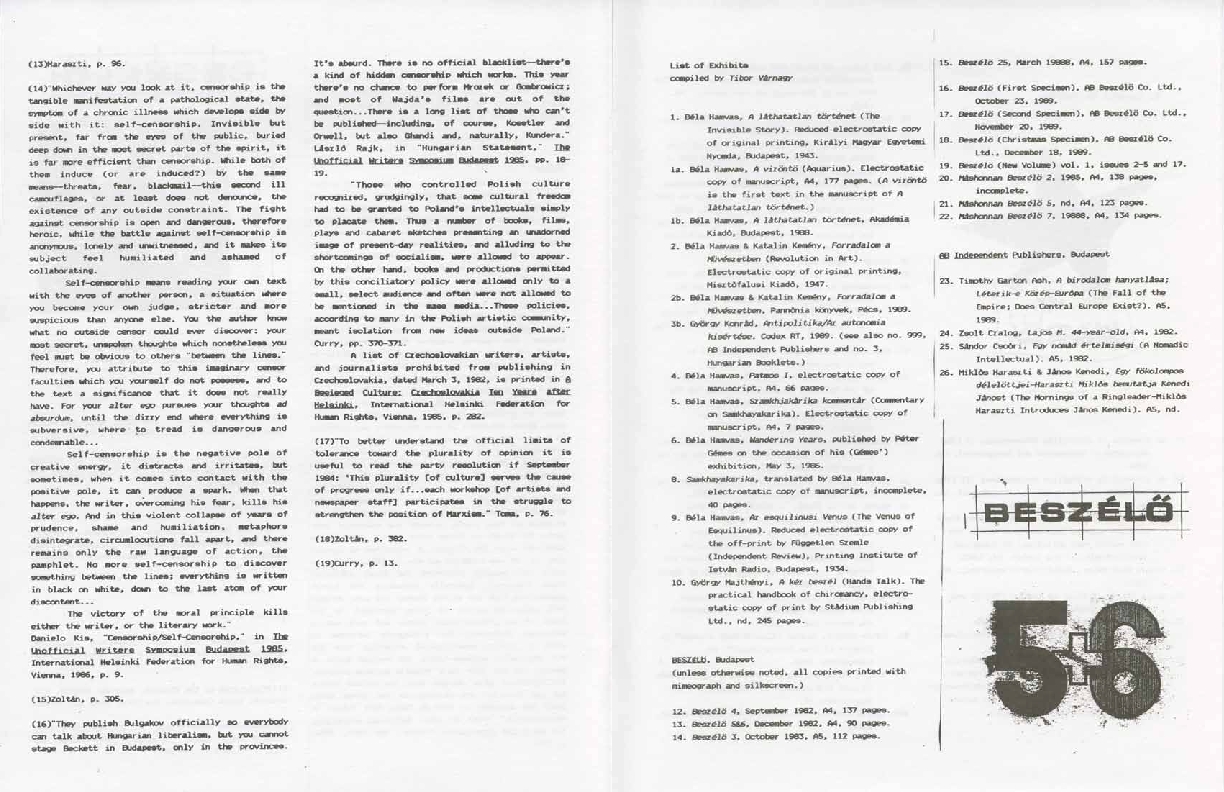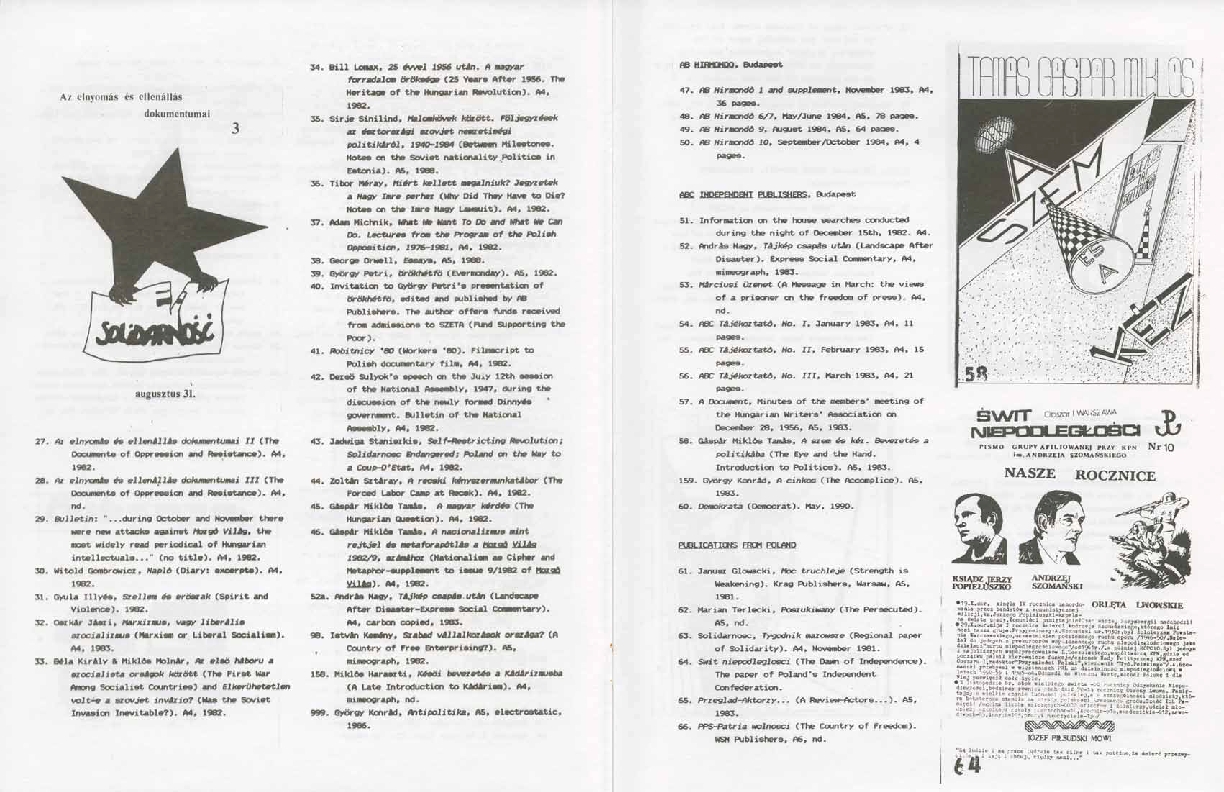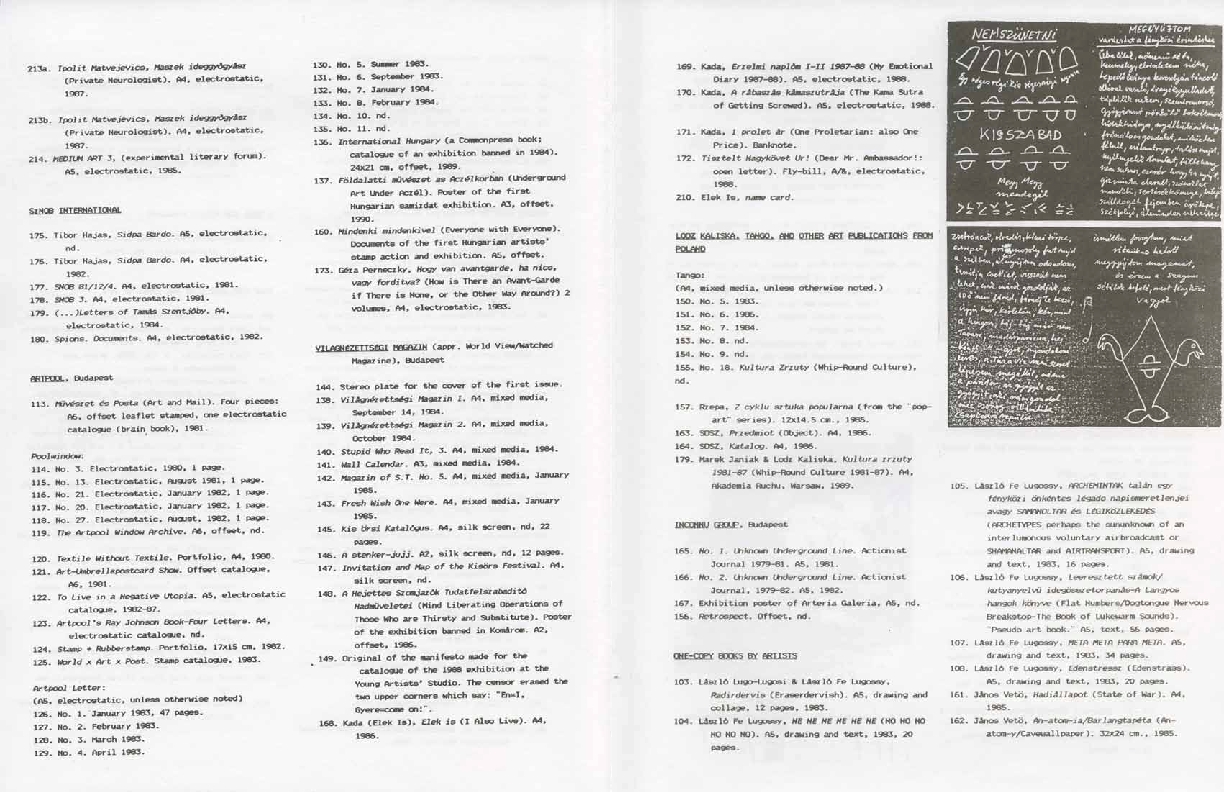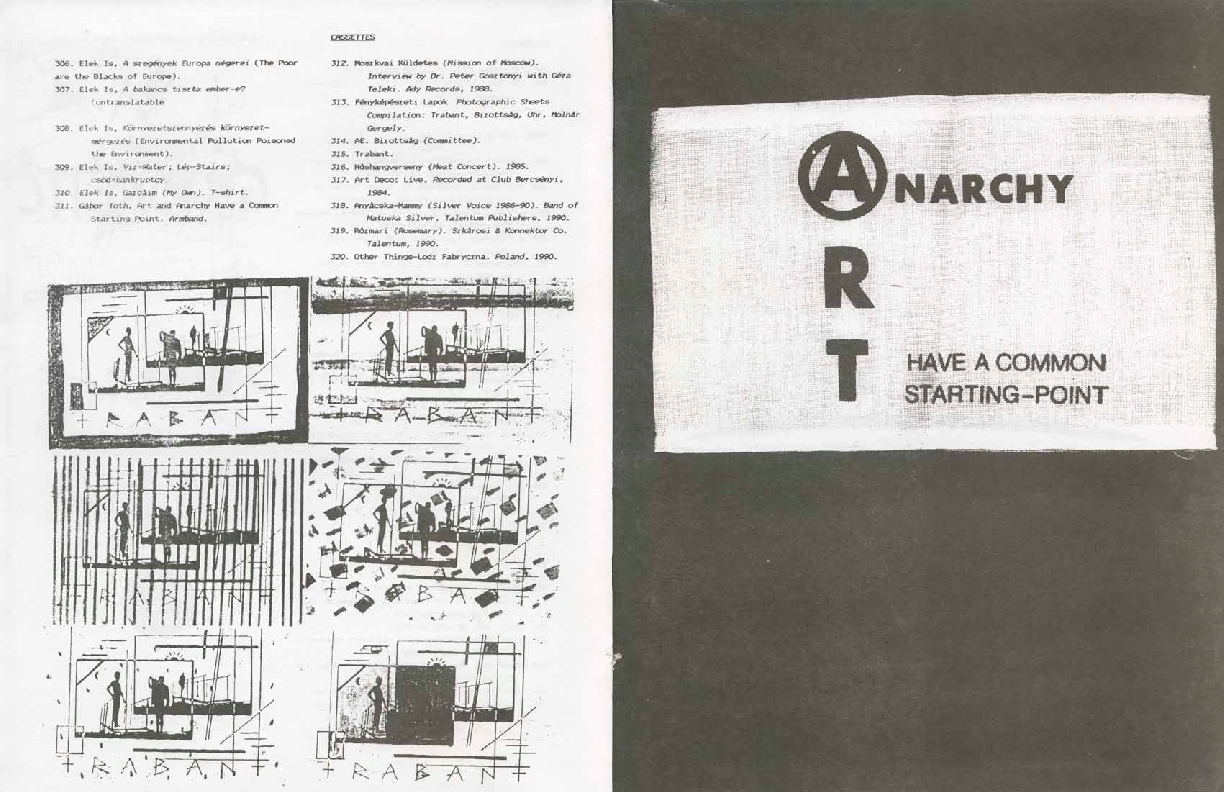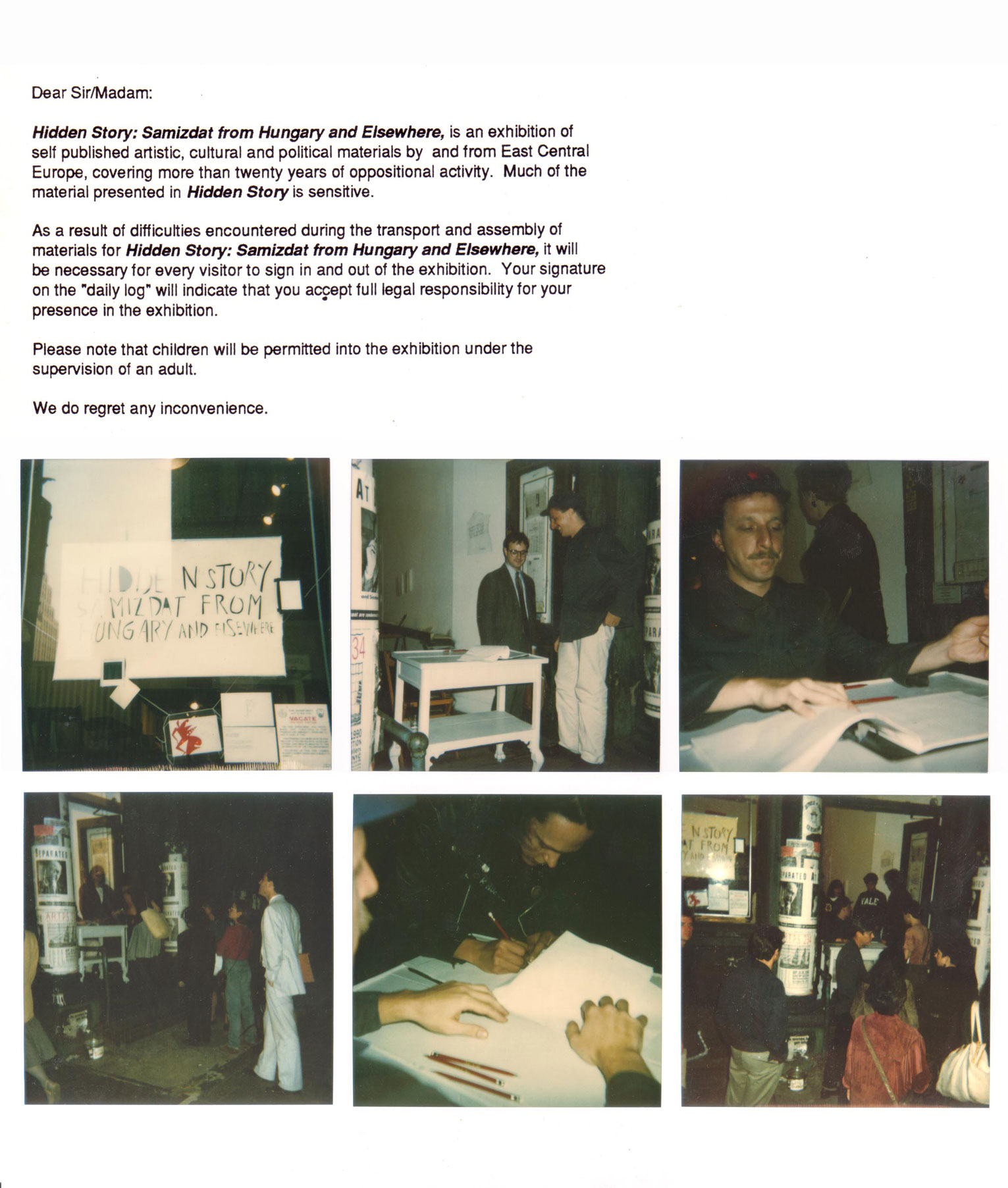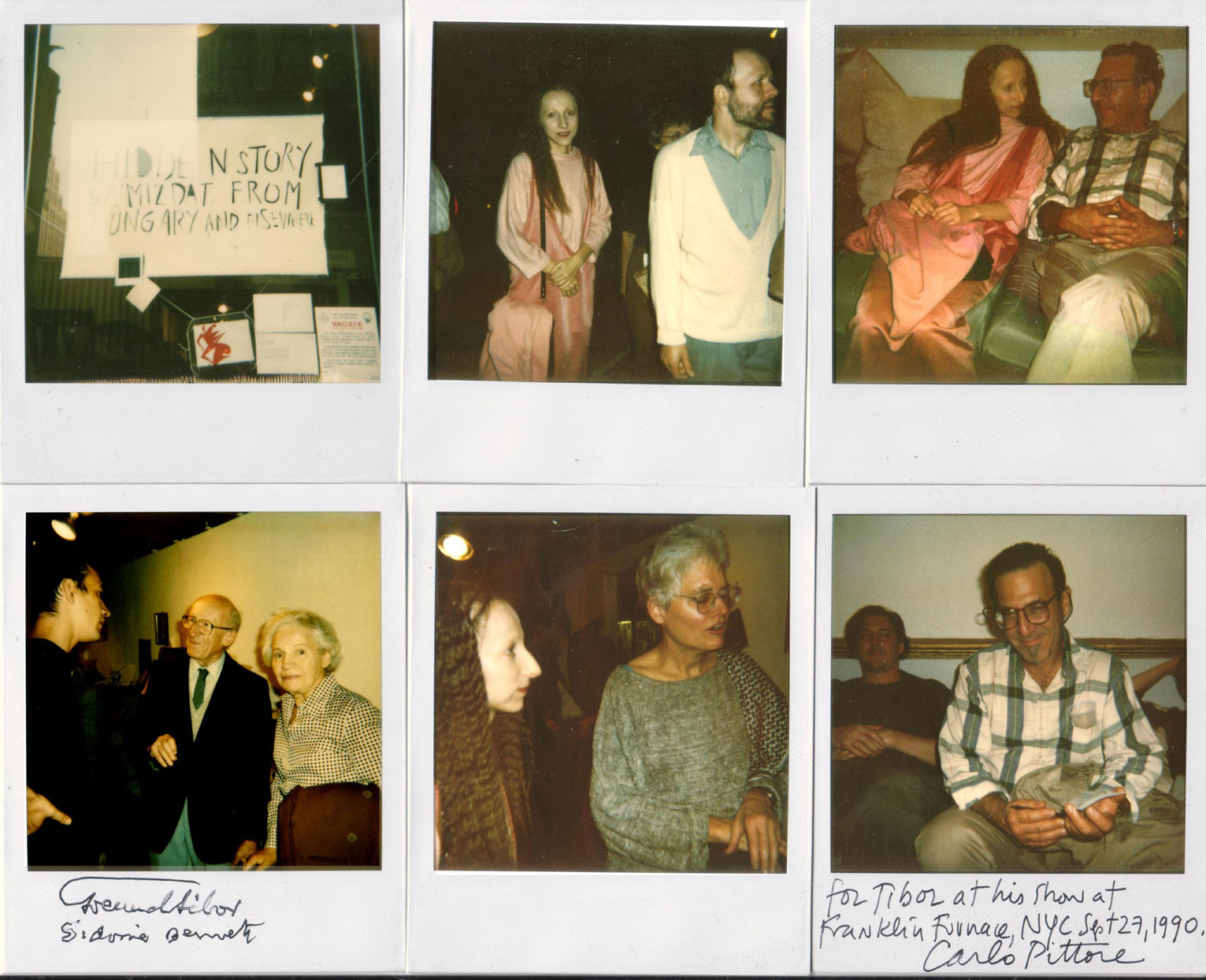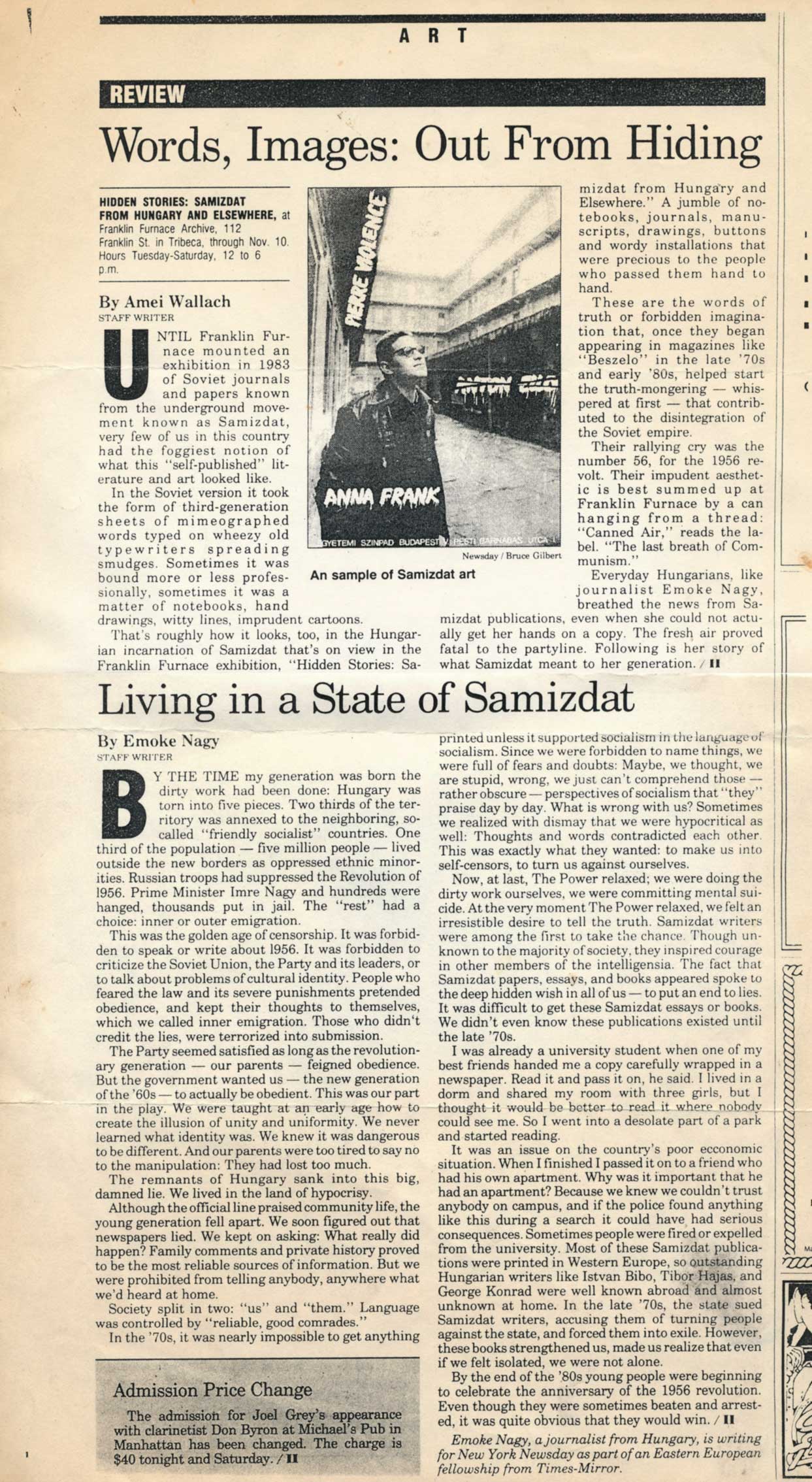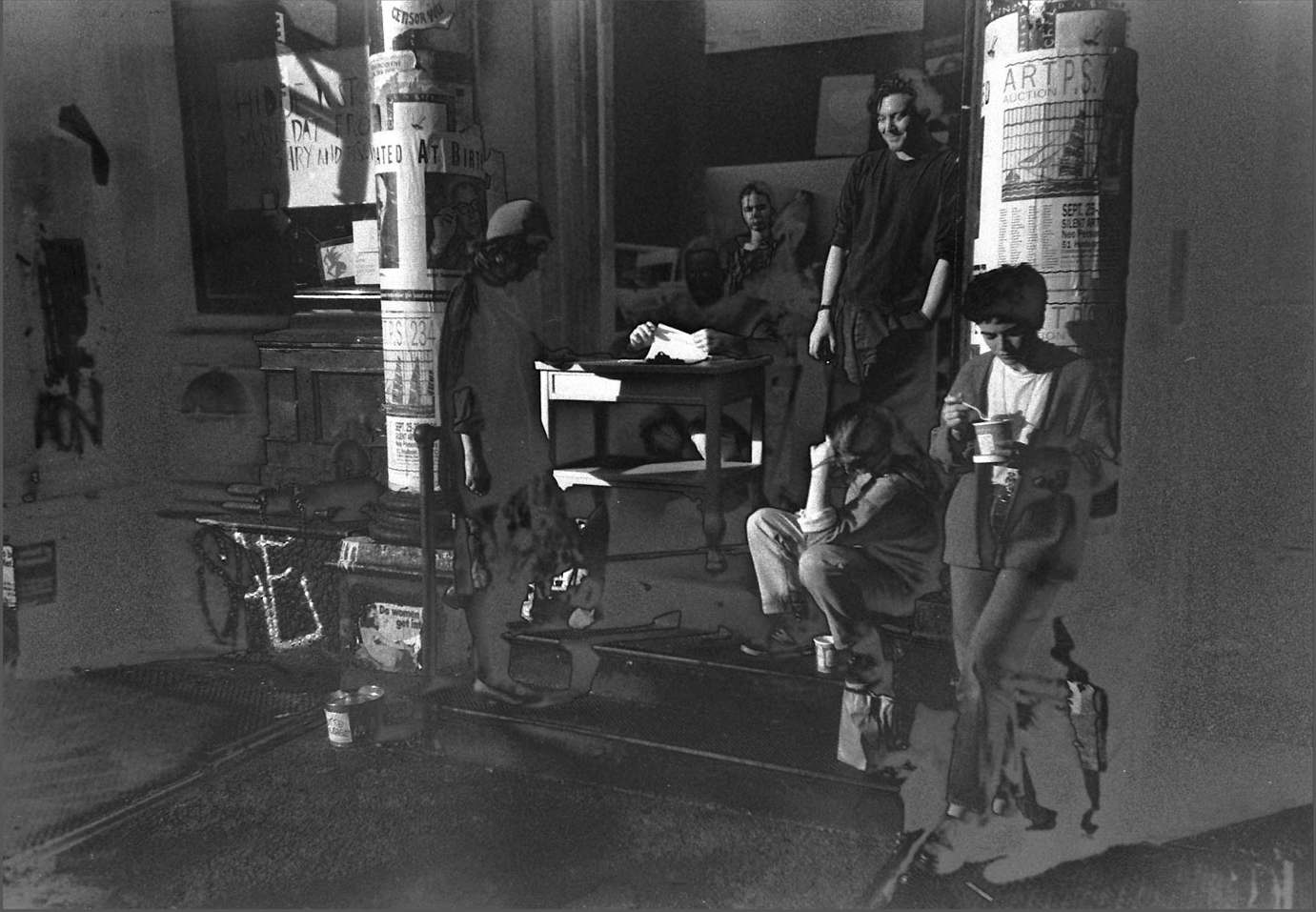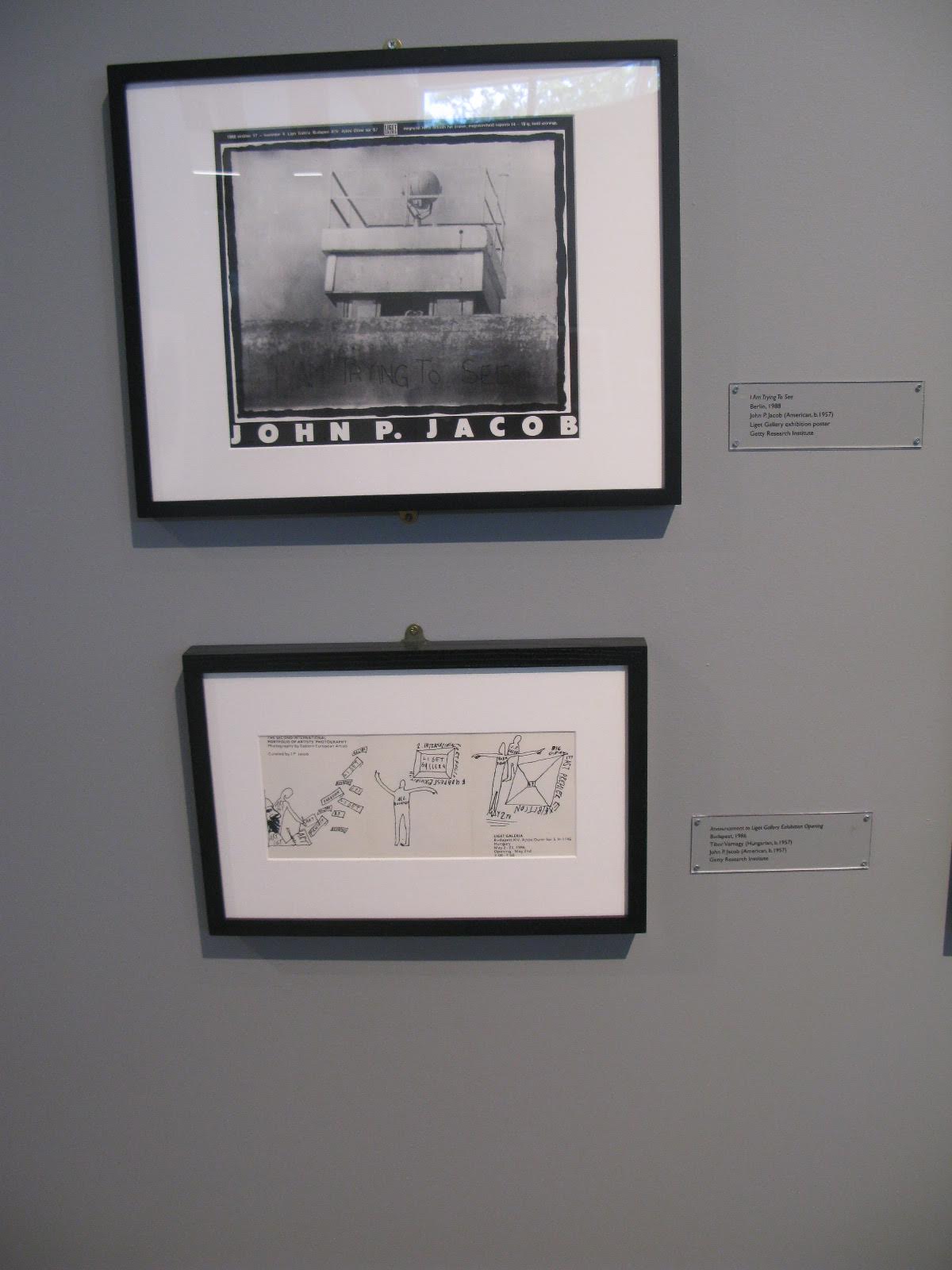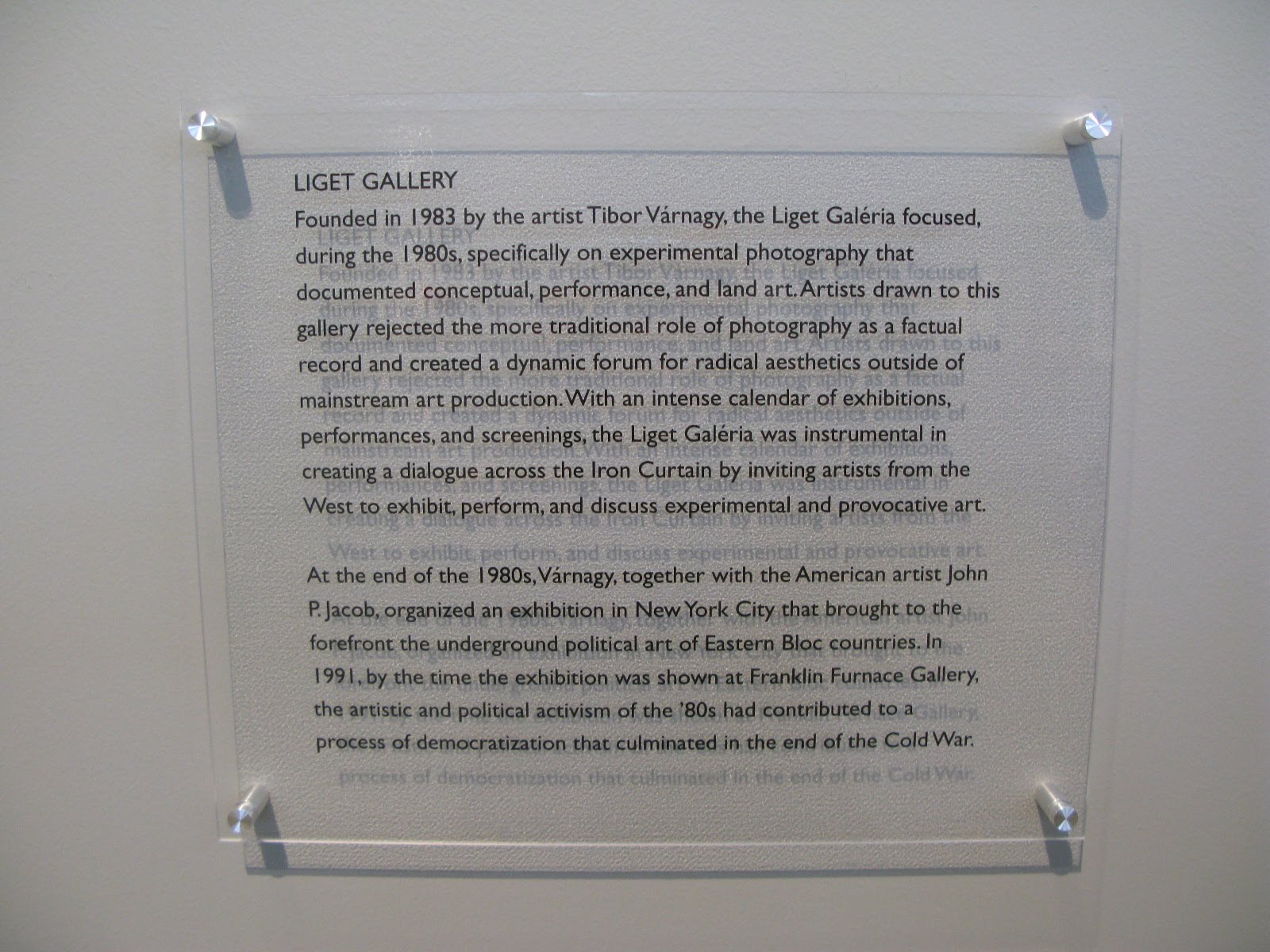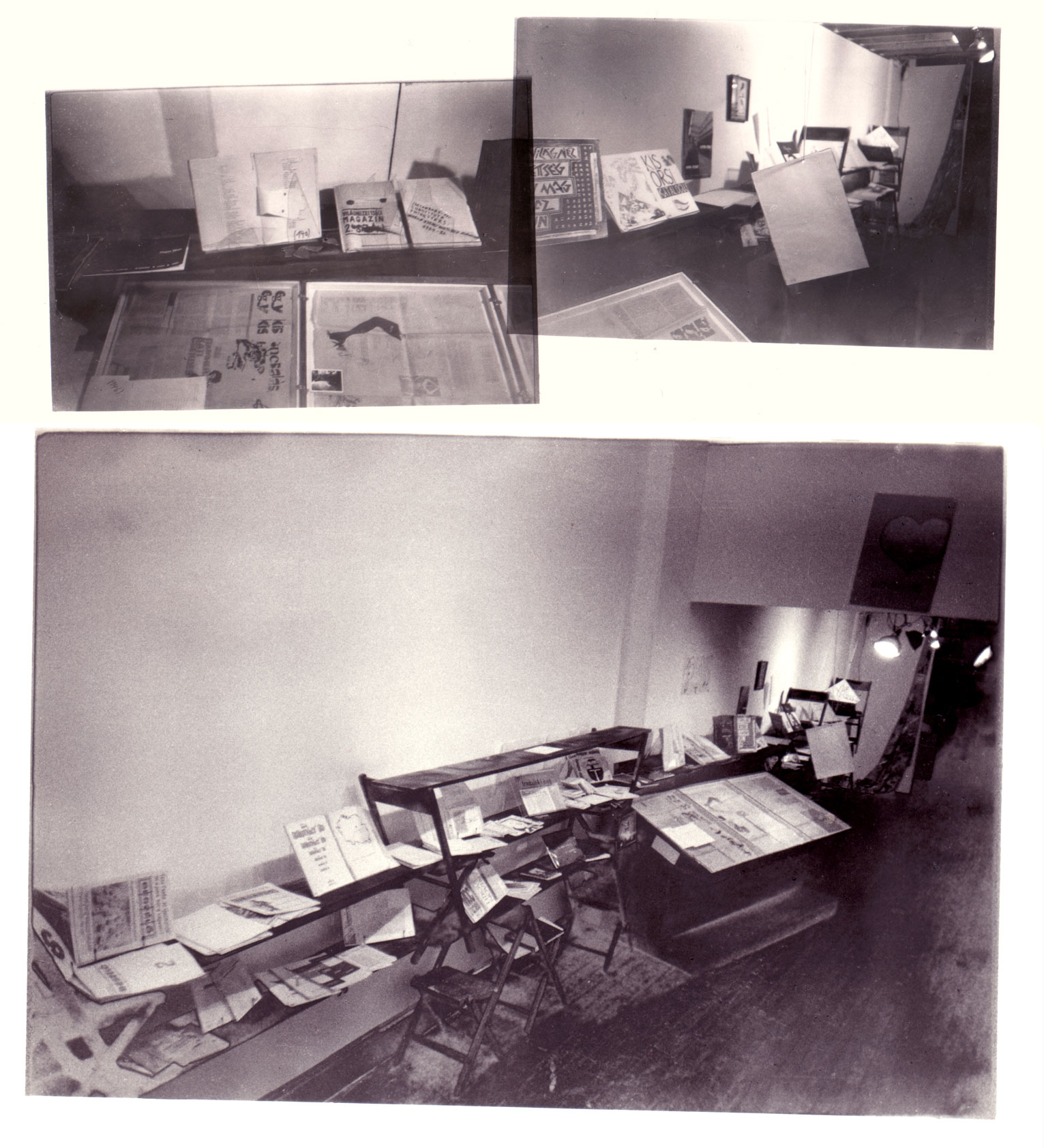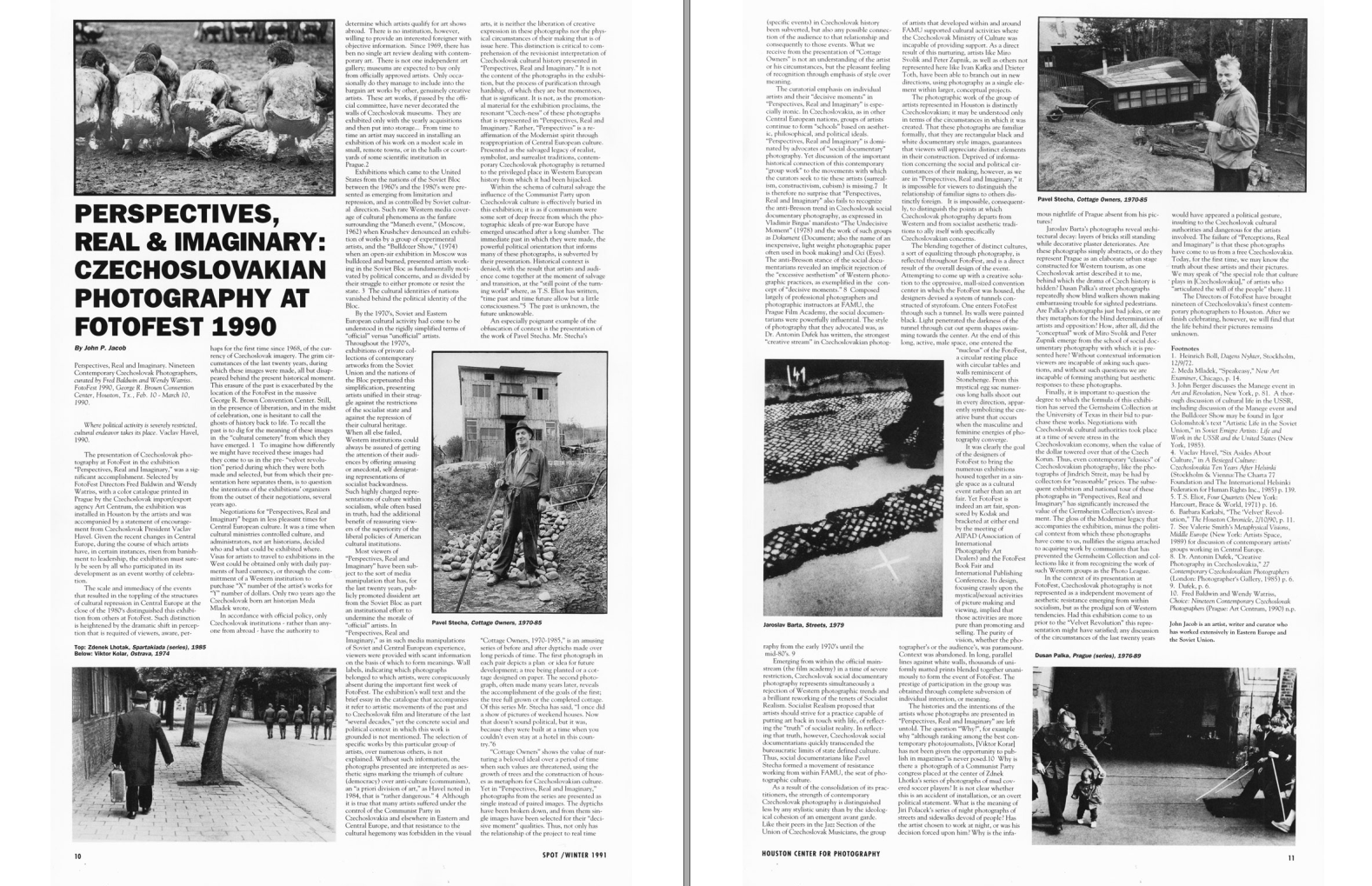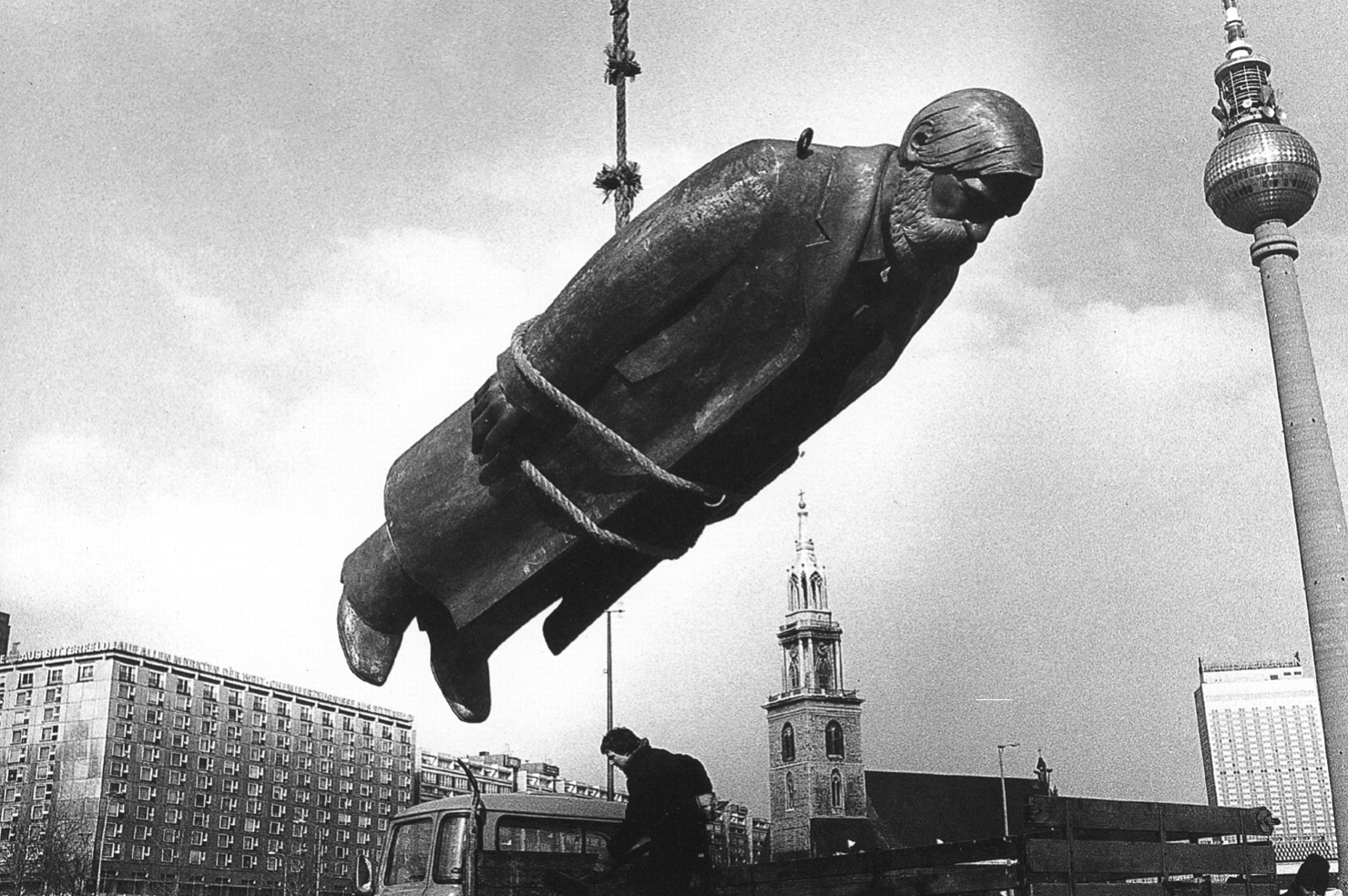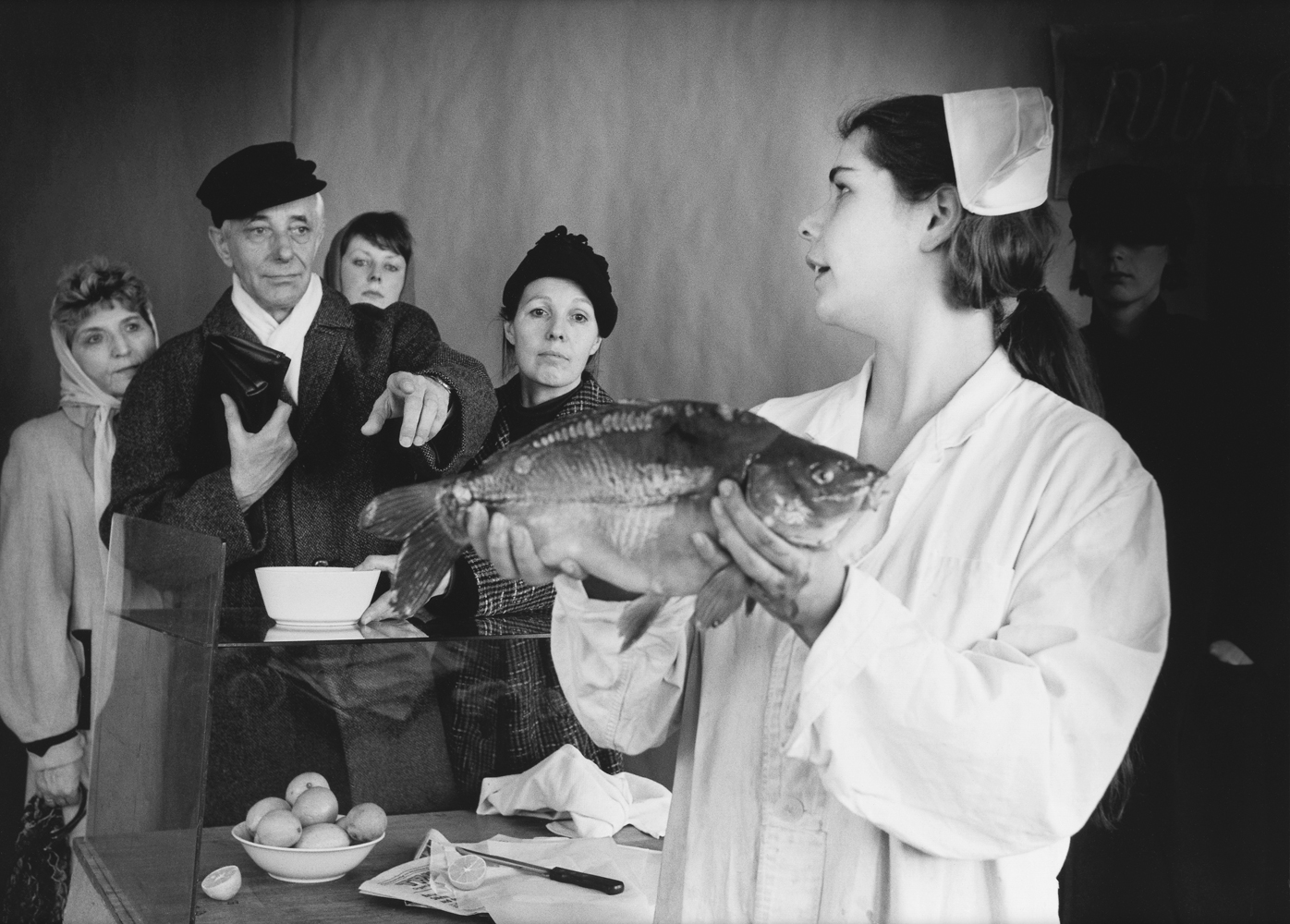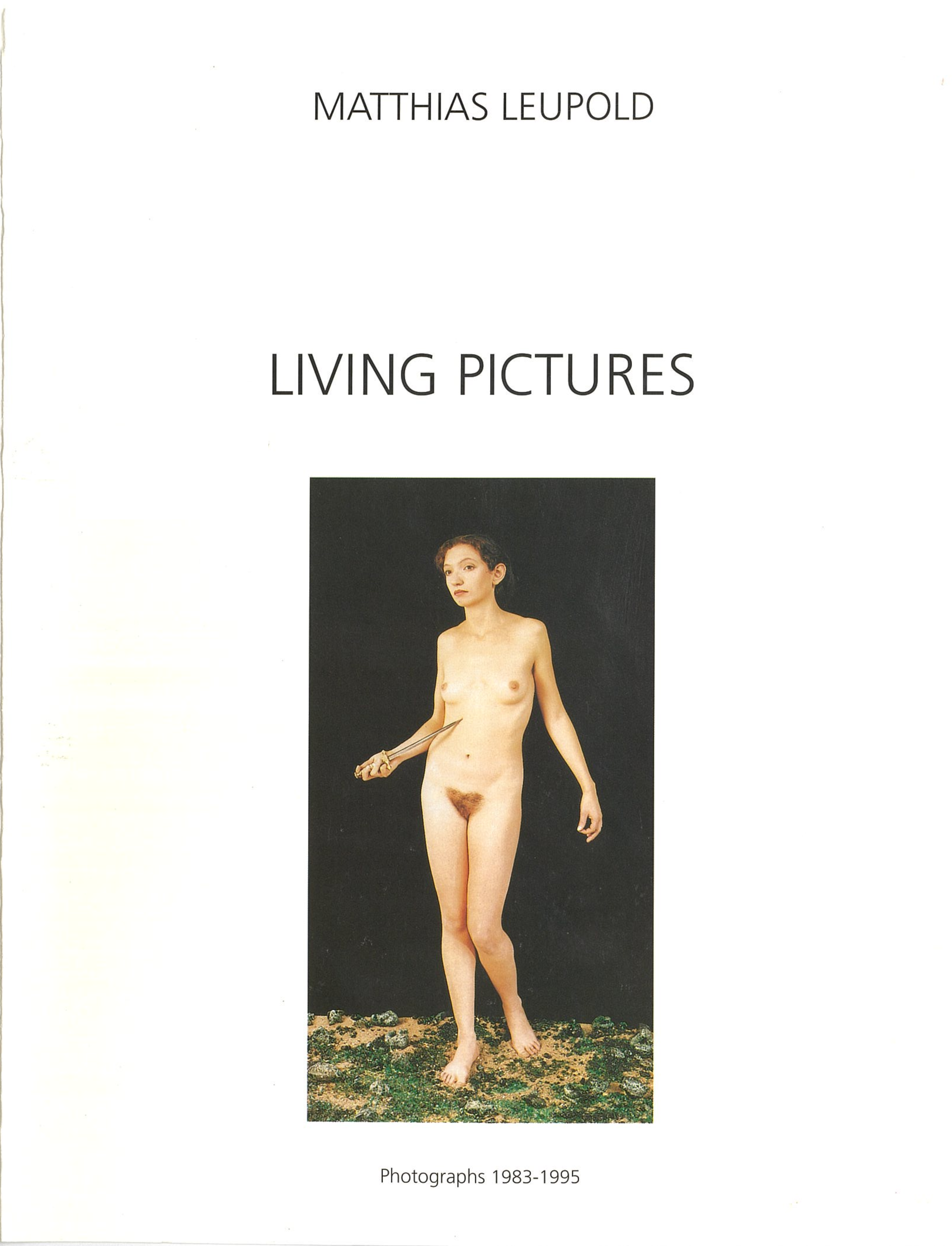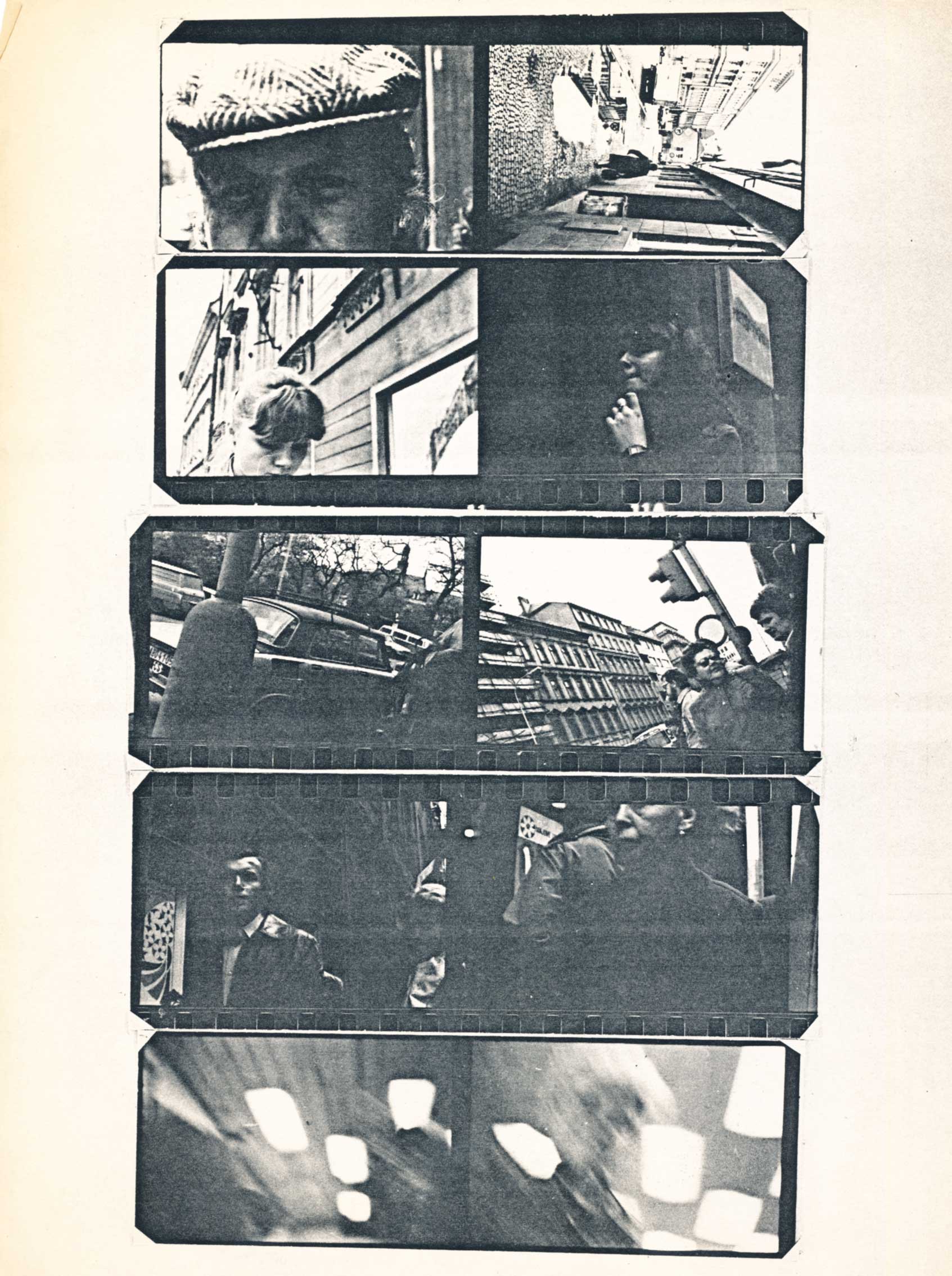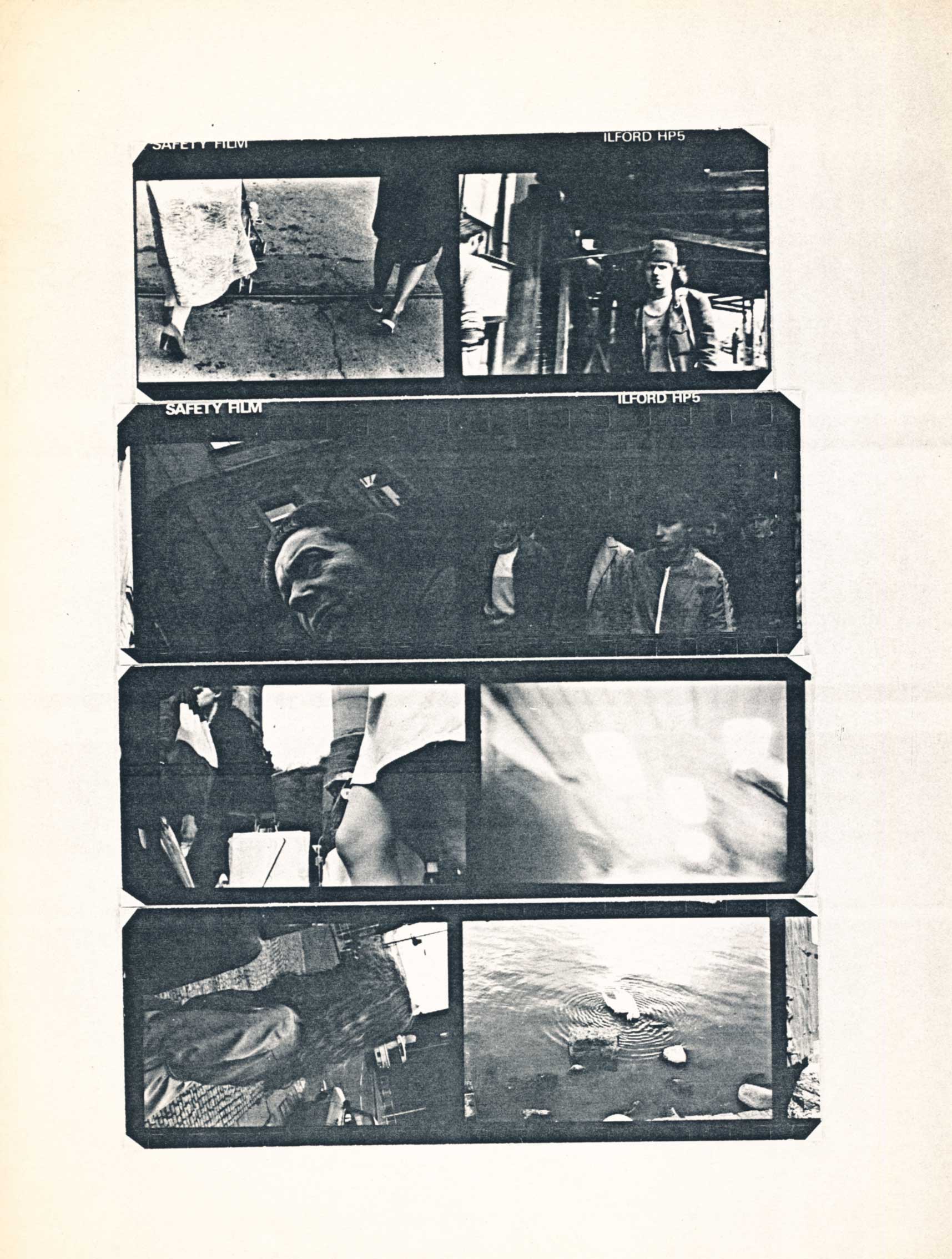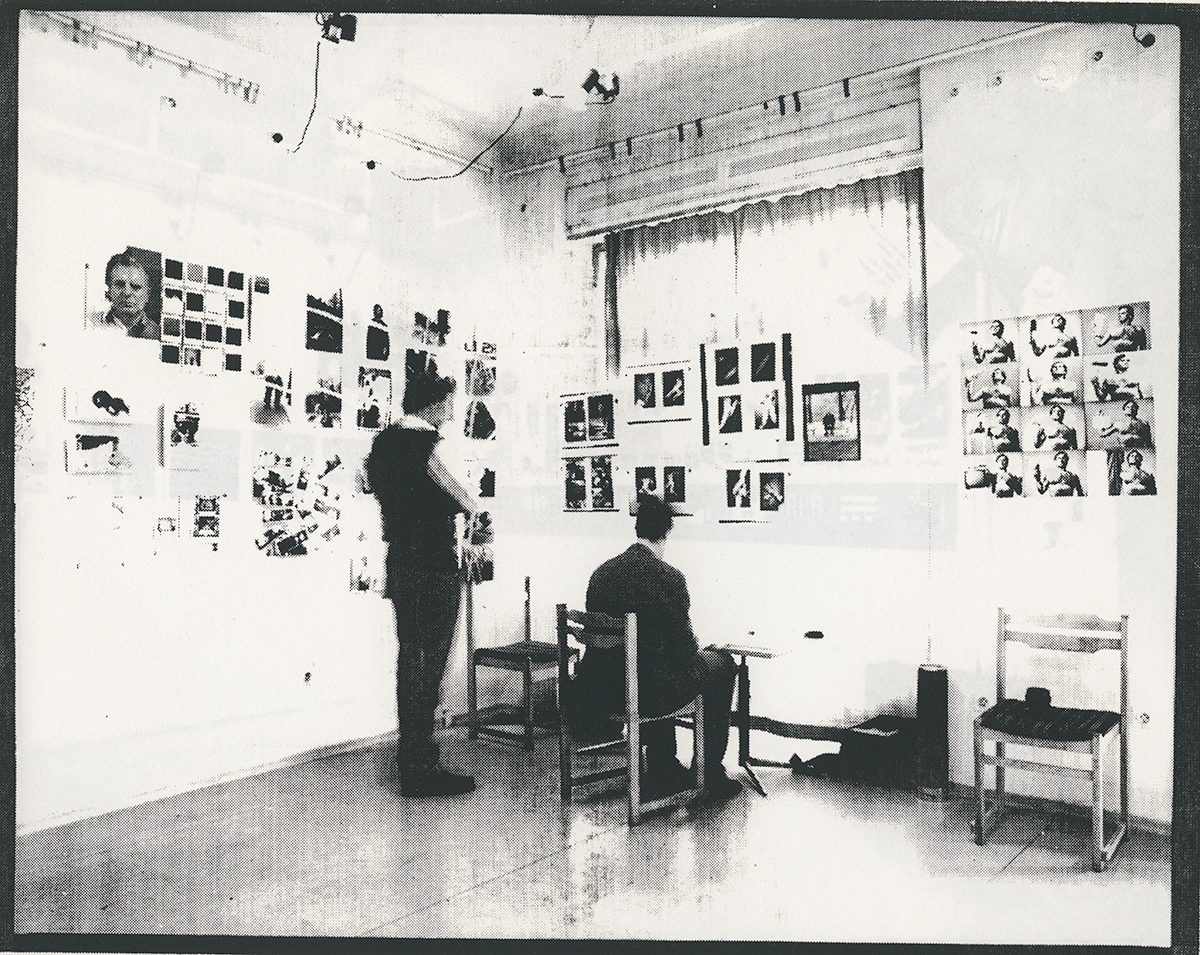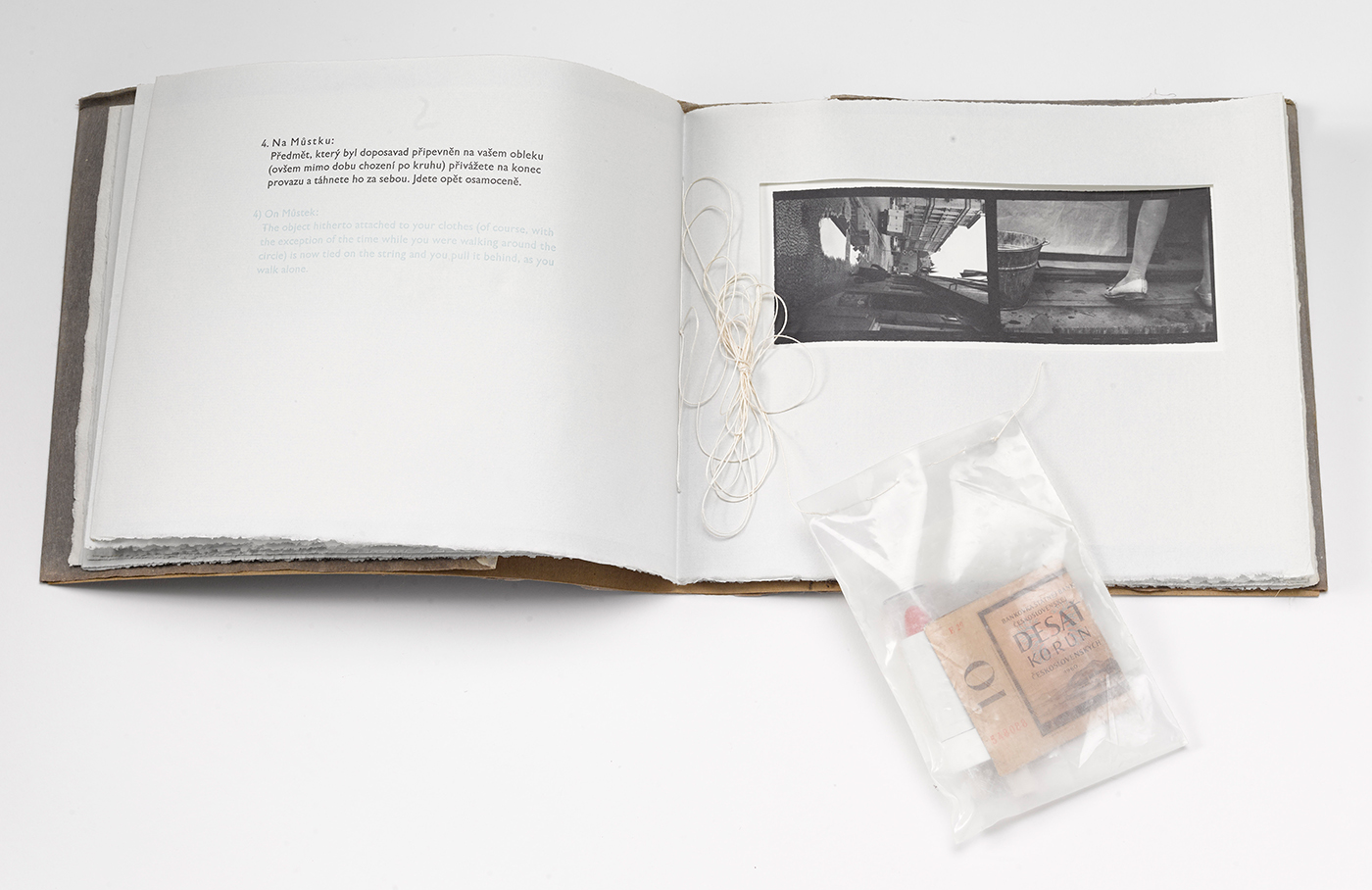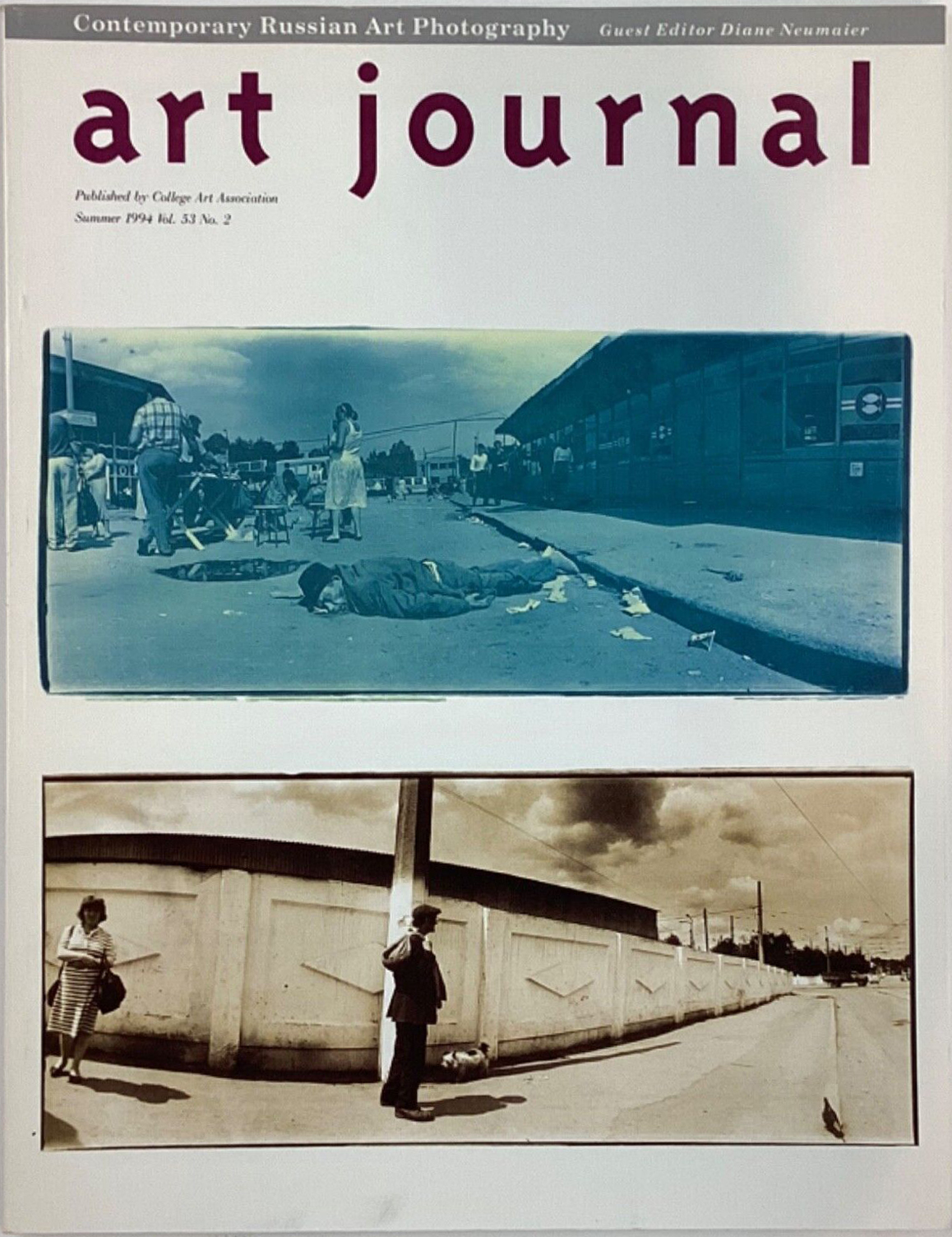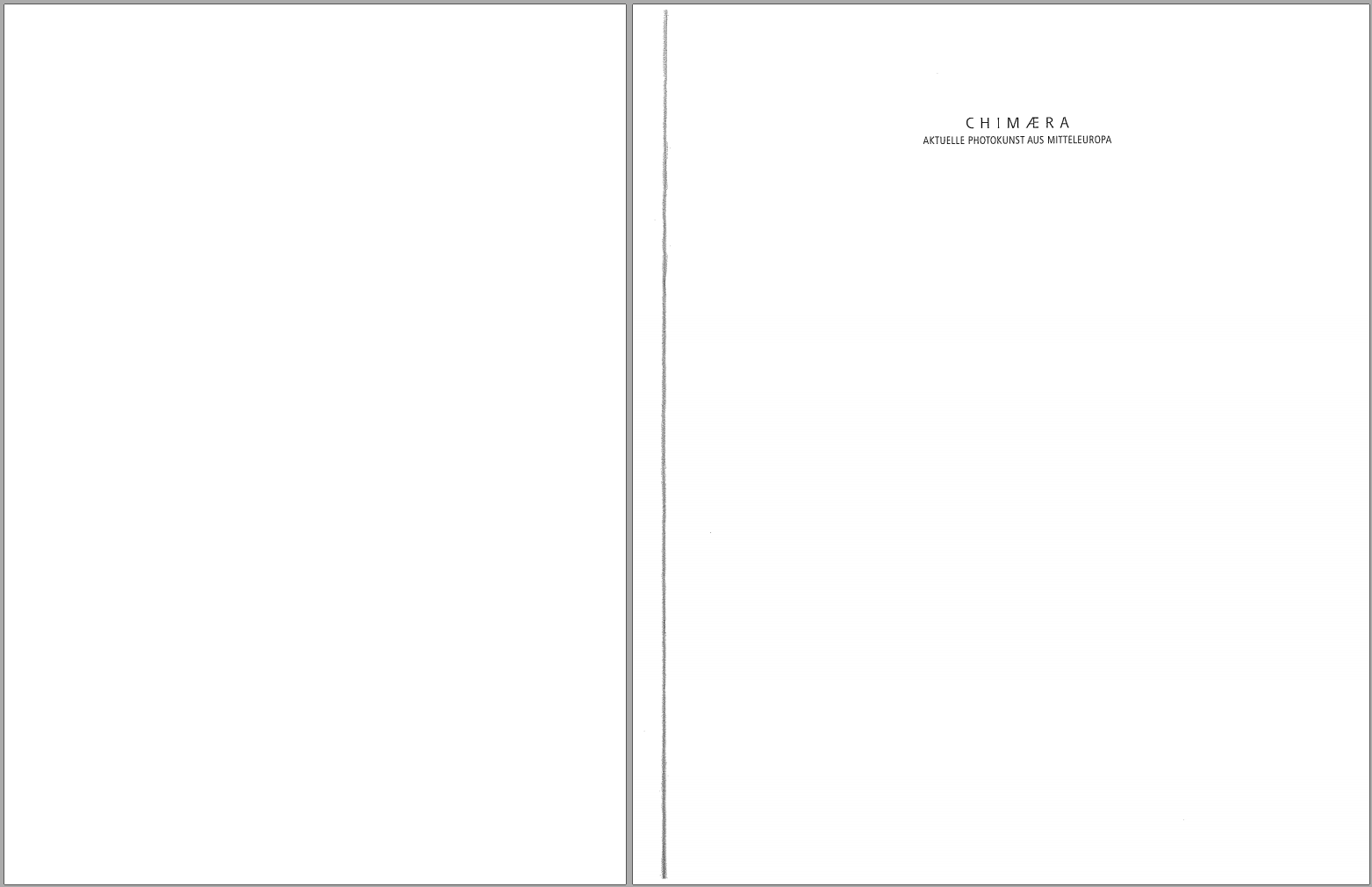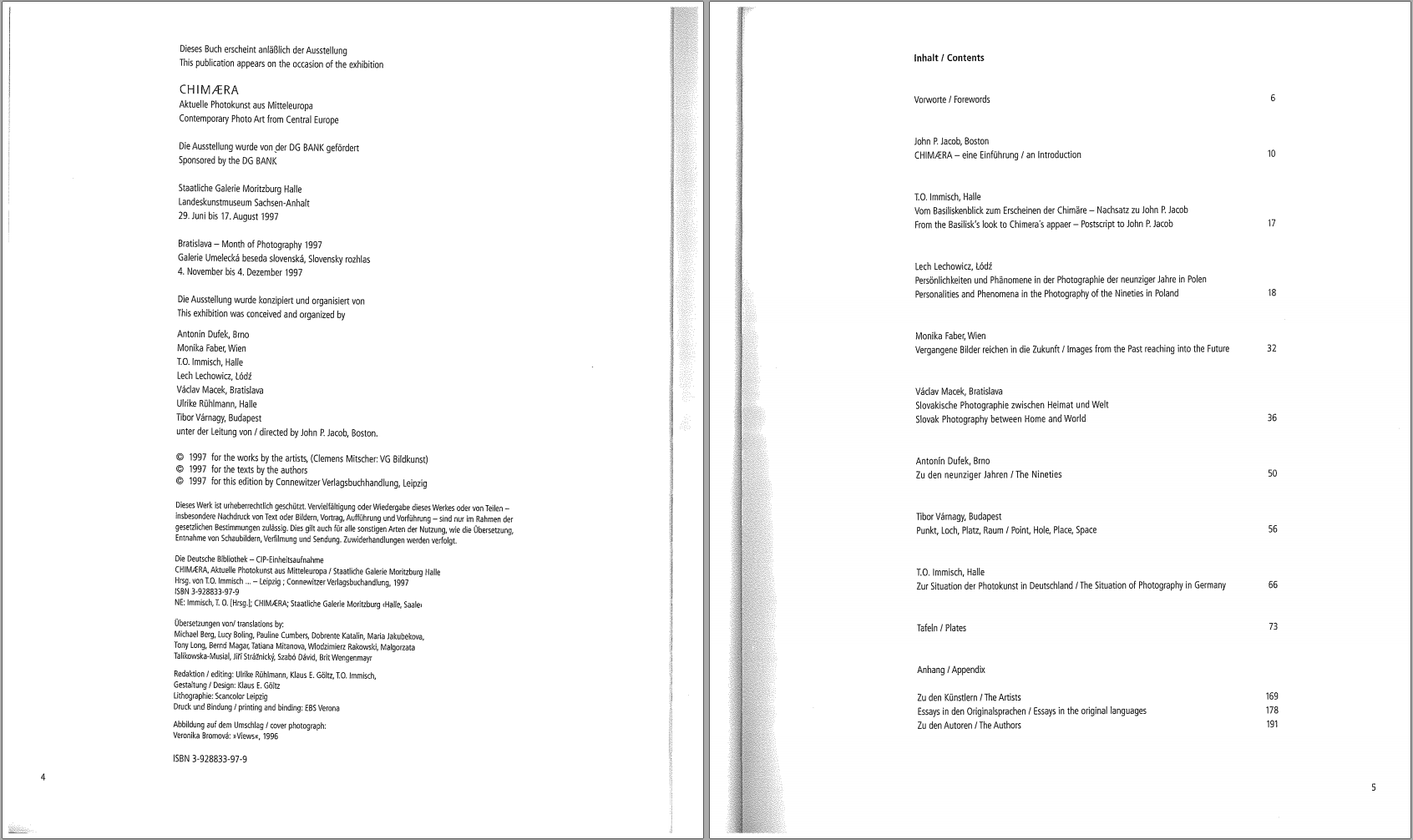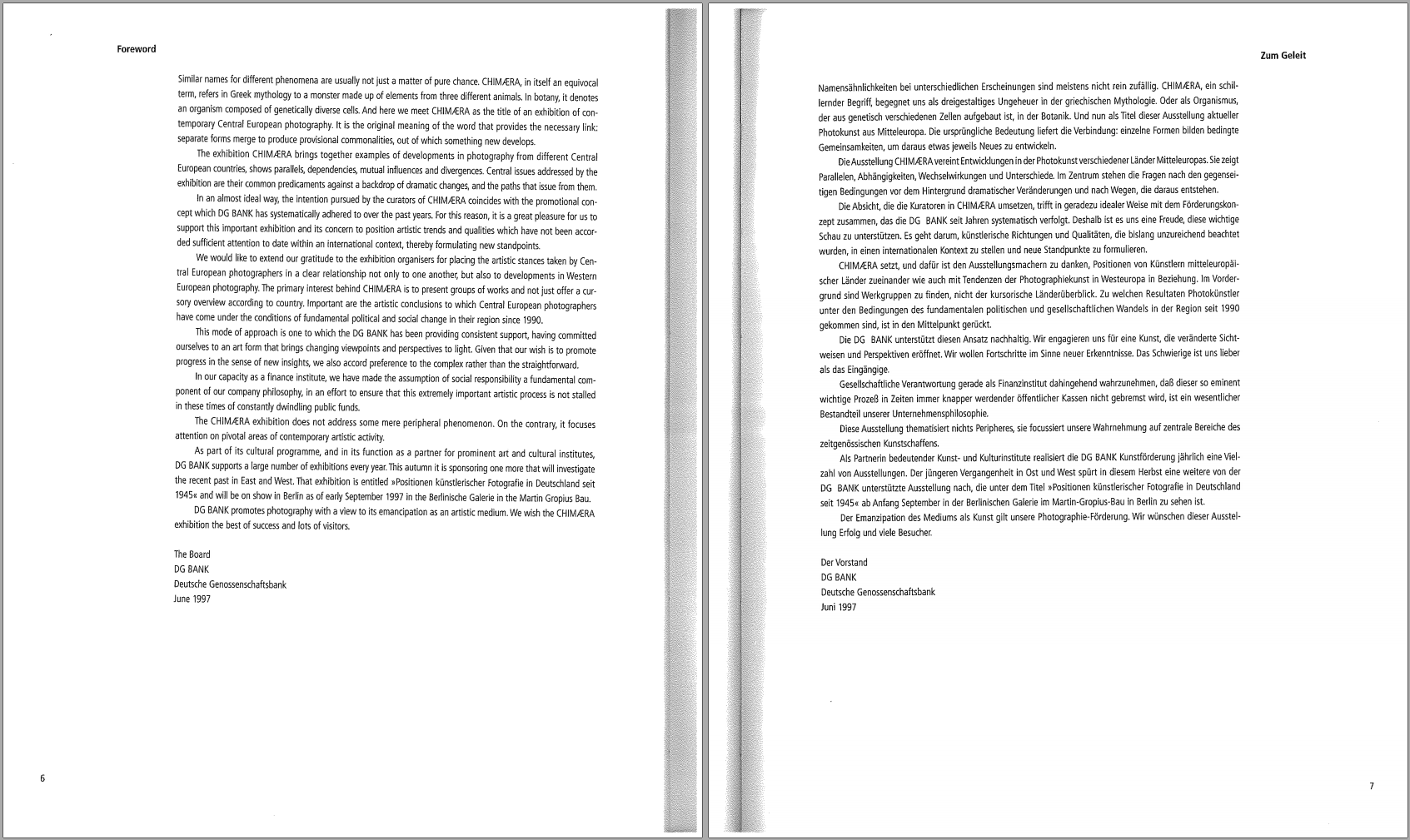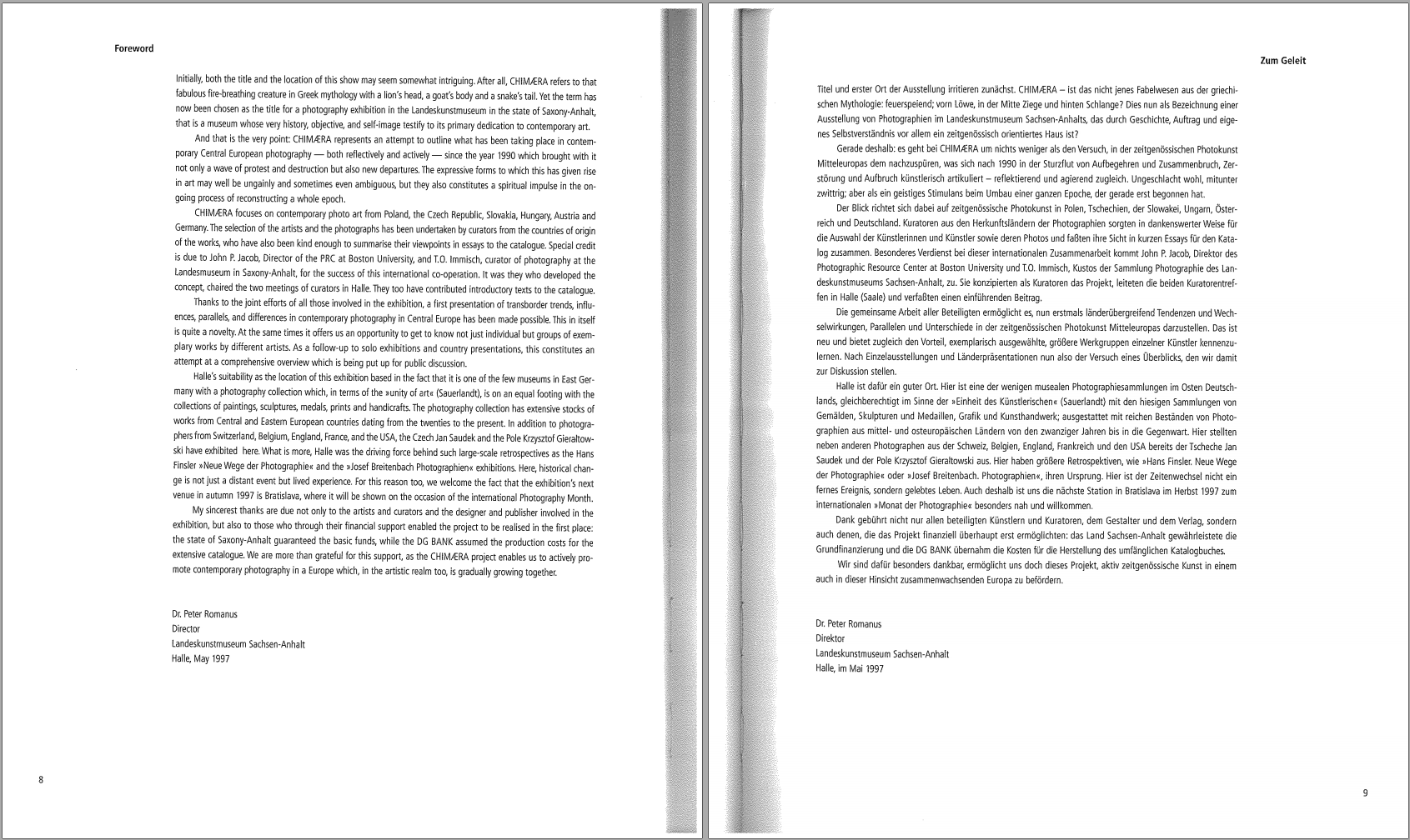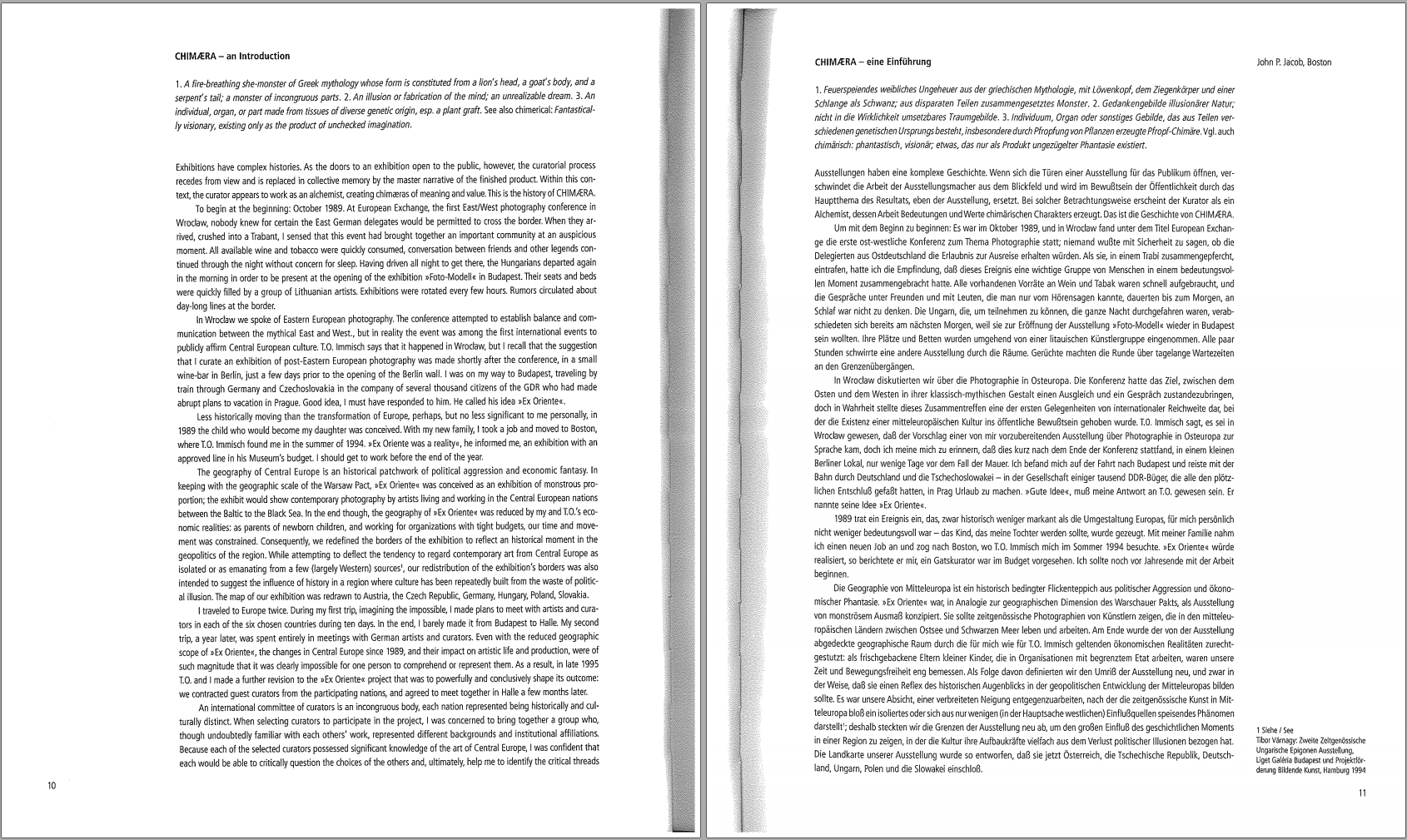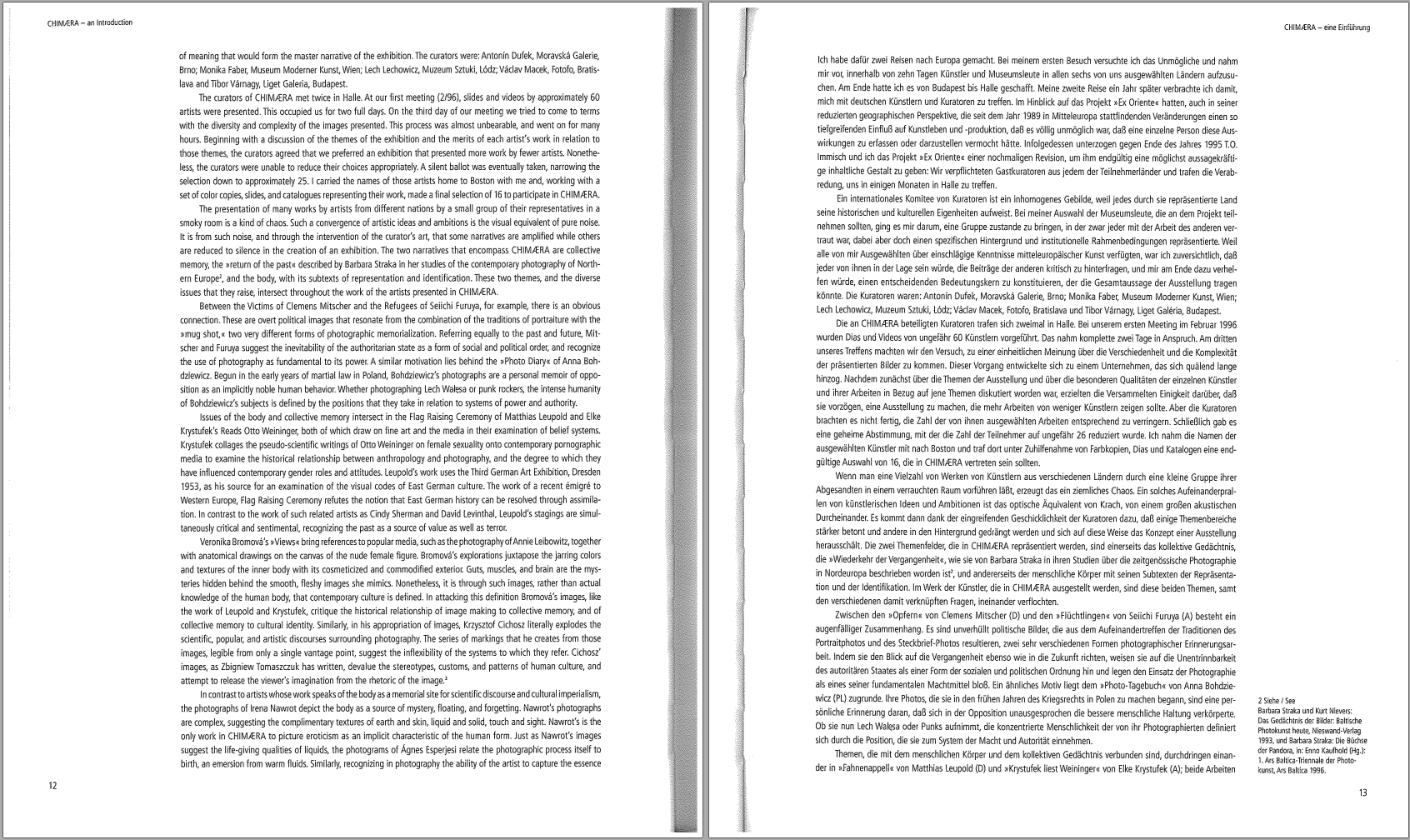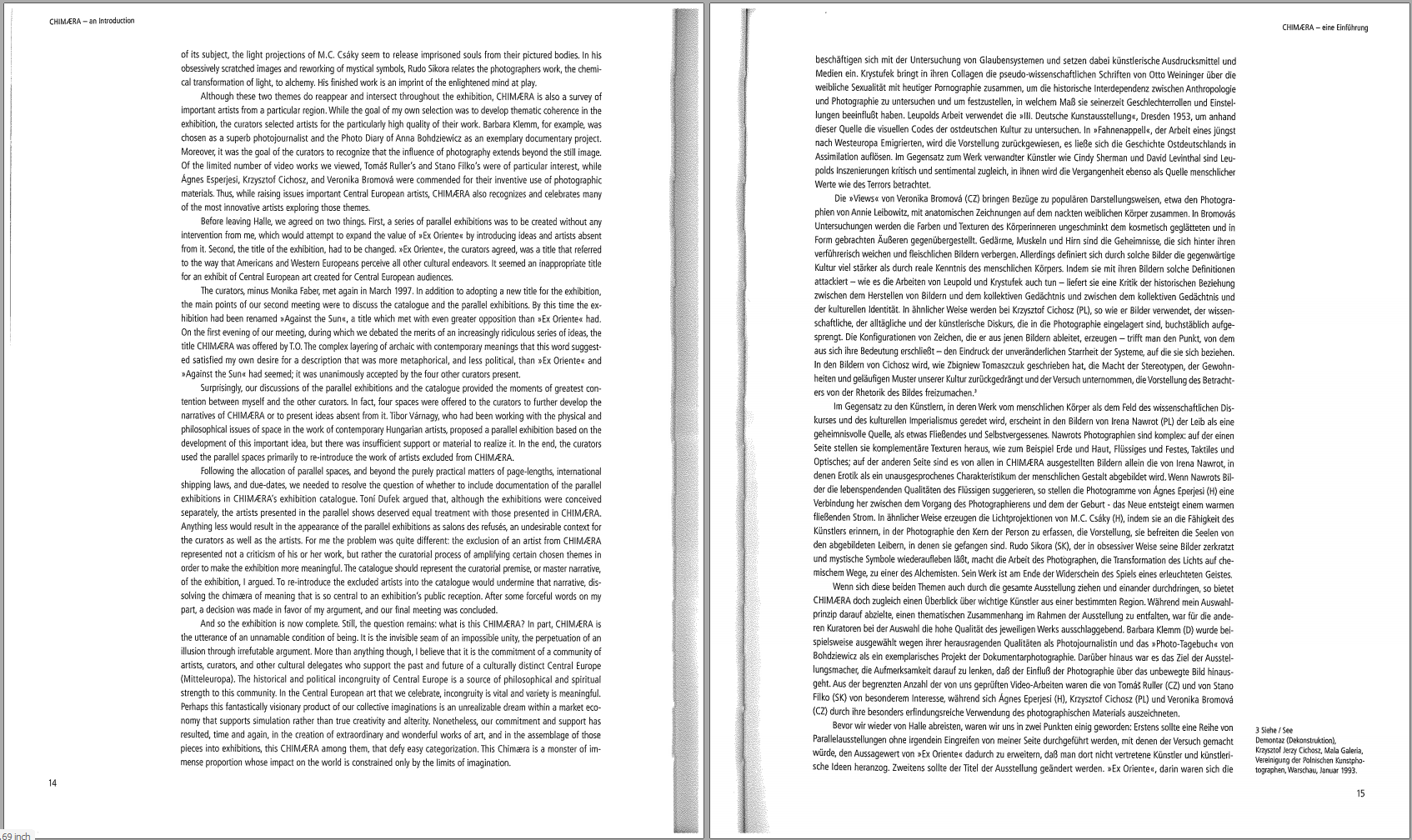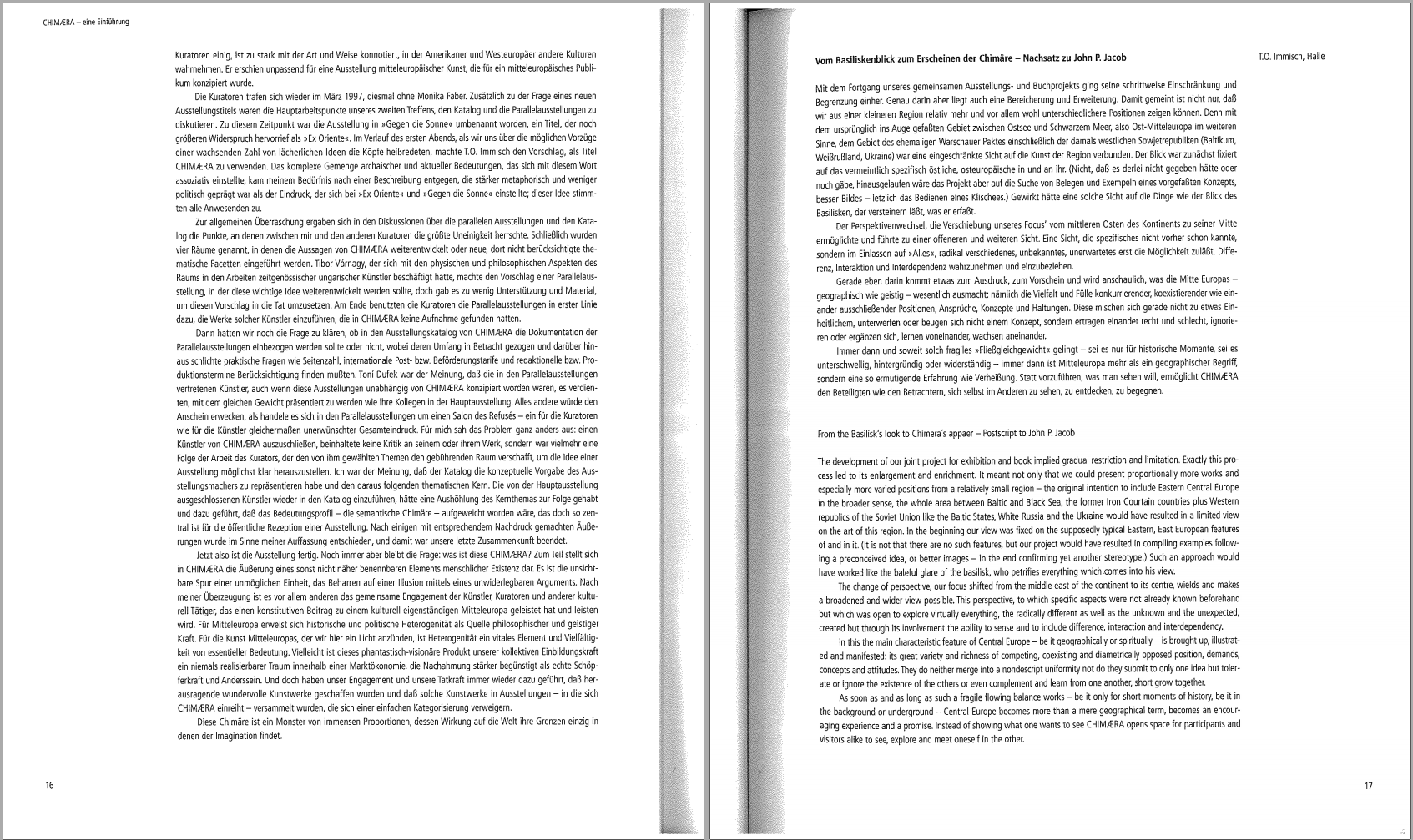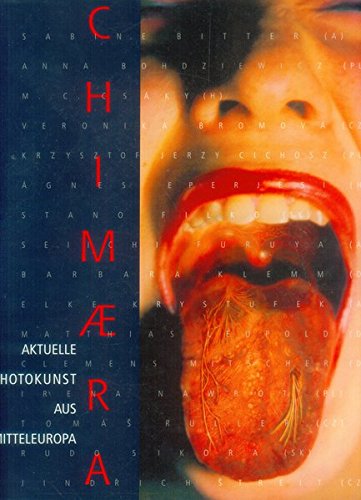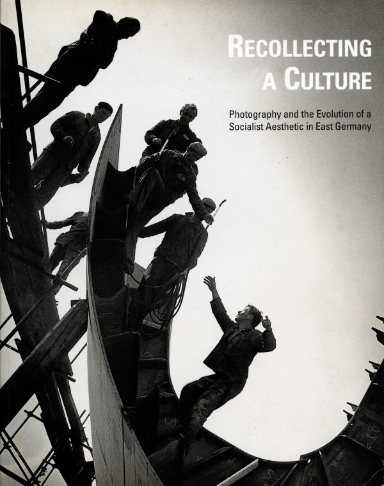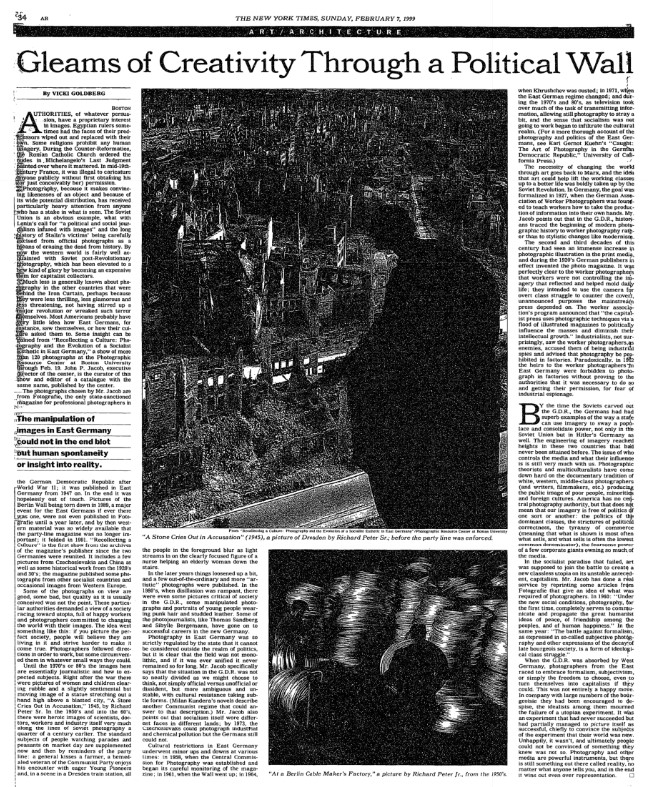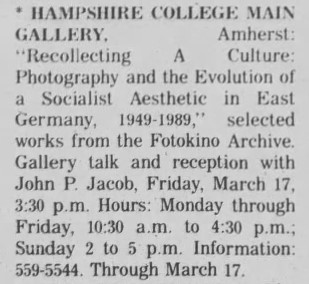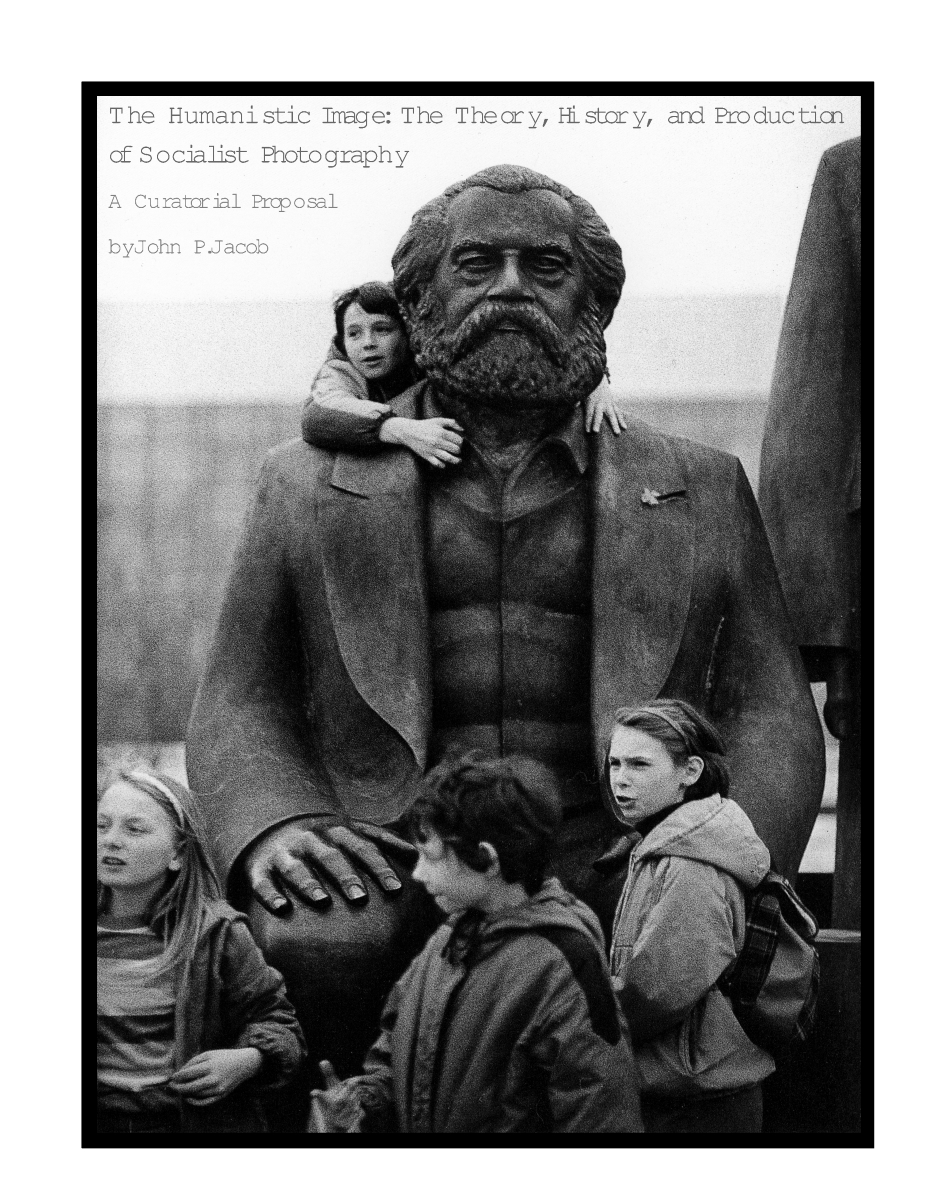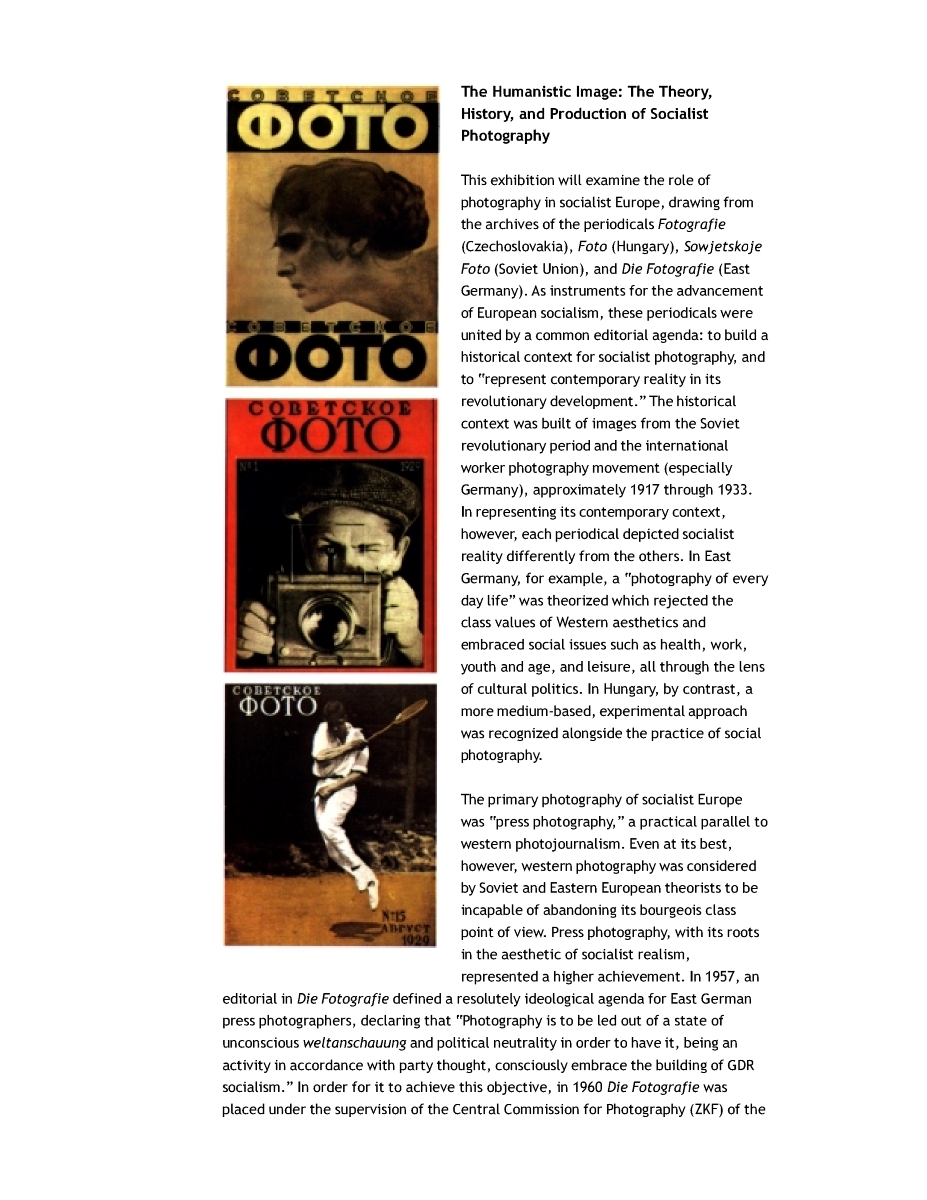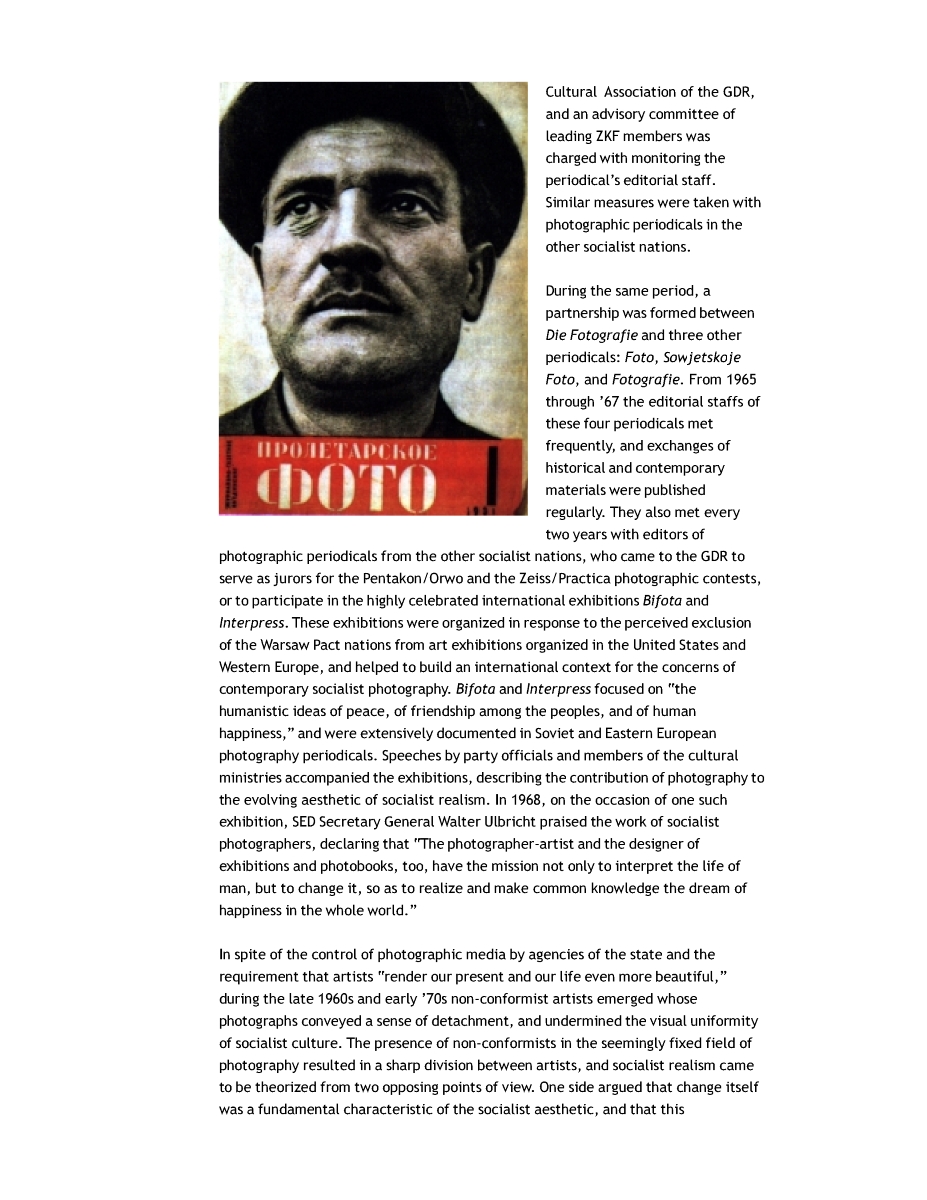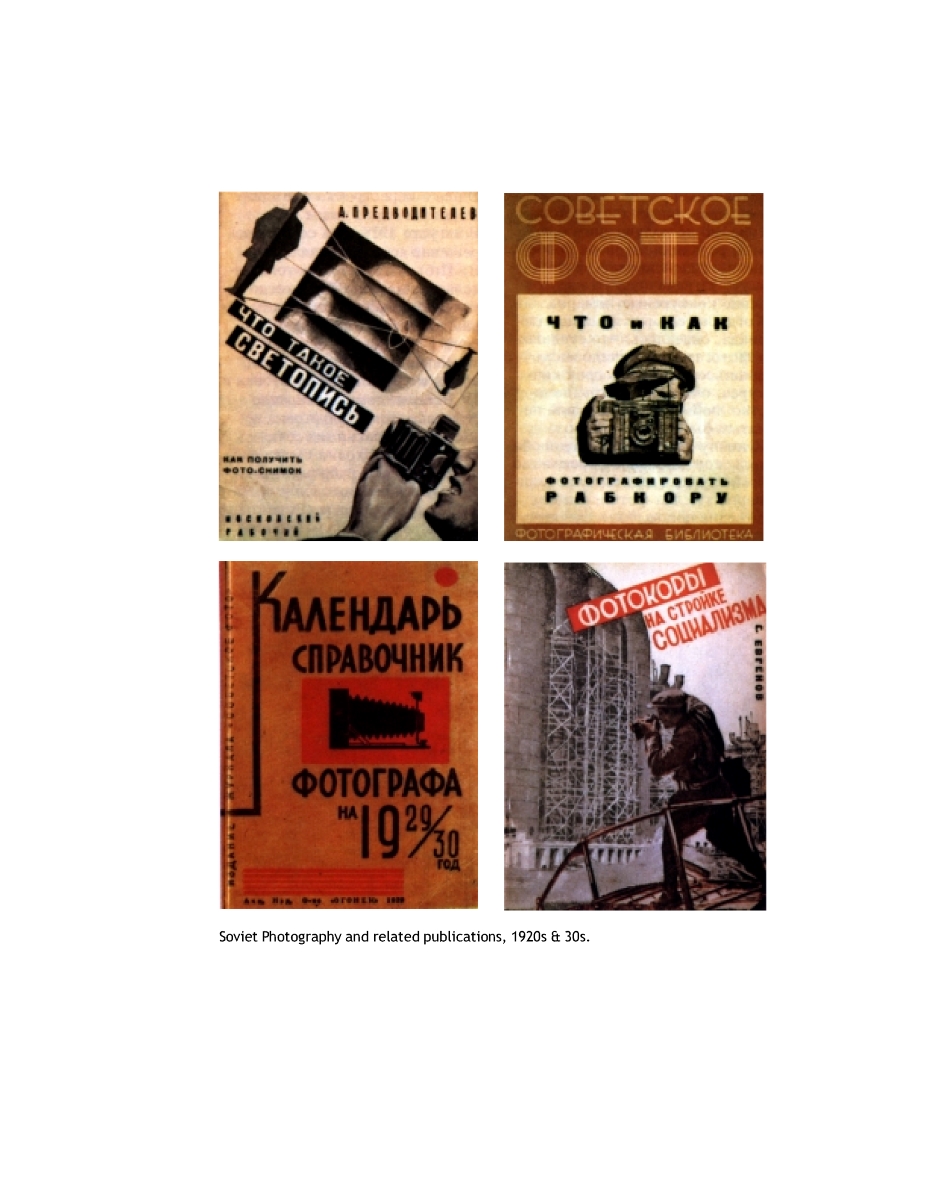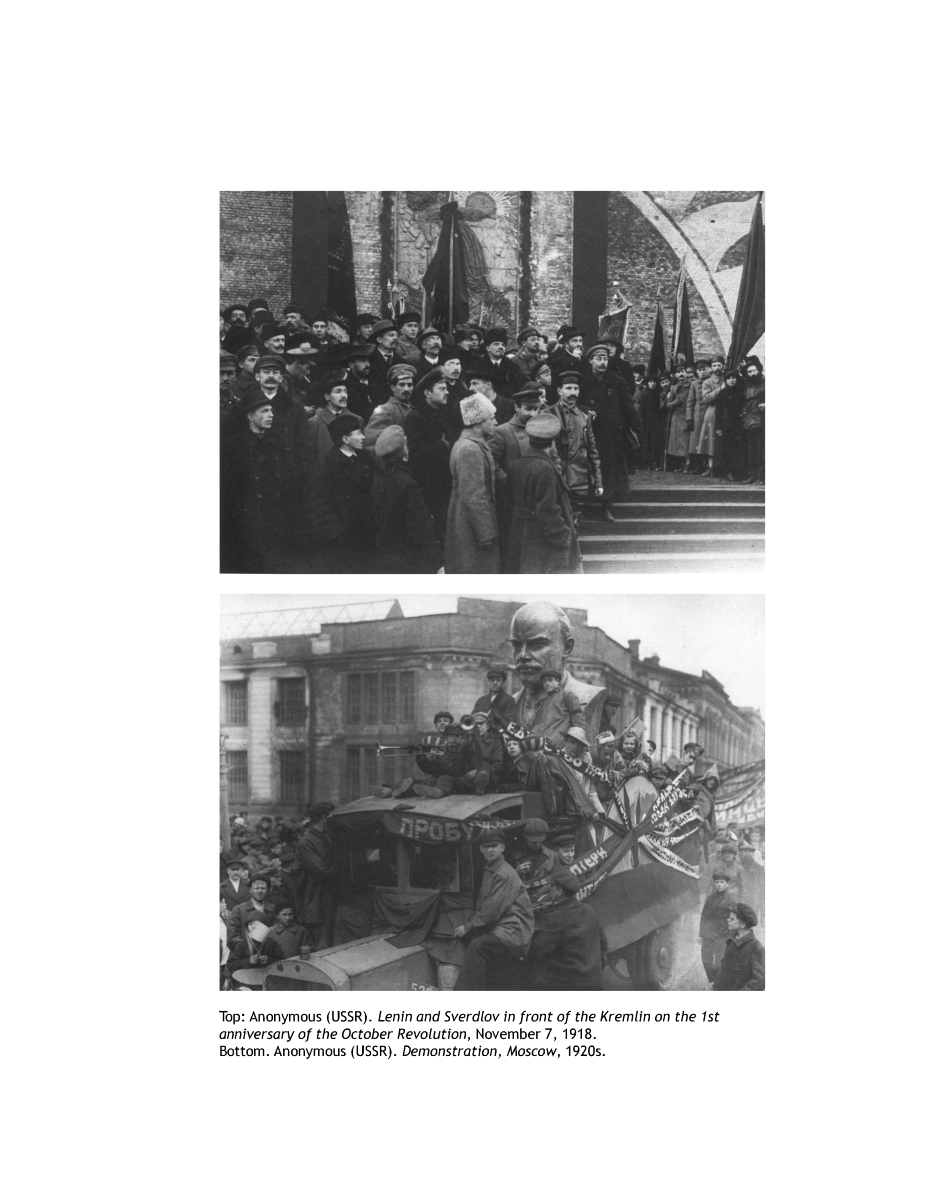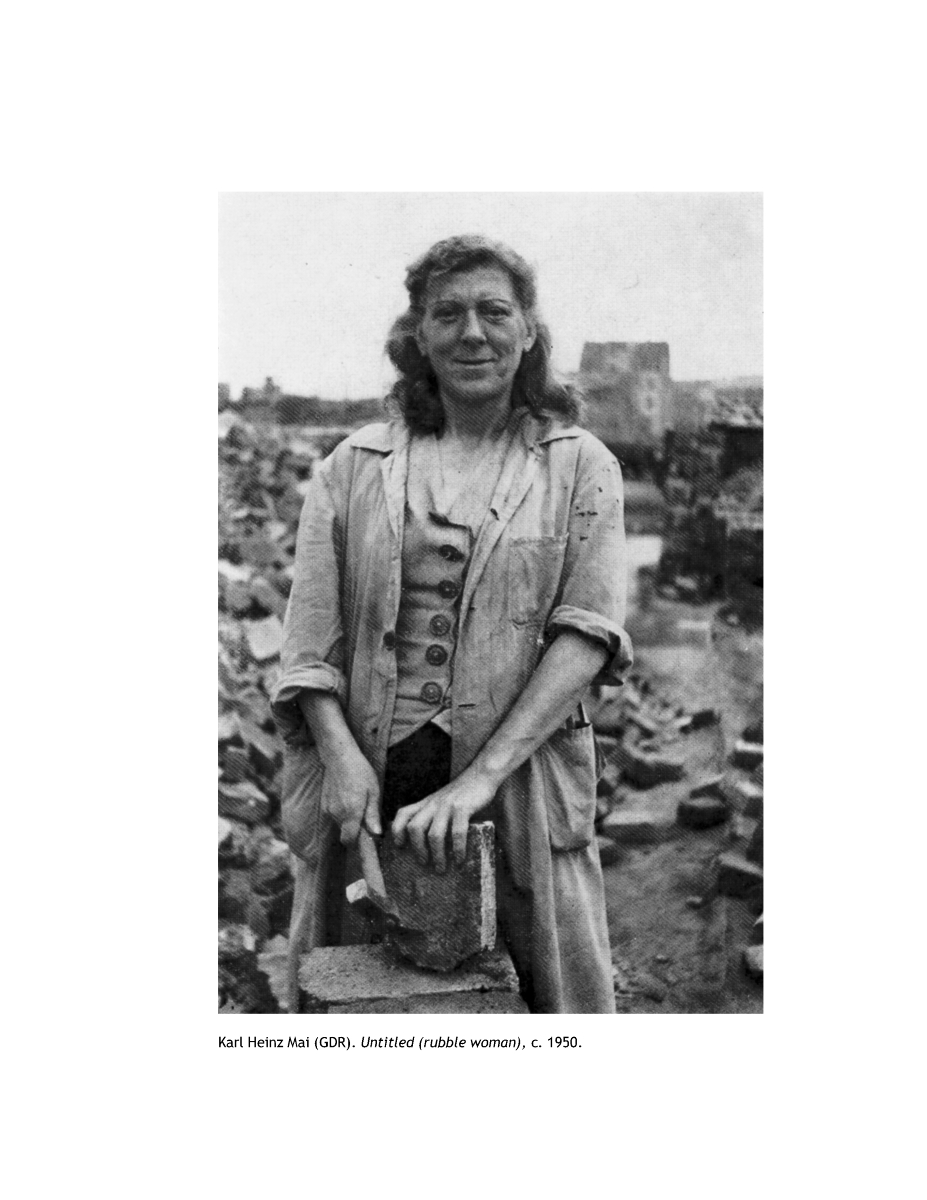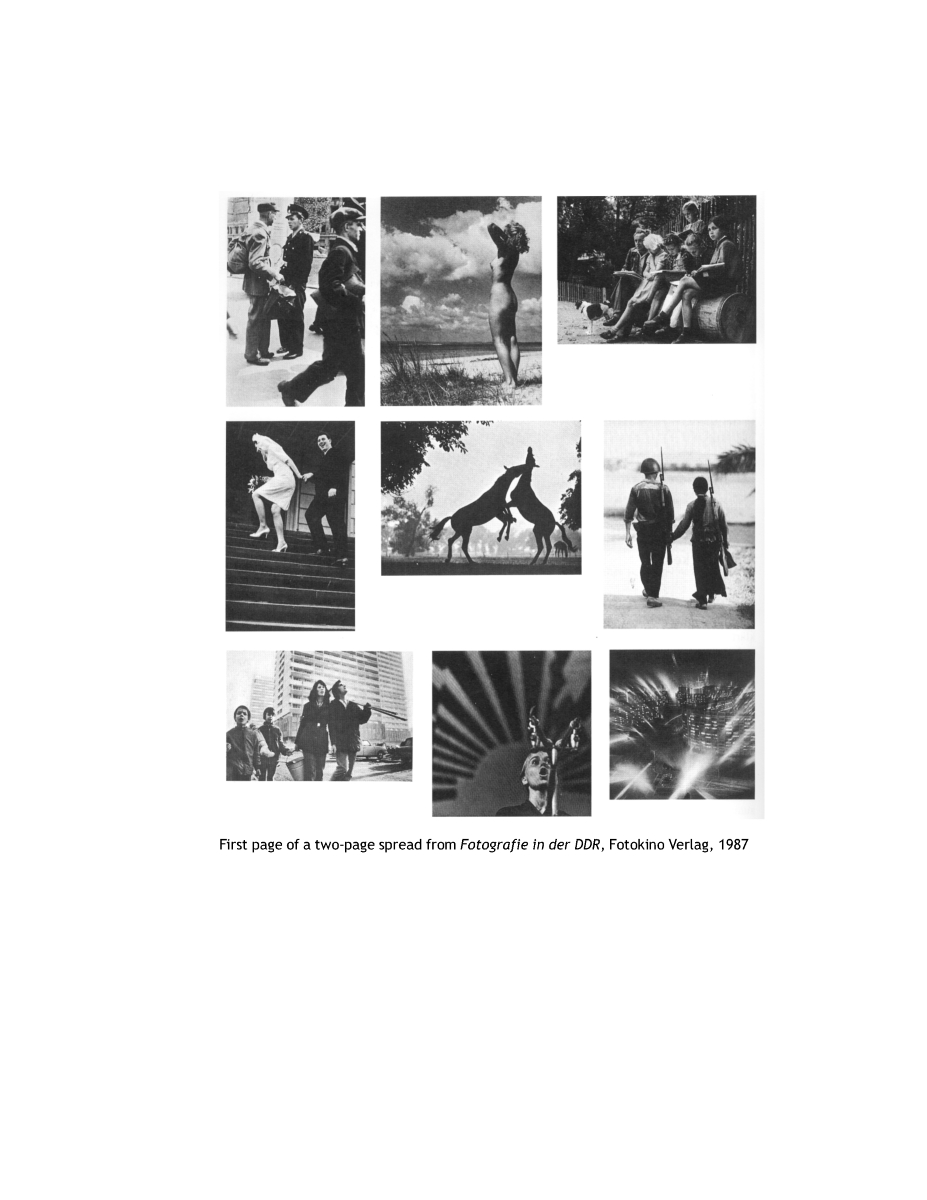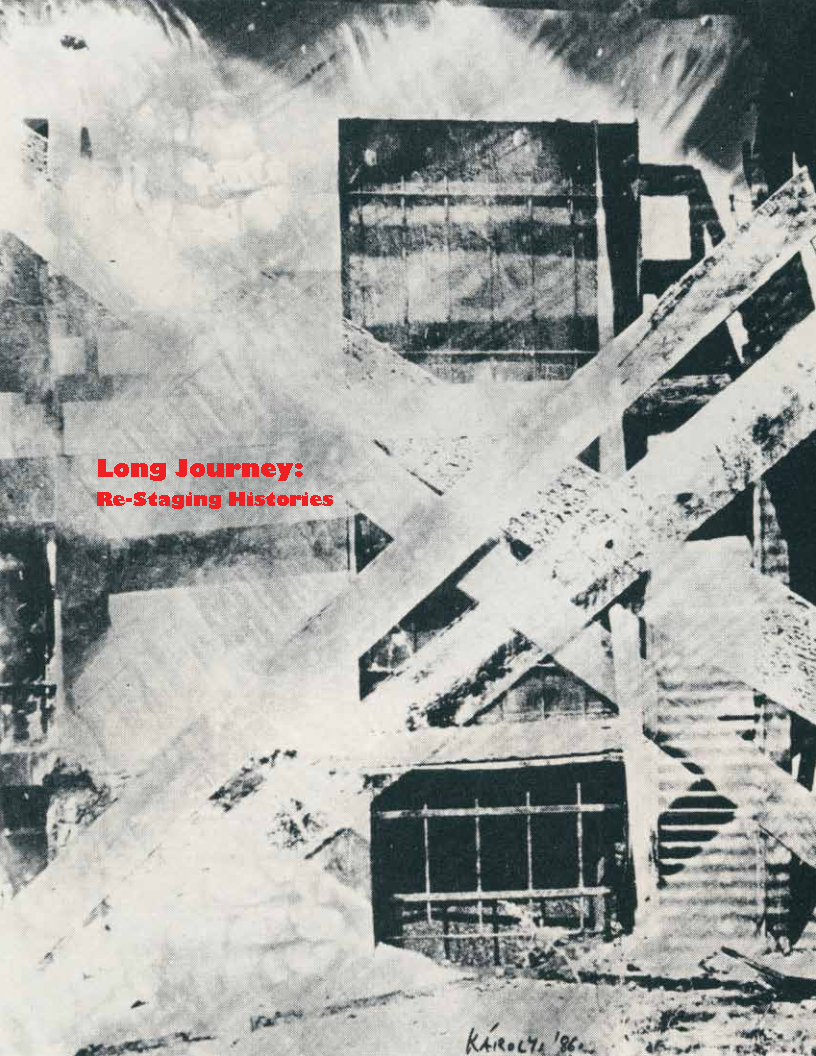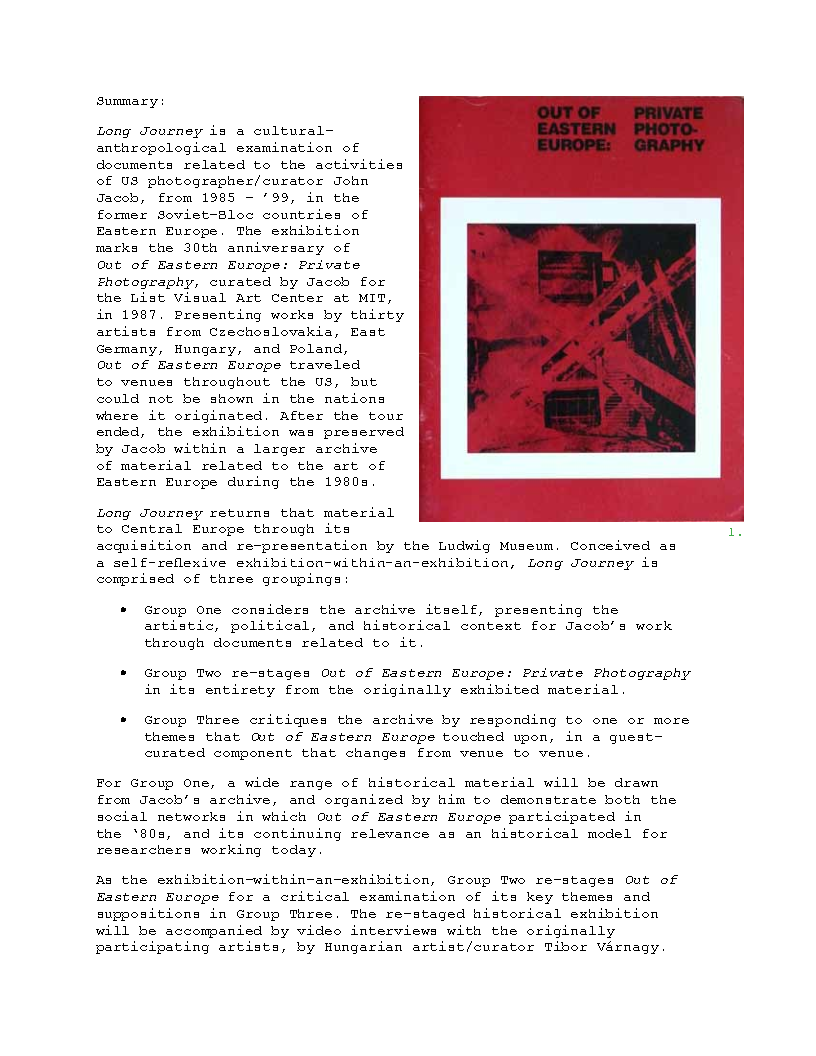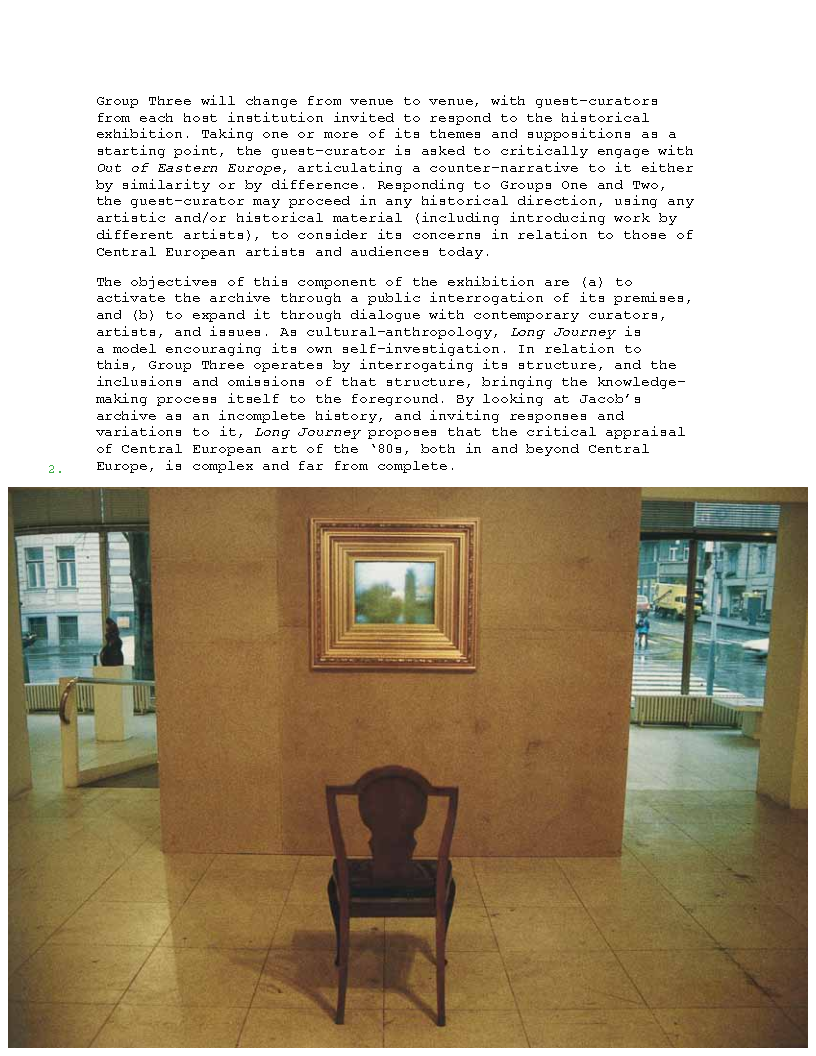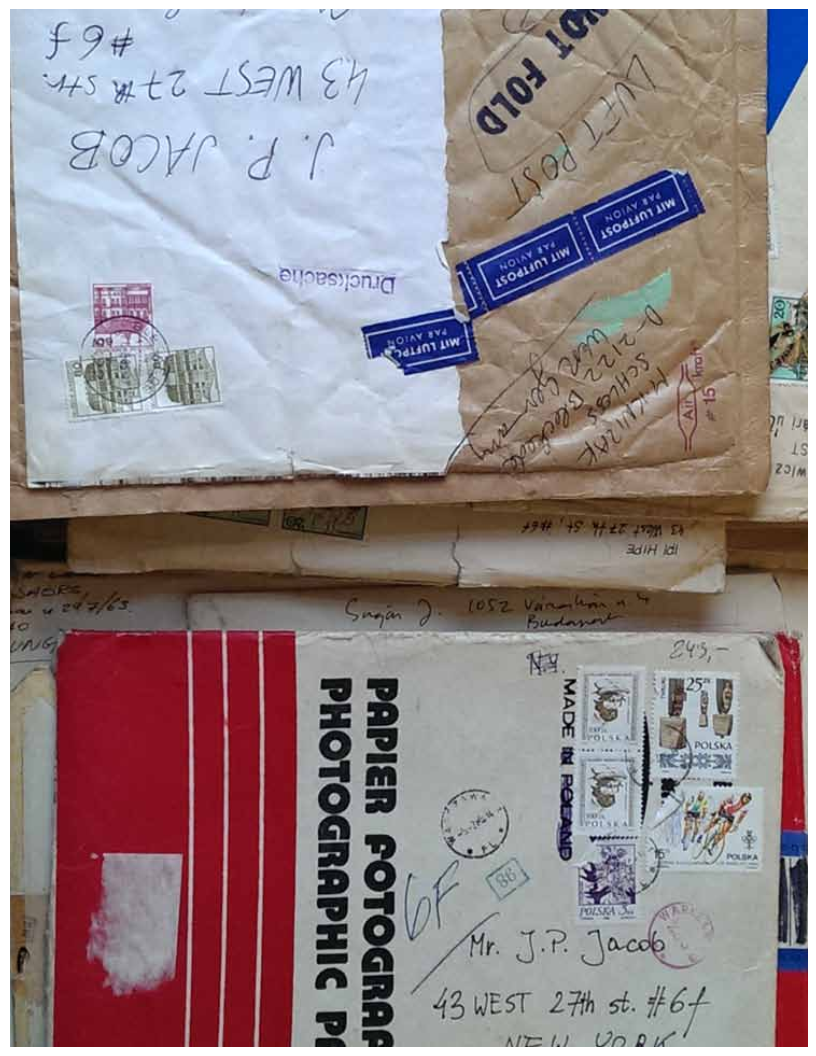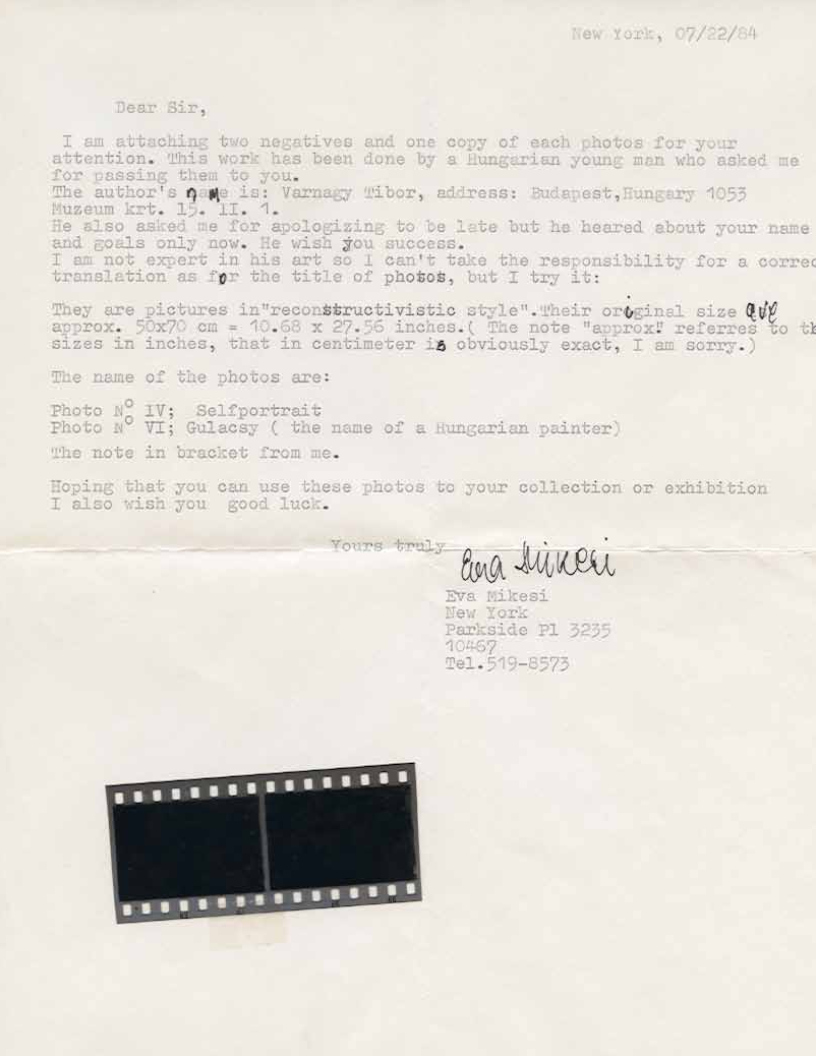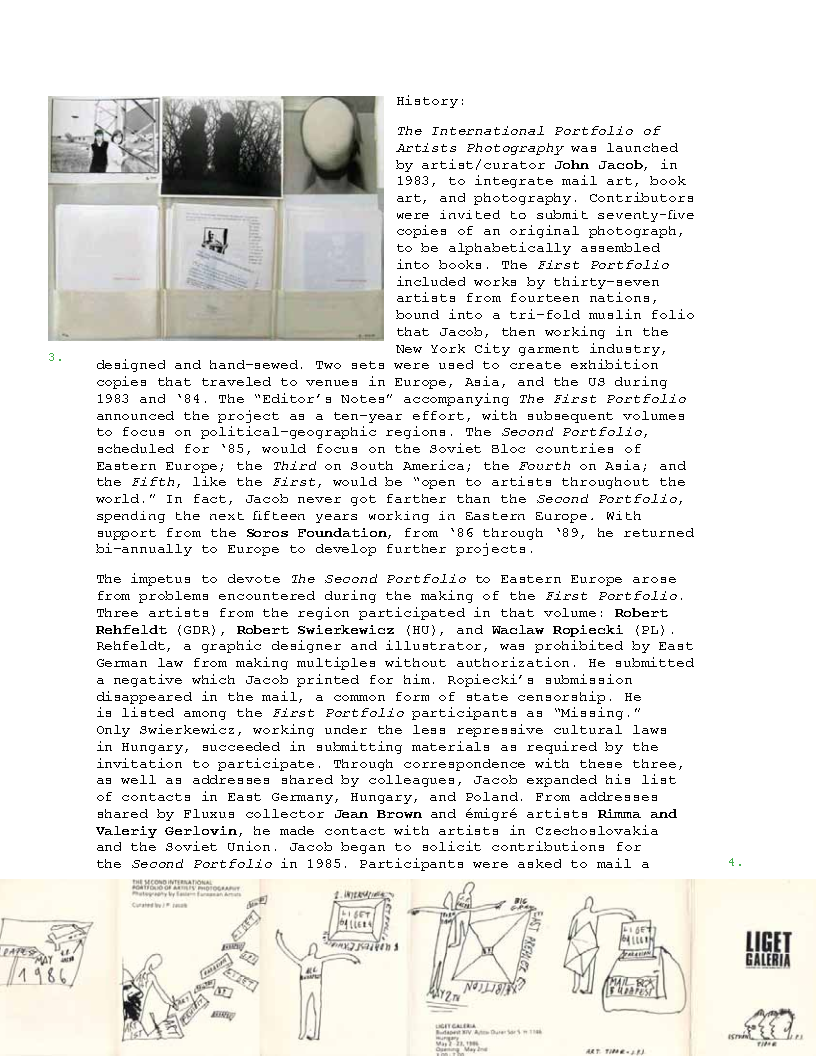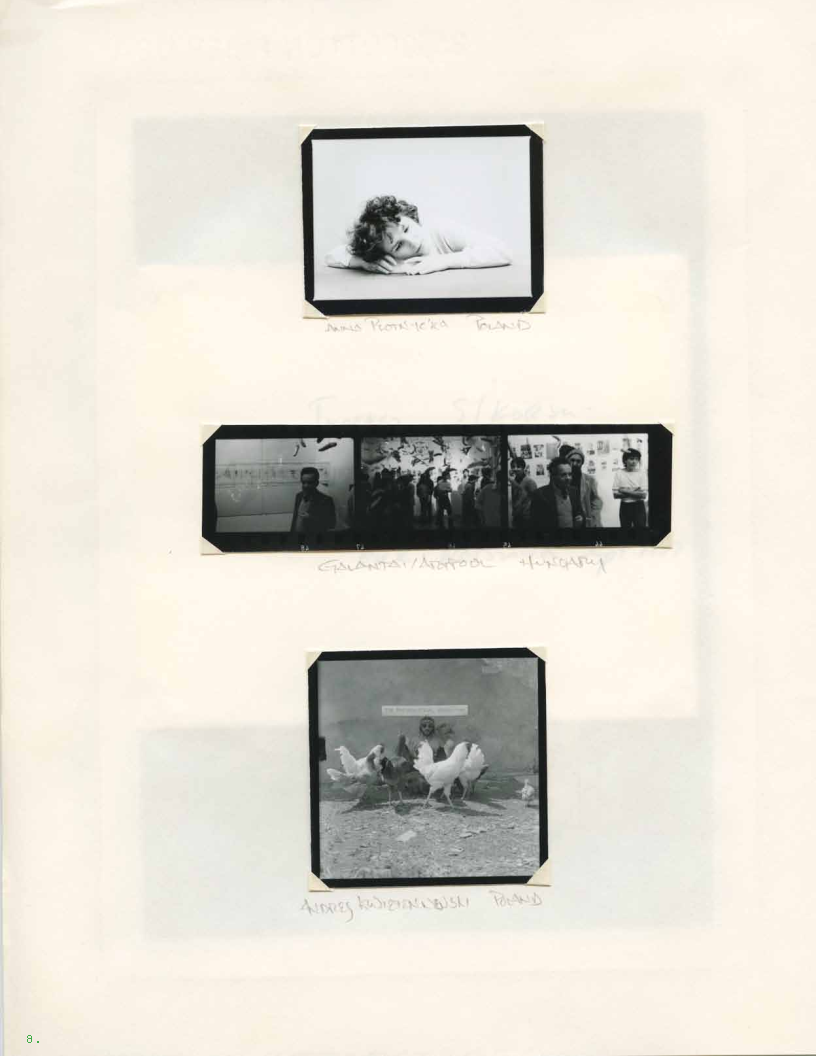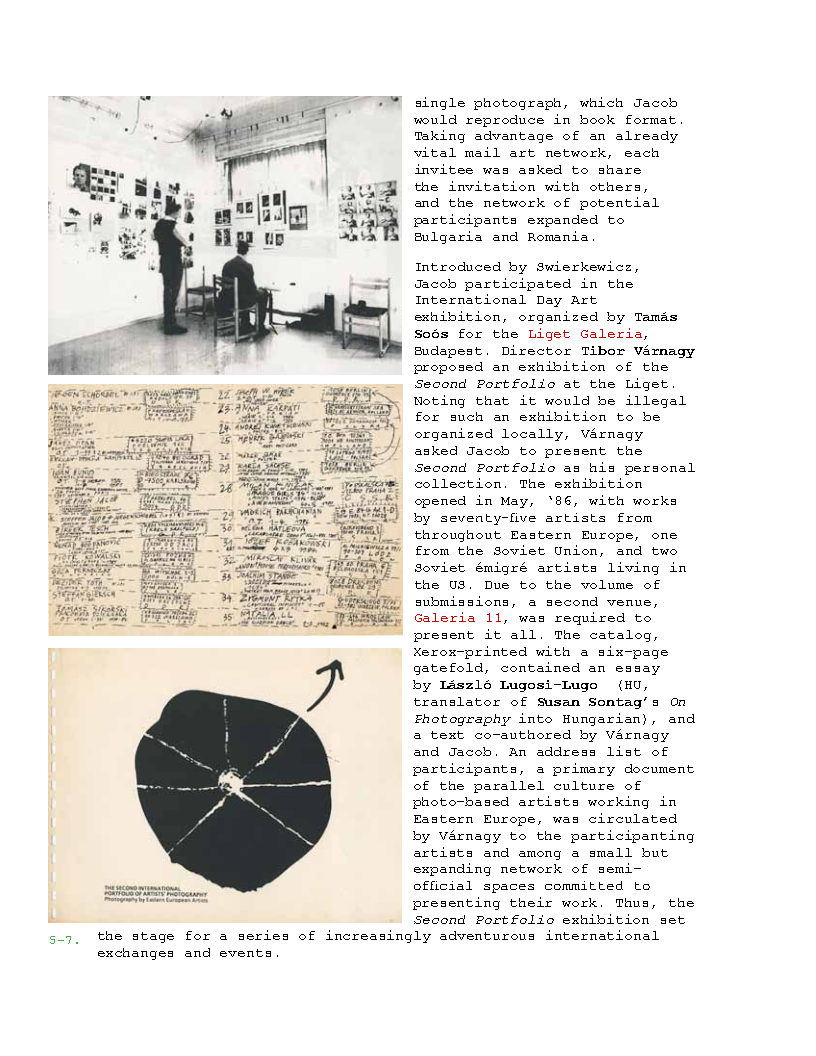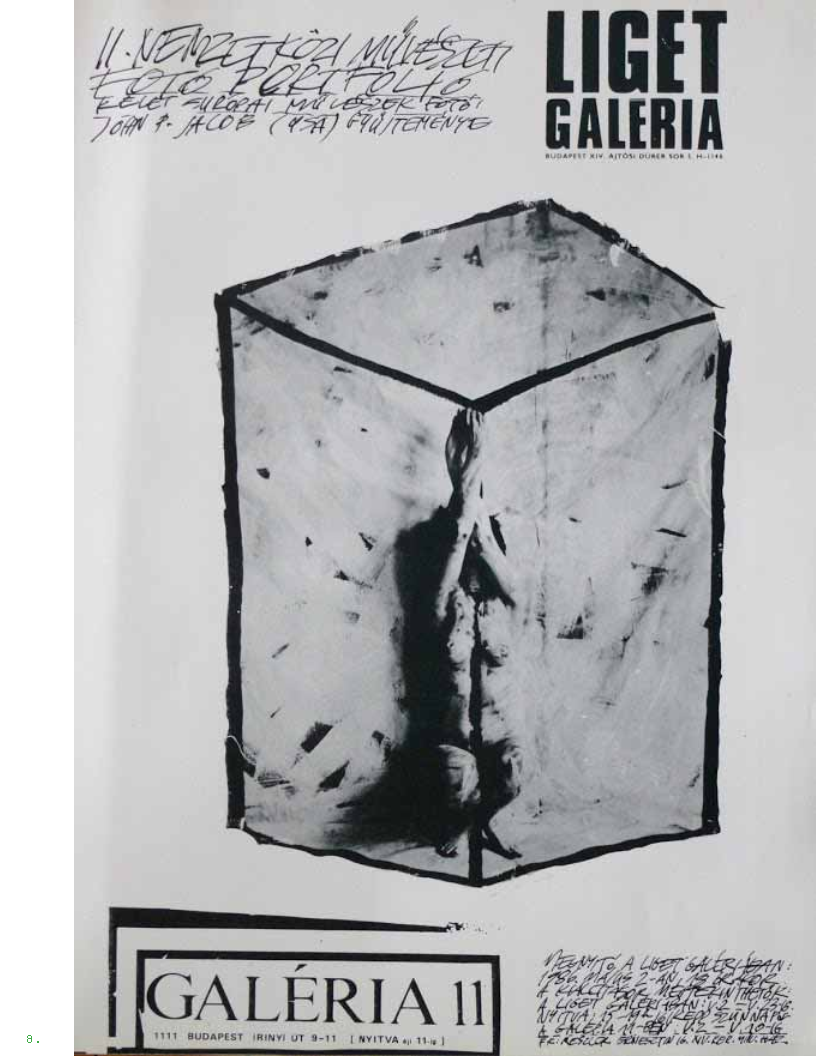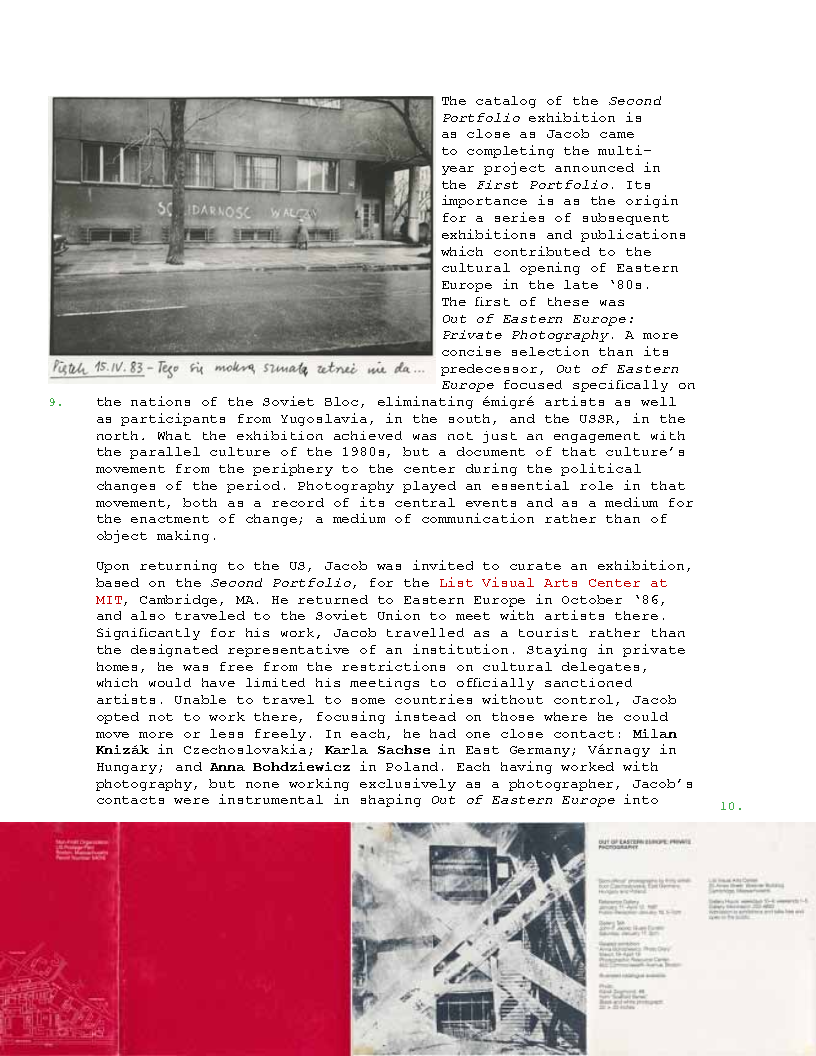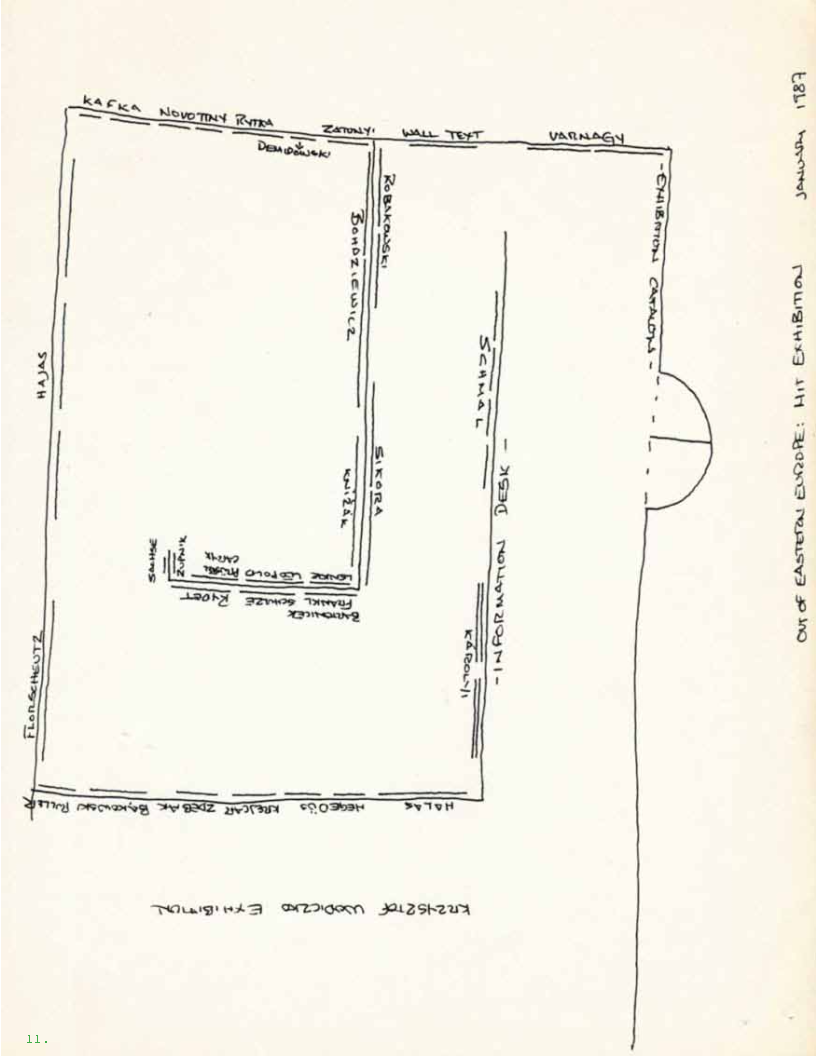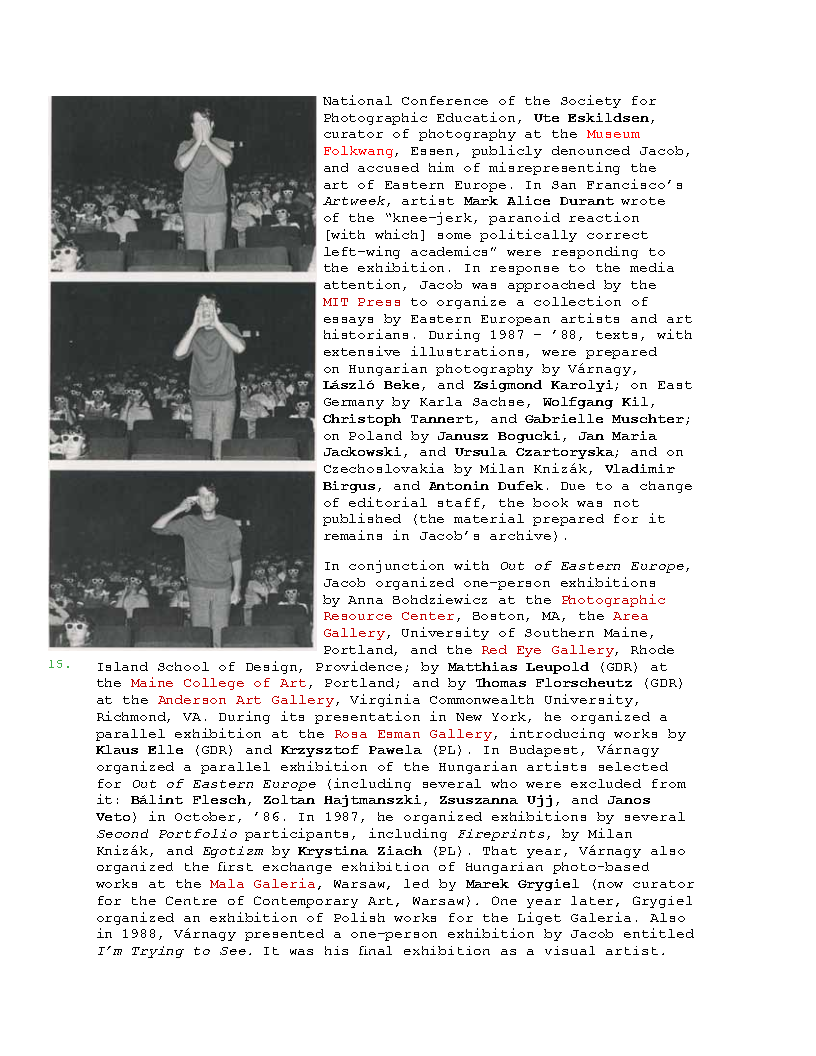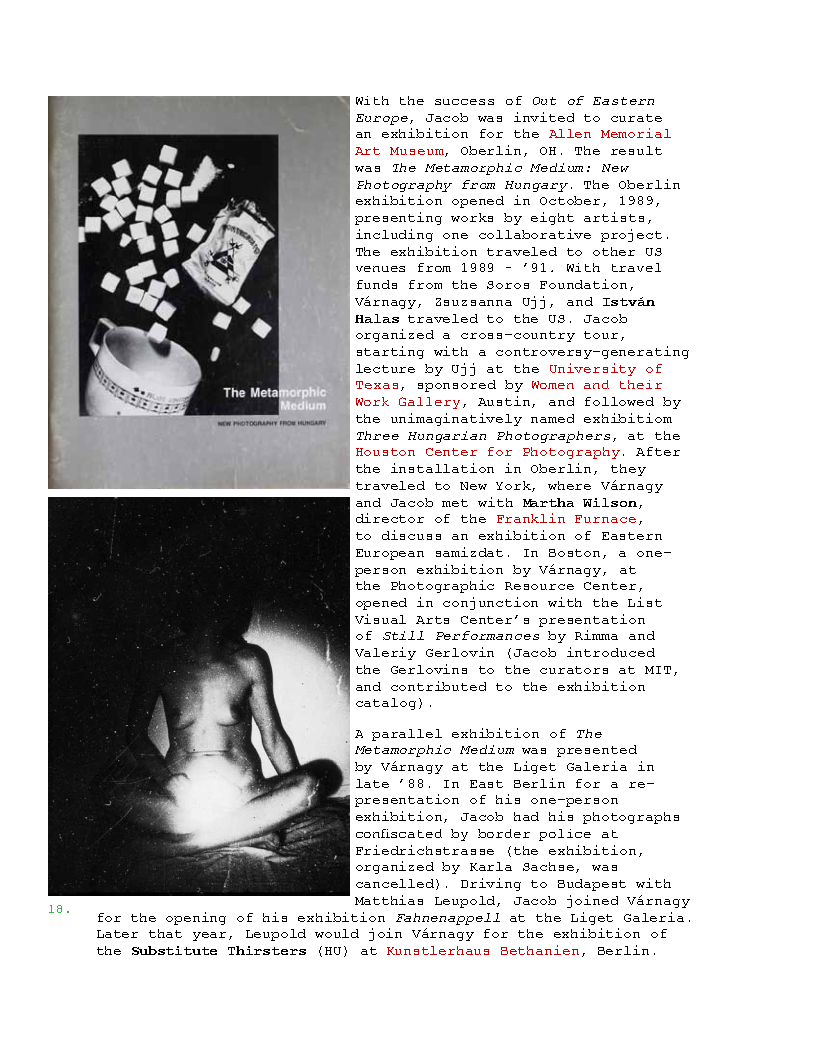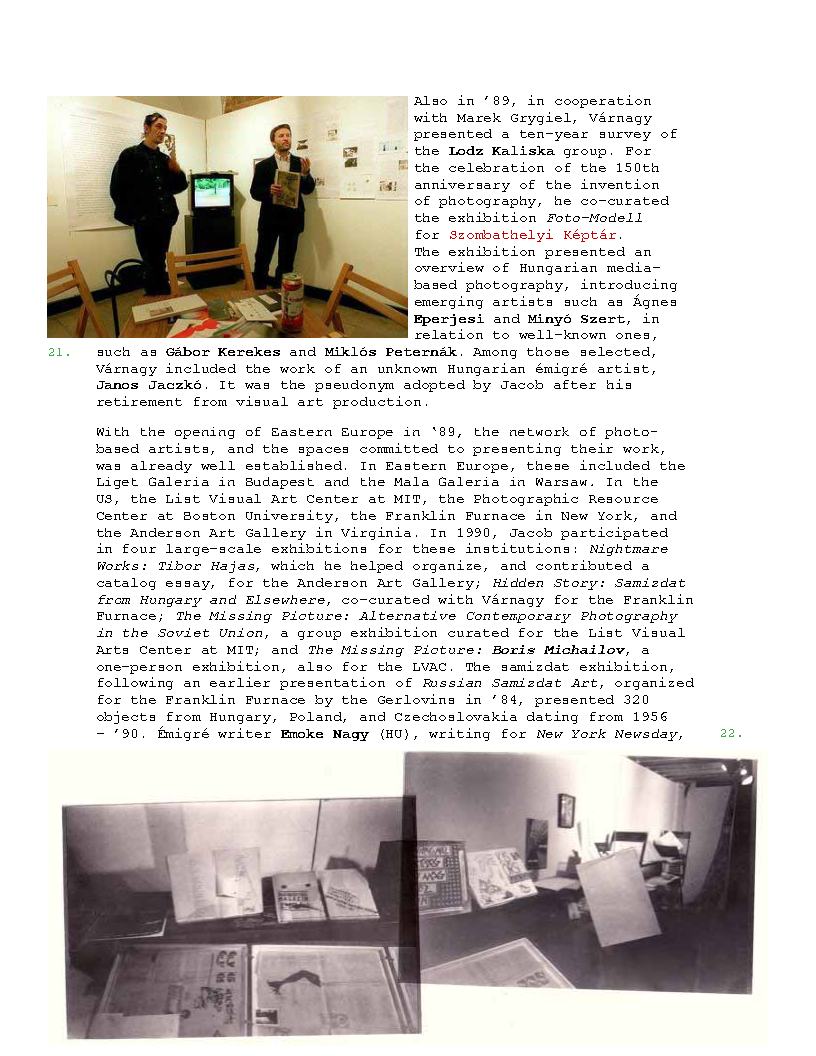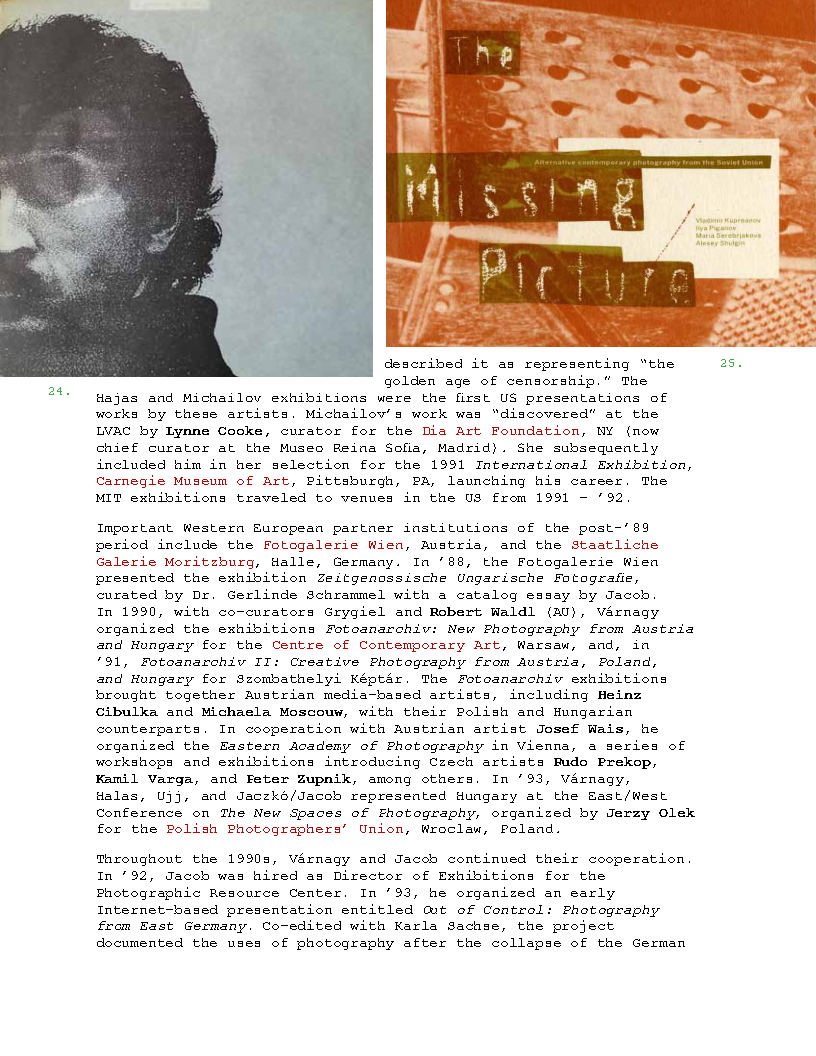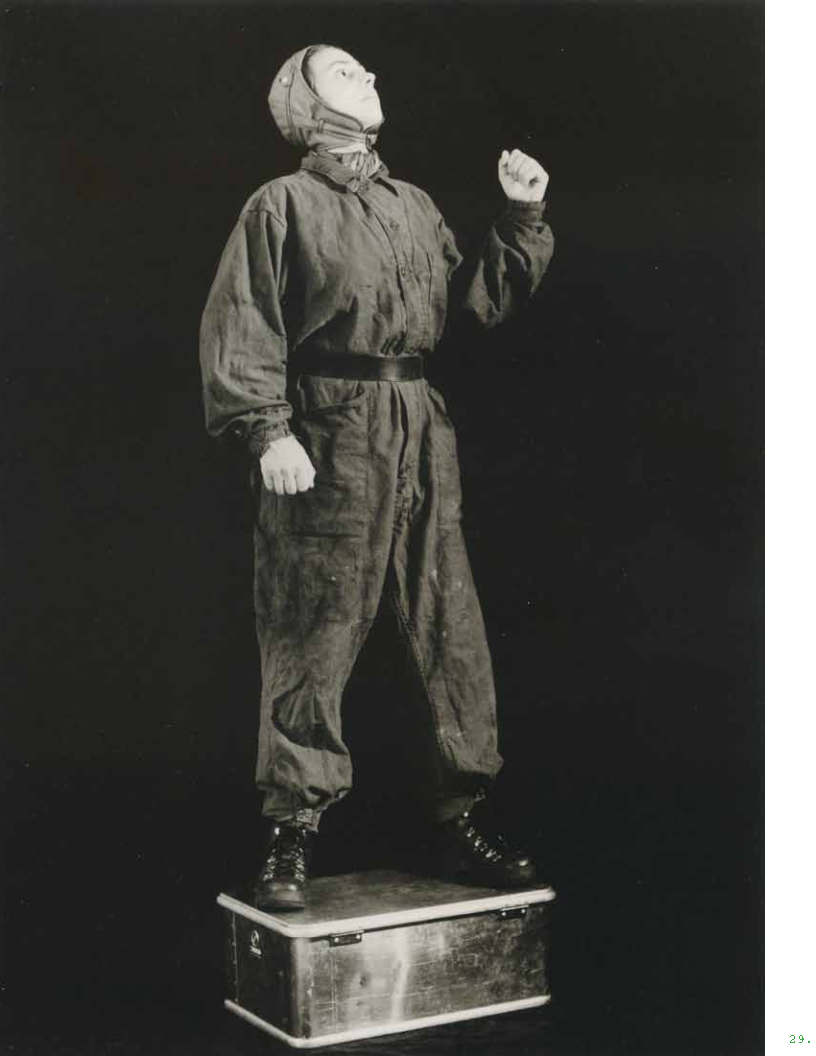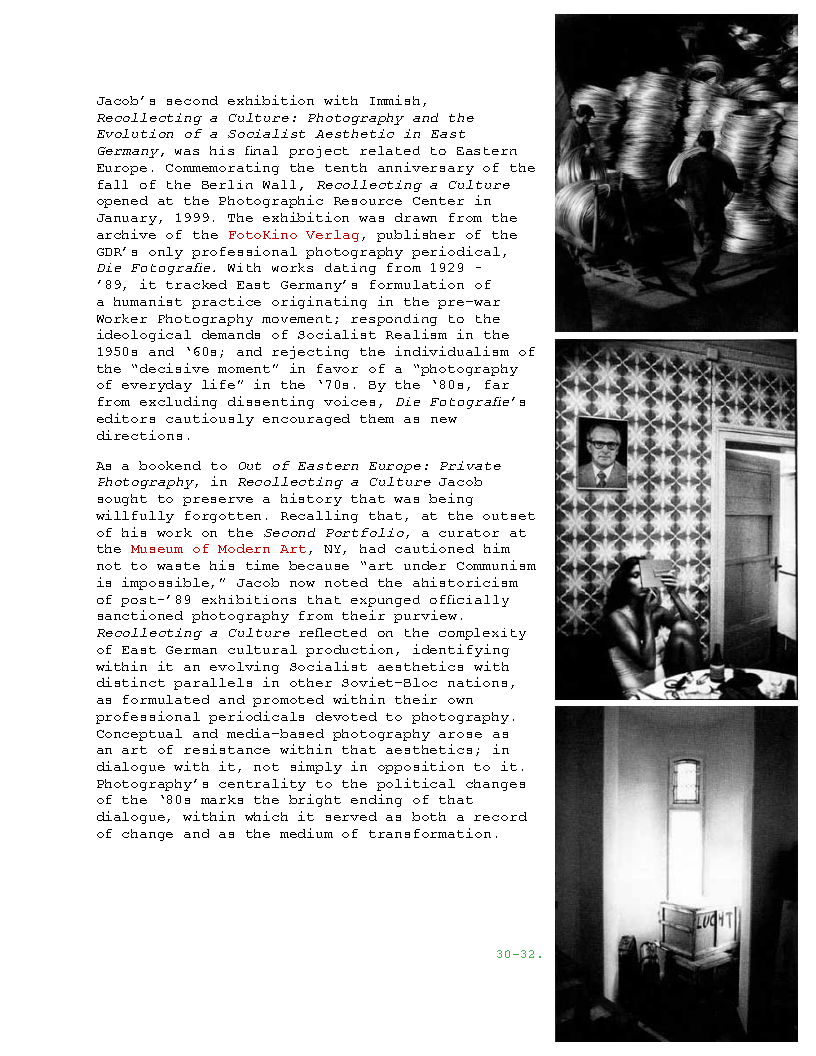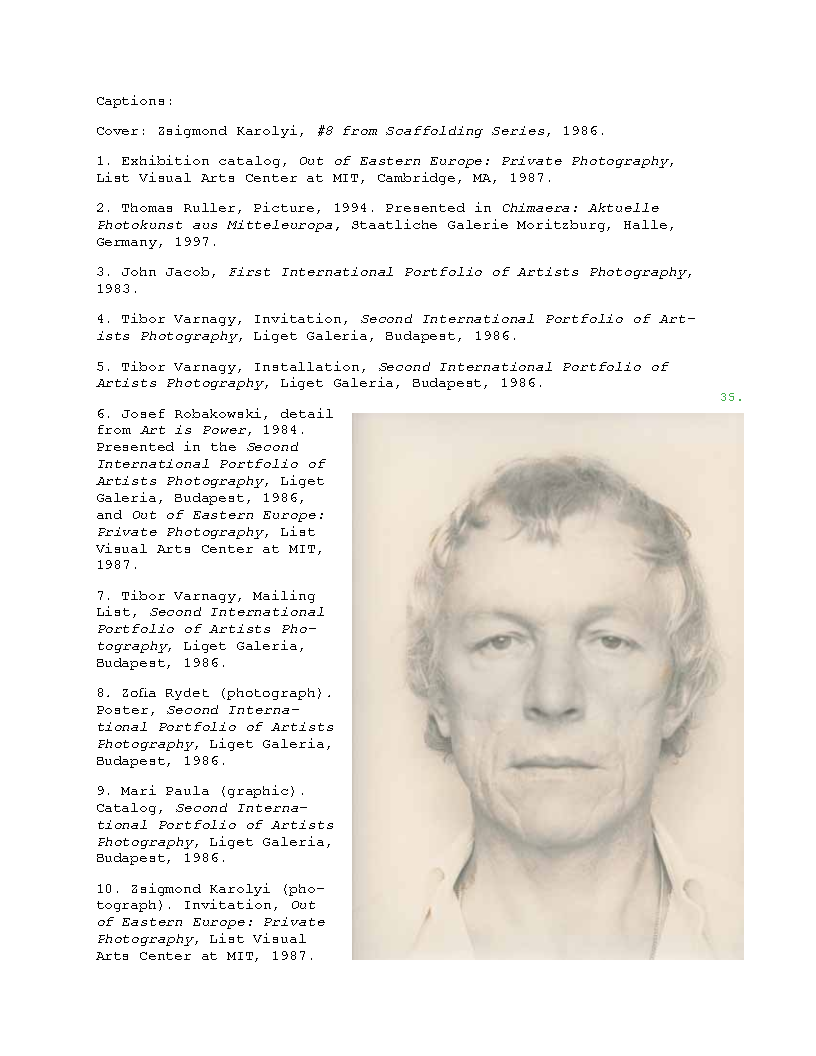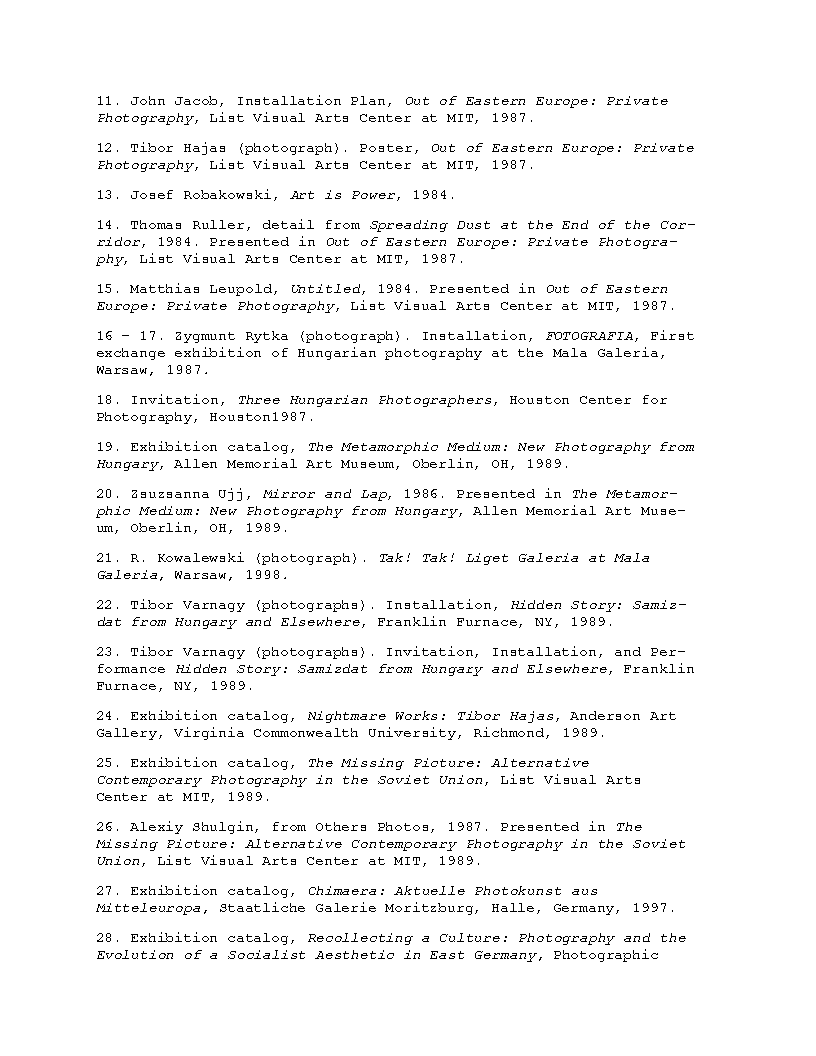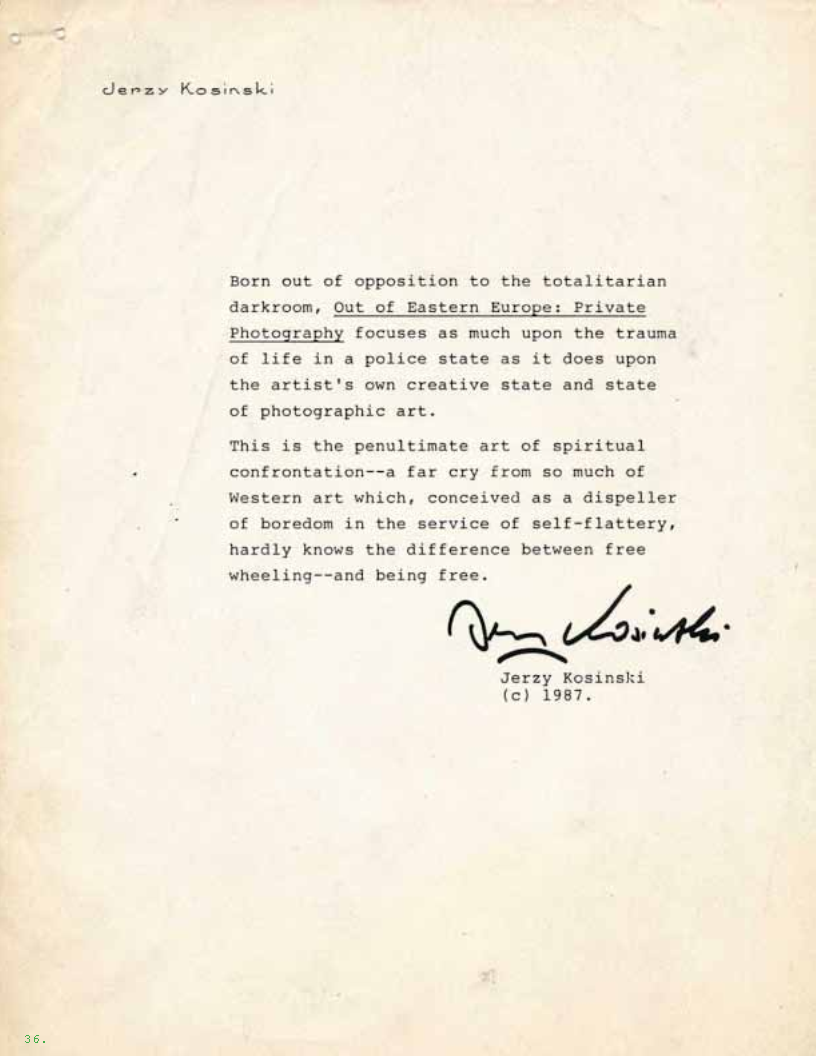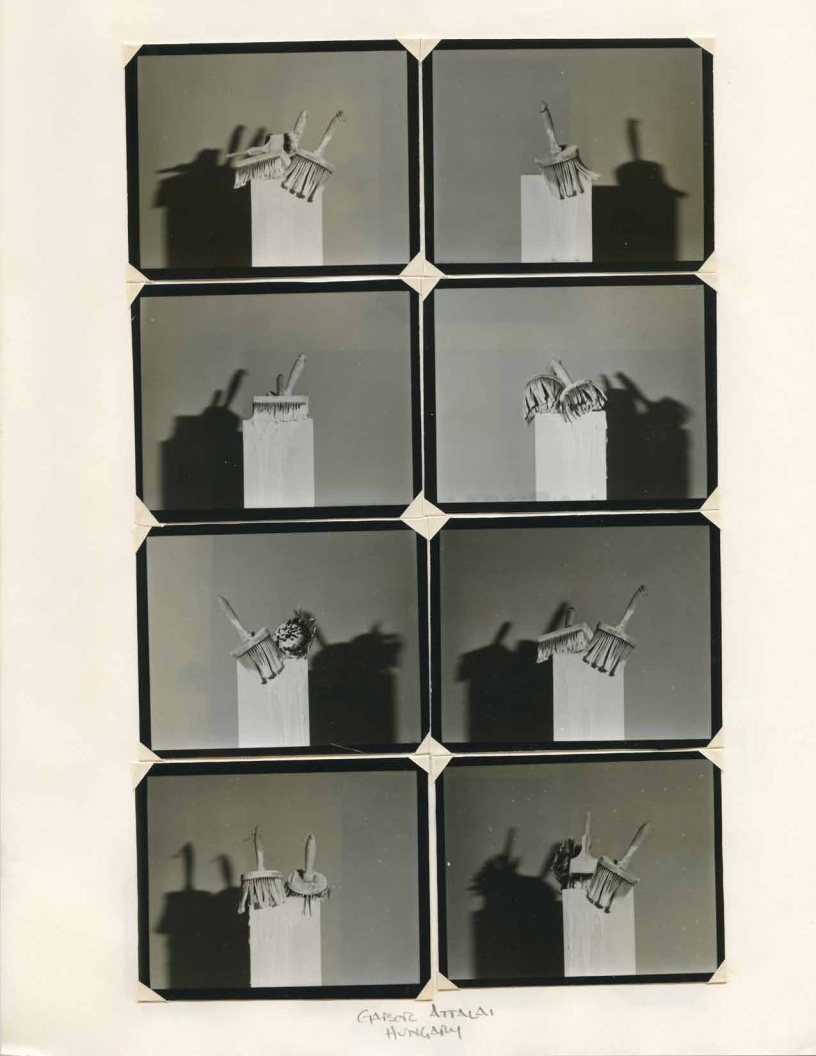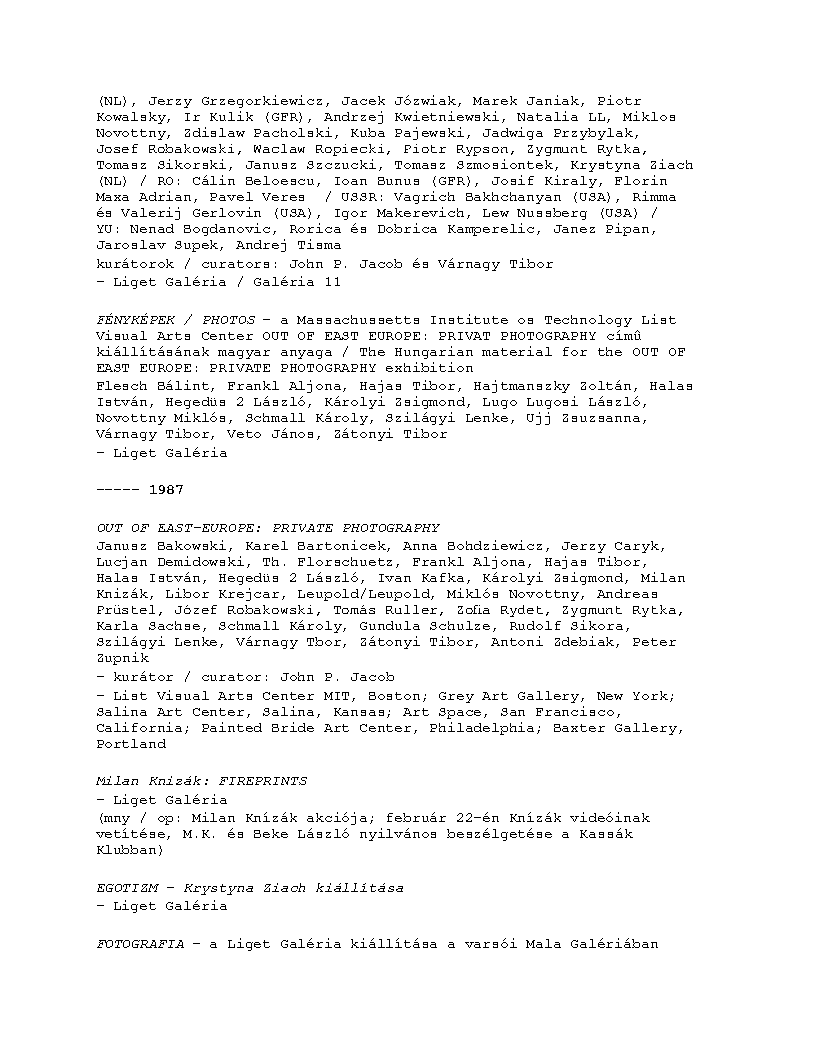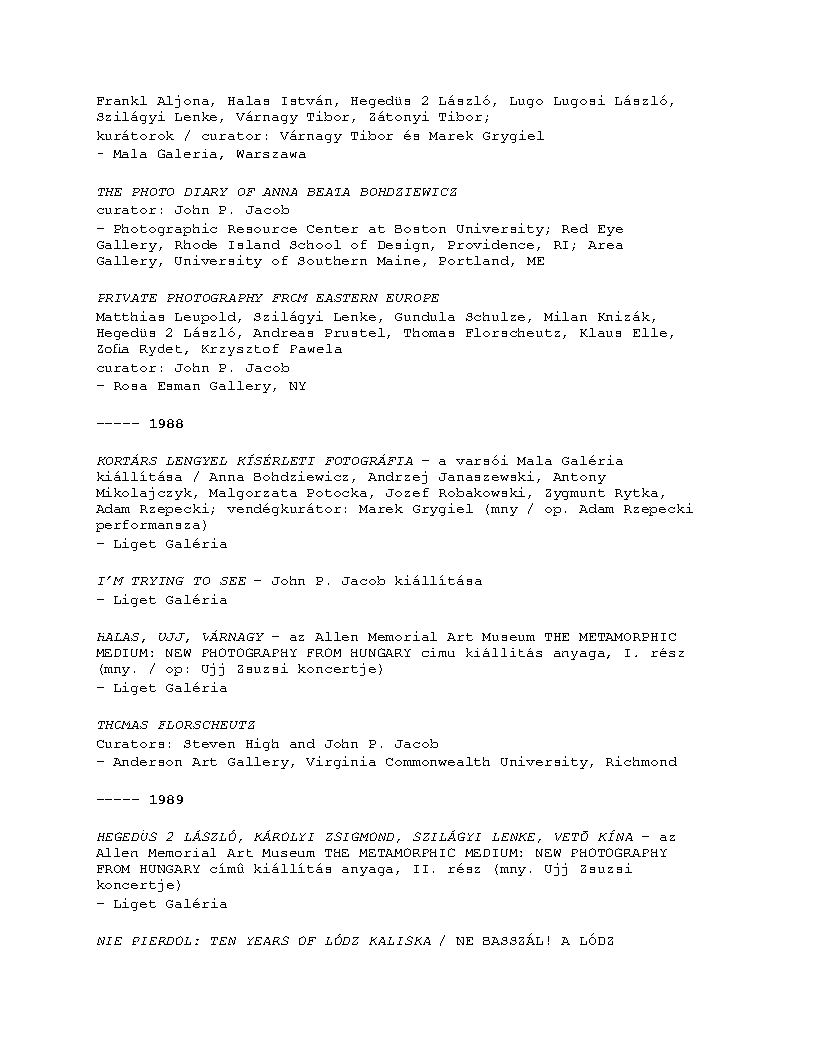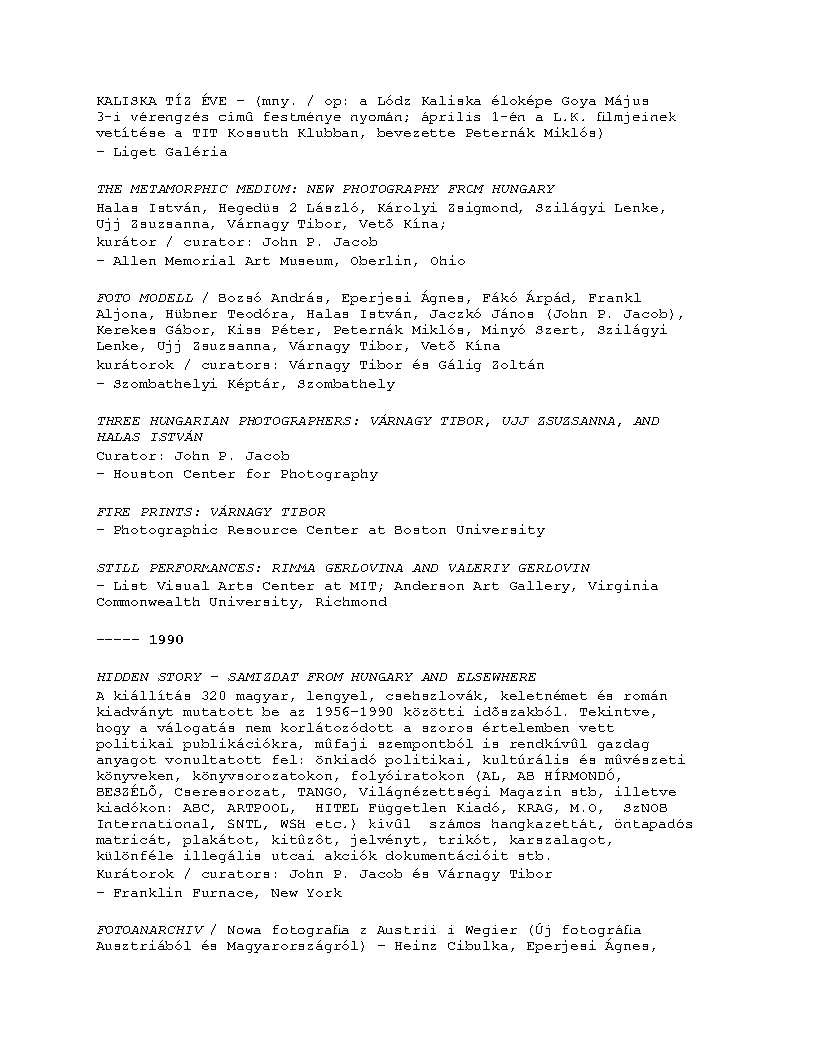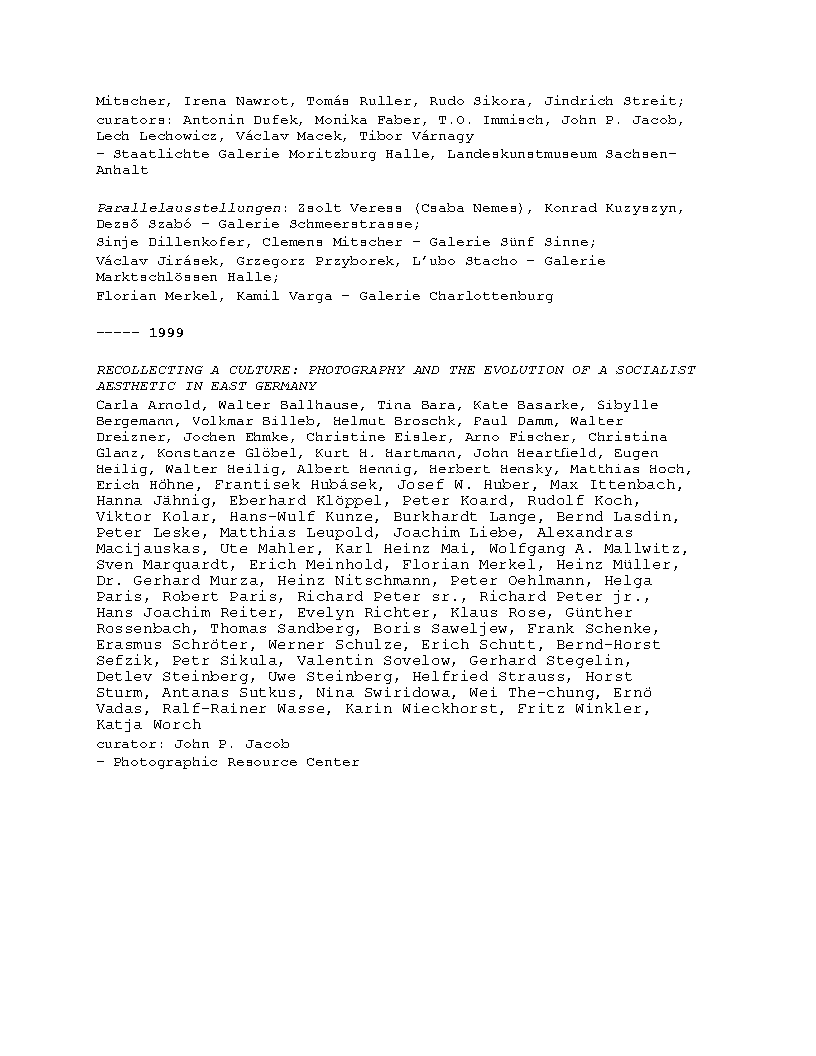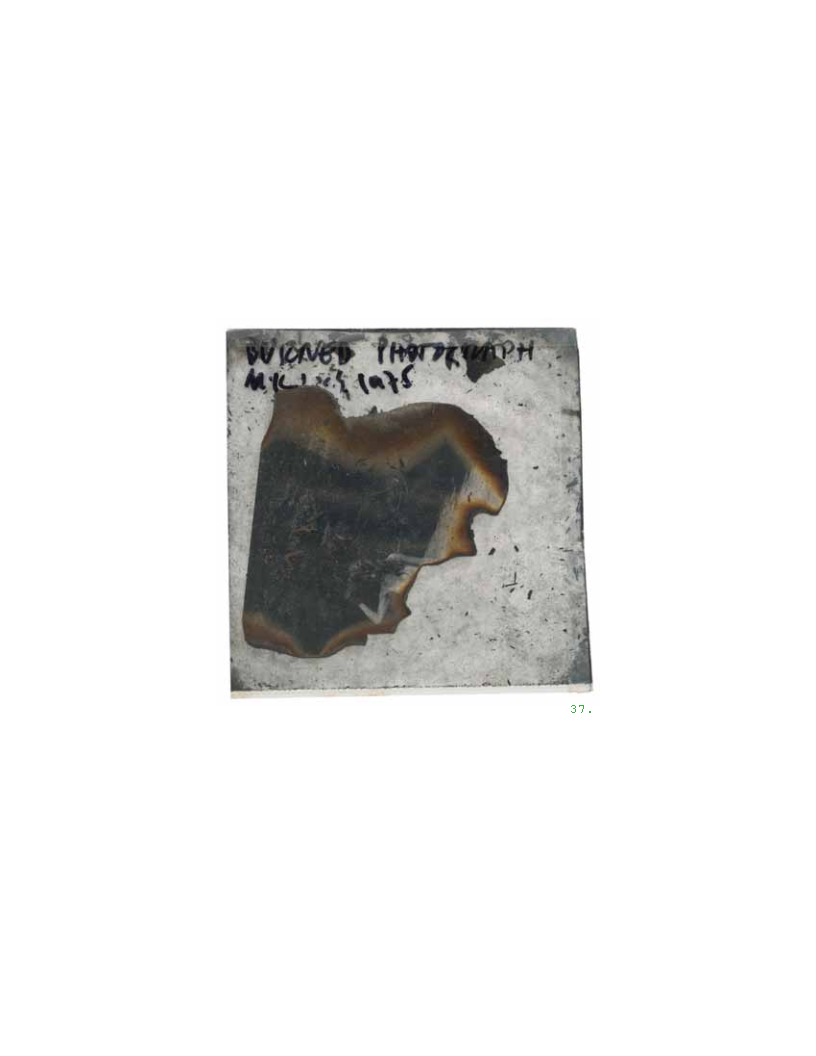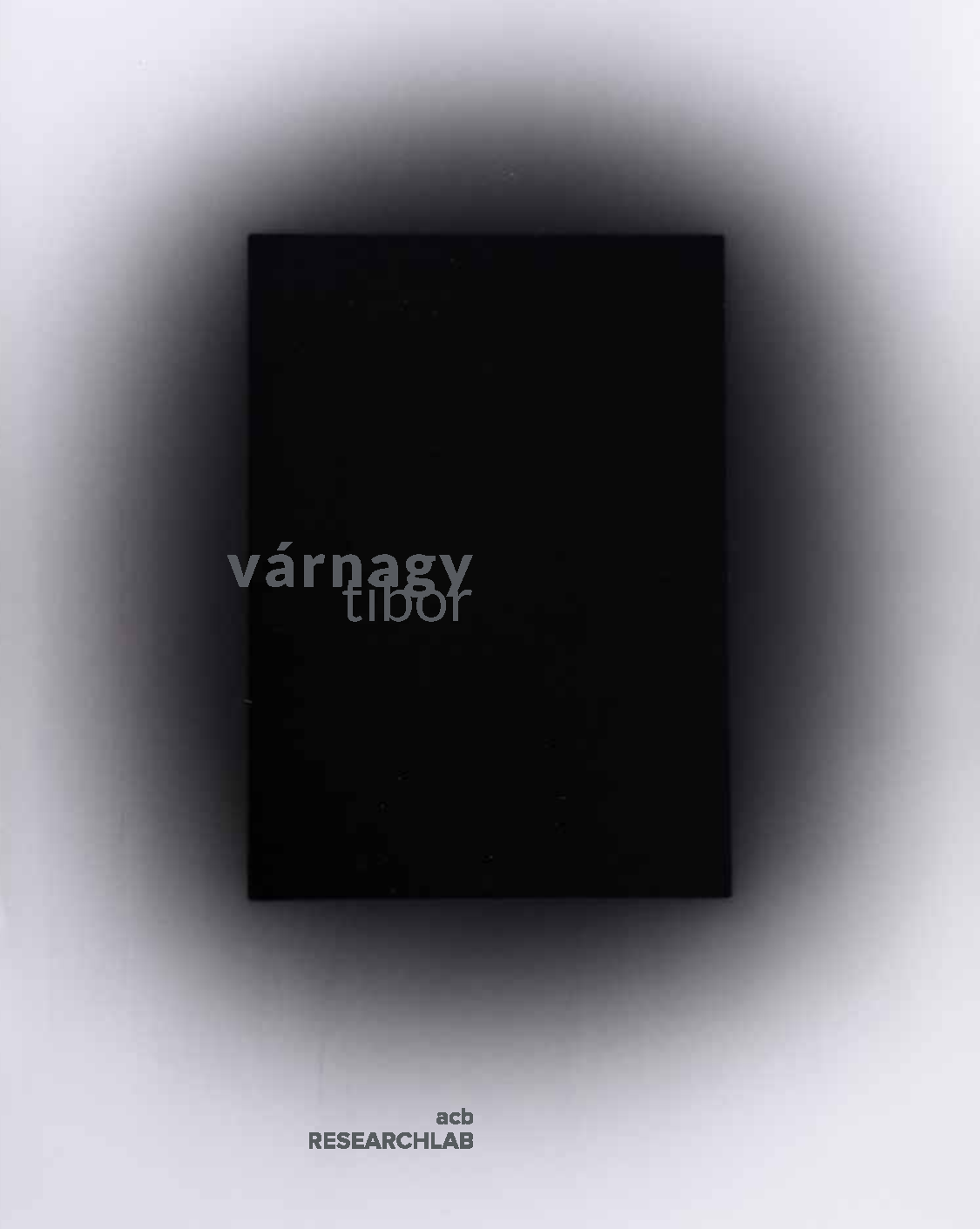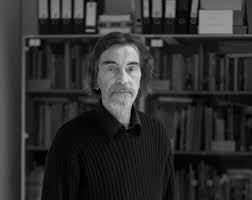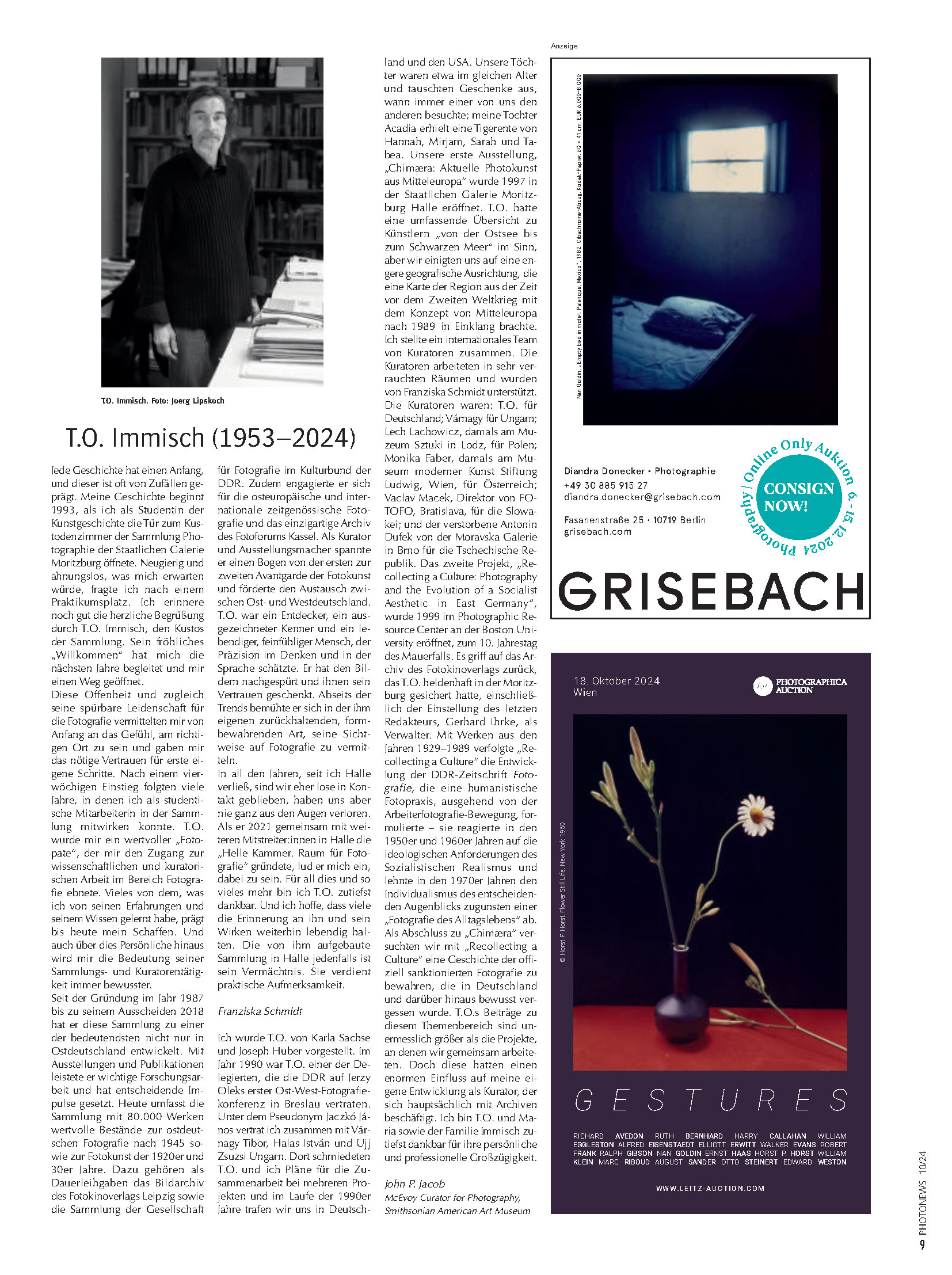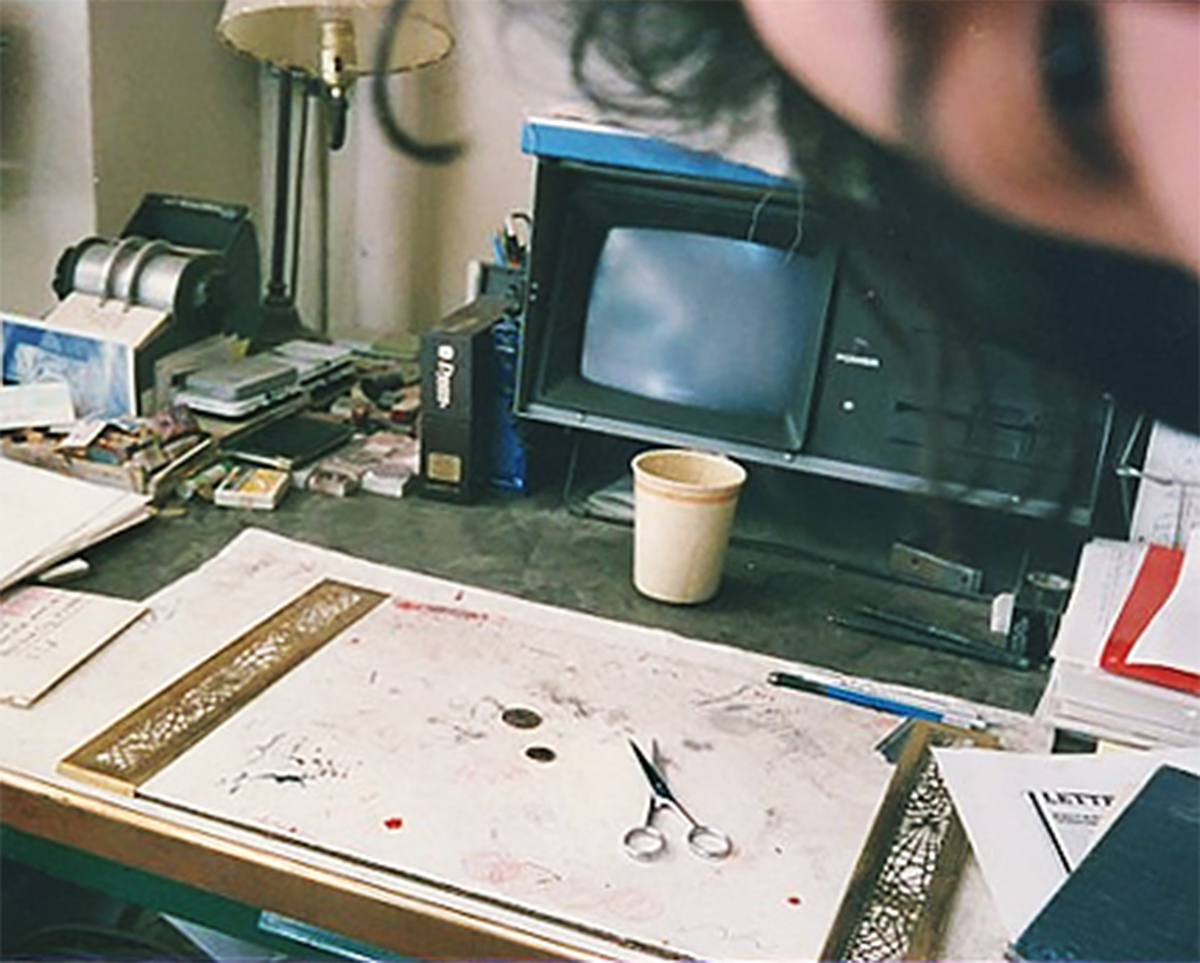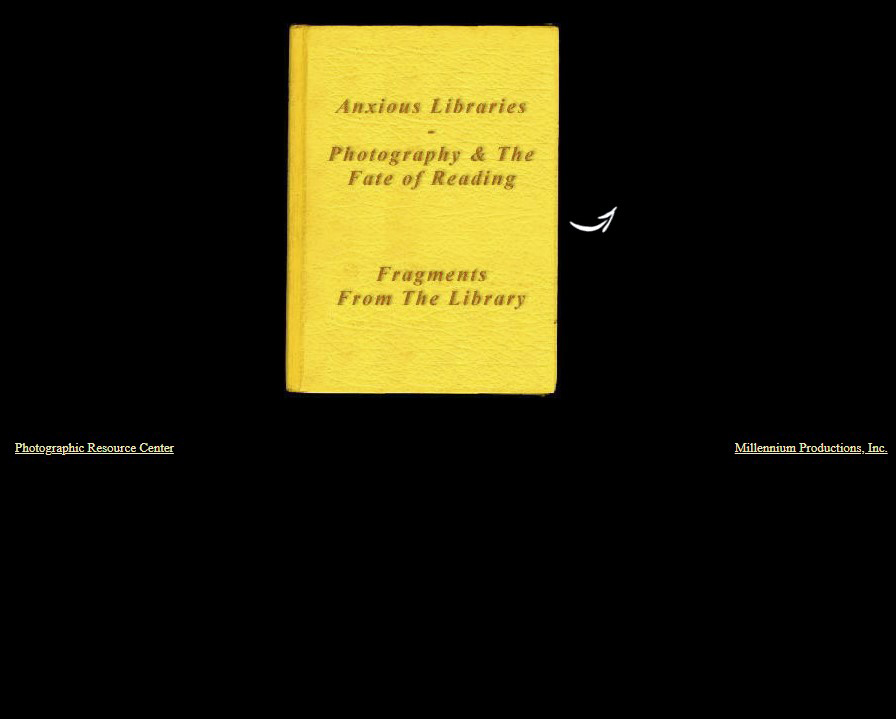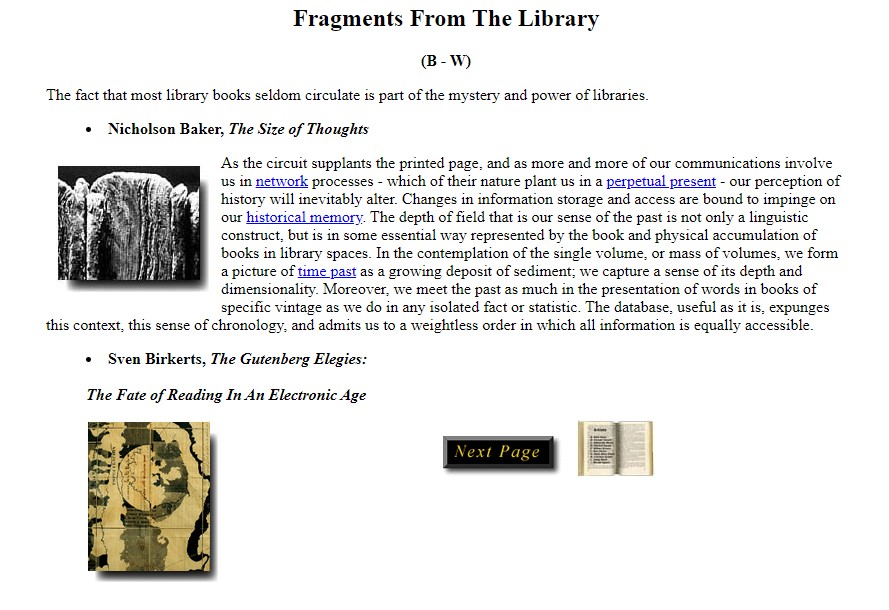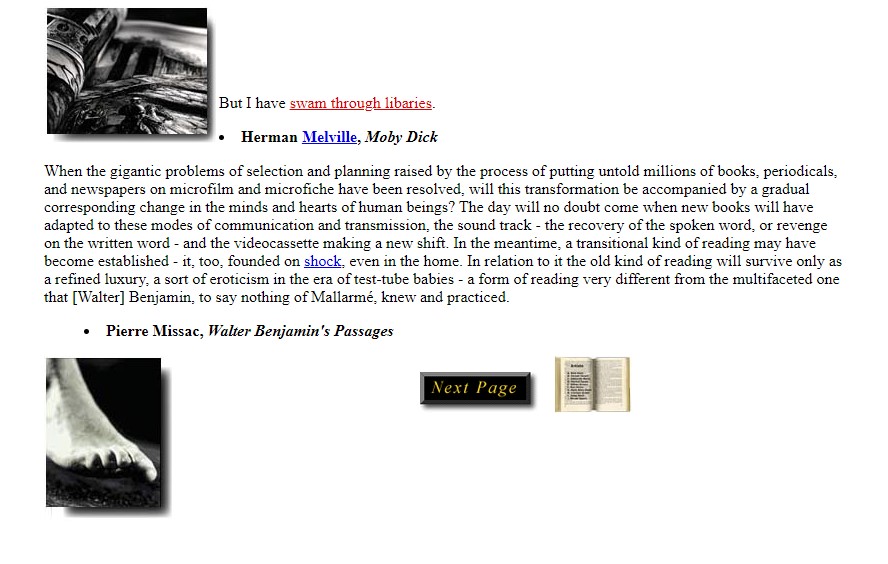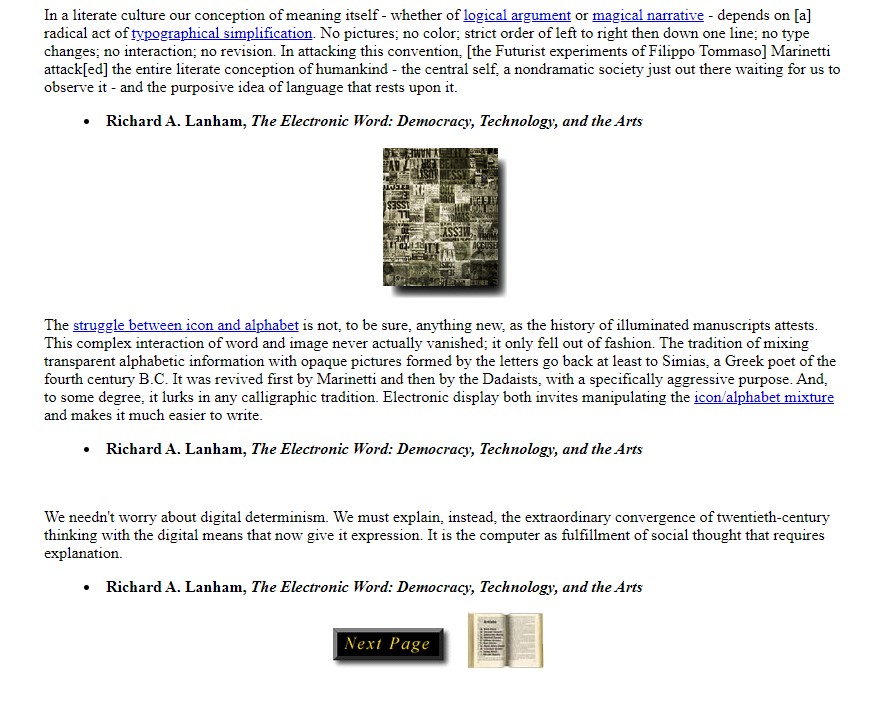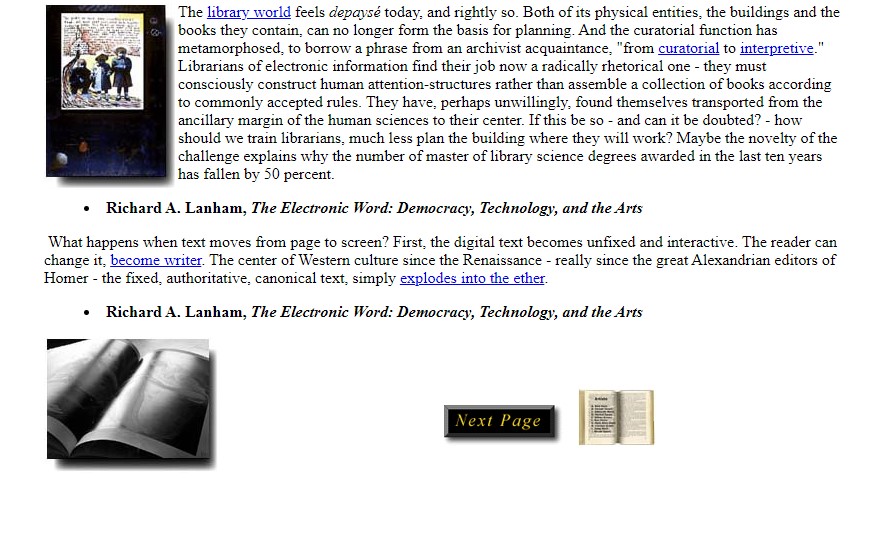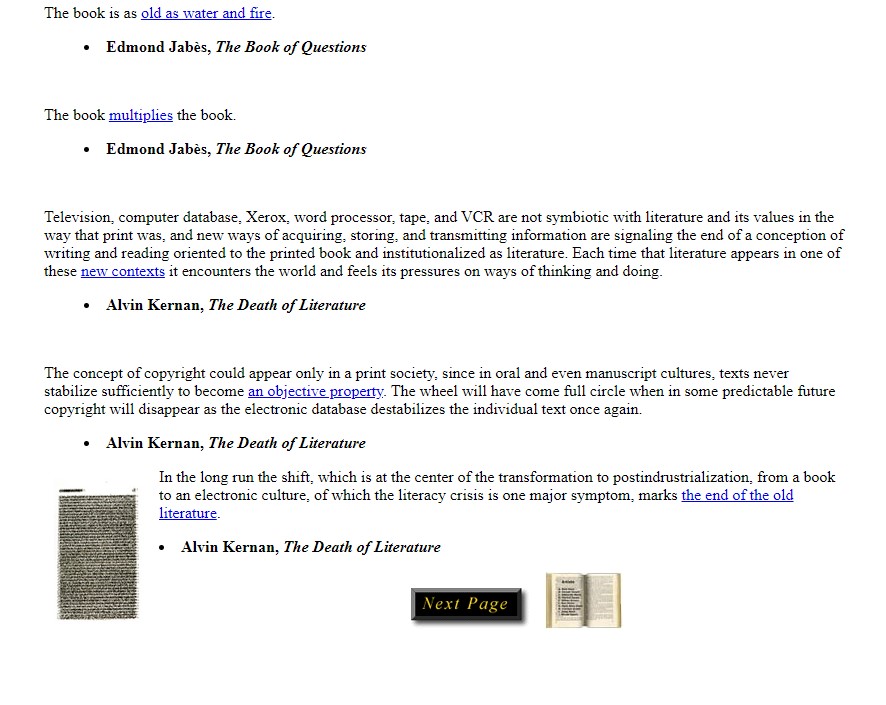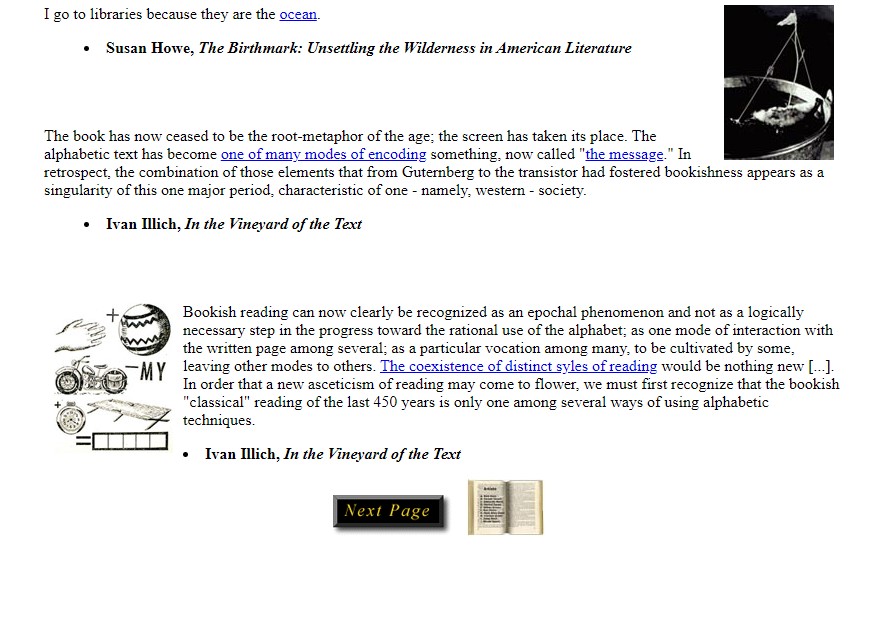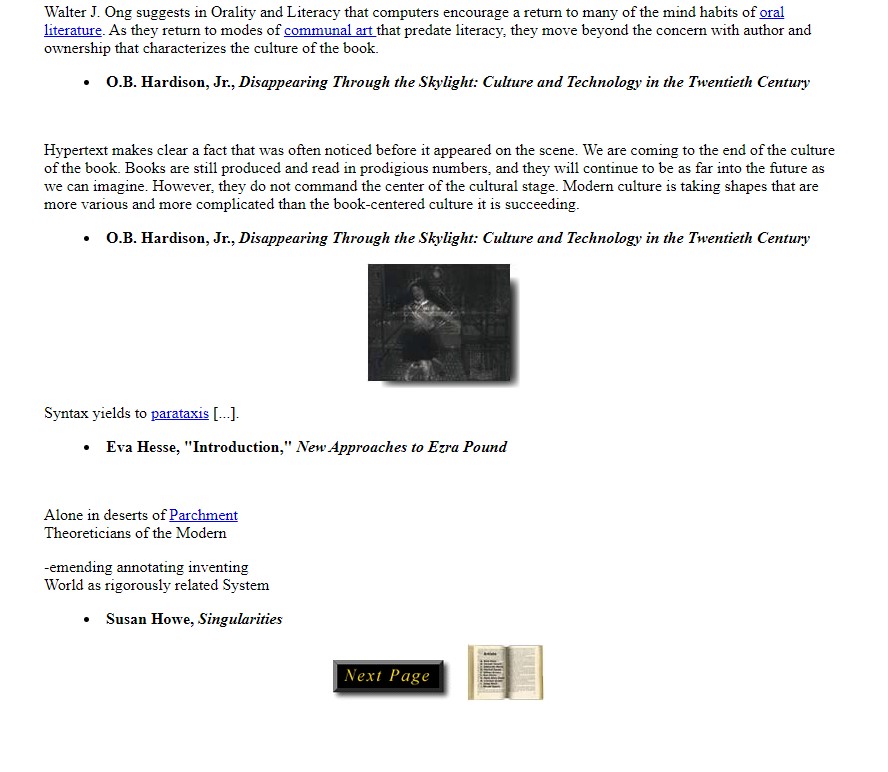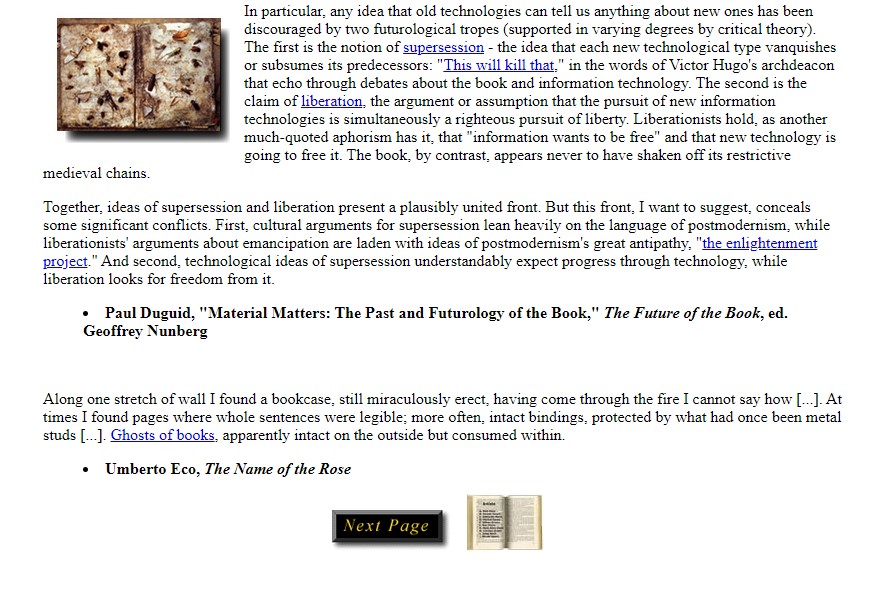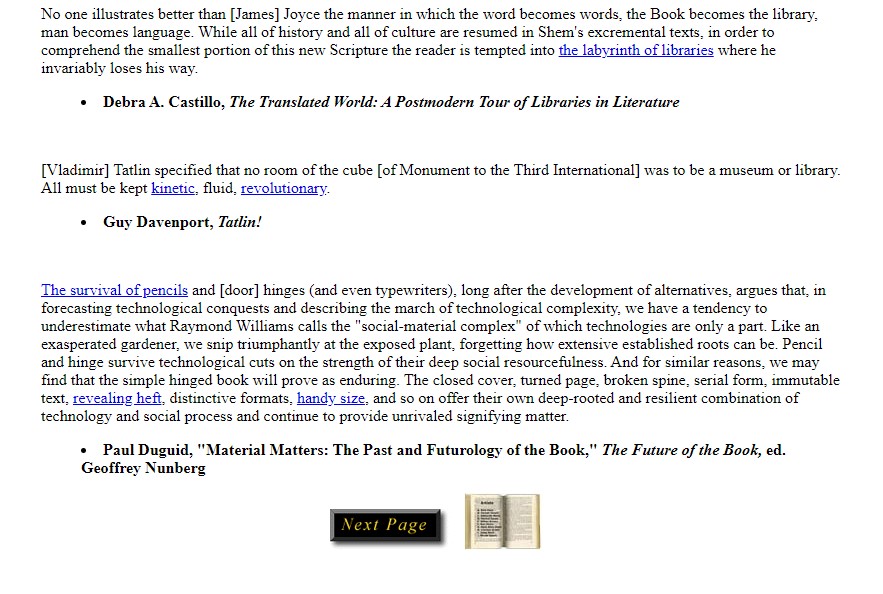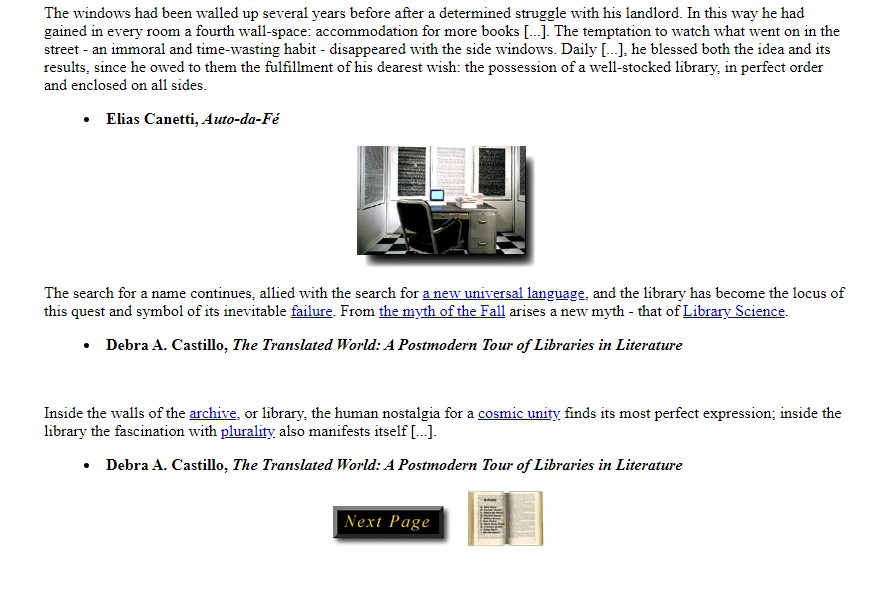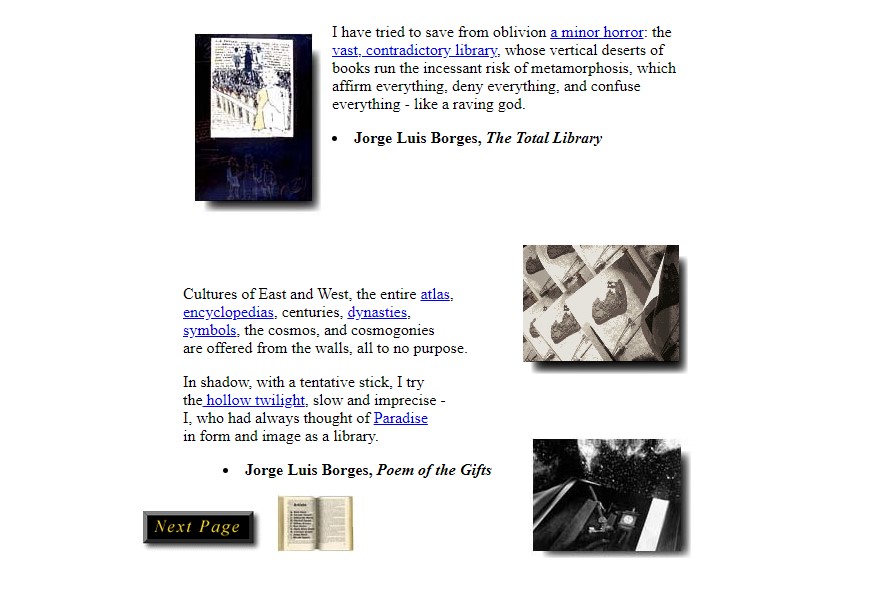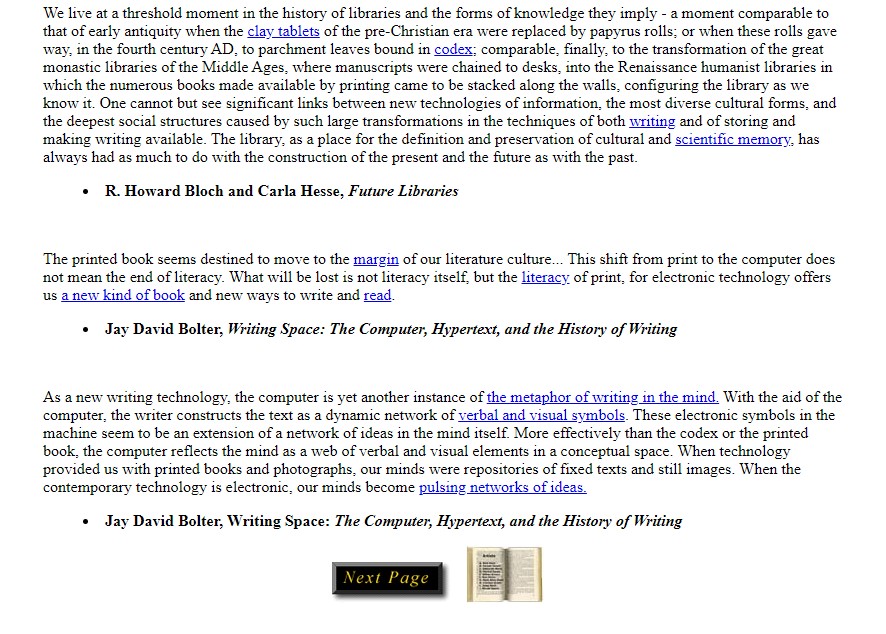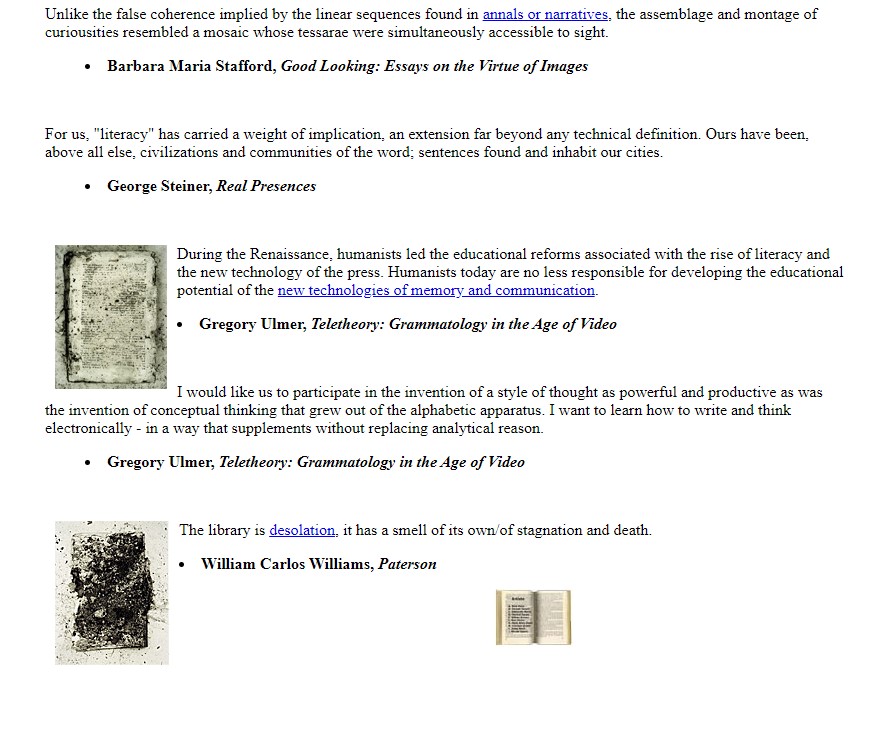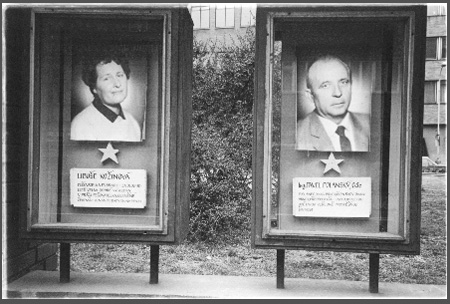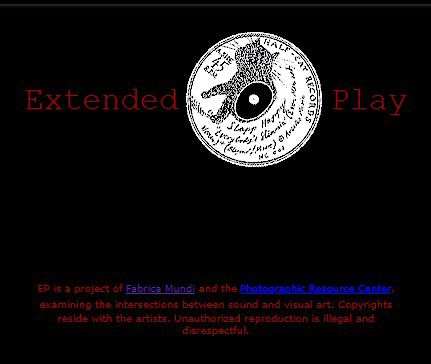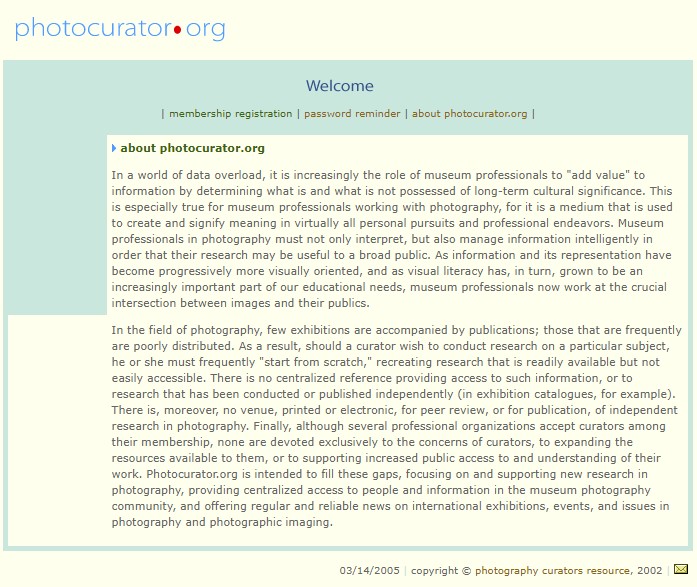The idea went something like this: if you picture the perfect society, people will believe they are living in it and strive harder to make it come true. Photographers followed directions in order to work, but some circumvented them in whatever small ways they could. -- Vicki Goldberg, review of Recollecting a Culture, NY Times, 1999
Introduction
By 1989, with the opening of Eastern Europe, an international network of photo-based artists and of spaces dedicated to presenting their work was already well established. At the Liget Gallery, Várnagy presented one-person exhibitions by many of the international artists who had contributed to the Second Portfolio or Out of Eastern Europe, including Anna Bohdziewicz, Milan Knizák, Matthias Leupold, and Lodz Kaliska, and he expanded the international roster well beyond photography.
In 1987, the exhibition Fotografia (Frankl Aljona, Halas István, Hegedüs 2 László, László Lugosi-László, Szilágyi Lenke, Várnagy Tibor, and Zátonyi Tibor) was the first of several exchanges between the Liget and the Mala Gallery in Warsaw, led by Marek Grygiel. In 1989, Zeitgenossische Ungarische Fotografie was the first of several exchanges between the Liget and Fotogalerie Wien, curated by Dr. Gerlinde Schrammel and with an essay by Jacob. Also in 1990, Várnagy, with co-curators Marek Grygiel and Robert Waldl, organized the exhibitions Fotoanarchiv: New Photography from Austria and Hungary for the Centre of Contemporary Art, Warsaw, and, in 1991, Fotoanarchiv II: Creative Photography from Austria, Poland, and Hungary for Szombathelyi Képtár. The Fotoanarchiv exhibitions brought together Austrian media-based artists, including Heinz Cibulka and Michaela Moscouw, with their Polish and Hungarian counterparts. In cooperation with Austrian artist Josef Wais, Várnagy organized the Eastern Academy of Photography in Vienna, a series of workshops and exhibitions introducing Czech artists Rudo Prekop, Kamil Varga, and Peter Zupnik, among others.
In the US, in 1990 alone, Jacob opened four major exhibitions: Nightmare Works: Tibor Hajas, co-curated with Steven High for the Anderson Art Gallery; Hidden Story: Samizdat from Hungary and Elsewhere, co-curated with Várnagy for the Franklin Furnace; The Missing Picture: Alternative Contemporary Photography in the Soviet Union, a group exhibition for the List Visual Arts Center at MIT; and The Missing Picture: Boris Michailov, a one-person exhibition, also for the LVAC.
Throughout the 1990s, Jacob continued his cooperation with Várnagy and Sachse. In 1991, in conjunction with the centennial celebration of John Heartfield’s birth, Sachse staged an action and Jacob read a paper for the Akademie der kunst zu Berlin’s international forum on Heartfield, and they co-curated a satellite exhibition, Photomontage Heute, for the Fotogalerie Berlin-Friedrichshain. In 1992, Jacob was hired as Director of Exhibitions for the Photographic Resource Center (PRC) at Boston University. At the PRC, in 1993, he organized an internet-based presentation entitled Out of Control: Photography from East Germany, co-edited with Sachse. Contributors to the project documented the uses of photography in the GDR before and after its collapse. In 1994, Jacob organized Return and Exile: Sylvia Plachy’s Photographs from Central Europe and Susan Rubin Suleiman’s Budapest Diary, a two-woman exhibition by these well-known Hungarian emigres to the US, and in 1995, he presented a one-person exhibition of works by Matthias Leupold. Prospective exhibitions on Hungarian photographers in New York City, and a retrospective of Milan Knizák, failed to gain traction.
Also in 1990, Jacob began to work with T.O. Immisch, curator of photography at the Staatliche Galerie Moritzburg, Halle, on a multi-year, international exchange of exhibitions. The first of these was Chimaera: Aktuelle Photokunst aus Mitteleuropa, which opened in Halle in August, 1997. Jacob’s second exhibition with Immish, Recollecting a Culture: Photography and the Evolution of a Socialist Aesthetic in East Germany, was his last related to Eastern Europe. Opening at the PRC in 1999, it commemorated the tenth anniversary of the fall of the Berlin Wall. In his critical writing from this period, and specifically in Recollecting a Culture, Jacob focused on the ahistoricism of post-1989 books and exhibitions that omitted officially sanctioned photography, considering the reasons for and the impact of such exclusions, including in his own work.
Produce related to Eastern European & Soviet photography, post-1989:
1990
Nightmare Works: Tibor Hajas (exhibition + catalog, with Steven S. High, Anderson Gallery, Commonwealth University, Richmond, VA)
Hidden Story: Samizdat from Hungary and Elsewhere (exhibition + catalog, with Tibor Várnagy, Franklin Furnace, NYC)
The Missing Picture: Alternative Contemporary Photography from the Soviet Union, Vladimir Kupreanov, Ilya Piganov, Maria Serebrjakova, Alexey Shulgin (exhibition + catalog, List Visual Arts Center at MIT)
The Missing Picture: Boris Mikhailov (exhibition + catalog, List Visual Arts Center at MIT)
1991
Beyond Fascination: Contemporary Eastern European Art in Western Perspective (paper, Milena Kalinovska moderator, College Art Association, Washington, DC)
A Short History of Soviet Photography (lecture, Washington University, St. Louis, MO)
“Perspectives, Real & Imaginary: Czechoslovakian Photography at FotoFest” (essay, Spot, Houston Center for Photography, Winter)
Photomontage Heute (exhibition, with Karla Sachse, Fotogalerie Berlin-Friedrichshain, Berlin)
Montage als Kunstprinzip: Colloquium zur John Heartfield (conference participant, Akademie der Kunst in Berlin, Germany)
“Reality and History: Observations for John Heartfield” (paper, Akademie der kunst in Berlin)
1993
Photo/Foto: Russian Art Photography Today Symposium (panelist and moderator, Diane Neumaier organizer, State University of New Jersey at Rutgers)
“Recollecting a Culture: East Germany and Photojournalism” (paper, Vicki Goldberg moderator, College Art Association, Seattle, WA)
“Out of Control: Photography from East Germany” (online anthology, with Karla Sachse, Photographic Resource Center, Boston, MA)
“Photoglyphs” (catalog essay for Photoglyphs: Rimma and Valeriy Gerlovin, Mark Sloan curator, New Orleans Museum of Art, LA)
1994
Return and Exile: Sylvia Plachy’s Photographs from Central Europe and Susan Rubin Suleiman’s Budapest Diary (exhibition, Photographic Resource Center, Boston, MA)
“After Roskolnikov: Russian Photography Today” (essay, Art Journal, Summer 1994 53 (2))
“Samizdat in 1989: Closing the Book” (essay, Liget Galeria Almanack: Central European Art in the Late ’80s, Tibor Várnagy ed., Liget Galeria, Budapest)
“Aesthetic Revolution or Personal Evolution?” (essay, Eternal Network: A Mailart Anthology, Chuck Welch ed., University of Calgary Press, Canada)
1995
Matthias Leupold: Fahnenappell & Gartenlaube (exhibition, Photographic Resource Center at Boston University)
1996
“Introduction” (catalog essay for Matthias Leupold: Living Pictures 1983-1995, Stipendiat im Künstlerdorf Schöppingen, Germany)
AKT/ok (group exhibition incl. Jacob, Liget Galeria, Budapest)
1997
Chimaera: Aktuelle Photokunst aus Mitteleruopa (exhibition + catalog, with Tony Dufek, Monika Faber, TO Immisch, Lech Lechowicz, Vaclav Macek, and Tibor Várnagy, Staatliche Galerie Moritzburg Halle)
Ex Oriente: Contemporary Photography from Central Europe (conference co-coordinator, with TO Immisch, Staatliche Galerie Moritzburg Halle, Germany)
1998
East/West Dialogue: Contemporary Art in Eastern Europe (conference participant, Rhode Island School of Design Museum, Providence, RI)
1999
Recollecting a Culture: Photography and the Evolution of a Socialist Aesthetic in East Germany (exhibition + catalog, Photographic Resource Center at Boston University)
2000
Recollecting a Culture: Photography and the Evolution of a Socialist Aesthetic in East Germany
The exhibition traveled to the Hampshire College Gallery, Amherst, MA, hosted by Robert Seydel (exhibition + lecture)
2002
Symposium on Photographic Archives in the Former GDR (conference participant, Staatliche Galerie Moritzburg Halle, Germany)
2017
The First International Portfolio of Artists Photography 35th Anniversary (exhibition, with Tibor Várnagy and Robert Swierkeiwicz, Liget Galeria, Budapest)
2019
“Time Travel with Tibor Várnagy” (catalog essay for Várnagy Tibor: Photos without Camera, 1985–1993, ACB Research Lab, Budapest, Hungary)
Nightmare Works: Tibor Hajas
The press release for the exhibition Tibor Hajas: Emergency Landing, presented by the Ludwig Museum, Budapest, in 2005, noted that “The works of Tibor Hajas… were previously presented on three occasions, with exhibitions at the King Saint Stephen Museum, Székesfehérvár, in 1987; the Anderson Gallery, Richmond (USA), in 1990; and a Commemorative Exhibition held at the Ernst Museum, Budapest, in 1997.”
The chronology is not accurate. In 1986, a small selection of works by Hajas was presented at the Liget Galeria, when Várnagy organized an exhibition of the Hungarian photographers under consideration for Out of Eastern Europe: Private Photography. Jacob transported Hajas’ photographs to the US, and they were exhibited at the List Visual Arts Center at MIT, in 1987. Hajas was also presented in the exhibition Zeitgenossische Ungarische Fotografie, curated by Dr. Gerlinde Schrammel, at the Liget Galeria and the Fotogalerie Wien in 1988, to which Jacob contributed a catalog essay. Finally, in 1990, the fourth issue of the underground journal Sznob International, dedicated to Hajas’s work, was presented by Várnagy and Jacob in Hidden Story: Samizdat from Hungary and Elsewhere. Several pages of the journal were reproduced in the exhibition catalog.
Hajas was a “forbidden” artist in the 1970s and 1980s. These smaller representations of his work, at home and abroad, were instrumental to his reformation. They took the political temperature for larger Hungarian institutions that were wary of censure by the cultural ministries. Jacob later wrote:
“Censorship,” as writer Miklós Haraszti has noted, “is the final glaze that the state applies to the work of art before approving its release to the public.” Tibor Hajas was “rehabilitated” in 1986, six years after his death, when a small selection of his works exhibited at the Liget Galeria in Budapest failed to arouse official indignation. Following the lead of the Liget, the István Király Múzeum in Székesfehérvár opened a retrospective “memorial exhibition” for Hajas in early 1987. The exhibition Hungarian Art of the Twentieth Century, The End of the Avant-Garde, presented at the István Király Múzeum in 1989, nine years after Hajas’ death, was among the first to present his work within the larger context of the Hungarian avant-garde.
Jacob was introduced to Hajas’s work by Várnagy. Várnagy also introduced Jacob to János Vető, an artist and musician who collaborated with Hajas, documenting and making sequential artworks of his performances; to László Beke, who, from the late 1960s, was a catalyst for art networks and cross-border collaborations in and beyond Eastern Europe, and was Hajas’ most vocal advocate; and to György Széphelyi, Hajas’ brother. Várnagy and Jacob secured the approval by Széphelyi for the use of Hajas’ work in Out of Eastern Europe, and Jacob was given several original panels by Hajas and Vető as well as several sequences printed by Várnagy from Vető’s negatives, including lesser known ones such as Lou Reed Total (1979). At that time, Jacob also spoke with Beke and Széphelyi about a one-person exhibition in the US. They agreed to it once a retrospective had been presented in Hungary. The ideal of an exhibition at the Műcsarnok in Budapest, where Beke worked, was still politically impossible, so it opened at the István Király Múzeum. After the exhibition in Székesfehérvár, in 1987, Jacob began work in earnest on a Hajas exhibition in the US.
Steven High seemed like an ideal partner. He was director of the Maine College of Art Gallery when Out of Eastern Europe travelled to Portland, ME, in 1988, and he invited Jacob to present a satellite exhibition, Leupold/Leupold: Staged Photographs. After he moved on to the Anderson Gallery at Commonwealth University in Richmond, VA, Jacob worked with him on a one-person exhibition by Thomas Flotscheutz, contributing a catalog essay. Jacob approached High about co-curating the Hajas exhibition. They traveled to Budapest together, and Jacob and Várnagy introduced him to Beke and Széphelyi. The selection process was easy; they took everything that was available directly from the Hajas estate. Shipping was handled by the Soros Foundation’s Documentation Center, which also translated and shared its research on Hajas, a crucial addition to the catalog. István Halas was hired to photograph the artworks for the catalog, and Várnagy printed performance documentation from Vető’s negatives for the installation. Beke and Jacob contributed catalog texts, and Jacob consulted with High on the title, the catalog, and the installation design. Nevertheless, when Jacob received a draft of the catalog, he was not credited as co-curator. High made excuses blaming his institution. It would be the last time Jacob worked with him.
Despite Jacob’s disappointment with High, the exhibition was thoughtfully installed and the catalog was both informative and beautifully designed. In particular, Jacob’s essay marked a turning point in his critical writing. Jacob had been unsure how to meaningfully explain work such as Hajas’ to a non-specialist American audience. For earlier exhibitions, he developed an interpretive method that combined art historical reference and current events. Looking at Hungarian photographers in The Metamorphic Medium, for example, reference to André Kertész or László Moholy-Nagy situated their work in the art historical past of international modernism, while discussion of the cultural imperatives of the János Kádár regime situated them in the geopolitical present. The familiar figures of modernism connected Hungarian photographers and American audiences with a common past. The unfamiliar but potentially legible signs of the political and economic constraints shaping their work in the present offered another key to their practices.
Jacob came to see that focusing on what was common and familiar to American audiences obscured the semantic complexity of Eastern European and Soviet photography, as utterly contemporary and distinctly postmodern. Conceptual and media-based photography arose in Eastern Europe and the USSR as an art of resistance within an evolving socialist aesthetics. It arose in dialogue with that aesthetics, not only in opposition to it. It evolved with parallels from one Soviet-bloc nation to the next, and with differences related to both the unique constraints experienced by artists in one nation or another, and to their distinct photographic histories, such as Germany’s history of worker photography. Artists were not immune to historical influence or influence from abroad, in other words, but that was not what defined their practices. Western critical writing, including by Jacob, elided the dialogue with socialist aesthetics because of its link to Socialist Realism, favoring instead a validating link to international modernism. That is why Sots Art, an ironic Soviet Pop Art that dismissed Socialist Realism as kitsch, succeeded in the post-1989 international marketplace where others failed. Jacob’s essay for Nightmare Works was the first in which he sought to address this interpretive inaccuracy.
He did so by writing of the image as a text under state control. He argued that, in authoritarian regimes, the state claims authorship of all texts. Authorized images may therefore be understood only through the closed or ideological text of state control. Unauthorized images operate differently. Images emerging from totalitarianism, yet unauthorized by the state, are indeterminate; they possess no fixed meaning. In the hands of an artist like Hajas, the open text of the unauthorized image transforms the viewer of the artwork into its author by forcing her to action. “Hajas’ performances challenged audiences against the danger of moral and intellectual passivity,” Jacob wrote. As examples, Jacob first cited and then dismissed any parallels between Hajas’ work and Western artists, such as Hermann Nitsch or Chris Burden, which operate by a different set of rules. He then turned resolutely local, to the work of Hungarian neo-avant-gardist Miklós Erdélyi.
This was a sign of Jacob’s growing familiarity with his subject, of course, but it was also a strategic turn. Rather than historicize Hajas in relation to the past or the West, Jacob flipped the script of his earlier texts, looking forward to Hajas’ influence on photographers of the next generation, notably Vető, Várnagy, and Ujj. Jacob followed this textual strategy for Nightmare Works in his curatorial strategy for another exhibition, The Missing Picture: Alternative Contemporary Photography from the Soviet Union. There, rather than a simple survey of Soviet photography, he presented a group of young Soviet artists influenced by Ukrainian photographer Boris Michailov, then little known outside the USSR. Jacob also returned to Erdélyi’s work many years later, when writing about Várnagy’s cameraless photography.
Nightmare Works: Tibor Hajas (Open/Download PDF)
August 30 – October 14, 1990
Anderson Gallery, Virginia Commonwealth University, Richmond, VA
Contributors:
Hajas Tibor & Vető János
Texts: Steven High, László Beke, and JP Jacob
Recalling Hajas
John P. Jacob, Austin, 1990
I am he who, in order to be, must whip his innateness.
— Antonin Artaud
1.
Several years ago, I found a small strip of 35mm film on the sidewalk of Kalajeva Street in Leningrad. Evidently torn from a larger series of pictures, it was at one time, perhaps, a piece of a motion picture. The industrial logo spelled out in Cyrillic by the sprocket holes suggested to me that both the film and the scene it depicted were Soviet in origin, and not the litter of Western tourists. Each of the three frames contained on the film showed the same picture: a man dressed in a long coat and a cap standing between a wooden fence and a body of water. The fence encloses a dense, wooded vegetation, which frames one side of the image. The man stands at the center of the photograph, looking away from the camera toward the water. Between the fence and the water, the plot of ground on which the man stands is grassy and well maintained. Three tall, rough hewn poles form a descending line into the distance of the landscape. Near the most distant pole, a road emerges from the wood and slopes into the water.
Throughout its brief history photography has been presented as a universal language. Photographs of men and women in various conditions of health and sickness, wealth and poverty, community and solitude, have been used to represent the commonality of experience, the relatedness of all to one and of one to all. Yet as I look at this small picture I am aware that whatever shreds of meaning I am able to obtain from it emerge from within myself, from my own history as a “reader” of photographic images, rather than from the meaningful intentions of its author.
This photograph, which was at one moment deemed worthy of preservation, and at another torn from its source and rejected, fascinates me. Abandoned by its author, the image has come into the presence of a reader (myself) who seeks, through recognition of familiar signs (water, fence, telegraph poles, road), to establish a text sufficient to discover its meaning. Absent an authoritative text to tie them together, however, the signs I am capable of distinguishing fail to form a linear narrative; they do not “line up” to tell a story. Without an author to “close” it, the history of the photograph is indeterminate. Its text is open to my interpretation.
Given that we are rarely familiar with the intentions of the authors of images that everywhere surround us, how is it possible that we ever obtain meaning from photographs? More often than not, the photographer will have executed his or her pictures to fit within internationally recognizable aesthetic categories, or genre, such as landscape, documentary, or portraiture. If the photographs that we are viewing function outside such categorization, we may look for meaning by studying the culture from which the photographs have emerged. Finally, viewers may rely on the photographer (or on a critic) to provide a text locating the aesthetic, institutional, or cultural significance of the pictures. In each of these methods for interpretation meaning is determined through narratives that exist outside the immediate relationship of the viewer to the photographic image. Each depends upon an outside authority to construct meaning through a closed or fixed text.
In authoritarian regimes, the state is the ultimate author of all texts. The state exercises its authority through absolute control not only of the artist, but also of the viewer. The state controls not only cultural institutions, such as museums, but also the material that those institutions may present and the media within which such presentations may be discussed. The state controls not only the creation of images, but also their circulation and their destruction. In other words, the authoritarian state controls the words, the images, and the media through which its historical record is created, maintained, and preserved. The state’s absolute control of the image confers upon it a “theological” closure, such that the image is closed to interpretation. This closure is the root of the ideological value of the photographic image in authoritarian states.
Images emerging from totalitarianism may be understood only through the closed or ideological “text” of state control. Appearing to allow the viewer no role in the construction of meaning, the authoritarian text implies a natural and exclusive bond between image and state. The relationship of the photographic image to time (that the event photographed has truly occurred is proven by its presence in the picture) extends, on the two-dimensional surface of the photographic print, to the state. Thus, the state is endowed with the look of history. The relationship of the viewer to the history depicted in the photograph is determined by his or her acceptance of its underlying text of control.
Photographic images emerging from totalitarianism, yet unauthorized by the text of state control, are indeterminate; they are incapable of possessing absolute meaning. Such images possess no fixed text determining their origins or intentions. Unauthorized (or, as they have come to be known, “unofficial”) images engage viewers in the open-ended construction of meaning through the absence of such a text. Unauthorized photographs represent the challenge of meaninglessness to overdetermination. Refuting the state’s absolute control over cultural signification, such images position viewers within a relationship of resistance to the concept of the author, and thus to the authority of the state. Such images need not be “political,” but they are always “active.” In the unauthorized images that come to us from authoritarian cultures, therefore, meaning may be determined as much through the activity that they promote as through the collection of signs that they represent.
The particularly subversive quality of the photographic image, as appealing to the artist working against state control as it is provocative to the state seeking to control it, is its position as both an artwork and a document. The photograph stands, simultaneously, both inside and outside of time. What we experience when we look at a photograph, as John Tagg has noted, is
a double movement which typifies ideological discourse. On the one hand, the ideological construction put on the objects and events concretises a general mythical scheme by incorporating in it the reality of these specific historical moments. At the same time, however, the very conjuncture of the objects and events and the mythical scheme dehistoricises the same objects and events by displacing the ideological connection to the archetypal level of the natural and universal in order to conceal its specifically ideological nature. What the mythic schema gains in concreteness is paid for by a loss of historical specificity on the part of the objects and events.1John Tagg, The Burden of Representation, Essays on Photographs and Histories, Amherst, MA,1988, p.159.
When a photograph is authorized by the state, levels of meaning appear to merge within it, absolutely and seamlessly, to form an ideological text. However, ideology cannot exist independently within the image, but depends upon the viewer to “activate” it. The ideological function of the photographic is contingent upon the viewer’s a priori acceptance of, or faith in, the image’s cultural signification, as determined “theologically” by the state. The absolution of the authoritarian state is validated by the viewer’s unquestioning faith.
The medium of photography has proved a fertile ground for artists whose work resists the authority of the text. Those who produce photographic images within authoritarian states often use the medium to disrupt ideological discourse. In so doing, they disrupt the apparent relationship of the state to time and to history. They profane the natural order, showing, to paraphrase Roland Barthes, that a text is not a line of signs releasing a single “theological” (or, as Tagg would have it, “universal”) meaning, but “a tissue of quotations drawn from innumerable centres of culture,” none of them original, none of them absolute. It is for this reason that artists working within authoritarian regimes are often prohibited from producing photographs that do not bear the authorization of the state.2Roland Barthes, Image – Music – Text, New York, NY, 1977, p.146.
2.
By [the end of the 1970s] only a few artists remained to be categorized as “prohibited,” only those “impenitent recalcitrans” [sic] like… Tibor Hajas… who, at times deliberately challenging authority, refused to acknowledge any taboos clad in the costumes of politics or morality… It was only the “recalcitrans” who stuck out from the peaceful general view.3Péter Kovács, Hungarian Art in the 20th Century. The End of the Avant-Garde, (1975-1980), Székesfehérvár, Hungary: István Király Múzeum,1989, p. 6.
In the catalogue accompanying a survey of Hungarian art from 1975 — 1980, Péter Kovács, Director of the István Király Múzeum in Székesfehérvár has noted that “the ‘avant-garde’ [of that era] had a rest and seemed to peacefully settle down: it turned main stream.”4Kovács, p. 6. To “turn main stream,” however, implies not only that the avant-garde had, by the mid 1970s, accepted the Hungarian state, but also that the state had accepted the avant-garde. It is significant that this statement, summing up a period in the artistic history of a nation as one of general contentment, comes to us from one of that nation’s important cultural institutions. Other texts from the same period tell the story from a somewhat different perspective.
It was during the late 1970s that Tibor Hajas created his most mature and important works, a series of actions performed for photography. Formally, Hajas’ actions followed the lead of the Viennese Actionism. Working in Austria since the early 1960s, the work of this group of artists, led (arguably) by Hermann Nitsch, merged theatre with artistic production, replacing language with sensation by “pouring out, spraying, splashing, smashing, tearing up, tearing apart meat, or smearing or soiling something,” activities accompanied by the noise of a “screaming chorus” of woodwinds and percussion instruments. The object of the action was to liberate “accumulated and blocked up psychic energies.”5Hermann Nitsch, Hermann Nitsch,1960 – 1987, Naples, Italy,1987, p. 32. Liberation, therefore, rather than any finished piece, was the object of (especially Hermann Nitsch’s) Actionism.
The resemblance of Hajas’ work to the Viennese Actionists’ does not extend far beyond appearances. In contrast to the psychic liberation advocated by the Vienna group, Hajas’ performances challenged audiences against the danger of moral and intellectual passivity. While the role of the spectator in the Viennese Actionism is basically compliance, Hajas’ audiences are prompted to direct participation.6“The spectators are required, during the performance to [be] concentrated and let abandonment, reflection and pleasure, meditation and excess take over.” M. D’Ambrosio, in Hermann Kitsch, 1960 -1987, p.112. In Dark Flash, a performance held at the Galeria Remont in Warsaw, 1978, Hajas hung from the ceiling by a rope bound to his wrists. In his hands he held a camera. As the blood drained from his hands and cut off his circulation, Hajas photographed his audience until, at last, he passed out. Had his audience not finally cut him down, the artist might have died. His film documents their indecision.
Hajas’ performances are reminiscent of the early work of American artist Chris Burden. The provocative intentions of Dark Flash are remarkably similar to those of Burden’s Back to You, 1974, in which a member of the audience was invited to stick push pins into the artist’s body; of Velvet Water, 1974, during which an audience of art school students watched via video monitor as Burden collapsed after submerging his face in a sink and attempting to breathe water; and of Kunst Kick, 1974, when, during the public opening of the Basel Art Fair, Burden had himself kicked down a flight of stairs, two or three steps at a time. The struggle of the audience is not with the pain that the artist inflicts upon himself, but with its complicity in inflicting that pain through failure to prevent it. The struggle of the viewer is that of reader against author, of actor against text. The viewer must go against the grain of the text and put an end to it, or s/he must accept the role of passive compliant. The viewer becomes, simultaneously, both subject and author of the artist’s work.
Júlia Szabó has noted that Hajas experienced the element of “hidden risk” in his performances: had the audience not come to his rescue, he might have died. This concept of hidden risk returns us, once again, to the notion of the open, or unauthorized, text. Hajas’ risk extends from his own body to the body of viewers, his audience; the degree of pain that he inflicts upon himself is directly proportionate to his viewers’ acceptance of their authority to end it. As Hajas wrote, “we do not, on our own, deliberately have to do anything to incur damnation; our participation is a prodigal luxury.”7Tibor Hajas, Hajas Tibor, 1946 – 1980, Magyar Mühely, np. Two retrospective publications, both titled Hajas Tibor, 1946 – 1980, will be cited extensively. To avoid confusion, the earlier publication, edited by Lázsló Beke, will be referred to as Hajas Tibor, 1946 – 1980, Magyar Mühely. The exhibition catalogue published by the István Király Múzeum in 1987 will be referred to, simply, as Hajas Tibor, 1946 – 1980.
By transforming the role of viewer to participant, and finally to author, Hajas conferred upon viewers the authority to challenge his text. He empowered his audience to take positive action against suffering, to refuse passive complicity. The closed room of the performance space extends to implicate the closed text of the artist, as well as the closed state of authoritarian culture. By acting against the artist’s text, the audience also acts against the text of state culture, “opening” it to interpretation. Within the authoritarian state in which Hajas worked, this was regarded as an act that neither he nor his audience was authorized to commit.
“Censorship,” as writer Miklós Haraszti has noted, “is the final glaze that the state applies to the work of art before approving its release to the public.”8Miklós Haraszti, The Velvet Prison. Artists Under State Socialism, New York, NY, 1987, p. 9. Tibor Hajas was “rehabilitated” in 1986, six years after his death, when a small selection of his works exhibited at the Liget Galéria in Budapest failed to arouse official indignation. Following the lead of the Liget, the István Király Múzeum in Székesfehérvár opened a retrospective “memorial exhibition” for Hajas in early 1987. The exhibition Hungarian Art of the Twentieth Century, The End of the Avant-Garde, presented at the István Király Múzeum in 1989, nine years after Hajas’ death, was among the first to present his work within the larger context of the Hungarian avant-garde. In his text for the catalogue of that exhibition, curator Péter Kovács wrote that “even with the really provoking works of… Tibor Hajas challenging accepted values it was rather the thorny behavior than the works’ real or presumed political message that deterred the authority.”9Kovács, p. 7. Implicit in this statement is the suggestion that although the power of Hajas’ work to provoke is rooted in his audiences’ common acceptance of the values that he challenged, it was his behavior in provoking, rather than the effect of his provocation, that resulted in his prohibition.
Citing Hajas’ attitude rather than his effect, Kovács’ statement reiterates former Politburo member György Aczél’s declaration, made in 1982, that “there is no opposition that has to be reckoned with in Hungary,” only a few maladjusted, untalented, mentally troubled and disappointed people who blame society for their failures.10Cited in Peter Toma, Socialist Authority: The Hungarian Experience, New York, NY: Praeger, 1988, p. 37. Kovács relegates Hajas to the status of enfant terrible. Hajas’ importance to Hungarian culture of the 1970s, and to the generation of artists working in Hungary today, is sorely diminished by this interpretation. Hajas was more than a “recalcitrant” or “political artist,” butting his head stubbornly against the state. The importance of his work lies not in its power to undermine the values of his audiences, but in its capacity to reinvest those values with meaning. Hajas, like his contemporaries Miklós Erdély and Gábor Bódy, sought to empower his audiences with the authority of moral responsibility. He took his audiences on a journey, similar to that depicted in Miklós Erdély’s photographic series Time Journey I — V, 1976, in which viewers were brought face to face with the consequences of their actions.
Using exposures lifted from old family photographs to construct a single self portrait, the third photograph in Erdély’s series, subtitled 1934, depicts the artist at three different stages of his life. Erdély as a boy plays a game of chess with Erdély as a young man, while Erdély as an older man, the artist, observes their game. Erdély the artist knows the nature of the game that the younger men are playing, and he knows which of the two will win.
Time Journey I —V is a complex series of “observations,” of which 1934 stands as the centerpiece. The viewer of the series stands in time with Erdély the artist. In common with the artist, the viewer is a time traveler; s/he observes the artist observing himself. Simultaneously, the viewer is implicitly aware that s/he is observed by the artist. The artist, who created the series for the viewer’s observation, stands between past and future, looking in both directions. Thus, the viewer may observe with the artist, but not without being observed by the artist. This inescapable relationship of observer to observed in which the viewer has been trapped extends telescopically from time past to time future. To know the past is to see the future. Yet to see the future is to deny chance, to cancel the unpredictable. A life denied of chance, a completely predictable life, is but a slave to the certainty of time. A life denied of chance is no longer free.
It is not for freedom itself, total freedom, but for faith in freedom, that Erdély the artist observes Erdély the boy and Erdély the young man playing. This distinction is critical, for it is precisely against freedom through faith (freedom through art, freedom through work, freedom through socialism) that the work of Erdély and Hajas speaks. Such freedom, contingent upon ideology, is false and fleeting. It is as a result of such faith, believing creative expression to be the ultimate act of liberty, that we come to observe the work of these artists. Yet in observing, we are drawn into their trap. The artist locks the door behind us. The artist engages us, demanding that we see that our histories (our family albums) are easily falsified, our beliefs easily corrupted. Our past (the text of history) is our bondage, our truth is our lie. The artist demands that we reject bondage, that we abandon the safety of faith, grounded in ideology, and experience total freedom.11See Hajas’ Recompense, Hajas Tibor, 1946 – 1980.
Like Erdély, Hajas placed the concept of total freedom within the grasp of his audiences. That he did so in Hungary in the 1970s insured that he would, more than once, come into conflict with the state. Yet Hajas was not a political artist. Rather, he was an activist (as the term was used to define a tendency in German expressionism) who “reformed [anarchistic impulses] in the direction of neo-enlightenment by elevating psychological revolt to the level of practical and social reform.”12Renato Poggioli, The Theory of the Avant-Garde, Cambridge, 1968, p. 27. Hajas placed ideas above art, and treasured freedom above all.
Touching live wires can cost… lives. This was something Tibor Hajas knew and wanted and the forbidden touch brought him its double reward: annihilation and total freedom. Total freedom, perhaps the most monumental slogan that the avant-garde could conjure up before the eyes of mankind but which it was, of course, unable to materialize in socially feasible terms. Tibor Hajas’ influence was thus also condemned to remain limited but one thing is certain: everyone who met him or was confronted with his works could not but feel this touch of total freedom.13László Beke, in Hajas Tibor, 1946 – 1980, Magyar Műhely, np.
3.
I cannot conform to you, I cannot be at your mercy. I have become the guidepost whether you wanted it or not; you can only refer to me, you can only return to me. But it is not necessarily compulsory; we are independent of each other. Don’t let yourself be deceived, my lord. My lord, don’t let yourself be deceived.14Tibor Hajas, in Vigil (1980), Hajas Tibor, 1946 – 1980.
In the decade since Hajas’ death Hungarian culture has risen from what appears to Western eyes as a deep slumber. Yet if this was slumber, then the nation’s culture must have been shaken to consciousness by nightmares. Indeed, during the years of Soviet occupation a powerful undercurrent of Hungarian culture has been active in the works of Béla Kondor, Miklós Erdély, Gábor Bódy, Tibor Hajas, and numerous others. Largely unrecognized in the West, these artists have worked, often under duress, to maintain the vitality of Hungarian tradition. Their activities are testament to the will of the Hungarian people, exemplified by the post-World War II election defeats of the Soviet dominated Communist Party, by the revolution of 1956, and by the recent defeat of the Party in the elections of 1990, for self determination.
Hajas was not alone in his relentless investigation of moral and aesthetic values. Nor was he the only artist to realize his own body as the site of conflict. During the early 1970s, the Squat Theatre, then known as Studio Kassák, began to merge the art of performance with the reality of the audience as a direct result of prohibition. “The place is an apartment on the fifth floor, where we played whatever we wanted to, but the danger played with us… The personal fate, culture and gestures of the spectators became part of the theatre, just like ours. The result: a very selective and subtle communication system, a sort of symbolism based on the realities of this ‘apartment theatre.’”15Stephan Balint, New Observations, #40, New York, NY, 1986, p. 2. Following the group’s departure from Hungary in 1976, they continued to bring “real life” together with theatre, by performing in a large New York City storefront. “The storefront was a situation where fiction and reality could mix because there was a fiction on stage and there was a real life behind as background, and sometimes the real life intervened.”16Balint, p. 7.
“Reality” was also the material of the “experimental” Group Inconnu. “Experimentation, which aims at pointing out to the viewers, more precisely, to the whole of society, the limits of the autonomy of the individual. This is why the field of reality is more appropriate for artistic and social activity, since here the falsity of illusions and substitute gratifications is immediately revealed and the ‘condition humaine’ manifests itself in its own nature.”17Gabriella Ujlaki, 2. Mini Retrospekt, Group Inconnu, Budapest,1985, np. Throughout the 1970s Group Inconnu merged aesthetic form with political expression using body art, performance, installation, and mail art. The activities of Group Inconnu were consistently prohibited through the 1980s. Toward the end of the decade, the group curtailed its artistic activities to aid the growing number of independent political organizations in Hungary, providing access to printing, telefax, and other services still under state control.
The work of Tibor Hajas is distinguished from that of his contemporaries precisely by its falling between aesthetic and political spheres, into the realm of the personal. Hajas sought to “dispense with my clothes, pastimes, walls, objects and dates that surround me now. To grow as thin as to become mere voice; to lose everything that binds me here now.”18Tibor Hajas, in Vigil (1980), Hajas Tibor, 1946 -1980. Falling into the category defined by Renato Poggioli, in his Theory of the Avant-Garde, as “agonism,” Hajas offered himself as a guidepost for future generations. “In short, agonism means sacrifice and consecration: an hyperbolic passion, a bow bent toward the impossible, a paradoxical and positive form of spiritual defeatism.”19Poggioli, p. 66. (emphasis added) This consecration, Poggioli continues, constitutes “[an] immolation of the self to the art of the future [which] must be understood… as the fatal obligation of the individual artist.”20Poggioli, p. 67. Thus, it is in the work of Hungary’s contemporary artists that we may best observe Hajas’ influence. In the works of Tamás Szentjóby, Ákos Birkás, Bálint Flesch, Antal Jokesz, and others too numerous to mention, Hajas’ contribution to Hungarian culture is directly revealed. Of particular note are János Vető, Zsuzsanna Ujj, and Tibor Várnagy.21For information on contemporary photography in Hungary, see The Metamorphic Medium, New Photography from Hungary, Oberlin, Ohio: Allen Memorial Art Museum, 1989.
It is impossible to speak of the work of Tibor Hajas without also speaking of János Vető, his collaborator. It was Vető who worked with Hajas, photographing his private performances for camera, and it is Vető’s sense of space and sequence that imbued these images with an aesthetic drama that parallels the moral and physical drama of Hajas’ actions. In the 1980s, Vető worked extensively as a musician, most notably with the underground “cassette band” Trabant. In his recent photographic work, Vető defies textual interpretation using a layering strategy, apparently merging objects from different images and then partially obliterating them by scratching them out of the negative or by overpainting them in the print. One recent installation of Vető’s work, constructed in 1989 at the Contemporary Art Forum of Almássy Square, presented photographs attached to hinged, book-like binders mounted onto a pile of wooden tables and chairs. The tables and chairs were taken from local schools and culture houses where, not long ago, such work would have met with disapproval. From within this disorderly mound of hard, authoritarian furniture, Vető’s photographs appear to emerge as the new textbooks of Hungarian culture.
Zsuzsanna Ujj is today one of the few Hungarian artists whose work explores simultaneously the mediums of performance and photography. A poet, performer and musician, Ujj’s exhibitions are often accompanied by actions and concerts. In her images, prepared privately for the camera, Ujj is always her own subject. In an untitled series prepared in 1986, Ujj focuses upon the cultural construction of sexuality using a series of poses, alternating between violence and vulnerability, to confront the viewer. Returning the gaze of the viewer, Ujj defies the borders of the print. The anonymous space of the action extends through the print to the space of the gallery and to the viewer within that space. Her photographs transform the tradition of the passive female nude into a site of physical conflict in which the viewer is directly implicated.
Ujj’s most recent photographs, a series of sculptural torsos, return to the subject of the female nude. Addressing it from both an aesthetic and a critical perspective, Ujj’s torsos are as formally elegant as they are conceptually disquieting. Using high contrast black and white film to achieve her effect, Ujj’s body, dismembered and devoid of personal detail, emerges dramatically from the black background. The viewer is instantly and pleasantly reminded of countless similar torsos s/he has seen in museums and public places in which the nude female body has been canonized. Yet it is precisely within this pleasant moment of recognition that Ujj’s critique begins. As Kate Linker has written, “identity is constructed only through images acquired from elsewhere.”22Kate Linker, in Art After Modernism, Rethinking Representation, New York, NY, 1984, p. 396. Identifying the torso, we identify our historical relationship to it, ultimately identifying ourselves by it. Our pleasurable response to Ujj’s torsos implicates us as complicitous partners in the patriarchal construction of female sexuality through visual representation.
The photographs of Tibor Várnagy, though formally distant from those of Tibor Hajas, continue the dialogue with textual authority so prominent in the work of the latter. Várnagy’s series of TV Contacts, Fire Prints, and Black Squares represent an extraordinary investigation of the photographic image as a message carrier. Of his work the artist has written,
In 1985 I made my first series of [cameraless] photographs by placing photographic paper on the television screen during broadcasts. Prints made this way lost the photographic sharpness that makes them appear specific or concrete. It seemed that behind the surface of the photographs, where the documentary value is carried, common symbols exist. Later I turned to burning the unexposed photographic paper, developing the remaining surface that had been exposed by its own flame. The resulting images were surprisingly rich formally, in places graphic, and rich in tonal variations. In both series the gesture became significant. I made the black squares in 1988 by illuminating the photographic paper through the empty negative holder. All these may be taken as paraphrases of Malevich, in which the variations are caused by the possibilities of another medium. In contrast to his pieces, I made rectangles because the standard commercially available photographic paper comes in the shape of rectangle: I used these vertically. I found it necessary to overexpose these rectangles, a process that destroyed their geometric movement, introducing the possibility of a new dimension. The ambivalence resulting from this process is positive, or the interpretation of a negative statement; and finally, but not least importantly, the process addresses the issue of multiplicability or the problem of quantity.23Tibor Várnagy, in The Metamorphic Medium, New Photography from Hungary, p. 40.
Várnagy’s photographs seek to divest objects of meaning by denying the validity of their cultural functions. This divestiture extends to implicate the belief that meaning exists independently within the photograph itself. In his TV Contacts, Várnagy plays simultaneously with the authority of the artist, using his own initials in the title of the series, and with the authority of the state controlled television media from which the images were lifted. The origin of the authoritarian text has been blurred both in the refusal of the artist to function as a “creator” (the eye behind the camera) of messages, and in the transformation of the televised images from rigidly political message carriers to purely formal objects. Like Hajas, Várnagy reveals by his own action that the authority of the text (of the state in his TV Contacts, of art history in his Black Squares, and of the photographic genre and materials in his Fire Prints) can not exist independently, but depends upon the viewer for its validation and repetition. The artist is also viewer. Both subject and object, s/he is at the center of the production of meaning in every text. Only through the artist/viewer’s active participation in the construction of meaning is the ideological function of the text subverted, and only through such subversion is the concept of total freedom within reach.
4.
You could never defend yourselves before, you could never offer assistance, but now this condition bears my name. I am perfectly aware, more so than yourselves, what you stand to lose while you are here. The longer, the more. And a single moment suffices for a catastrophe. I am deliberately taking my time; deliberately holding you up. Holding you up to give catastrophe a better chance. I would like catastrophe to strike you while you are wasting your time here. It would make these moments valuable, significant, set apart, unique. It would give them weight. I could give you the experience of the irremediable. At last you could realize what you are missing.24Tibor Hajas, in Recompense, Hajas Tibor,1946 – 1980.
In the final years of the 1980s, Hungary has been dramatically transformed, politically and culturally. The removal from office of János Kádár, mouthpiece for the Soviet power that crushed the Hungarian Revolution for more than thirty years, has been swiftly followed by the removal of those who sought to replace him. As the borders between Hungary, Austria, and Czechoslovakia have opened, the dictatorship of the Czechoslovak Communist Party has also crumbled, rekindling in the people of the Danubian nations the hope for international unity. Simultaneously, fience nationalist disputes between Central European nations, closed to discussion during the period of Soviet occupation, have been reopened. As Central Europe emerges from domination, the nations of which it is composed have reawakened to the settling of old accounts. The threat of violence, as recent attacks upon the Hungarian minority in Rumania have shown, is all too real.
Although they may not have been aware of it, the work of Hajas and his contemporaries is symptomatic of the earliest movement toward reformation in the nations of the Warsaw Pact. The period in which Hajas worked (the 1970s) is traditionally viewed as the close of the period of thaw following the Khrushchev years. This view of “open” and “closed” periods of artistic expression fails to acknowledge the fact that even in periods of repression artists in Hungary have continued to develop their work independently of the state. The development of independent ideas during the Khrushchev era did not simply end upon his replacement by Brezhnev, but continued by exercising a profound influence upon younger artists, who pursued their ideas and convictions into the 1970s and 1980s. The work of Hajas and his contemporaries occurred during a time of great flux and uncertainty in Soviet Europe. Therefore, the independent culture of artists working in this period may be better understood as pivotal, the point upon which both the end of the old era and the beginning of the new tenuously rocked. Artists who worked during the old era continue, in some instances, to influence. The efforts of those who, like Hajas, helped to create the new era, remain unsurpassed.
Finally, it is critical to recognize that the authority opposed by Hajas and his contemporaries is not one that can be named. As the authority of the socialist state has passed, encroaching capitalism threatens to take its place of power. As revealed in the TV Contacts of Tibor Várnagy, however, the authority of the state exists on a parallel with the authority of the artist; both seek to direct the faith of the viewer. It is authority in all its many forms, therefore, that these artists resist. Recognizing the contradiction in his very words, in 1980 László Beke declared that “to recall the life and works of Tibor Hajas is to commit trespass: disturb something which is definitely at rest, mutilate what is whole, classify that which is unclassifiable, degrade what has for eternity become more than that.”25László Beke, Hajas Tibor, 1946 – 1980, Magyar Műhely, np. Yet as Hajas has so clearly shown, there is no forbidden ground. There exists no absolute whole that is not also eminently dividable. Hajas left no body to rest, not even his own.
I am grateful to Steven High, László Beke, Andi and Tibor Várnagy, István Halas and Zsuzsanna Ujj, and Deborah Chapman for their generosity and assistance during the preparation of this essay. Typos in the original were corrected in this edit (2002).
Recalling Hajas, in Nightmare Works: Tibor Hajas, Steven High ed., Anderson Art Gallery, Richmond, VA., 1990
Liget Gallery page:
http://www.ligetgaleria.c3.hu/CafeHajas.htm
John P. Jacob is an artist and independent curator who works extensively with artists in Eastern Europe.
The Missing Picture: Alternative Contemporary Photography from the Soviet Union
Jacob travelled to the Soviet Union the first time in 1986. He traveled with a tourist visa and visited Moscow and Leningrad. Jacob and Katy Kline, director of the List Visual Arts Center (LVAC) at MIT, agreed that, depending on what opportunities he encountered there, he might guest-curate a subsequent exhibition, following Out of Eastern Europe. Jacob initially planned to organize a survey exhibition, mirroring his work on Out of Eastern Europe. That plan was ultimately scrapped, in part due to the vast geographic expanse of the USSR and the difficulty of travel for a foreigner. More significantly, the exhibition sought to respond to the sweeping and unexpected changes taking place in the USSR at the very moment Jacob was working there.
For his first visit, Jacob travelled with a contact list given by Rimma Gerlovina and Valeriy Gerlovin. His primary contact in Moscow was Igor Makarevich, a conceptual artist and member of the Collective Actions group who was active in Moscow’s underground art scene since the 1970s. Makarevich was a contributor to Second Portfolio exhibition in Budapest (along with the Gerlovins and Vagrich Bakhchanyan, based in the US). He introduced Jacob to other members of the Collective Actions group, and also to Alexey Shulgin, with whom Jacob subsequently worked as closely in the USSR as he did with Sachse and Várnagy in Eastern Europe. The Ukrainian photographer Boris Michailov also had a strong connection to Moscow Conceptualism, was a member of the Immediate Photography Group with Shulgin, and was introduced to Jacob at this time.
American tourists in the USSR were few in the mid-1980s, and it was illegal for Soviet citizens to interact with foreigners. All communications were subject to monitoring. Jacob’s meetings during that first visit were clandestine, held in private apartments or open public spaces, and sometimes hushed to prevent neighbors or strangers from hearing English spoken. Those he met with all agreed that the legal technicalities and political realities that made an exhibition of Eastern European photography possible in the US, as Jacob’s personal collection, were absent in the USSR. It was dangerous. Nevertheless, Soviet artists, especially those of Makarevich’s generation, had developed strategies for working and communicating about their work. They encouraged Jacob to return, and, when he did, they used what resources they had to support his project.
Jacob returned to the USSR three times, in 1988, 1989, and 1990. During each subsequent visit he witnessed changes that, in 1986, would have been unthinkable. Jacob resolved that the exhibition should be about the reciprocal impact of those changes on photography; a historical moment both shaping photography and being shaped by photographs. Unlike others responding to change in the USSR from within institutions or from abroad, Jacob was already on the ground. He was known to the photographers, and trusted as a peer. It was this unique confluence, and the fact that the history of Soviet photography was known to the West, that allowed Jacob to convince both the photographers and the LVAC to do something wholly unexpected. When it opened at MIT in 1990, The Missing Picture presented a one-person exhibition of photographs by Michailov, then little known outside the USSR. It was the introduction of Michailov’s work in the US as a mid-career retrospective, and would be transformative for him. The Missing Picture also presented a group exhibition of four young Soviet photographers inspired by Michailov: Vladimir Kupreanov, Ilya Piganov, Maria Serebrjakova, and Shulgin.
By 1990, as the limits on international cultural exchanges were eased, a number of books of Soviet photography were published in Europe and the US. Virtually all of them, as Jacob showed in his catalog essay for The Missing Picture, adopted the interpretive strategy that he had rejected in his essay for Tibor Hajas: Nightmare Works. Reaching across time to a modernist exemplar, in this case from Alexandr Rodchenko’s photographs “Pioneer Bugler” and “Pioneer Girl,” of 1930, to Antanas Sutkus’s “Pioneer,” of 1964, over thirty years of Soviet photography were relegated to the dustbin of history. “Such histories [are] incapable of accounting for the avant-garde movements that have worked in obscurity in Central Europe and the Soviet Union,” Jacob wrote. “As the Soviet Union has ‘opened’ in the late 1980s, and as samizdat and other alternative histories have been published with increasing regularity, it has become abundantly clear that the Soviet artists who worked during the second half of this century are distinguished by the diversity of their interests and activities.” The Michailov retrospective, covering several decades of his creative activity, offered physical evidence of that diversity. It demolished the Western conceit that art flourishes under democracy.
Jacob mirrored his textual strategy for Nightmare Works in his curatorial strategy for The Missing Picture. In the USSR in particular, conceptual and media-based photography arose within an evolving socialist aesthetics. In critical writing about such photography, therefore, the dialogue with socialist aesthetics, and its link to Socialist Realism, could not be elided except by counter-factual strategies such as the validation by modernist exemplars. As in Hungary, Soviet artists were not immune to historical influence or influence from abroad, but that was not what defined their practices. In his essay for The Missing Picture, Jacob showed the falsity of that interpretive strategy. Then, turning resolutely local as he had with Nightmare Works, he identified Michailov and his circle as influenced by, and following the model of, Moscow Conceptualism. Many among the Moscow School worked with photography in the 1960s and 1970s, when conceptualism and performance were prominent and documentation was a critical concern for artists seeking to preserve records of their activities. The Missing Picture traced a renewed interest in conceptual strategies, historicized by the Michailov retrospective and brought into the present by the group-show of his followers. As he had with Hajas, Jacob again flipped the script, but now in the space of the exhibition itself. Rather than historicize Michailov in relation to the past or the West, the two-part exhibition looked ahead to his influence on the next generation of Soviet photographers.
The exhibition was transformative for Michailov. When Jacob first proposed a retrospective to him, Michailov was shocked. He had his first one-person exhibit outside the USSR in 1989, at the Museum of Contemporary Art, Tampere, Finland, with others in planning for 1990 and beyond. He told Jacob he wasn’t sure he could afford to tie up such a large body of work for the anticipated two-year duration of the exhibition tour. Jacob teased him, saying, “Boris, if you do this with me I promise that within two years your work will be exhibited at the Museum of Modern Art in New York City, and I’ll meet you at your opening.” Michailov laughed, called Jacob a “great bullshitter,” and agreed to Jacob’s proposal. In fact, soon after The Missing Picture opened, Jacob was called by Katy Kline to meet Lynn Cook and Mark Francis, curators of the 1991 Carnegie International, to present Michailov’s work to them. With the validation of a one-person exhibition at the LVAC, in the International, Cook and Francis confidently presented Michalov’s work alongside Richard Avedon, Christian Boltanski, On Kawara, Thomas Struth, and, among others, his old friend Ilya Kabakov. There, too, his work was seen by curators from the Museum of Modern Art. MoMA acquired Michailov’s series By the Ground, and included it in the exhibition New Photography 9, in 1993; not quite two years after the opening at the LVAC. That year Mikhailov’s works were also acquired by the Metropolitan Museum of Art. When, many years later, Jacob and Michailov bumped into each other in Gottingen, while both working on books with Gerhard Steidl, Michailov paid Jacob the compliment of introducing him to Steidl as “my photo grandfather.”
In his text for The Missing Picture, Jacob returned to his formulation of the image as a text under state control, the authoritarian state claiming authorship of all texts. In Eastern Europe, a parallel culture of artists openly produced images belonging to neither official nor unofficial cultures, which Jacob referred to as “unauthorized images” in his essay for Nightmare Works. In the USSR, by contrast, the restrictions on artists, and the punishments for not adhering to them, were both more arbitrary and more severe. Moreover, thaws in the past were always followed by periods of repression, and it was not clear in the late 1980s that this opening of Soviet culture would be different. It was still a dangerous act to make unauthorized images. The category Jacob had formulated for Eastern European photography was thus not applicable to the photographers in The Missing Picture, and he instead defined their work as “oppositional.” Though not inaccurate, this solution was nevertheless not satisfactory for Jacob. It was not their oppositional politics that the exhibition was concerned with, but their oppositional use of the photographic medium. “It is in the work of Boris Michailov that the use of found or acquired imagery becomes a strategic practice in Soviet photography,” Jacob wrote, unveiling it “as a medium that is popularly used to alter reality and to invent… memories.” The photographers’ common tactic of appropriation, in particular the appropriation of Soviet vernacular imagery, worked against the grand narratives of East versus West in politics and of documentary versus subjective in photography. In that respect, Michailov and his circle were both uniquely Soviet and distinctly postmodern in their production. As art historian Tatiana Salzirn wrote of Shulgin’s work, such acts of appropriation function as “commentaries on the genetic code of cultural memory which view every ‘new’ entry in the form of one’s own photographs as a meaningless artistic activity.”
Curator Viktor Misiano observed in 1989, “The only art that can come into being in the Soviet Union today is conceptual art.” All the traditions of Soviet art, bound up in the dialogue with socialist aesthetics and its link to Socialist Realism, were bankrupt; “a narrow collection of visual cliches” in Misiano’s words. International modernism, too, was understood as a dead end. That same year, art historian Margarita Tupitsyn posed the question, “whether alternative Soviet art will finally become integrated into international discourse or be doomed to even further marginalization as an ultimate exotic resort for a libidinal investment of Western orientalist fantasies and desires.” In fact, as Jacob later observed, despite asserting its difference, The Missing Picture was complicit in both sponsoring and documenting the trend toward mass production of conceptual imagery by Soviet photographers, an economically motivated parallel to the production of Sots Art (primarily by Moscow artists) and of Neoexpressionism (primarily by Leningrad artists), for American and German consumers respectively, during the Soviet Union’s unravelling. Purely chronologically, The Missing Picture, as the first to focus on Soviet conceptual photography, helped put that trend in motion. In his text for The Missing Picture, Jacob wrote that “Social documentary photography… when it emerges from second and third world cultures, lends itself to appropriation by Western (first world) institutions.” The same was true of Soviet conceptual photography, which was readily absorbed by the marketplace as a validation and valorization of Western interests. “The idea that the fantasized victory of democracy over Communism should include a reconstruction of the history of Soviet culture according to Western values diminishes Russian artists,” Jacob wrote in 1994, “encouraging the replacement of intimate discourse with mass production of Soviet kitsch for external consumption.” His final essay on Soviet photography sought to make amends with those he had excluded from The Missing Picture, and the consequences of those exclusions.
Later still, Jacob wrote:
It’s difficult to speak of the chaos ensuing from regime change. From my own safe vantage point in the US, suddenly in 1989 there was no iron curtain left to see through. Now every Western eye was trained upon an East that had never existed as brightly in reality as it had in media representations. All those subject to the constraints of socialism, who could never have imagined their annulment by the events of 1989, were at liberty to move and express themselves freely. Some wrote their first resumes and applied for jobs. Others rejected the new economy and lived in poverty. A few took their own lives in despair. Most struggled to adapt and get by. Only a handful made the transition to the international art market. Even for them, however, the attention from abroad faded just as suddenly as it had appeared.
Boris Michalov was the exception. Western attention to his work never faded, and he has resolutely defied “marginalization as an ultimate exotic resort for a libidinal investment of Western orientalist fantasies and desires.” As Jacob wrote for The Missing Picture, “Michailov’s [photographs] are, without exception, confrontational.” He remains obdurately true to his origins as a photographer.
The Missing Picture: Alternative Contemporary Photography from the Soviet Union (Open/Download PDF)
December 8, 1990 – February 3, 1991
List Visual Arts Center at MIT, Cambridge, MA
Contributors:
Boris Michailov (solo exhibition)
Vladimir Kupreanov, Ilya Piganov, Maria Serebrjakova, and Alexey Shulgin (group exhibition)
Texts: Katy Kline, Tatiana Salzirn, and JP Jacob
Hidden Story: Samizdat from Hungary and Elsewhere
In his text for The Missing Picture, Jacob wrote of the avant-garde movements that worked in obscurity in Central Europe and the USSR. “As the Soviet Union has ‘opened’ in the late 1980s,” he noted, “and as samizdat and other alternative histories have been published with increasing regularity, it has become abundantly clear that the Soviet artists who worked during the second half of [the twentieth] century are distinguished by the diversity of their interests and activities.” As The Missing Picture offered evidence of that diversity in Soviet art, so Hidden Story: Samizdat from Hungary and Elsewhere offered evidence for it in Eastern European art. Together, the two exhibitions demolished the Western conceit that art flourishes under democracy.
Hidden Story presented three hundred twenty objects from Hungary, Poland, and Czechoslovakia, dating from 1956 – 1990. Since the selection was not confined to political publications in the literal sense, it presented remarkably rich material with a view to artistic forms: self-publishing, political, cultural and art books, book series, zines and magazines, (AL, AB HIRMONDO, BESZÉLŐ, Cseresorozat, TANGO, Világnézettségi Magazin etc., and publishers: ABC, ARTPOOL, HITEL Független Kiadó, KRAG, M.O, SzNOB International, SNTL, WSH etc.) and a number of cassettes, stickers, posters, pins, badges, T-shirts, arm-badges, documentation of various illegal street actions, etc. Émigré writer Emoke Nagy, in his review for New York Newsday, described the exhibition as representing “the golden age of censorship.”
Jacob later wrote:
Even before my first visit to Hungary, Tibor and others in Budapest had arranged to have a remarkable assortment of publications couriered to me in New York, including the Helyettes Szomjazók Világnézettségi Magazinja and the first Liget Galéria Almanach, as well as works by Xertox, Group Inconnu, and Artpool. These publications, which I received at the same time that I was reading historical evaluations of post-war Hungary, presented me with the paradox of a culture with multiple histories, each equally distinct. The dimensions of that paradox became clear when I visited Budapest for the first time in 1986, and met with Péter Bokros, Gábor Tóth, György and Julia Galántai, László Fe Lugossy and others. During my second trip to Budapest, and throughout the next few years as our conversations about a samizdat exhibition evolved, Tibor introduced me to increasingly complex visual and textual materials, including the artwork of Tibor Hajas and Miklós Erdély, and the articles of László Beke and Miklós Peternák.
Hidden Story was scheduled to open in September 1990, at the Franklin Furnace, a perfect venue. A former industrial loft re-built by artists, the Furnace began as an exhibition space for artists’ books and periodicals, and later expanded to include all forms of text-based art, including graffitti, performance, mail art, and other more or less ephemeral activities. It was important to me, too, that Rimma Gerlovina’s and Valeriy Gerlovin’s Russian Samizdat Art, the only other exhibition of privately produced art and text, was presented at the Furnace in 1982. It was founded and directed by Martha Wilson, a performance artist who at one time changed her name to Nancy Reagan. Utterly informal, Martha acknowledged the importance of our exhibition by handing me a check and a key to the gallery door. I imagined that Tibor would feel at home.
Hidden Story was, for me, an exhibition with great personal significance. I began to correspond with artists in Eastern Europe because I was interested in the idea of communication; over what distances and barriers might one successfully communicate with others? The peculiar objects that had brought me into contact with the densitiy of Hungarian history and culture began, in my mind, to replace the dictionaries that Tibor and I stacked between ourselves so that our conversations need never be halted for want of a word. Gradually, I came to see the exhibition as an outgrowth of those conversations, a way to share with others the lessons that I had learned in Budapest and elsewhere in Central and Eastern Europe. But by 1990, the world had changed. The Warsaw Pact had collapsed. Perhaps it was already too late for such an exhibition?26JP Jacob: Closing the Book: Samizdat in New York City, nd
Tibor and Andi Várnagy flew to Bloomington, Indiana, where Jacob was newly enrolled at Indiana University. The entire exhibition was couriered in an enormous red suitcase. Jacob had rented two Canon copiers with which they designed and printed the exhibition catalog and related printed matter, copying directly from the checklist objects. They conceived a kind of performance to be carried out at the opening, arranged for the Furnace to purchase brown paper bags for the catalogs to be packed in, then Várnagy traveled on to New York City.
Várnagy insisted that, with a few exceptions, the objects should be displayed openly so that viewers could pick them up and examine them closely. The shelves on which they were displayed were made from old wood found in the basement of the Furnace and on the street, all held in place by pyramids of folding wooden chairs.
At the opening, a table was placed in the doorway of the Furnace so that only one person at the time could enter. During the opening, one of the Furnace’s staff, named Harley, sat behind the table, performing the role of a guard in a khaki suit and a cap with red star (a souvenir from China). Harley refused to allow visitors into the gallery until they signed a form which demanded such personal information as date of birth, residence, mother’s maiden name, etc.
Visitors to the exhibition had the choice of providing the factual information to the guard at the entrance, providing him with false information, pushing past the guard without providing any information at all, or refusing to enter the exhibition. Each choice carried implications: complicity, resistance, refutation. For the most part, viewers regarded the performance as a game. Most willingly gave the information required and headed for the refreshments.
During the opening Jacob was called out to the street three times to speak with people angered by the guard at the door. Each of the three was an immigrant, and each declared that the reason they had chosen the US to live in was its freedom from such random exercises of authoritarian power. They were the only visitors to the exhibition who failed to recognize the event as a performance. Only one visitor was so angered by the performance that she pushed past the guard, refusing to provide the personal information required. As she pushed her way into the gallery she ran into the first of Várnagy’s rickety shelves. The shelves collapsed, and books flew across the floor. “You’re the only visitor tonight who has refused to be intimidated,” Jacob told her. “I hope you understand where your action places you in relation to those who produced the objects we’re exhibiting.”
Hidden Story: Samizdat from Hungary and Elsewhere (Open/Download PDF)
September 27 – November 10, 1990
Franklin Furnace, New York, NY
FF Catalog Description:
Handbook by Tibor Várnagy and John P. Jacob, curators of the exhibition, which amassed publications gathered illegally from Hungary and other countries in Eastern Europe. Hidden Story doubles as an exhibition catalogue and an example of Samizdat. Includes detailed descriptions of each work, a complete checklist, and art texts and essays by George Szego, Simon Csorba, Zsolt Kishonthy, G.A., Gergely Molnar, Marek Janiak and Andzej Kwietniewski, Hejettes Szomjazok, John P. Jacob, Tibor Hajas, Bela Hamvas, Janos Kis, and Tibor Várnagy. Visual works by Levay Jeno, Regos Imre, Robert Swierkiewicz (Xertox), and others.
Binding, Editions, Size:
82 pages, saddle-stapled, 52 black-and-white illustrations, 8×11” in brown paper bag, with handcut rubber-stamping
Liget Gallery page:
http://www.ligetgaleria.c3.hu/111+1+1.htm
Related: Installation photos from Promote, Tolerate, Ban: Art and Culture in Cold War Hungary, Getty Research Institute and Wende Museum, 2018
Related: Isotta Poggi, The Photographic Memory and Impact of the Hungarian 1956 Uprising during the Cold War Era, Getty Research Journal, Number 7, 2015, pp. 197-206
Out of Control: Photography from East Germany
Foreword
Karla Sachse, Berlin, April 1993
At first glance, the following texts differ too widely to give us coherent information about the past existence of art photography in the German Democratic Republic. However, it seems no coincidence that out of all the different possible and considered perspectives these three come together at this time and under these circumstances.
In the past years Wolfgang Kil has attempted several times to get an overview of and to penetrate analytically the connections between developments in the social reality (and surreality) of the GDR and photography. It may be for this reason that he accepts the desire to strike a balance once more unreluctantly, even though he is one of only a few people who have long placed the specific internal developments in an international context – modern as well as post-modern. And he less than ever hides the fact that, in doing this, he proceeds from a position for which a certain moral claim and human interest remain important. Kil has returned to his original field of activity – architecture – which was closed to him during the existence of the GDR. And even though this for now latest text about photography was written for a specific group of photographers it nevertheless depicts a background for very diverse forms of artistic articulation. By striking a general balance he also avoids name-dropping which a number of art dealers seemingly use only to gauge the usefulness of single photographers for the western art market or to use entire branches of artistic evolution to “prove” trends in East German photography or “astonishing” parallels with Western conceptions [of art].If a few photos in that text are classified (not by Kil himself, by the way) then they, too, are abused as pieces of evidence. Accordingly, they should be viewed with caution – and above all they should make you curious.
The photo historian Andreas Krase refuses the common demand to press the complex development processes of a photographic oeuvre into conclusive terms and relations in a different way.27In her German original Karla Sachse uses the word “kurz-schluessig”, which she composed from the words “kurz” (meaning short) and “schluessig (meaning conclusive). It could therefore be interpreted as “drawing a fast conclusion” ( one that does not bear closer scrutiny). However, there is also a noun “der Kurzschluss” which means “short-circuit”. This way of reading the original “kurz-schluessig” reinforces the idea of wrong connections. He expects the distant (as well as the not-so-distant) reader to follow the detailed description of a single persons life. It is that of a woman who, with her photography, was one of the first [people] to develop and retain her artistic independence against all odds in the Closed Society – Evelyn Richter. He does this with the understanding that with it he also touches a part of his own history as well as part of general history. A part that is all too easily lost in words. At the same time it becomes apparent that the innermost motives for a certain artistic concept can not be explained solely from the characteristics of the social situation in the GDR nor from the friction with ideologic pressures. And last but not least it is a pladoyer for an artistic attitude which in the “New Time” – notwithstanding the honors presently bestowed upon Evelyn Richter – will probably very soon be of historical interest only.
Even if Susanne Klengel does not direct her “view from without” specifically at photography but tries to characterize with her perceptions just that view some important characteristics surface. Interest in the seemingly closed chapter GDR photography is specifically tinged by those characteristics, both from “within” as well as “from without”. From “within” this interest has been quite desired or even met with feverish expectation. But enthusiasm for this ambivalent exoticism, the ethnologic point if view [of the interest] as well as the yearning search for the fragments of a lost utopia are painful because they ultimately and matter-of-factly assume the modern Western world as the only standard.28Karla Sachse uses “selbst-verstaendlich”. The word “selbstverstaendlich” means “of course”, “as a matter of fact”. “Das Selbstverstaendnis” means “ones conception of oneself”. And the pain is twofold because most East Germans thought that the Western orientation had long been internalized. But it may be that a new beginning will grow exactly from this mutual insecurity in orientation; an interest that accepts the “other” without constantly having to subordinate it to one`s own values. And this might be helpful in our so vehemently diverging world…
To convey an idea of the scope of photography in East Germany before 1989 the following three more aspects need to be mentioned:
The growing (socially critical) attitude did not remain limited to independent art photography. Even the most conformist press photographers were constantly reminded of “criticism” in their pictures by the mechanisms of censorship and they ended up creating that twofold readability – whether they wanted or not. On the one hand the very broad (and nowadays hardly mentioned) area of amateur photography had been made into an instrument – dilettantism “for the good of the people”. On the other hand a few very special and stringent documentarists, whose conceptual ideas have been examined very little, grew out of this publicly funded area. And some of the most radical photo artists (e.g. Florschuetz, Leupold) could never produce any kind of diploma for their work..
And finally: in the discussion of straight photography usually those artistic concepts are not taken into consideration at all which use photographs as material, make them into photo montages, with or without text… At this time the following texts can only give a first impression of the photography of a “historical space” but it is hoped that it will stir an interest in this topic.
>> Out of Control: Photography from East Germany (opens new page)
Karla Sachse
Foreword
Wolfgang Kil
Ostkreuz: An Origin Stopped in Time
Ostkreuz Portfolio
Sibylle Bergemann
Harald Hauswald
Ute Mahler
Jenz Rotzsch
Harf Zimmerman
Andreas Krase
The Work of Evelyn Richter
Evelyn Richter Portfolio
Susanne Klengel
The Near Distance — “Cultural Otherness” in the Two Germanies
Matthias Leupold Portfolio
John P. Jacob
Postscript
Related Exhibition: Matthias Leupold: Fahnenappell & Gartenlaube, Photographic Resource Center at Boston University, 1995
Catalog essay for Matthias Leupold: Living Pictures, 1997 (Open PDF / Download PDF)
Milan Knízák: A Walk Through Prague
The last and most complex Riding Beggar project was Milan Knízák: A Walk Through Prague (1993), which recreated Knízák’s action of the same title from 1965. The prints were made from Knízák’s negatives, which had been sent to Jacob for the Second Portfolio with a set of contact prints for reference. The photographs were published in PostHype 3.1 (1984), and were exhibited in New York (No Se No, 1984; 43 West 27th Street, 1985), Budapest (Liget Gallery, 1986) and in Out of Eastern Europe: Private Photography (MIT, 1987). For the book, Jacob printed using Czech Docubrom paper. Its binding became part of an attached flux-kit containing objects (including string) needed to carry out the action. The book was co-published with George Benington, Coyote Love Press, Portland, ME, using Benington’s letterpress, but the full edition of twenty-six was never completed.
After Raskolnikov: Russian Photography Today
John P. Jacob, Boston, 1994
The institutions of American culture have defined Russian photography as a newborn. On the cover of Aperture’s Photostroika: New Soviet Photography (1989), for example, pink and blue inks surround Antanas Sutkus’s Pioneer, a member of the Soviet youth organization, from the series People of Lithuania, 1970-85. The frontispiece of Photo Manifesto (1991), edited by Joseph Walker, Christopher Ursitti, and Paul McGinnis, shows Minsk photographer Sergei Kozhemyakin’s Daughter, a naked infant asleep upon a Soviet flag, while the cover of Leah Bendavid Val’s Changing Reality: Recent Soviet Photography (1991) presents an untitled portrait of two wide-eyed teens, the single image of innocence in Igor Moukhin’s series titled The City.
Photostroika, Photo Manifesto, and Changing Reality are the most recent book-length publications, edited by American specialists, that deal with contemporary photography from the nations of the former Soviet Union.29Photostroika: New Soviet Photography (New York: Aperture, 1989); Joseph Walker, Christopher Ursitti, and Paul McGinniss, eds., Photo Manifesto: Contemporary Photography in the USSR, exh. cat. (New York: Stewart, Tabori and Chang, 1991); and Leah Bendavid-Val, Changing Reality: New Soviet Photography, exh. cat. (Washington, D.C.: Starwood Publishing, 1991). Each was published during the period of the collapse of Soviet authority, but prior to the disintegration of the Soviet empire. In presenting the photography of this time as nascent, each participates in the redefinition of the history of Soviet photography from a distinctly Western perspective. While it is the goal of this paper to explore the implications of this perspective, the complicity of Soviet specialists with American authorities in the process of redefinition must be noted. Indeed, the near-total disregard of many of Russia’s newly self appointed specialists for the deeply interwoven histories of Soviet art and politics has been a critical component in the revisionist positioning of whole groups of artists by obscuring their material reliance upon the practices of various earlier, and thus less well-documented, schools of Soviet art.
This is especially true in Photo Manifesto. In many ways similar to the earliest large-scale, post-perestroika exhibition and publication to present contemporary Soviet photography to an international audience, Le Comptoir de la Photographie’s Say Cheese! An Insight into Contemporary Soviet Photography (1988), Photo Manifesto is large and eclectic.30The exhibition “Say Cheese!” was organized by the Galerie Marie-Francois George, Paris, a commercial gallery devoted to sales of contemporary photography from the former Soviet Union. It was presented in Paris during the “Mois de la Photo,” 1988, and in the United States at the Museum of Contemporary Photography, Chicago, December 22-February 7, 1990. “Photo Manifesto” was organized by the Walker, Ursitti, and McGinnis Gallery, New York, a commercial gallery that deals in Russian art and photography, and was presented at the Museum for Contemporary Arts, Baltimore, May 19-June 21, 1991. In Photo Manifesto, however, geographic groupings of photographs are surrounded with authoritative texts by American and Soviet writers. In these texts, Soviet photography is labeled (Valery Stigneev: “aesthetic of defect,” “naïve style,” “anonymous photography,” “conceptual photography,” pp. 63-65); bound to the production of artists who worked during the Revolution and World War II, periods already legitimated by Western art and photographic historians (Walker, Ursitti, and McGinnis: “The USSR is currently experiencing a time in many ways similar to the post revolutionary avant-garde period,” p. 28); and dissected for evidence of opposition (Grant Kester: “fascination with the body and state control suggests connections to Foucault’s study of the carceral realm in Discipline and Punish, ” p. 79). Finally, Photo Manifesto separates Soviet photographers into three geographic groupings, Minsk, Leningrad, and Moscow, plus an all-encompassing category, “Independents,” to which the rest are designated.
The Independents category joins together under a single, politically misleading heading the conceptual photography of Boris Mihailov, Kharkov, the symbolist photography of Boris Smelov, Leningrad, and the sentimental tonalism of Valery Stigneev, Moscow, among numerous others. Significantly, Mihailov, Smelov, and Stigneev are regarded as the masters of three mutually exclusive schools of photographic practice, each with his own crowd of students, critics, and public admirers. In Photo Manifesto, however, examples of their work are surrounded by similar images by students and mimics rather than shown as points of origin for several distinct strains of photographic practice.
This misrepresentation is significant. Subsumed under the category “Independents,” the stylistic differences between the images of Mihailov, Smelov, and Stigneev are obscured, while the geographic sections of Photo Manifesto are defined by adherence to a single style. The Moscow section of Photo Manifesto, for example, is composed entirely of conceptual works by the Immediate Photography group (about whom I will have more to say shortly). In Minsk and Leningrad, as well as in Moscow, Photo Manifesto shows conceptualism as the dominant tendency in contemporary photography. In fact, only in Kharkov, under the guidance of Boris Mihailov, did photographic conceptualism actually flourish in Russia. Until the international recognition of the Immediate Photography group in 1990 made such an attitude uneconomical, photographers throughout the USSR, including Moscow, remained hostile to the union of photography with conceptualism.
What, then, are the origins of Russian conceptual photography? Photo Manifesto’s revision, linking the “pioneering” creativity of the postrevolutionary avant-garde to “the issues of subjectivity and ideology that have come to dominate current Western art under the rubric of postmodernism” (Kester, p. 79), obscures a complex history of interaction between the politics and the practitioners of Soviet photography, of whom some supported and others resisted the fusion of the medium with ideology. The very real and well documented relationship of contemporary Russian photography to the tradition of humanist photojournalism and the doctrine of Socialist Realism is denied by this historical revision.31See, for example, Olga Suslova, “Photojournalism in the Soviet Press,” in The Photographic Memory: Press Photography–Twelve Insights, ed. Emile Meijer and Joop Swart (London: Quiller Press, 1987), 102-15; or Vladislav Zimenko, The Humanism of Art (Moscow: Progress Publishers, 1976).
Indeed, most Soviet photographers working in the late 1980s and early 1990s have been influenced as much by the histories of “amateur” worker photography and “professional” photojournalism as by the more or less discreet, more or less repressed experiments of numerous pre-perestroika artists. In contrast to the revolutionary period, however, when European Futurism was redefined (and Marinetti, the representative of European vacuity, was sent packing) by Russian artists, and to the post-Khruschev/pre-Gorbachev era, when cold war politics prevented such joint ventures, much of the photography presented in Photo Manifesto functions exclusively within the fantasy realm of Western commerce. The Soviet ground upon which, as Ilya Kabakov has noted, conceptualism fell and flourished, was briefly fertile in the early 1970s, a residue of the short-lived cultural thaw. The adoption of the “experimental” by Russian photographers twenty years later, by contrast, has been motivated by the dual pressures of the Russian economy and the imagined demands of the Western art market, rather than by any innate tendency of Russian artists.
The development of a minor American market for Soviet conceptual art during the 1970s was an outgrowth of the U.S./USSR cultural wars of the fifties and sixties. The goal of “cultural diplomacy” had been to contrast the forms of creative expression dominant in one nation as more or less enlightened than those dominant in the other (i.e., abstraction in the United States versus realism in the Soviet Union) at international expositions.32See, for example, Frederick C. Barghoorn, The Soviet Cultural Offensive: The Role of Cultural Diplomacy in Soviet Foreign Policy (Princeton, N.J.: Princeton University Press, 1960). Following the spectacular repressions of the Manezh event in 1961 and the Bulldozer Show in 1974,33For information on the Manezh event, see John Berger, Art and Revolution (New York: Pantheon Books, 1969); and Roy A. Medvedev, Khruschev (Oxford: Basil Blackwell, 1982). For information on the Bulldozer Show, see Igor Golomshtok, “The History and Organization of Artistic Life in the Soviet Union,” in Soviet Emigrd Artists: Life and Work in the USSR and the United States, ed. Marilyn Reuschemeyer (Armonk, N.Y.: M. E. Sharpe, 1985); and Alexander Glezer, “The Struggle to Exhibit,” in Igor Golomshtok and Alexander Glezer, Soviet Art in Exile (New York: Random House, 1977). American cultural institutions abandoned the neutral ground of the “expo” and began to export unofficial Soviet art through an underground railroad of private dealers and collectors (facilitated, in part, by employees of the State Department stationed in the USSR). This creative gesture of cold war politics succeeded in promoting dissident activity and instigating a keen interest in the Western art market among Soviet artists.
Moscow conceptualism evolved during this period as an attempt by Soviet artists and intellectuals to establish ties with their peers in Western Europe and the United States, and to adapt up-to-date aesthetic strategies to the doctrine of Socialist Realism. In the Sots Art of Vitaly Komar and Alexander Melamid, for example, the political implications of Pop art were applied to Soviet culture. New York viewers responded enthusiastically to presentations of Komar and Melamid’s Sots Art at the Ronald Feldman Gallery in 1976 and 1977, and to group exhibitions of Sots artists curated by Margarita Tupitsyn for the Semaphore Gallery in 1984 and the New Museum of Contemporary Art in 1986. By the late 1980s numerous Soviet artists, recognizing the appeal of Sots Art, had begun to produce Day-Glo Lenins in volume for the growing number of American visitors to Moscow. In contrast to the elaborate visual and textual ironies with which the early Moscow conceptualists engaged their viewers in a critical discourse with Soviet material culture, the revival of Sots Art in the late 1980s emphasized popular stereotypes, producing images and objects that caricatured and diminished Soviet culture.
Russian photography has followed a similar progression. Until the founding of the Ermitazh group in 1986, the first semiofficial artists’ organization to emerge from legislation permitting cooperatives and “informal associations,” artistic photography existed only as an amateur practice in the USSR. In most of the Soviet states, photographers wishing to work professionally were required to become members of the Journalists’ Union and to produce images that conformed to the time-honored standard of “humanist art.” Only in the Baltic states, following the creation of the Society for Creative Photography in Lithuania in the 1960s, were photographers organized into state-sponsored photographic unions.34See, for example, Daniela Mrazkova and Vladimir Remes, Another Russia: Through the Eyes of the New Soviet Photographers (New York: Facts on File, 1986).
Ermitazh was the first alternative to the Journalists’ Union to which Russian photographers might belong. In 1987 several smaller groups emerged from Ermitazh, including the December Group and Immediate Photography. Under the artistic guidance of photographer Andrei Aksyonov, the December Group enacted and photographically documented elaborate conceptual performances and games which reflected the randomness and poverty of daily Soviet life. Following Aksyonov’s emigration to Finland in 1989, December regrouped under Yuri Babitch’s leadership as the Readers of the Letter, and refined its focus on performance.
The membership of the Immediate Photography group included among others Vladislav Efimov, Sergei Leontiev, Boris Mihailov, Igor Moukhin, Ilya Piganov, Alexei Shulgin, and Alexander Slyusarev. The two directions explored by the group, which Viktor Misiano identified as “the immemorial paradigms of Russian culture,” were “the search for truth and faith in beauty. . . A moral orientation and a spiritual aestheticism.”35Viktor Misiano, “Photographers without Photography.” Contemporanea (September 1989): 65. The development of these paradigms into distinct aesthetic practices by the Immediate Photography group in the mid-1980s continues to influence Russian photography today.
The first paradigm of Russian culture, the search for truth and the moral orientation of the artist, is exemplified by the early work of Boris Michailov of Kharkov and, more recently, by the works of Moscow artist Alexei Shulgin, both members of Immediate Photography. In his series Luriki, for example, begun in 1975, Michailov fused the traditions of the lubok, an illustrated broadside which made use of bold, energetic colors as easily readable symbols, with the lurik, a hand-colored postmortem photograph, employing a shift from pure document to constructed image. Michailov’s colorful critique of the photographic invention of memory extended from the private citizens depicted to their communal society, from the family or personal history to history of the Soviet people. Michailov’s Luriki series, the first strategic use of found materials in contemporary Soviet photography, illustrates the role of photography in the construction and perpetuation of Soviet mythology: its refusal to distinguish invention from reality runs parallel to the official documentary of the Soviet people.
Alexei Shulgin began his series Others’ Photos in 1987. Employed by a Moscow architectural firm, Shulgin discovered a vast, forgotten archive of photographs, ranging from scenes of construction and destruction to landscapes and touristic souvenirs. Shulgin’s appropriation of three hundred of these images for Others’ Photos called into question the role of the artist and citizen in maintaining the tools of state oppression. Others’ Photos undermine the authority of the state by re-presenting the photographic depiction of history as an endless series of banalities.
Others’ Photos are banal in the sense that they repeat the scenes of industrial progress that citizens of the former USSR are all too familiar with. Nevertheless, Others’ Photos are evocative in ways that other documents of Soviet construction, such as Rodchenko’s White Sea Canal series and Max Alpert’s Fergana Canal Construction series, are not. In Others’ Photos, images of construction half completed contrast sharply with Rodchenko’s and Alpert’s crowded frames. The honorific images produced by those (and countless other) artists gloss over the subjects of enforced labor and the mass resettlement of ethnic minorities by means of which the Soviet state was built. In Others’ Photos, the scarred and half empty frames of industrial images and the emphatic erasure of personal identity underscore the great and tragic losses that accompanied the industrialization of Soviet Russia. The vastness of the unfinished Soviet project, depicted in ruins, awakens in the viewer a sense of danger that verges on sublime terror.
Immediate Photography and the December Group brought the intellectual exercises and metaphysical games of Moscow conceptualism to the amateur traditions of Soviet photography. Within the historical context of Soviet photojournalism, however, these groups appeared as aberrations, and were largely ignored by Soviet and American cultural authorities. (In Europe, however, the links between the new photography and Moscow conceptualism were duly noted. By 1990 exhibitions and publications featuring Soviet conceptual photography had appeared in Germany, Finland, Sweden, Denmark, Italy, Austria, and France.)
In 1989 Margarita Tupitsyn posed the question “whether alternative Soviet art will finally become integrated into international discourse or be doomed to even further marginalization as an ultimate exotic resort for a libidinal investment of Western orientalist fantasies and desires.”36Margarita Tupitsyn, Margins ofSoviet Art: Socialist Realism to the Present (Milan: Giancarlo Politi Editore, 1968), 136. As if in response, in 1991 the Walker, Ursitti, and McGinnis Gallery’s Photo Manifesto both sponsored and documented the abrupt trend toward mass production of conceptual imagery by Soviet photographers, an economically motivated parallel to the production of Sots Art (primarily by Moscow artists) and of Neoexpressionism (primarily by Leningrad artists), for American and German consumers respectively, during the same period.
The dominance of “Moscow-centric” conceptualism in Photo Manifesto illustrates the speed with which Russian provincial photographers adapted to the imagined demands of market competition. A survey rather than an art history, Photo Manifesto describes a lineage of moral and physical value that extends directly from the modernism of Rodchenko to the postmodernism of contemporary Russian practice. The complex history of Soviet visual culture is obliterated, and the period from approximately 1930 to 1990 portrayed as a vast period of artless repression. In effect, Soviet photography is represented as an experiment that, with a few short lived innovations, never really happened.
Baltic photography, for example, for thirty years the most significant creative and political influence upon contemporary Soviet photography, is absent from Photo Manifesto. Missing, too, are such significant figures in contemporary Soviet art photography as Gennady Goushchin, who, in the early 1970s, produced Sots Art collages based on paintings by the Peredvizhniki, Vladimir Jankilevski, whose color still lifes examined the border between realism and surrealism in daily life, and Igor Makarevich, an early conceptualist whose many activities included photographic documentation of the performances of the Collective Action Group.
What distinguishes Photo Manifesto from other recent publications of Soviet photography, such as Aperture’s Photostroika and the Corcoran Gallery’s Changing Reality, is the degree to which it reworks the conceptual strategies of Boris Mihailov, Alexei Shulgin, and other members of the Immediate Photography group whose photographs focused on issues of truth and the moral orientation of the artist. In fact, however, by 1991 the revival of Sots Art had exhausted the aesthetic values of conceptualism, and the Moscow art community had reached a point of crisis and collapse that paralleled the social and political disintegration of the USSR. In photography, the sentimental attachment to Moscow conceptualism had been abandoned in 1990, when Tatiana Salzirn declared the photographic production of Sots Art an anachronism. In 1991 Boris Mihailov rejected conceptualism to pursue the series U Zemli, a “pure documentation” of the social and political situation in the Ukraine.37Christine Frisinghelli and Manfred Willman, “A Sort of Unprotected Pain,” Camera Austria 42 (1993): 15. During the same year, Alexei Shulgin began the series Latent Energy, attaching motors equipped with ultrasonic detectors to framed archival images. Shulgin’s energetic photographs, which defy both interpretation and reappropriation, spring vigorously into action as viewers approach and rest again only when they have backed away.
Mihailov’s and Shulgin’s actions are indicative of a significant, though largely unreported, transformation in the Russian art scene. Yuri Leidermann, formerly of the conceptualist group Medical Hermeneutics, has described this transformation as a return to personal strivings: “If, before, everyone spoke of collective syndromes, of the collective schizophrenia of our circle, now talk begins with personal … ambitions.”‘ 38Quoted in Susan Emily Reid, “Center and Periphery in the Contemporary Art World of the CIS,” unpublished paper, 1993, p. 8. My thanks to Susan Reid for sharing this paper. For Mihailov, the transition to documentation was an attempt to digest personally the enormity of the physical and spiritual demands upon the Russian people following the breakdown of Soviet authority. Shulgin’s Latent Energy, too, represents a dramatic revision of the concept of a shared “genetic code of cultural memory” that informed Others’ Photos.”39Tatiana Salzirn, “Moscow-Vienna, New York-Moscow,” in Moskau-Wien-New York: Kunst zur Zeit (Vienna: Wiener Festwochen, 1989), 106. In its defiance of viewer interpretation and reappropriation, Latent Energy represents a rejection of the communal and a revival of the search for private, personal truth.
Despite its presence as a subject for books and exhibitions such as Photo Manifesto, the integration of Soviet art into the international market has not occurred. The Western response to individual Russian artists, with the exception of a limited market for works by a small group of Muscovites active in the 1970s, has been ambivalent at best. In light of this Western ambivalence, the return of Russian artists to the visual expression of personal experience suggests a throwing-off of Western subjecthood. Indeed, far from fulfilling the Western idea of an infantile Soviet practice or a regression to revolutionary modernism, one sees among numerous Russian photographers today a return to the second of Viktor Misiano’s “immemorial paradigms” of Russian culture: spiritual aestheticism.
The “faith in beauty” of the Immediate Photography group was no less pioneering than its moral orientation. Misiano’s spiritual aesthete, a solitary photographer devoted to exploring “the contours of carefully arranged objects such as mirrors, glassware, and plaster copies of antiquities” in the obscurity of his or her studio, fittingly describes Alexander Slyusarev of Moscow, a member of the Immediate Photography group. Slyusarev began to photograph at age fifteen. In the 1960s and 1970s, like many other Soviet artists, Slyusarev was deeply influenced by Baltic photography, and in 1979 his photographs were first presented to the public in a guest exhibition of the annual photographic festival of the Baltic republics in Ogre, Latvia, organized by Lithuanian photographer Egons Spuris. During the 1980s Slyusarev photographed in extensive series, devoting one to two hundred images to the investigation of each of his subjects. Although the focus on conceptual photography has obscured his importance, Slyusarev is recognized by his peers as a central figure in contemporary Russian photography.
For Slyusarev, as for numerous other Russian artists, photography functions through the sensuality of vision, signaling the artist’s recognition of objects and spaces as signs of a deeply spiritual interaction with the world. In photographs by Boris Smelov of Leningrad, the association of objects and spaces with spiritual culture is illustrated using transhistorical signs from art and literature. Like Slyusarev, Smelov is known within Russia as a master of the school of spiritual aestheticism. The cultural signifiers Smelov employs in his photographs are recognizable expressions of the resilience of the Russian spirit. In his Man with a Hatchet (after Raskolnikov), for example, Smelov extends the struggle of Dostoevsky’s protagonist across history to explore the moral hunger of modern-day Russians.
Like Smelov, Igor Moukhin, another member of the Immediate Photography group, makes use of cultural signifiers in his photographs. What binds Moukhin’s documentation of Soviet monuments to the photographs of Alexander Slyusarev is their shared belief that such signifiers are reminders of the unique and persistent human consciousness that developed in relation to Soviet political order. Moukhin originated the Monuments series as a tribute to Lee Friedlander. Following the collapse of Soviet authority, however, the series acquired the immediacy of a documentary project as the campaign for public sculpture that was so central to the Communist idea of culture was abandoned and its artifacts demolished. Moukhin’s Monuments explore the process of cultural self-identification by examining the fractured signifiers of Soviet authority. They merge the moral orientation of Boris Mihailov with the spiritual aestheticism of Alexander Slyusarev, using relics of the recent Soviet past like the pieces of a puzzle to reconstruct an image of the shattered Russian self.
The representation of contemporary Russian photography as a newborn in Photo Manifesto and other publications obscures the deep connection of the diverse practices of contemporary photographers to Russian and Soviet history. The idea that the fantasized victory of democracy over Communism should include a reconstruction of the history of Soviet culture according to Western values diminishes Russian artists, encouraging the replacement of intimate discourse with mass production of Soviet kitsch for external consumption. These ideas are antithetical to the goals of contemporary Russian photography. In truth, what most characterizes Russian photography today is not the task of deconstructing the Soviet past by assigning blame and complicity, but rather the reconstruction of Russian national and cultural values through the identification of signs of truth and of the spiritual awareness of beauty that can occur even in the midst of repression. Far indeed from the culture of the state or the marketplace, the revival of spiritual aestheticism in contemporary Russian photography represents not a denial of the past, but rather a search through history for moments of individual creativity and of collective dignity in the face of ongoing material decay.
After Raskolnikov: Russian Photography Today (Open/Download PDF)
JOHN P. JACOB was director of the Photographic Resource Center at Boston University
Source: Art Journal, Vol. 53, No. 2, Contemporary Russian Art Photography (Summer, 1994), pp. 22-27
In The Theatre Of Highly Constrained Opportunities
John P. Jacob in conversation with Tibor Várnagy, Budapest, 1995
Tibor Várnagy: You originally worked with photography, but then your career developed in such a way that in the second half of the 1980s you organized so many contemporary Eastern European exhibitions in the United States, which I think very few American curators can say about themselves. How did you become interested in this work, and in this field in particular?
John P. Jacob: The most important was to do artist book work. In 1982 I began working on a project to publish a portfolio series. I was naive enough to think that I could cover the whole world in ten years, devoting two years to each geographical region. The first publication, the First International Portfolio of Artists’ Photography, was a general one, open to anyone. It was a compilation of seventy-five images, including original enlargements by nearly forty artists from the Us, Australia, Canada, and Europe, and was completed in 1984.
Two of the participants in the First Portfolio, Róbert Swierkiewicz and Robert Rehfeldt, were from Eastern Europe, and I got in touch with them through the mail art network. This challenge of receiving photographs from Eastern Europe helped me to decide to dedicate the Second Portfolio to this region, but of course I could only contact artists from there by mail. My mail art friends spread the word about the project, but then I also received addresses from elsewhere. Jean Brown introduced me to Milan Knízak and Jiri Valoch. I got in touch with Jozef Robakowski through Henryk Gajewski, a Polish artist living in Paris. I met artists working in the Soviet Union through Rimma and Valery Gerlovin, and George Galántai sent me a list of artists from Hungary.
VT: Your own photographs at that time were part of the new wave style of the eighties and, as staged photographs, also part of a branch of that style that was strongly influenced by body art, performance. Then, in parallel with the Portfolio, you were working on your PostHype series, where you started to explore alternatives to the possible functions of art, involving other artists.
JJ: When I started working on these publications, there were very active Fluxus and mail art communities in New York City. In these communities there was an ideal of communication between artists. I thought that this kind of collaboration between artists — which is international in its aims and quite philosophically rich in content — could be a model that I wanted to implement in photography. In a sense, the case for my publications was motivated by the desire to create such a community. I thought that a portfolio series could help bring together artists working with photography on the peripheries of different aesthetic, social, and economic systems. Although the Second Portfolio as a publication never materialized, it was successful in terms of helping artists connect with each other. I understand that it was also your first application to the informal art scene in other Eastern European countries. Then, after the exhibition of the Secong Portfolio material here, you made good contacts with artists and galleries in Poland and Czechoslovakia.
VT: That was the case because after the exhibition I presented many of the participants individually at the Liget Gallery (Knízák, Krystyna Ziach, etc.), but let’s not get ahead of ourselves, because we are now at the point where I learned about the call for entries for the Second Portfolio here, in May 1984. It was given to me by Robi Swierkiewicz, by the way, and then I thought I should get in on this because I was curious to see what kind of material you were going to get from the Czechs, East Germans, and so on from elsewhere. I didn’t know anything about them at the time, but I felt that if there was informal art here in Hungary, there must be elsewhere. So I thought that this way I could get information and maybe exhibit these artists.
JJ: Then came your invitation to present the material for the Second Portfolio at the Liget Gallery in 1986…
VT: Yes, because then a year went by and you kept putting off finishing the release and I thought I’d better not wait until you were done with it, but just invite you to the Liget to show what you’d come up with now.
JJ: And that’s when I got my first grant from the Soros Foundation, which allowed me to travel around Eastern Europe in 1986. That’s basically the story of my work here. A more limited but representative version of the Liget Gallery exhibition was then shown at the Massachusetts Institute of Technology.40Out of Eastern Europe: Private Photography, MIT List Visual Arts Center, 1987. In 1986, the Liget and Gallery 11 exhibited works by over fifty artists who had emigrated from or to Eastern Europe; MIT showed thirty, with, of course, more and larger works there. The MIT exhiition no longer included Romanian, Bulgarian, Yugoslav, Soviet or émigré artists. The former because the number of artists who participated in the exhibition in Pest was already negligible, and because a significant number of Yugoslavs objected to being considered Eastern Europeans.
VT: What do you think about this today?
JJ: It was really the first large-scale Eastern European group exhibition I worked on. Thirty artists were represented by five to fifty works each. It was the first exhibition in the US of this area, because until then the American curators in Eastern Europe had only appeared as representatives of various institutions. By their very nature, institutions always make themselves official, to cooperate with local organizations. In the US, for example, gallery owners tend to work with each other rather than directly with artists. So curators who came to Eastern Europe could contact various ministries of culture, and the ministries would introduce them to official artists, academies, and so on. When I first went to Eastern Europe, I had no contact with any institution. I was travelling as a tourist, staying with artists. Through them, I was already in contact with different subcultures and artistic communities. I presented many of them in the MIT exhibition.
The exhibition was successful in the sense that American viewers were very interested in these works. We used the Liget Gallery as a model to organize the exhibition. For example, we didn’t mat and frame the pictures, but exhibited the photos without any backing, simply between two sheets of glass. In this way we were able to create a scene very different from the atmosphere of an average American exhibition. “Out of Eastern Europe” travelled from MIT to New York, San Francisco, Portland, Maine, Salina, Kansas, and other galleries and museums over a two-year period, and, as it turned out, the show became quite controversial, especially among the photography profession. The catalogue had to be reprinted, however, and the interest was so great that some 4 – 5000 copies were eventually sold.41Given that it is very expensive for the Americans to keep surplus copies in stock, a catalogue of this kind is published in runs of 500 to 1,000 copies, which are then closed if they are not sold out during the duration of the show.
VT: I remember that there was already a lot of misunderstanding in the catalogue essay, but then there were really a lot of misunderstandings in the critics’ reactions.
JJ: Those were my own misunderstandings.
VT: Obviously at first, but once you got a better sense of what was going on, you had to face up to the preconceptions that American critics had about Eastern art at the time. For example, you wrote an open letter to “Afterimage” in response to a critique published there.
JJ: There were two reasons why there were problems with information. The first was that we put the exhibition together relatively quickly. The second is that neither I nor my colleagues at List Center really knew the material. Neither of us had the knowledge to produce a really good companion piece.
VT: That’s understandable, but why did Western viewers interpret the work of contemporary Eastern European artists as political art, and almost exclusively so?
JJ: Even in the late 1980s, the majority of Americans perceived everything that came out of the Soviet bloc as part of two political categories. In art, this was a result of the series of events that took place in Moscow in the 1950s and 1960s, which were very much emphasized in the American media. The media presented Russian artists as either official artists working for the state or as unofficial artists working against it. Anyone who makes unofficial art must be a political artist. Not because the works themselves are political, but simply because unofficial art is perceived as a political gesture. This is the background to how the viewers and critics came to the Out of Eastern Europe exhibition. They saw the works on show as being created, at least in part, in opposition to a political situation.
Whether these works were political or not is probably a subject on which we still disagree to this day. I look at the political, social, economic and other contexts in which the artists worked as sources of interpretation, as well as the aesthetic discourse in which they might take their place. I see all of these as inseparable. I have always been interested in the ways in which political issues are introduced into art in general. At the same time, I make a distinction between political art that allows for political readings alongside other possible interpretations, and the kind of art, such as the work of John Heartfield or Barbara Kruger, that is intentionally closed to other interpretations.
In the 1980s, there was a lot of talk about parallel cultures. I read an article by Vaclav Havel, for example, about how a parallel culture rarely intersects with the official culture, but it always emerges from it and inevitably takes its aspects into account. The idea of a parallel culture was important for two reasons. Firstly, it allowed me to explore the continuity between the work of Eastern European artists and, for example, the Fluxus and mail art communities with which I was familiar. Secondly, it allowed me to appreciate the particular social and political context in which these artists worked. This is precisely what I wanted to achieve with The Metamorphic Medium, an exhibition of eight contemporary Hungarian photographers I organized for the Allen Memorial Art Museum in Ohio in 1989.42The Metamorphic Medium: New Photography from Hungary (István Halas, László Hegedüs 2 László – László Lugosi-Lugo, Zsigmond Károlyi, Lenke Szilágyi, Zsuzsanna Ujj, Tibor Várnagy, János Vető), The Allen Memorial Art Museum, 1989.
I was living in Austin, Texas, when I started working on The Metamorphic Medium. Anne Tucker, from the Houston Museum of Fine Arts, was organizing a major photographic history exhibition called Czech Modernism and the Houston Photofest was working on a contemporary Czech photography exhibition. As these exhibitions opened just as socialism was collapsing, they were extremely popular and well-attended. What was disturbing for me, however, was that the documentation of both exhibitions suggested that contemporary Czech art was rebirthing the aesthetic principles of the early modern period of twentieth-century art. This is partly true. But it is no less true that until 1989 — for forty years! — contemporary Czech art functioned in tandem with, or in opposition to, socialism and cultural administration.
I had the feeling that, by simply leaving out the socialist period, American art historians were in fact declaring their victory over Russia in the cultural Cold War. At the same time, American museums took advantage of the situation and bought up modern and contemporary works of art for the equivalent of Czech prices in dollars, which was, of course, much less than their increased market value. So American museums acquired fine collections at very low prices, the Czech state got hard currency at a critical, transitional period, and artists got plane tickets to America, where their personal presence increased the market value for their work.
The Metamorphic Medium catalogue sought to present a more realistic history of contemporary Hungarian photography. I’m not sure if it succeeded or not. What was important, however, was that we tried to understand Hungarian art from many perspectives: local and international, aesthetic and political, and others.
VT: By the way, do you think there is interest in Eastern European art in the States, now after the political changes?
JJ: The American public is not really interested in contemporary art from any country. The audience for contemporary art is largely made up of contemporary artists. The audience was only interested in seeing art coming from behind the Iron Curtain…
VT: So they saw it as this mystical, oriental thing…
JJ: I think that’s what happened. And we — or at least I — felt complicit in that. I took advantage of the exoticism of Eastern Europe — what the average American sees — in order to show your work in museums that would otherwise have been closed to unknown artists and an independent curator. Eventually that interest shifted. I think the Gulf War was the reason for this, when the media shifted its attention from Eastern Europe to the Middle East.
VT: Okay, but let’s not get too far ahead of ourselves, because in the 1990s there were the Hajas and then the Samizdat exhibitions. Do you feel guilty about those too?
JJ: Nightmare Works was important for me, but in many ways it was also the most disappointing of all my exhibitions.43Nightmare Works: Tibor Hajas, Anderson Gallery, 1990. The idea came from Budapest, and I took it to an American museum director, Steven S. High, who had previously shown Out of Eastern Europe at the Baxter Art Gallery in Maine. I can’t tell you the technical details of the organization and presentation of the exhibition, as the organizational work was done between Steven, the Kunsthalle, and George Széphelyi. Once I planted the idea in Steven’s head and presented it to the right people in Budapest, I had a relatively minor role. In the end I didn’t even see the exhibition. Then the cost of transport between Budapest and Richmond suddenly went up in a way that no one expected. This exhausted the budget and resulted in the cancellation of the traveling exhibition. I felt the exhibition was lost. On the other hand, the catalogue was very beautiful and I am proud of the text I wrote for it.
VT: And the Samizdat exhibition?
JJ: I was already personally involved in Hidden Story, and working with you as co-curator was very important.44Hidden Story: Samizdat from Hungary and elsewhere, Franklin Furnace, 1990. However, the audience for the exhibition was very small and the material was too complex, in addition to not being very big. It is difficult to predict the reception of an exhibition. It may just be that in 1990 the subject matter was not found interesting in New York. Maybe it was too difficult for viewers to look at books by Hungarian writers and artists.
VT: Yet both exhibitions emerged in American contexts that could hardly have been more ideal. The Hajas exhibition was presented in the same place where the Serrano scandal started, and the Samizdat exhibition arrived in the crossfire of the art and cultural-political war announced by Senator Jesse Helms.
JJ: Yes, we presented these exhibitions in 1990, as socialism was collapsing in Eastern Europe and conservatism was taking over in America. The timing of both exhibitions was perfect, but it doesn’t seem to have had much impact on their reception. It is still incredible to me how much the Samizdat exhibition was perceived as a kind of documentary. Yet this exhibition almost had to be cancelled when the New York City Fire Department closed the Franklin Furnace auditorium, saying it was a fire hazard. The closure was, of course, a political gesture, as the Furnace was presenting performance artists who were dealing with issues of sex and gender. So the samizdat exhibition was really shown at a time when Furnace was fighting the city and the federal government over that and other related issues, such as censorship. But I’m not sure viewers made the connection that the exhibition suggested.
V.T.: It’s five years ago and, let’s say we corresponded in the meantime. I think it’s safe to say that you disappeared from sight in 1990. What happened to you since then? What’s on your mind these days?
J.J: Since I was last in Hungary, I became the director of the Photographic Resource Center in Boston. It’s a non-profit arts organization that is kind of a transition between a gallery and a museum. In this position, I have the opportunity to look at a lot of art, mostly photographs, from all over the world. It’s frightening how much of the work lacks any kind of historical sensibility. I try to find art that is in the possession of human knowledge and not art that repeats the concerns of everyday life, or again adds a little to the history of taste and art collecting.
Ours is a world of increasingly limited possibilities. The media we work with limit us; the market limits us; political movements limit us. And artists and curators accept these limitations because, after all, they have to eat. The upshot is that the art of the late 20th century has become a history of constraints and limitations. I am concerned that we are living in an era of morbid oblivion, and that artists are becoming part of this process. The chance for artists and curators now is to ask the question, what is human knowledge? We need to recognize its history and contribute to its future. This is the one area where our work can expand, grow, and positively impact the world.
VT: I agree that art should have an impact on the public, but how can artists, critics, and gallerists find or create valuable art, art that should not or will not be forgotten?
JJ: The question is not how to find valuable art, but how to create an environment in which artists and curators create art and exhibitions that are valuable. The answer, I think, is that institutions need to change in response to the changing world. Museums used to be repositories where objects of culture were lost. In more recent times, artists’ spaces have given rise to more interactive events where social and aesthetic themes could be developed. I think we need another change and we need to think about how institutions can contribute to creating societies that value living art. Although cultural institutions have always had great power to influence history, they have historically maintained a neutral position in the community. Perhaps it is time to change this.
Recently, I have been attempting to address both the neutrality of institutions and the ideals of art and exhibitions that contribute to the history of human knowledge. In 1994, for example, the Photographic Resource Centre presented Return and Exile, an exhibition of Sylvia Plachy’s photographs of Central Europe, and Susan Robin Suleiman’s Budapest Diary.
The personal background of the two artists is also important. Susan and Sylvia are both Hungarian immigrants to the US. Susan left Hungary in 1949, at the age of thirteen, having survived the war with a Christian name and identity. Sylvia defected in 1956. Susan became an American citizen with more of the consciousness of an American Jew than that of a Hungarian expatriate. Sylvia returned to Hungary and speaks English with an accent to this day. After 1989, as post-socialist Hungary was reorganized, Sylvia’s Hungarian identity became uncertain. However, Susan’s Hungarian identity began to grow and she returned to Hungary for a few extended visits of three to six months. Sylvia felt that her sense of identity was tied to a particular history, making it difficult for her to adapt to the changes. Susan wanted to understand her Hungarianness at a time when the idea of Hungarianness was accompanied by an anti-Semitic connotation.
Importantly, by exploring the themes of history and identity, and how these can be fluid in the lives of two individuals, the exhibition also explored nationalism and political change on a global scale. In this sense, it was a constant back-and-forth between aesthetic and political content as the works in the exhibition disappeared behind larger contexts that were revealed and then reappeared. The end result was an exhibition that presented art as practically capable of speaking directly to human relations, avoiding presenting Central Europe as some distant, Eastern affair. By focusing on ideas and issues that affect people and that have a real place in the history of human knowledge, the viewers of the exhibition could see these issues more clearly and how artists use their own tools to respond to them.
VT: What struck a chord with me now is this. Susan is an art writer who kept a journal in which she pasted pictures while she was here. Sylvia is a photojournalist. The two of them had never met before the exhibition, and I would venture to say that neither of them are artists in my estimation, although Sylvia has exhibited. So Return and Exile is an exhibition that you invented, not them. Now, if it’s John P. Jacob’s exhibition using Susan Robin Suleiman’s diary and Sylvia Plachy’s photographs, I’m very impressed. It’s less sympathetic if you’re doing the same thing as a curator, because I’m not sure it’s not manipulation that way.
JJ: We both filter what ideas we think are important and what we don’t.
VT: Yes, we try to present what we think is important. However, my understanding is that I, as a gallerist, have no right to interfere with what the artist exhibits and how he exhibits it. Of course, I can have ideas, suggestions, initiatives, but I have to be aware that, from an artistic point of view, all the responsibility ultimately lies with the exhibitor. And the gallerist’s responsibility is whether the programme that the gallery is implementing is relevant or irrelevant to contemporary art.
JJ: I think I personally am looking for a point somewhere between your practice and mine, and the exhibitions I organize are more like installations of some kind. A lot of artists today are working with museum collections. By rearranging the collections, these artists are trying to expose the ideological practices of the institutions. I am interested in this trend, but I want to remain independent of institutions. I want to show how easily these ideologies flow into our lives and influence the art we create. Exhibitions such as Return and Exile are the first steps towards this goal, but to be truly successful I think we need to build a new kind of institution, perhaps one without a permanent space. I don’t yet know exactly what the structure of such a new institution would be. Besides, as I said, I have to eat, so I will continue to work within the limits of my current position.
VT: After the war, the United States played a missionary role in the presentation of modern art. What is the state of art and art institutions in America today?
JJ: Let’s just say that at the moment the situation in the US is very bad. Outside of the recession, we have a conservative government that has decided to cut funding to artists and cultural institutions. Organizations like the Photographic Resource Center are being shut down. Two weeks ago, the Museum of Fine Arts in Boston, the oldest museum in the country, laid off thirty percent of its employees to deal with a four million dollar deficit. The PRC’s staff has been reduced from eight to three, and the number of exhibitions has been cut from about twenty a year to eight. So now artists are competing for fewer opportunities in increasingly hostile conditions.
VT: That sounds pretty bad.
JJ: However, I think change is still possible. And maybe it’s Hungarian artists who will be the source of change, because they are still looking for the possibilities of the art of the future, instead of giving themselves over completely to the art trade. At least I hope so.
Balkon, 1995/5
Liget Gallery page:
http://www.ligetgaleria.c3.hu/CafeJohn2.htm
Chimaera: Aktuelle Photokunst aus Mitteleuropa
In 1990, Jacob began to work with T.O. Immisch, curator of photography at the Staatliche Galerie Moritzburg, on a multi-year, international exchange of exhibitions. The first of these was Chimaera: Aktuelle Photokunst aus Mitteleuropa, which opened in Halle in August, 1997. Dispensing with the political designation “Eastern Europe,” Chimaera sought to identify new directions taken by photo-based artists since 1989. Immisch had envisioned a vast exhibition, including works by artists “from the Baltic to the Black Sea.” Jacob insisted on a narrower geographic focus, aligning a pre-WWII map of the region with the post-1989 concept of “Middle Europe” as a region sharing a common cultural identity.
To diffuse the authority of a single curator, Jacob enlisted the cooperation of an international team. Presenting artists from the countries represented were: Immisch, for Germany; Várnagy, for Hungary; Lech Lachowicz, curator at the Muzeum Sztuki, Lodz, for Poland; Monika Faber, curator at the Museum Moderner Kunst Stiftung Ludwig, Vienna, for Austria; Vaclav Macek, director of FOTOFO, the Month of Photography, Bratislava, for Slovakia; and Anthonin Dufek, curator of the Moravska Galeria, Brno, for the Czech Republic. Accompanied by a symposium in Halle, the exhibition later traveled to Bratislava, where it was presented during the Month of Photography festival. Parallel exhibitions, organized by Várnagy and Immisch, were presented at the Galerie Schmeerstrasse, Galerie Sünf Sinne, Galerie Marktschlössen Halle, and Galerie Charlottenburg.
Jacob’s second exhibition with Immish, Recollecting a Culture: Photography and the Evolution of a Socialist Aesthetic in East Germany, was his final project related to Eastern Europe. Commemorating the tenth anniversary of the fall of the Berlin Wall, Recollecting a Culture opened at the Photographic Resource Center in January, 1999, and was later shown at the Hampshire College Art Gallery, hosted by former PRC curator Robert Seydel. The exhibition was drawn from the archive of the FotoKino Verlag, publisher of the GDR’s only professional photography periodical, Die Fotografie. With works dating from 1929 – 1989, it tracked East Germany’s formulation of a humanist practice originating in the pre-war Worker Photography movement; responding to the ideological demands of Socialist Realism in the 1950s and 1960s; and rejecting the individualism of the “decisive moment” in favor of a “photography of everyday life” in the 1970s. By the 1980s, far from excluding dissenting voices, Die Fotografie’s editors cautiously encouraged them as new directions.
As a bookend to Chimaera, in Recollecting a Culture Jacob sought to preserve a history that was being willfully forgotten. Recalling that, at the outset of his work on the Second Portfolio, a prominent American curator had cautioned him that “Where there is no freedom of expression, there can be no art as we understand the term,” Jacob now noted the ahistoricism of post-1989 exhibitions that expunged officially sanctioned photography from their purview. Recollecting a Culture reflected on the complexity of East German cultural production, identifying within it an evolving Socialist aesthetics with distinct parallels in other Soviet-Bloc nations, as formulated and promoted within their own professional periodicals devoted to photography. Conceptual and media-based photography arose as an art of resistance within that aesthetics; in dialogue with it, not simply in opposition to it. The centrality of photography to the political changes of the 1980s marked the bright ending of that dialogue, within which it served as both a record of change and as the medium of transformation.
Chimæra: Aktuelle Photokunst aus Mitteleuropa (Open/Download PDF)
June 29 – August 17, 1997. Traveled 1997 – 2000
Staatliche Galerie Moritzburg, Halle, Germany
Lead Curators: JP Jacob and T.O. Immisch
Co-curators: T.O. Immisch, Staatliche Galerie Moritzburg, Halle, for Germany; Várnagy Tibor, Liget Gallery, Budapest, for Hungary; Lech Lachowicz, Muzeum Sztuki, Lodz, for Poland; Monika Faber, Museum Moderner Kunst Stiftung Ludwig, Vienna, for Austria; Vaclav Macek, director of FOTOFO, Bratislava, for Slovakia; and Anthonin Dufek, Moravska Galeria, Brno, for the Czech Republic.
Contributors: Sabine Bitter, Anna Beata Bohdziewicz, Veronika Bromová, Krzysztof Jerzy Cichosz, M.C. Csáky, Ágnes Eperjesi, Stano Filko, Seiichi Furuya, Barbara Klemm, Elke Krystufek, Matthias Leupold, Clemens Mitscher, Irena Nawrot, Tomás Ruller, Rudo Sikora, Jindrich Streit.
Ex Oriente: Contemporary Photography from Central Europe. Conference co-coordinator. Staatliche Galerie Moritzburg Halle, Germany. Participants included: T.O. Immisch, Monika Faber, Antonin Dufek, Vaclav Macek, and Tibor Várnagy.
Parallel Exhibitions:
Galerie Schmeerstrasse (Várnagy): Zsolt Veress (Csaba Nemes), Konrad Kuzyszyn, Dezsõ Szabó.
Galerie Sünf Sinne (Immisch): Sinje Dillenkofer, Clemens Mitscher.
Galerie Marktschlössen Halle (Dufek): Václav Jirásek, Grzegorz Przyborek, L’ubo Stacho.
Galerie Charlottenburg (Immisch): Florian Merkel, Kamil Varga.
The catalog turned out to be the most interesting. Beautifully printed, with almost 200 pages, it contains very interesting texts by all curators describing the situation of photography and photographers in our part of Europe after the political and economic breakthrough. It is impossible to summarize all the texts here. In general, it can be said that the new situation in all countries is quite difficult for photographic artists, creating new problems but a lot of new opportunities. The new situation has led to the collapse of serious magazines devoted to photography in most of these countries. It is also still difficult to bring about joint Eastern European projects. It is much easier to do east-west projects. And to do an exhibition like “Chimaera” you need a curator from Boston….
Anna Bohdziewicz, Foto Tapeta, 1997
https://fototapeta.art.pl/fti-2chimera.html
Recollecting a Culture: Photography and the Evolution of a Socialist Aesthetic in East Germany
Introduction
John P. Jacob, Boston 1998
Recollecting a Culture is a study of the political and economic pressures on the visual arts of the German Democratic Republic (GDR). It draws from the Fotokino Archive, comprised of approximately 14,000 prints and several thousand negatives, which was accessioned by the Staatliche Galerie Moritzburg Halle from the publisher V.E.B. Knapp, Leipzig, in 1989. Knapp began publication of the monthly periodical Die Fotografie in 1860. After the Second World War, along with all other media industries in the Soviet sector, Knapp fell under the control of the East German state. Publication of Die Fotografie was resumed in 1947. In 1964, the publishing house was moved to the nearby city of Halle (Saale) and its name changed to the Fotokinoverlag. Of the two periodicals published by the Fotokinoverlag between 1947 and 1991, Fotokino represented the interests of East German amateurs and photographic societies, while Die Fotografie presented professional and art photography from East Germany and abroad. In 1991, following the collapse of the East German economic and political structure, the Fotokinoverlag was closed.
As an instrument of East German socialism, Die Fotografie proposed a provocative revision to the history of photography. “The development of a socialist conception of art photography in the German Democratic Republic…” Gerhard Henniger wrote in 1966, “must be seen in the larger context of the formation of a socialist photo-art in Germany. Its beginnings go back to the workers’ photography and its struggle against fascism and militarism… Only in this way can one adequately judge the national and historical significance of our daily activities.” (DF 1/66, p. 8) Thus, in contrast to Western histories built upon a foundation of works by modernist and early-modernist masters, the history of East German photography was built from a body of images by amateurs and artists, largely unknown outside Eastern Europe and the former Soviet Union, whose photographs depicted the world from the class perspective of the worker. The works published in Die Fotografie and archived by the Fotokinoverlag were valued for their cultural and political resonance, and for their affirmation of the “humanistic impulse” as photography’s most significant contribution to art.
The first phase of East German photography, beginning in the late 1940s and institutionalized with the establishment of the Central Commission for Photography (ZKF) in 1960, represents a deliberate severance from western traditions. The first generation of East German photographers, including many who had participated in the worker photography movement of the 1930s such as Walter Ballhause and Eugen Heilig, focused on documenting the construction of socialism in Germany and developing an iconography of the peasant and workers’ state. An heroic image of the worker was articulated by artists such as Paul Damm and Käte Basarke, and a distinct East German style emerged characterized by realism in form and narrative. Of particular importance were photographic depictions of key socialist “types” and moments, carefully posed to enhance their drama of purpose and clarity of meaning. “Socialist realism represents reality in its revolutionary development, in its most progressive appearances. From these appearances, it then chooses the most basic, typical, and characteristic,” Professor W.P. Jefanow, Secretary of the Union of Soviet Fine Artists, declared in an interview in Die Fotografie. “The main task of the artist is to render man and his life in all its variety.” (DF 12/53, p. 331)
Many East German photographers banded together in professional support groups in the late 1950s, including non-conformists like the Leipzig based Action Fotografie. In spite of the ZKF’s call to photographers “to serve to render our present and our life even more beautiful,” (DF 8/60, p. 292) the non-conformists insisted that life and truth were more complicated than the “smooth, happy pictures” of socialist realism (DF 11/56, p. 304). The detachment that these artists cultivated in the early years of the GDR undermined the visual uniformity of socialist culture in the media, and may have contributed to the editorial takeover of Die Fotografie by the ZKF in 1960. Throughout the 1960s and ’70s, both as independent artists and as faculty at the Hochschule für Grafik und Buchkunst in Leipzig, they quietly spread their dissatisfaction with socialist aesthetics to their students, building a foundation for the more directly confrontational images of later generations of photographers. While seeming to adhere to the Soviet standard of humanistic art, work from this period by artists such as Arno Fischer and Evelyn Richter is characterized by a studied ambivalence toward its subjects. The presence of non-conformists in the seemingly fixed field of photography, and their move toward a more objective vision, resulted in an ideological divide among photographers that grew increasingly profound with the passage of time.
The Fotokinoverlag’s massive archiving of images began during the 1960s, and functioned primarily to valorize and authenticate the ideological mandate of the ZKF. The archive was the heart of East Germany’s evolving socialist aesthetic, its history as well as its future, and an artist’s relationship to it defined his or her position in relation to socialist culture. The archive also provided the state with an apparatus for observation of an artist’s production over an extended period of time. By assuming the right to re-present images under changing circumstances (as Richard Peter, Sr.’s photographs of the aftermath of the Dresden firestorm were differently presented in various historical and artistic contexts, for example), Die Fotografie’s editors also assumed the power to alter the meaning of those images over time. Thus, the Fotokino Archive was not merely an accumulation of social knowledge about East Germany, but a powerful engine of socialist propaganda and control.
The ZKF exercised its authority during the 1960s and ’70s through its direction of Die Fotografie and the Fotokino Archive. Most photographers, wishing to stay employed in their chosen field, complied with Die Fotografie’s aesthetic agenda. Many, however, found ways to work around it. A photographer might present a critique of a foreign country, showing poverty in the USA or strikes in West Germany for example, but not of comparable problems in East German society. East German artists were also held up to a higher standard than their foreign colleagues. Chemical pollution and social isolation were safe subjects for Czech photographers as early as 1973. Nude photography by East German artists was characterized by its implicit statement of physical health, while nudes from Poland were technically experimental and frequently erotic. The policy of different standards for different artists contributed to the instability of socialist aesthetics, and to the growing division between photographers who served the goals of the state and those who sought a higher purpose for their art.
The fine line that some East German photographers straddled between conformity and personal self-expression was made possible by the relaxation of Soviet authority following the death of Joseph Stalin in 1953. During the ensuing thaw, the constitution of the GDR was revised by the state legislature to reflect the evolving identity of the growing nation. Socialist realism was revised to reflect both the growing independence of East German art from the Soviet mold and the awakening of East German artists to their own cultural history. Having apparently outgrown its close identification with Stalinist rigidity, East German socialist realism came to be theorized from two opposing points of view. One side argued that change itself was the fundamental characteristic of socialist realism, and that this transformative quality was the key to its endurance and social significance. The other side concluded that socialist realism lacked theoretical coherence. Socialist realism, they declared, had been degraded into a slogan or sign used by proponents of widely opposing ideologies but was meaningless in and of itself. For these artists, the absence of a theoretical substructure revealed the superficiality of socialist realism, and suggested the eventual collapse of the authority of the state in cultural affairs.
That several of East Germany’s best known photographers were never represented in Die Fotografie is the result of a political ban on their work. Artists who produced images too distant from the socialist definition of photography (Thomas Florscheutz, for example, who in 1987 won European Photography’s First Prize for Young Photographers and exhibited in West Germany, France, and the USA, but was unpublished in East Germany and exhibited there only in private galleries) were prohibited from its pages, and thus forced to find refuge for their work in underground galleries and foreign journals. Others were omitted from Recollecting a Culture when it was apparent that Die Fotografie’s editors had selected the weakest work of an otherwise powerful artist (Gundula Schulze, for example, whose controversial portraits and nudes drew thousands of visitors from throughout Germany to the tiny White Elephant Gallery in East Berlin in the mid 1980s, but who was represented in Die Fotografie by a series of academic landscapes).
The wholly unexpected publication of Peter Oehlmann’s photo-installation “Selbstbefragung” in 1983 spoke eloquently for the many artists who were prohibited from Die Fotografie. The installation, composed of dozens of nude and angst-filled self-portraits of the artist, on the walls and floor of the gallery, plus a wall of images photographed from television and objects hanging from strings, had the appearance of a “private” or illegal exhibition. Its publication was unprecedented, and acknowledged the existence of a community of artists that had, until that moment, worked in utter obscurity outside the system of state support. Nothing that followed it was ever quite as shocking. Nevertheless, publication of Oehlmann’s work appears to have opened the floodgates for the presentation of works by a new generation of young artists who flatly rejected socialist aesthetics, and focused instead on the formerly hidden details of East German life. Images of sexual ambiguity and forthright eroticism, punk culture, apathy in the workplace and despair at home, as well as photographs that mocked state prohibitions on photography, grew increasingly common in the late 1980s, and drew large audiences to the exhibitions in which they were presented. The last generation of East German photographers struggled uncompromisingly to reinvest the image-making process with truth-value. If their work proved unpublishable in East Germany, rather than allowing the state to reduce them to silence, as had many of their predecessors, they sent it elsewhere and suffered the consequences.
The photography of everyday life, showing the gradual collapse of personal, social, and political stability in East Germany, is the true subject of this book and exhibition. Nowhere is this collapse more evident than in the ever-changing editorial mandates, the diatribes against bourgeois photography, the infrequent bold excursions into uncharted ground, and the progressively critical images presented in Die Fotografie. And nowhere is the failure of its socialist aesthetic more evident than in Die Fotografie’s editorial refusal to acknowledge the fall of East Germany in 1989. Images of the dismantling of the Berlin Wall and the demonstrations that preceded it do not appear in the periodical until 1990, a full year or more after they occurred. In its failure to recognize this most spectacular event through the photography of everyday life, Die Fotografie lost its opportunity to stay relevant to East Germans living and working in a fundamentally altered world. The final issue of Die Fotografie was printed in March 1991.
A small sampling of articles, most written during the 1960s, is presented here more or less in their original format, as seen in the pages of Die Fotografie. All of these articles were written by representatives of the ZKF, and all were selected for the clarity of the imperatives they describe. However, it should be noted that in addition to such politically oriented texts Die Fotografie regularly published one-person portfolios, group portfolios (frequently by worker’s brigades, but more often than not describing a particular theme or issue), instructional articles on scientific and “leisure” photography (animals, nature, travel, etc.), articles by curators, letters to the editor (including a popular forum for readers to respond to images), and much more.
Die Fotografie was read internationally, in communist as well as capitalist nations. Moreover, although it focused on work that underwrote its aesthetic agenda, Die Fotografie regularly presented images by historical and contemporary photographers from throughout the world. The photographs presented in Recollecting a Culture, however, are limited to artists from East and West Germany, the USSR and its European satellites, China, and communist Southeast Asia. My hope was that by narrowing its scope, Recollecting a Culture would be made to illustrate that, within the context of a divided nation and an evolving socialist aesthetic, East German photography grew from a strain of Soviet socialist realism to a distinct critical practice, and that Die Fotografie played a crucial, if not always positive, role in that development.
To American eyes, the methods and subjects of East German photography may appear formulaic and cliched. Writing on behalf of the ZKF, in 1960 Gerhard Henniger listed the themes most worthy of pursuit by East German photographers as “[one’s] own practice within production, his life in the brigade, within the family, his holidays, his recreation, his sports […] socialist naming and marriages, brigade evenings and cooperative meetings.” (DF-8/60, p. 292) Yet what we regard as banalities, images of the ordinary, are captured here with complete conviction. In fact, what distinguishes so much of the work presented in Die Fotografie is its simultaneous rejection of style and embrace of issues, such as health, work, youth and age, and leisure, all pictured though the lens of cultural politics. While acknowledging the humanism of The Family of Man and the work of the Magnum cooperative, the theorists of socialist aesthetics rejected the decisive moment as a mere formalist novelty. The stylistic elements of “critical realism,” as such favored Western photography was called, could not disguise its basis in class values. “Despite all critique of bourgeois society, the bourgeois class point of view is not abandoned,” Dr. F. Herneck wrote in 1960. (DF 8/60, p. 308) Socialist realism, by contrast, with its roots in the workers struggle and its ideals in the collective vision, represented a higher artistic achievement.
These ideas take some getting used to, and are easy to dismiss with post-1989 hindsight. That Die Fotografie was an organ of the state, and its advocacy of socialist realism a tool of East German propaganda, is self-evident. But to state, as Karl Gernot Kuehn does in Caught: the Art of Photography in the German Democratic Republic, that the ZKF’s editorial control over Die Fotografie represented “the certain end of the magazine as an occasional platform for subtle defiance” (Kuehn, p. 57), is ahistorical, untrue, and unjust to the editors, writers, and photographers whose work for the periodical did take risks. Moreover, searching for evidence of defiance is an inappropriate method for judging the impact of Die Fotografie on East German culture. Rather, the ability to work around the editorial mandate of the ZKF, undermining the theorists of socialist aesthetics by surpassing their demand for realism, is the key to much East German photography. In the end, the most powerful defiance was expressed by artists who adhered to Die Fotografie’s most fundamental demand: that they “represent reality in its revolutionary development… render[ing] man and his life in all its variety.” (DF 12/53, p. 331)
Recollecting a Culture is the culmination of nearly two decades of work with photographers from the former Soviet Union and Eastern Europe. During that time, I have worked almost exclusively with artists operating at the fringe of so-called “official” socialist culture. From the start, the idea of official versus unofficial cultures fit neatly into my conception of how contemporary art must exist in relation to socialism, and had to be shot down regularly by artists, editors, curators, and other administrators whose work, when properly presented and understood, told a much more complicated story. In fact, cultural workers in Eastern Europe did not occupy a zone of such black and white clarity as the terms official and unofficial (dissident vs. compliant) describe. Rather, they worked within a context of utter instability. In East Germany especially, this instability was sustained by an extraordinary level of bureaucracy, which transformed the terror of observation and control into banalities of everyday life. By the late 1980s, East Germany had become the society that Guy Debord described when he wrote that “totalitarian bureaucratic society lives in a perpetual present in which everything that has happened earlier exists for it solely as a space accessible to its police.” (Debord 1967, p. 75)
In no other circumstance have I ever seen the demand for truth so completely at odds with its result as in the art of East Germany. Recognizing this inherent contradiction, in the 1980s, East German photographers joined with artists, journalists, writers, and others throughout Eastern Europe and the Soviet Union seeking to redefine their cultures in their own terms. Whether traditional or experimental in approach, the goals of the last generation of East German artists were consistent with the goals of the first: to truthfully and realistically portray the socialist transformation of the German Democratic Republic. That they accomplished their goal, and in so doing contributed significantly to the transformation of late 20th century Europe, is a testament to the continuing power of photography to inform, to challenge, and to inspire.
>> Recollecting a Culture: Photography and the Evolution of a Socialist Aesthetic in East Germany (opens new page)
John P. Jacob
Introduction
Acknowledgements
Artists
Photographs
T.O. Immisch and Gerhard Ihrke
Die Fotografie – An Interview with the Editor
Articles:
Author Uncredited
Industry, its people – and the photographer. Die Fotografie 4/1948
Wolfgang Hütt
Photography of the Proletariat: A note on files and documents concerning the history of worker photography. Die Fotografie 8/1960
Gerhard Henninger
Path and Goal of Amateur Photography in the GDR. Die Fotografie 8/1960
Dr. F. Herneck
Concerning the Question of Socialist Realism in Photography. Die Fotografie 8/1960
Gerhard Henninger
Problems of Socialist Realist Photographic Art. Die Fotografie 11/1960
Rudolf Wedler
Photography Prohibitions (or: unlawful photography). Die Fotografie 3/1962
Gerhard Henninger
Concerning the significance of the traditions of German Workers’ Photography. Die Fotografie 1/1966
Walter Ulbricht
Words on Photography. Die Fotografie 8/1968
Books of the Fotokinoverlag with/about GDR-Photography
Rental
John P. Jacob
Postscript
The Humanistic Image: The Theory, History, and Production of Socialist Photography
After leaving the Photographic Resource Center, in the early 2000s, Jacob sought to build on his work for Recollecting A Culture with The Humanistic Image: The Theory, History, and Production of Socialist Photography. The exhibition would draw from the archives of the periodicals Fotografie (CSSR), Sowjetskoje Foto (USSR), Die Fotografie (GDR), and Foto (HU). The proposal was circulated in the to venues and funding agencies in the US and the EU, but was never realized. (Open/Download PDF)
Long Journey: Re-Staging Histories
In anticipation of its thirtieth anniversary, in 2016 Jacob and Várnagy proposed a re-hanging of Out of Eastern Europe at the Ludwig Museum, Budapest. Tentatively titled Long Journey: Re-Staging Histories, the effort was not successful. Nevertheless, work on that proposal resulted in Jacob and Várnagy drafting a timeline of their corresponding projects in the 1980s and 1990s. (Open/Download PDF)
Time Travel with Várnagy Tibor
John P. Jacob, Washington, DC, 2019
During the Cold War era that Tibor Várnagy and I were born into, the obstacles separating West from East were razor-wire and ill-will. Geopolitical borders limited our movement, and those limits shaped our capacity to imagine. I wanted to see through the iron curtain. Based in New York City then, in the early 1980s I developed a mailing list of Eastern European artists working with photography and used the postal system to exchange my photographs for theirs. That’s how we met. Tibor Várnagy was one of those artists, and the connection of one like-mind to another was immediate, personal, and long-lasting. I planned to publish his work and the other collected material as a limited-edition portfolio of my Riding Beggar Press. One day, not long before I traveled to Eastern Europe the first time, I was contacted by a well-known American curator. He’d heard about the portfolio and asked to see it. After reviewing the photographs in silence, he delivered his assessment. “Art flourishes under democracy,” he said. “Where there is no freedom of expression, there can be no art as we understand the term.”
I’ve thought about that conversation many times since. The curator seemed relieved that nothing in the portfolio challenged our understanding of the term art. Street scenes, portraits, performance documentation, etc.; the photographs looked familiar, and could thus be dismissed as imitative. They affirmed our understanding of what art is under democracy by failing to affirm what it is under socialism, i.e., by not visualizing its constraints on self-expression. But is the rule of art that it must be freely expressed, or a demonstrable expression of freedom? If so, what might an art that acknowledges the constraints of socialism look like? How might I, having no direct experience of those constraints, recognize an art that acknowledges them? The lesson I took from my conversation with the curator was that our understanding of what art is blinded us to what else it might be. I was trying to look at the world through an Eastern European lens. I learned from our conversation that Eastern Europe is difficult to see.
In the 1980s, some of the constraints on freedom were felt in everyday life. The borders that were open to me, for example, were closed to many of the artists I was in contact with. Whether by me or by them, visas had to be applied for, and were granted not as a right but as a privilege. That privilege was rescindable at any time, without explanation. Here, then, was one of the constraints of socialism. I was free to travel to Eastern Europe but couldn’t know, from one visit to the next, which would be my last. The constraint on movement, which I experienced abstractly in matters of travel, was one that my Eastern European colleagues experienced concretely in matters of daily life, from limits on travel and access to professional art supplies to food shortages. Are the uncertainties of everyday life photographable? If so, how might I recognize their signification? Would a photograph of a poorly supplied grocery, or an artwork made using poor materials, be legible to me as visualizing these constraints?
One day I received a parcel from Péter Bokros, a member of the Inconnu art group in Hungary. It contained photographs and documents of the group’s performances, some of which were staged without the approval of cultural authorities. I knew this from the reports of international human rights agencies, where I first read about Inconnu. Because they were staged illegally the group’s performances were regarded by Hungarian authorities as oppositional. Its members’ activities were monitored, including their correspondence. Here was another constraint of socialism. One might never know, from one action or communication to the next, which was getting through and by whom it had been observed. With the certain-uncertainty of postal censorship, it wasn’t surprising that Inconnu’s documents contained no sign of illegality. Surely Bokros excluded that information out of necessity for the parcel’s safe delivery. Or perhaps he excluded it because the group preferred recognition from abroad as performance artists, not only as oppositional artists?
I sensed from my exchanges with them that Eastern European artists had more on their minds than the constraints on their liberties. But those constraints shaped what and how they communicated, and seemed to offer a key to understanding their communications. One needed only to recognize the signs, I thought, but that was more easily said than done. Bokros sent his parcel to a non-existent address, with my name and address listed as sender. After the parcel reached the false destination in Vienna it was forwarded to me in New York, as return mail. By using my name and address Bokros avoided using his own, thereby evading his monitors. By putting the parcel into the hands of the Austrian Post, he guaranteed its safe delivery. When I received it I missed all that. Bokros’s intervention brought Inconnu’s illicit performance to my doorstep, but I failed to notice the clues on its surface that the parcel signified about its contents. Its markings made that intervention visible, but they evaded me just as they had his censors. And so it always seemed, with all such communications, that my comprehension was partial. I saw only what I already knew how to see.
In 1986, I organized an exhibition of the portfolio material for the Liget Galéria in Budapest, and for the first time traveled to Hungary, Czechoslovakia, East Germany, and Poland. I visited many of the artists I’d come into contact with, and was especially drawn to work being done by those in Hungary and East Germany. In both places artists were building on a rich history of experimentation with photography, in each case creating something new in response to a distinct geopolitical present. That was a surprise. Until that point I’d organized the portfolio from the perspective of the Bloc, generalizing about Eastern European photography as a unified field. That was a false assumption. In East Germany, for example, the limits on travel and professional art supplies were overtly political, while in Hungary and Poland they were more discreetly economical. Abstractly, the constraints on freedom were the same everywhere. Concretely, they were experienced differently from place to place, and their signification distinctive to the setting of that experience. The absence of a unified field responding to those constraints defied my collective interpretation.
After returning home I showed the portfolio to colleagues at the List Visual Arts Center at MIT, and was invited to organize an exhibition there the following year.45See Jacob, John, Out of Eastern Europe: Private Photography. Cambridge: List Visual Arts Center at MIT, 1987. Considering both its semantic complexity and my own limited comprehension of the material, I wondered how I might present it meaningfully to a non-specialist American audience. For that exhibition and others that followed, I developed an interpretive method using a dual axis of art historical reference and current events. Looking at Hungarian photographers, for example, reference to André Kertész or László Moholy-Nagy situated their work in the art historical past of international modernism, while discussion of the cultural imperatives of the János Kádár regime situated them in the geopolitical present of Goulash Communism. On the one hand, the familiar figures of modernism connected Hungarian photographers and American audiences with a common past. On the other hand, the unfamiliar but potentially legible signs of the constraints shaping what and how they worked offered audiences a key to their distinctive practices.
With the benefit of more than thirty years hindsight, I now regard this interpretive method as inadequate. Eastern European conceptual and media-based photography arose in the 1980s as an art of resistance within an evolving socialist aesthetics, with distinct parallels from one Soviet-Bloc nation to the next. They arose in dialogue with that aesthetics, in other words, not only in opposition to it, and they were not immune to influence from abroad. Photography’s centrality to the changes in Eastern Europe at this time marked the ending of that dialogue, serving both as a record of political change and as a medium of personal and artistic transformation. My interpretive method was inadequate on at least two counts. Firstly, the discussion of current geopolitical events established a false opposition between artists and the State that was blind to the dialogue with socialist aesthetics. Secondly, the reference to international modernism legitimized that blindness by reverting to “art as we understand the term.” Blind to what else art might be, my interpretive method obscured what was unique to Eastern European cultural production by focusing instead on what was common and familiar to American audiences.
Moreover, both these interpretive axes failed to account for the semantic complexity of Eastern European photography as utterly contemporary and distinctly postmodern. This was difficult to see at the moment of its making, but even with the benefit of hindsight it surprises me that the interpretation most obvious to me now evaded me then. I am a member of the generation educated in the 1970s and ‘80s, when critical theory rejected the modernist embrace of vision and aesthetic experience. I saw that rejection in the absence of a unified field and the dismissal by Eastern European artists of any collective interpretation. As a curator, however, I wasn’t sufficiently bold to address their contemporaneity and postmodernity. That insufficiency is nowhere more evident than in my writing about Tibor Várnagy, director of the Liget Galéria, with whom I’ve collaborated on many curatorial projects. From the mid-‘80s to the mid-‘90s, Várnagy produced several bodies of photographs that I presented in group and solo exhibitions in the US. Among the most important, his cameraless works are also the most challenging in their refusal of facile interpretation.
In my early writing about Eastern European photography, I always set the stage for readers by discussing the geopolitical present, moving from generalities about the Bloc to the specifics of each particular setting.46See Jacob, John, The Metamorphic Medium: New Photography from Hungary. Oberlin: Allen Memorial Art Museum, 1989. Also: “The Legacy of Witkacy.” Spot, Houston Center for Photography, Spring 1989; “Perspectives, Real and Imaginary: Czechoslovakian Photography at FotoFest.” Spot, Houston Center for Photography, Winter 1991; and Chimaera: Aktuelle Photokunst aus Mitteleruopa, John Jacob and T.O. Immisch, eds. Halle: Staatliche Galerie Moritzburg, 1997. What was common to contemporary artists throughout Eastern Europe, I argued, was their rejection of Socialist Realism. What was distinctive to the artists of each Soviet-Bloc nation, then, was the expression of that rejection, the limits on which were experienced differently in each. In Hungary, those limits were experienced lightly by artists whose activities were not regarded as openly oppositional. Thus, I concluded, with the relatively light touch of cultural authorities, and in the absence of any marketplace other than that of ideas, starting in the 1960s Hungarian artists developed a sophisticated conceptual language obscure to censors but legible to their intended audiences. My conclusion wasn’t wrong, but the argument itself was flawed. In fact, by the 1980s, artists working outside “official” culture–which is to say most artists–had moved beyond any concern for the doctrine of Socialist Realism, except as a kind of feeble kitsch.
Moving beyond Socialist Realism wasn’t an end to the dialogue with socialist aesthetics however. That would have been impossible for all those subject to its constraints, who could not have imagined the abrupt annulment of those constraints by the events of 1989. It was, rather, a late phase in that dialogue. Thus in 1977, reflecting on the evolving conceptual language of Hungarian photography, art historian László Beke posed the key questions motivating it. “To what degree can the ‘picture’ of reality be identified with reality?” he asked. “Can a ‘picture’ intervene in reality itself? … If so, what are these media in fact? How does art itself behave as a medium?”47Beke, László. Expozició. Hatvan: Hatvany Lajos Múzeum, 1976, unpaginated. This wasn’t a rejection of socialist aesthetics but in dialogue with it. Hungarian socialist aesthetics sought representations of life true to reality, in artworks ennobled by socialism. Engaging with its central tenet of realism, conceptual artists explored the limits of the representation of reality by film and photography; mass-communications media otherwise controlled by the State. Hungarian conceptualism engaged with power, in other words, by engaging with its media. In identifying this, Beke was describing an unmistakably postmodern turn among Hungarian artists, with contemporaneous parallels in and beyond Eastern Europe.
Consider, for example, Józef Robakowski’s Art is Power (1984) and Várnagy’s TV Contacts (1984 – ’85). [ill. 1 and 2] Born in 1939 in Poznań, Robakowski studied art history and cinematography, and was among the first generation of Polish artists to embrace video. As a member of the Zero-61 group, he also experimented with photography. At one of Zero-61’s exhibitions, in 1969, viewers encountered objects for photographing instead of photographs. Similarly in Art is Power, a grid of twelve self-portraits, Robakowski stands bare-chested in each frame holding an object to be photographed. These include symbols of political and religions power, such as a ribboned portrait of General Wojciech Jaruzelski (the last leader of the People’s Republic of Poland) and a cross; of socialist labor and prosperity, such as a hammer and a dressed chicken; and of State controlled media, including a television and a newspaper. Robakowski posed with these objects for a video-camera, then photographed from the monitor. He made two versions of the artwork, one including the monitor frame in the individual frames and another cropping them. Each alludes differently to the representation of reality by one of the two State controlled media (print and broadcast) that Art is Power refers to.
In my earlier texts about Várnagy, I wrote of the influence of Moholy-Nagy and György Kepes, two pioneers of experimental photography.48See Jacob, John, “Recalling Hajas,” in Nightmare Works: Tibor Hajas, Steven S. High ed. Richmond: Anderson Art Gallery at Virginia Commonwealth University, 1990. Also Out of Eastern Europe: Private Photography and The Metamorphic Medium: New Photography from Hungary, op. cit. [ill. 3 and 4] Both artists were Hungarian-born and both produced cameraless photographs, so the art-historical reference appears valid even if the comparison to Várnagy’s work ends there. But was it really valid? Moholy-Nagy was born in 1895, Kepes in 1905, and Várnagy in 1957, separating him from them by at least a half-century. Moholy-Nagy and Kepes left Hungary early to pursue international careers. Kepes worked in the Berlin-based studio of Moholy-Nagy in the 1930s, and followed him to London and Chicago before re-locating to Massachusetts in 1947 to found a program in design (that would become the Center for Advanced Visual Studies) at MIT. Várnagy, by contrast, has remained resolutely local in his art and gallery work. Moholy-Nagy and Kepes were contributors to constructivism and the Bauhaus, two prominent strands of modernism. Várnagy was certainly aware of these strands and might be said to have absorbed them in his work, but his rejection of internationalism suggests a greater regional influence. Moholy-Nagy, yes, and also Robakowski. Kepes and also Miklós Erdély.
Erdély was born in 1928, in Budapest. Trained as an architect, he worked across artistic disciplines as a writer, theorist, poet, and filmmaker. He is widely regarded as a founder of the Hungarian neo-Avant-Garde, and was one of the most influential proponents of its radical principles to students of Várnagy’s generation. Erdély used photography without operating a camera, integrating found and readymade images into his artworks. In Time Travel (1975), for example, he montaged present-day images of himself into old family pictures. In the first of the series of five, Erdély is represented as a black hole in his family, a nothingness symbolic of a yet-to-unfold future. [ill. 5] In the second, he squats face-to-face with his two-year-old self, reaching out as if to send the boy a message from the present. The boy looks past him, unable to see, feel, or hear the time traveler. In the third image, Erdély observes his father and brother playing chess on a garden bench. In the fourth, he stands close to a self nearing his own age, again unsuccessfully reaching out to him. In the fifth and final image, Erdély whispers into the ear of his younger self, whose ecstatic expression suggests that he is at last ready to receive the elder self’s prophesy.
In Time Travel, Erdély used photography mediumistically. Becoming a medium for the transmission of images, he projects or materializes himself into past worlds. The photograph thus becomes, to use Roland Barthes’s famous words, “a bizarre medium;” a physical medium that is also a spirit medium, and a medium of time. In a text accompanying the photographs, entitled Time-Möbius, Erdély set forth twelve enigmatic principles of artistic selfhood in relation to time. [ill. 6] Using the paradoxical logic of the mathematically one-sided object, past and future occupy the same plane. That is also true of the photograph, which captures the past but may only be viewed in its future. In the photograph, as on that plane, to see the past is to know the future, and to shape or be shaped by that knowledge. “The more highly developed reaches back in order to be more highly developed,” Erdély wrote. “Thus it determines itself reciprocally (back and forth). Therefore freedom is a twofold determination in time.”49Erdély, Miklós. Time-Möbius, 1983. The original Hungarian text was published by the Artpool Art Research Center and may be accessed on its web site. http://www.artpool.hu/Erdely/mobius.html This “twofold determination” is the dual philosophical and artistic paradox of Time-Möbius. The capacity of the self to reach back and shape itself can result in a life of subjugation to self or one of redemption by it. Above all else, the work suggests, the artist must struggle to be free (of self).
Like many among his generation, Várnagy was drawn to Erdély’s mixing of mediums and genres, another of the latter’s many metaphors for artistic freedom. Untrained as a photographer, in his earliest works Várnagy used repainting and retouching with chemicals, and what he called “punching” the photograph, to alter or penetrate its surface. [ill. 7] TV Contacts were his first cameraless photographs, made by placing photographic paper on a television screen during broadcast. The series was followed by Fire Contacts (1987), made by burning unexposed photographic paper before developing it. These works have in common with Moholy-Nagy and Kepes their cameraless technique. Moholy-Nagy and Kepes used light as an element of design in the construction of new forms. Their cameraless photographs are fundamentally constructivist. Várnagy used light to intervene in the representation of reality, transforming familiar figures into symbolic forms. His cameraless photographs are fundamentally de-constructivist. Like Robakowski’s symbolic objects, his muted newscasters refer to State controlled media while blurring its message.
In both series, Várnagy intervened in the processes of representation by making a photogram. In fact, his cameraless technique has more in common with the earliest practitioners of photography, such as Henry Fox Talbot and Anna Atkins, who seemed to capture the shadows of things by placing them in contact with photographic paper. [ill. 8 and 9] Similarly in TV Contacts, although each image is a direct transcription of the light reflected from bodies on the television screen, shadowy figures seemed to emerge from “behind the surface of the photographs, where the documentary value is carried.”50Várnagy, Tibor. “Artist’s Statement” in The Metamorphic Medium: New Photography from Hungary. Oberlin: Allen Memorial Art Museum, 1989, 40. The resulting images are less documents than they are impressions, like footprints in sand. Taking this technique a step farther in Fire Contacts, Várnagy wrote of the second series that the fire produced images “surprisingly rich formally, in places graphic, and rich in tonal variations.”51Ibid. The Fire Contacts prints are direct transcriptions of the flame that consumed them. Their charred surfaces bear indexical scars of its light and heat.
TV Contacts intervened in the media-representation of reality, asking what are these media in fact? Fire Contacts intervened in processes of representation, asking how does art itself behave as a medium? Transforming their destruction into images of surprisingly rich formal and tonal variation, the latter series makes no reference to the world beyond the photograph. Várnagy wrote that in both series “the gesture became significant.”52Ibid. What became significant was his performance, the action of the artist intervening in the media and the processes of representation. This, rather than technique, is what these works have in common with Eastern European postmodernism, as exemplified by artists such as Robakowski, Erdély, and the Łódź Kaliska art group. Consider, for example, Adam Rzepecki’s Diptych (Bench) from his series Angles of Vision (1979). [ill. 10] A founding member of Łódź Kaliska in 1979, the group used photography, film, and performance art to explore media-based seeing and to ridicule the absurdities of daily life in the People’s Republic of Poland.
The media-based origins of Diptych are made visible by its printing. Its thick black borders are those of the film, exposing the brand name of the its manufacturer, Agfa-Gevaert. The deliberate exposure of the film certifies that its two images were made sequentially, one after the other. The first image of the sequence was made by the photographer standing close to his subject. It shows a centrally framed bench and tree, with the hint of a path in the foreground and lawn, shrubs, more trees, and an apartment building in the background. From this angle, the photograph makes visible an inviting park with gardens in front of a dwelling place. The second image was made by the photographer standing at a distance from his subject. It shows at center the same bench and tree, but now the tree is revealed to be dead and its upper limbs removed. The path is revealed as a roadway and the sky, which was cropped from the first image, as overcast. From this angle, the photograph makes visible an unkempt park in front of a large and foreboding dwelling place.
The artist’s action is made visible by the sequence of images. The different angles of vision in each alter what the viewer may see, thereby mediating what he or she may know. The gesture is thus both perceptual and performative. It is perceptual in the sense that the viewer, without doing so him or herself, sees and understands Rzepecki’s action of stepping back from his subject. Seeing that action, the mind also performs it. By re-enacting the perceptual action of the picture, the viewer is opened to its mediation of knowledge by the artist. Thus, leading beyond the picture, the viewer’s eyes are opened to the mediated world external to it. The gesture of Art is Power is similarly performative. In his work, Robakowski showed that it is the (controlled) media with which they are pictured that endow familiar objects with power as images.
The gesture is what Várnagy has in common with Robakowski, Erdély, and Rzepecki, but neither TV Contacts nor Fire Contacts makes that gesture visible as their works do. Like other contemporaneous exemplars of Eastern European postmodernism, they used semiotics and linguistic theory to explore and undermine photography’s narrative capacities. That was also true of Várnagy’s early camera-based works, where “punching” the surface did violence to the image and its message, the action thereby becoming the message. In his cameraless works, by comparison, Várnagy intervened in photography’s physical processes more than its processes of signification. They explore the medium itself, its light and chemical capacities. The viewer knows, for example, but can’t see that Várnagy has held photographic paper to the screen in the first series and lit a match to it in the second. Those actions followed and were determined by a primary gesture, that of eliminating the camera from the picture-making process. Eliminating the camera from the process removed the world from the picture, making these works more directly about the action and its result on light-sensitive paper.
Going beyond Fox Talbot and Atkins as impressions of an action (rather than of a thing), historical precedents for Várnagy’s work include the photography of radiant phenomena by Hyppolite Baraduc and Luis Darget in the late 19th century, and the celestographs of August Strindberg. The former responded to Anton Mesmer’s theory of magnetic fluid and the Theosophist’s claim for “thought-forms” (the ability to project an image from one mind to another and to materialize thoughts as objects in the world). Baraduc and Darget proposed that, using fluidic processes, thought-forms might be impressed upon a photographic plate. In 1896, Baraduc announced to the Academie de Médecine, in Paris, that he had succeeded in photographing thought by asking his subjects to think intently of an object while holding a light-sensitive plate in their hands. That same year Darget, in Tours, announced comparable results by placing a plate against his forehead. [ill. 11] “During the thought process,” he wrote, “the mind causes the cerebral atoms to vibrate, setting the brain’s phosphorous aglow. The fluidal thought-image emerges through the eyes and affects the photographic plate with its radiation, producing a photograph of the object.”53Quoted in Krauss, Rolf H. Beyond Light and Shadow. Tucson: Nazraeli Press, 21 – 22.
Strindberg was mistrustful of lenses, believing that they distort the representation of reality. He turned to painting and photography in the 1890s, when his literary work was deadlocked, and experimented with pinhole cameras made from cigar boxes before eliminating the camera in his celestographs. Seeking to “imitate … nature’s way of creating,” he thought that cameraless photography might offer a more objective view of nature, one that also involved photography’s natural processes.54Quoted in Feuk, Douglas, The Celestographs of August Strindberg. Cabinet 3 (Summer 2001). Web ref. January 21, 2019. Placing light-sensitive plates on a window-sill or the ground and exposing them directly to the night sky, the resulting images are dark, almost earth-toned, and marked throughout with small dots of light. [ill. 12] Strindberg identified these as stars. In a letter accompanying the celestographs that he sent to the French astronomer Camille Flammarion, Strindberg emphasized that his images were made without a camera or lens, and he annotated the print versos with astronomical legends such as “Stars. The Orion region.”55Quoted in Batchen, Geoffrey, Emanations: the Art of the Cameraless Photograph. New York: DelMonico Books-Prestel; New Plymouth, NZ: Govett-Brewster Art Gallery, 2016, 16.
Baraduc, Darget, and Strindberg are historical examples of experiments motivated by a kind of chemical naturalism. Today we regard their results with fascination even as we recognize the pseudo-science that motivated them as misguided. I’ve cited these odd examples because they have in common with Várnagy’s work a peculiar inscrutability to contemporary viewers. In order to understand these images, to see them as more than odd artifacts, we must enter into the world of their making. The 19th century was an era that did not reject miracles, but made allowances for them as anomalous events not subject to natural law. The photograph, a treasury of rays reflected from a subject and preserved upon the plate, was held as wondrous by many. For their makers, thought-photography and the celestograph weren’t miraculous images, but images demonstrating laws of nature newly proven by the medium of light. This isn’t to suggest that Várnagy was also misguided in his experiments. It is to insist, rather, that in order to understand his photographs the viewer must similarly enter into the world of their making. Várnagy’s world informs his photographs even if that world seems to retreat from them. Paradoxically, just as the worldview of the 19th century is no longer available to viewers today, that of communist Hungary feels equally remote.
Turning to a contemporary parallel, the cameraless photographs of Alison Rossiter are elemental like Várnagy’s. As impressions of an action on light-sensitive material, they cannot be understood without entering into the world of their making. Also like him, Rossiter explores the medium of photography itself, using expired photographic papers dating from the early 20th century through the 1980s, roughly the period of analog photography’s industrialization to its decline. Born in 1953 in the US, she was trained in photography and worked as a photography conservator before turning to cameraless photography in the 1990s. In 2007, she purchased a box of silver-gelatin paper stamped with the expiration date May 1, 1946. Making a test print from it she discovered that, over time, the silver-halides coating its surface had failed to maintain their light sensitivity uniformly.
Dividing her subsequent work into the categories “found” and “made,” Rossiter has developed a rich syntax within these narrow parameters. For the former, she processes an entire sheet of unexposed photographic paper, bringing out latent textures and tonalities from their unstable emulsions. [ill. 13] Unexpected lines, forms, and tones seem to emerge from beneath their surfaces. For the latter, she dips portions of the paper into developer or pours the chemicals over it, creating silhouetted and shadowy planes. [ill. 14] These are assembled into grids whose organic shapes recall both stain painting and hard-edged abstraction. In her found works, Rossiter introduces the elements of action and chance into her process. Like Várnagy’s Fire Contacts, they are unique printed objects. In her made works, Rossiter’s prints are direct transcriptions of an action upon light-sensitive material, in this case manipulating the paper with chemicals. Like TV Contacts, she uses grids to further abstract the resulting forms.
Using her categories offers a more direct means to compare Rossiter’s work with Várnagy’s. Where he removed camera, lens, and film from the picture-making process, Rossiter went farther, also removing light. In her found works, the lines, forms, and tones that emerge from the paper’s surface are all latent, the result of the paper’s decay over time. Using Rossiter’s terminology, Várnagy’s Fire Contacts may be categorized as found works. The lines, forms, and tones that emerge from the paper’s surface are all indexical, the markings of its destruction by flame. Like Baraduc’s thought photographs and Strindberg’s celestiographs, they are direct impressions from nature using photography’s natural processes. They explore the medium itself, its light and chemical capacities, and refer to nothing beyond the world of the photograph.
Rossiter’s made works are constructed by manipulating paper with chemicals to create forms that recall the abstract and process-based work of modernist ancestors such as Man Ray and Moholy-Nagy. Várnagy’s TV Contacts and his third series of cameraless photographs, Black Squares (1988), were made by manipulating paper with light to create forms that recall media ancestors. The TV Contacts do so indirectly, mixing images from broadcast television and video art and thereby promiscuously intermingling Várnagy’s sources and subjects. The Black Squares do so directly, specifically referencing the abstract painting of Kazimir Malevich and his Suprematist masterpiece Black Square (1915). [ill. 15] Using Rossiter’s terminology, Várnagy’s latter two series may be categorized as made works. Like Rossiter’s in their use of form and (in the case of TV Contacts) their presentation as grids, they also refer to a world beyond the photograph.
Malevich lived at a time of revolution and wanted to create an artwork worthy of its moment. Várnagy made his cameraless photographs in the aftermath of that revolution, at a time of authoritarian control. He wanted to create artworks reflecting his moment, while also rising above its constraints. His Black Squares were made by illuminating the photographic paper through an empty negative holder. The resulting images are “paraphrases of Malevich,” he wrote, “in which the variations are caused by the possibilities of another medium.”56Várnagy, op. cit. Várnagy worked with the modest materials of Hungarian photography. His squares are rectangular “because the standard commercially available photographic paper comes in the shape of rectangle: I used these vertically.” Moreover, the edges of his rectangles are uneven because “I found it necessary to overexpose [them], a process that destroyed their geometric movement.”57Ibid. The overexposure produced a grainy ring encircling the rectangle, introducing “the possibility of a new dimension.” The flaw created an optical illusion of undulating depth. On the one hand, his mass-produced materials prevented Várnagy from replicating Malevich’s pure form. On the other hand, the new dimension they introduced was an essence of form produced photographically; of dimensionality by means of light.
As the action of the artist creating something new from his materials, Várnagy’s technique with the Black Squares has much in common the constructivism of Moholy-Nagy and Kepes. As reflecting his moment within Hungarian photography, the Black Squares also offered a potent metaphor of artistic transcendence. Rossiter’s work has this metaphorical quality in common with Várnagy’s. The world informs her work as it does his, even if that world seems to retreat from both of their photographs. The retreating world of Várnagy’s cameraless photographs is communist Hungary. The retreating world of Rossiter’s cameraless photographs is analog photography. These seemingly separate and mutually impenetrable worlds overlap in their work, where both refer to a common ancestry and each is a metaphor of time. Várnagy, however, was not especially interested in pure form. The photogram, which produces a kind of predictable and repeatable composition, was less compelling to him than the unpredictable and unrepeatable experiment with light. Thus, while the comparison of Várnagy with Rossiter provides a useful point of entry into their overlapping metaphorical worlds, it also exposes the significant differences in their real-world practices.
Where Rossiter’s work has evolved along two distinct lines, Várnagy’s trajectory is resolutely singular, every experiment providing the impetus for the next. For Várnagy, moreover, as for many other Eastern European artists, the intervention with reality was both present and personal. Its degrees in practice were proportionally weighted with degrees of personal and creative risk. Rossiter, from her vantage point as an artist, stands outside the world of her photographs. Her work is in dialogue its past, and is imbued with a material nostalgia for that already vanished world. Várnagy, from his vantage point, stands inside the world of his photographs. His work is in dialogue with its present, and is imbued with a temporal blindness to its already receding world. Despite Erdély’s example, no artist is a time traveler. Incapable of seeing that change was coming until it was already past, Várnagy’s cameraless photographs were made at a moment when the real had become unstable beyond any capacity for representation. Their arc is from engagement to disengagement with reality as a plausibly creative subject. Ambivalent artifacts of that waning moment, they speak the dying language of postmodernism’s dialogue with socialist aesthetics.
It’s difficult to speak of the chaos ensuing from regime change. From my own safe vantage point in the US, suddenly in 1989 there was no iron curtain left to see through. Now every Western eye was trained upon an East that had never existed in reality as brightly as it had in media representations. All those subject to the constraints of socialism, who could never have imagined their annulment by the events of 1989, were at liberty to move and express themselves freely. Some wrote their first resumes and applied for jobs. Others, like Péter Bokros, rejected the new economy and lived in poverty. A few took their own lives in despair. Most struggled to adapt and get by. Only a handful made the transition to the international art market. Even for them, however, the attention from abroad faded just as suddenly as it had appeared. Várnagy and I continued to work on joint curatorial projects. We toured the US with István Halas and Zsuzsi Ujj for a series of Hungarian photography exhibitions and events in 1989, and in 1990 we co-organized Hidden Story: Samizdat from Hungary and Elsewhere for the Franklin Furnace in New York City.58Jacob, John and Várnagy, Tibor, Hidden Story: Samizdat from Hungary and Elsewhere. New York: Franklin Furnace, 1990. While there, Várnagy bought a Polaroid 600 camera and film.
The Community Center of Budapest’s Zugló district called Cserepesház that had financed the Liget Galéria since its inception continued its support; at least for the time being. Várnagy had his job, but the ecosystem for his work was changed. Before 1989, the gallery had enhanced its community with exhibitions that could or would not have been presented in official spaces. Now all was permitted, but much excluded. As before, Várnagy focused on the exclusions. Among the many celebrations of 1989, to commemorate the 150th anniversary of the invention of photography he co-curated Foto-Modell for the Szombathelyi Képtár (Szombathely Gallery).59Várnagy, Tibor, Foto-modell, Szombathelyi Képtár, Szombathely, 1989. The exhibition presented an overview of Hungarian conceptual and media-based photography, from pioneers of the 1970s such as Gábor Kerekes and Miklós Peternák to emerging artists Ágnes Eperjesi and Károly Minyó Szert. Eperjesi, a student at the Hungarian University of Arts and Design in Budapest, was already developing a distinctive body of cameraless photographs. In 1991, she and Várnagy began to live and work together.
Várnagy’s final series of cameraless photographs was made with Eperjesi, using Polaroid materials. When Polaroid founder Edwin H. Land announced the invention of instant photography in 1947, he said that his purpose was “essentially aesthetic.”60Quoted in Hitchcock, Barbara, “The Polaroid Collection,” in American Perspectives: Photographs from the Polaroid Collection. Tokyo: Tokyo Metropolitan Museum of Photography, 2000, 221. Land’s recognition that artists might test the limits of his invention led him to integrate the aesthetic dimension of photography into his company’s research, resulting in an unprecedented collaboration with photographers. Land brought Ansel Adams to Polaroid in 1948, and Adams invited others to join him developing and testing products. This collaboration led to a policy of donations and direct grants encouraging artists to use, probe, and experiment with Polaroid materials. In exchange, artists were asked to return one image per grant to the Corporation. The Polaroid Collection was established in the 1960s to house the donated works, and the Artist Support Program (ASP) launched in 1973 to formalize the granting process and organize travelling exhibitions of works from the Collection. The ASP also published Close-Up, an in-house magazine that it distributed freely to artists and educators.
In the 1970s and ‘80s, the ASP reached an increasingly international group of artists, for many of whom photography was one of many tools in a wide-ranging creative palette. In the ‘90s, after Polaroid began operations in Hungary, Várnagy and Eperjesi were among the first recipients when the ASP offered film to artists there. When he bought the Polaroid 600 camera, Várnagy was immediately drawn to the 3.1 x 3.1-inch square format of its film, with a coated black square on the back of every sheet. The film was costly, however, and he used it frugally, mainly for its documentary capacity. With the direct grant of more than twenty boxes of the film, he and Eperjesi felt free to experiment, and Várnagy tried to produce a two-sided black square with its emulsion. His initial results, after light-proofing the camera’s lens and the flash, were uneven. The solution was to first expose the film to light outside the camera, then use its built-in developing apparatus to process the film.
The first Polaroid Black Squares (1992) were made as cameraless photographs. Their discovery led Várnagy and Eperjesi to test whether Polaroid materials might also be used to create photograms. They placed shaped toys on a sheet of glass held slightly above a grid of nine (3 x 3) sheets of film. Exposing the film to light from above with an enlarger and from the side with a darkroom lamp, the greater or lesser duration of the exposure created a red or yellow tonality. The light from above, passing through the translucent toys, impressed their shapes and colors upon the film, while the light from the side, casting shadows, created an illusion of depth. As with Várnagy’s first Black Squares, another dimension was introduced. Excited by their discovery, Várnagy and Eperjesi wrote a report to Polaroid and submitted a portfolio of photograms for publication in Close-Up. The submission was declined. For Várnagy, the ambivalence of the editors and the predictability of the photogram were equally problematic. He abandoned the project, making it his last serial work with cameraless photography.
The ASP program was short-lived in Hungary, one of many corporate victims to digital photography. After the initial grant from Polaroid, Várnagy and Eperjesi were unable to obtain additional film. Eperjesi continued to experiment with their depleting supply, making grids of twenty-four (4 x 6) photograms using colored glass bottles. In at least one of them, an image of television noise (the static displayed when no transmission signal is obtained by the device) was projected onto the Polaroid film through the enlarger, altering the tonality and adding an illusion of texture. Whereas in their first photograms pure colors were obtained, Eperjesi now succeeded in producing pastels. Moreover, by merging camera-based with cameraless elements in her work, a third photographic process, that of montage, was added to it. Eperjesi returned to Polaroid materials briefly in 1998, making hybrid images using objects from Hungarian popular culture. Her research for these two series informs much of her later work, transfiguring commonplace objects into hybrid images combining camera-based and cameraless photography.
The rapid transition to digital in the US and Europe was mirrored a renewal of interest in analog processes, first in art schools and then in the marketplace. Cameraless photography, in particular, enjoyed a spectacular re-discovery. Artists such as Ellen Carey and Kunié Sugiura, once excluded from the market for the peculiar hybridity of their works, were quickly and deservedly embraced by it. [ill. 16] In 2010, the Victoria and Albert’s Shadow Catchers: Camera-less Photography was the first major museum exhibition to survey this activity.61Shadow Catchers: Camera-less Photography, Victoria and Albert Museum, London, UK, October 13, 2010 – February 20, 2011. The exhibition, curated by Martin Barnes, presented works by Pierre Cordier (Belgium), Susan Derges (UK), Adam Fuss (UK/USA), Garry Fabian Miller (UK), and Floris Neusüss (Germany). It was followed by, among others, Light, Paper, Process: Reinventing Photography (2015) at the Getty Museum and, most recently, Emanations: the Art of the Cameraless Photograph, at the Govett-Brewster Art Gallery, NZ (2016).62Light, Paper, Process: Reinventing Photography, Getty Museum, Los Angeles, USA, April 14 – September 6, 2015. The exhibition, curated by Virginia Heckert, introduced works by Matthew Brand (USA), Marco Breuer (Germany/USA), John Chiara (USA), Chris McCaw (USA), Lisa Oppenheim (USA), Alison Rossiter (USA), and James Welling (USA). The latter, curated by photography historian Geoffrey Batchen, was the first international survey of cameraless photography from its prehistory until today.63Emanations: The Art of the Cameraless Photograph, Govett-Brewster Art Gallery, New Plymouth, NZ, April 29 – August 14, 2016. The exhibition was curated by Geoffrey Batchen. Where was Várnagy in this full-scale revision of the history of photography? In fact, with the notable exceptions of Moholy-Nagy and Kepes, historical and contemporary Hungarian exemplars are conspicuously absent. Their omission brings us full-circle to the blindness of “art as we understand the term.”
Looking at surveys such as these, the question “Where’s Várnagy?” quickly moves to “Where’s Hungary?” and then “Where’s Eastern Europe?” Várnagy’s art and his gallery work contributed to what is today recognized as the Eastern European neo-Avant-Garde. Its practitioners, including Erdély, Robakowski, and Łódź Kaliska, worked from roughly the 1960s until the late ‘80s. Many, including Várnagy, remain active today. The iron curtain that once separated West from East has vanished, but the artists who once worked in its shadow remain as unfamiliar today as they were then. Never acknowledged by art historians for their surprisingly close ties to postmodernism, those artists were never thereby released from their necessarily close ties to authoritarian control; acknowledged as artists, in other words, not only as oppositional artists. The tired reference to modernist precursors still limits our capacity to imagine. It leads to the exclusion of all who, freely or not, share a different ancestry.
By recognizing their work as an art of resistance within an evolving socialist aesthetics, it’s possible to consider what was unique to Eastern European artists as cultural producers. That is surely not the only approach to a more inclusive history, but it’s the one I’ve taken here, re-imagining Várnagy’s work by re-visiting my own. Like Erdély’s time traveler, I’ve projected myself into past worlds. Reaching back to be more highly developed, whispering into the ears of our younger selves, I’ve tried to re-shape our shared past; to redeem myself in the present and, in the light of that redemption, to see that past newly. I’ve focused on Várnagy’s cameraless photographs because that was my assignment, but that focus is a constraint of the marketplace these works have entered into with this retrospective exhibition, which requires validation of their economic worthiness by art history. What remains to be said, in conclusion, is that Várnagy’s cameraless photographs represent a significant but relatively small body of work within his overall production. That overall production must be understood as including both his art-making and his gallery work. Várnagy’s contribution to the Eastern European neo-Avant-Garde was not only as a maker of things. He was, and remains, an active participant in its domestic and international discourses. Várnagy’s cameraless photographs are undoubtedly among his most important and successful artworks, but they must be viewed within his overall production. And that production must be viewed in relation to the domestic and international discourses that shaped it, him, and us.
“Time Travel with Tibor Várnagy,” catalog essay for Várnagy Tibor: Photos without Camera, 1985–1993 (Open/Download PDF)
February 5 – March 19, 2019
Tibor Várnagy: TV, Fire, Malevich – Photos without a camera 1985–1988
acb Gallery, Budapest
John P. Jacob is McEvoy Family Curator for Photography at the Smithsonian American Art Museum, Washington, DC.
The Várnagy Files
Tibor Várnagy re-views the archival record of projects with Jacob in Hungary and elsewhere, May 2020.
T.O. Immisch, A Remembrance
John P. Jacob, Washington, DC, 2024
I was introduced to T.O. by Karla Sachse and Joseph Huber in the late 1980s. In 1990, T.O was among the delegates representing the GDR at Jerzy Olek’s First East/West Photography Conference in Wroclaw. I was among the delegates representing Hungary, using the pseudonym Jaczkó János, with Várnagy Tibor, Halas István, and Ujj Zsuzsi. There, in late-night conversations, T.O. and I made plans to collaborate on several projects, and throughout the 1990s we met in Germany and the US to work on them. Our daughters were about the same age, and they exchanged gifts each time one of us visited the other; my daughter Acadia received a Tigerente from Hannah, Sarah, and Tabea. Few experiences conveyed to me the depth and complexity of the history of Saxony than staying with the family in the parish house of the medieval church where Maria Immisch served as rector. In 1992, I accepted a job as Director of Exhibitions for the Photographic Resource Center at Boston University (PRC). I had organized exhibitions for the PRC in 1987, by Polish photographer Anna Beata Bohdziewicz, in parallel to Out of Eastern Europe: Private Photography for the List Visual Arts Center at MIT, and in 1989, by Várnagy, parallel to The Metamorphic Medium: New Photography from Hungary for the Allen Memorial Art Museum at Oberlin College. The PRC became my home base of operations in the 1990s.
Our first exhibition, Chimaera: Aktuelle Photokunst aus Mitteleuropa, opened at the Staatliche Galerie Moritzburg Halle, in 1997. T.O. had envisioned a vast survey of artists “from the Baltic to the Black Sea,” but we settled on a narrower geography, aligning a pre-WWII map of the region with the post-1989 concept of Middle Europe. I enlisted an international team of curators. Working in very smoky rooms, with help from assistant Franziska Schmidt, the curators were: T.O., for Germany; Várnagy, for Hungary; Lech Lachowicz, then at the Muzeum Sztuki, Lodz, for Poland; Monika Faber, then at the Museum Moderner Kunst Stiftung Ludwig, Vienna, for Austria; Vaclav Macek, director of FOTOFO, Bratislava, for Slovakia; and the late Anthonin Dufek, of the Moravska Galeria, Brno, for the Czech Republic. The contributing artists included, from Austria, Sabine Bitter, Seiichi Furuya, and Elke Krystufek; from the Czech Republic, Veronika Bromova, Tomas Ruller, and Jindrich Streit; from Germany, Barbara Klemm, Matthias Leupold, and Clemens Mitschner; from Hungary, Agnes Eperjesi and M.C. Csaky; from Poland, Krzysztof Cichosz, Irena Nawrot, and Anna Bohdziewicz; and from Slovakia, Stano Filko and Rudo Sikora. Ruller, Leupold, Bohdziewicz, and Sikora were all contributors to earlier exhibitions, including Out of Eastern Europe: Private Photography.
Contributing photographer Anna Bohdziewicz visited Chimaera and wrote a review for Polish photo-blog Foto-Tapeta. “The idea of the exhibition was born after the ‘East/West’ conference… John P. Jacob, curator of the earlier, famous exhibition Out of Eastern Europe: Private Photography and Theo Immisch decided to show photographs of artists from this part of Europe… The exhibition – according to the title – is a bit chimerical, so a little coherent, certainly not giving a full picture of what is happening in individual countries in photography. But at the same time, the exhibition surprises with its diversity and richness of possibilities for the creative use of photographic medium, although the most traditional use of photography is also richly represented on it… Everyone can find something for themselves in this chimeric thicket. Personally, however, I felt unsatisfied. Maybe it was because most of the work seemed very detached from our reality… In general, it can be said that the new situation in all countries is quite difficult for photographer artists, it creates new problems but a lot of new opportunities. The new situation has led to the collapse of serious photography magazines in most of these countries. It is also still difficult to lead to joint Eastern European ventures. East-west projects are much easier to implement. And to make an exhibition like Chimera, you need a curator from Boston…”64https://fototapeta.art.pl/fti-2chimera.html
Our second exhibition, Recollecting a Culture: Photography and the Evolution of a Socialist Aesthetic in East Germany, opened at the PRC in 1999; the 10th anniversary of the fall of the Berlin Wall. It drew on the archive of the Fotokino Verlag, which T.O. had heroically secured in Moritzburg, including hiring its last editor, Gerhard Ihrke, as caretaker. The inspiration for the exhibition was a gift from Karla Sachse, in 1987, of a book, one of the final publications of the Fotokino Verlag, titled Fotografie in der DDR. Karla and I were co-editing a special issue of the PRC’s quarterly journal Views, entitled Out of Control: Photography from East Germany. Views editor Dan Younger and I planned to publish the anthology timed with the PRC’s presentation of Camera as Weapon: Worker Photography Between the Wars, curated by Leah Ollman for the San Diego Museum of Photography. In 1992, however, Views was terminated due to financial crises at the PRC. I taught myself HTML coding, and Out of Control was instead released as the PRC’s first online publication. Camera as Weapon was exhibited at the PRC from November 1992 – January 1993, the first exhibition in the US to examine the history and legacy of German Worker Photography. It was both a model and a key historical reference in my work for Recollecting a Culture.
Before 1989, my exhibitions focused on non-professional artists working at the periphery of official culture. The simple premise of Out of Eastern Europe: Private Photography was that an art of the everyday flourished in Eastern Europe in the 1970s and 1980s, made, shared, and exchanged among private or semi-public networks. With Out of Control and Recollecting a Culture, I shifted focus. After 1989, Western attention was quick to dismiss the work of professional photographers, especially in East Germany where they had been severely constrained. Whole histories were written off as old-fashioned, compromised, or propagandistic. In his advocacy for East German photography, T.O. was a voice in the wilderness. As a bookend to Chimaera, in Recollecting a Culture, we sought to make visible a history of officially sanctioned photography that was being willfully forgotten, in Germany and beyond. “Only an American would be interested,” we were told. With works dating from 1929 – 1989, Recollecting a Culture tracked Die Fotografie, the GDR’s sole professional photography magazine formulation of a humanist photo-practice originating in the Worker Photography movement; responding to the ideological demands of Socialist Realism in the 1950s and 1960s; and rejecting the individualism of the decisive moment in favor of a “photography of everyday life” in the 1970s. The earliest photographs in the exhibition were by artists whom Leah Ollman had introduced to the US in Camera as Weapon.
T.O.’s contributions to the field are immeasurably greater than the projects we worked on together. But those had an enormous impact on my own development as a curator, working primarily with archives. I am deeply grateful for the personal and professional generosity of T.O. and Maria, and the Immisch family.
Postscript
Jacob bought his first computer, a Kaypro II, in 1984. Built with an aluminum case, and a detachable keyboard that snapped into the case with a handle on top, at twenty-eight pounds it was marketed as the first portable mini-computer. Once again, Jacob was hooked. From that moment, he was as immersed in the literature on personal computing as he was with photography.
In 1990, Jacob enrolled in the art history program at Indiana University, where he studied with Janet Kennedy, a historian of Russian and Soviet art, Sarah Burns, an Americanist, and Patrick McNaughton, Professor of African Art. In his first term at IU, Jacob enrolled in a class on art history and information technology being piloted by McNaughton. Students registered for their first-ever email addresses, and were introduced to the internet. Jacob was recruited to the Fine Arts Computing Committee at IU, and did independent research with McNaughton to survey the then emerging field of visual data. Rob Francis, campus representative for NeXT Computer Systems, gave Jacob a long-term loaner on which to imagine future computing. Nothing came of Jacob’s research while he was at IU, but the foundation was laid for later work.
Before relocating to Boston in 1992, Jacob was already working with Dan Younger, head of publications at the PRC, on a special issue of the quarterly journal Views. Entitled Out of Control: Photography from East Germany, it was co-edited with Karla Sachse. Jacob and Younger planned to publish the anthology timed with the PRC’s presentation of Camera as Weapon: Worker Photography Between the Wars, curated by Leah Ollman for the San Diego Museum of Photography, and exhibited at the PRC from November 1992 to January 1993. (Ollman had invited Jacob to present on Out of Eastern Europe for the Society for Photographic Education annual conference in San Diego, in 1987.) Camera as Weapon was the first exhibition in the US to examine the history and legacy of German Worker Photography. It was both a model and a key historical reference for Jacob in his exhibition Recollecting a Culture, in 1999.
Jacob’s tenure at the PRC was beset by crises. The first casualty of those crises was its publications program. Views: the New England Journal of Photography, was founded in 1983. With support from local and federal arts agencies, it expanded under Younger’s editorship to include both established and emerging voices, including Jacob. An award for writing was funded by the David and Reva Logan Foundation, and in 1991, the PRC published Multiple Views: the Logan Grant Essays on Photography, 1983-89, edited by Younger with an introduction by Alan Trachtenberg. The PRC also published a monthly newsletter for members.
By 1992, the PRC’s printer was owed for multiple issues of Views, making it effectively defunct. Younger departed soon after the publications program was officially terminated. With the opening to the public of the World Wide Web in 1993, Jacob transformed adversity to advantage by learning HTML and releasing Out of Control, the PRC’s first online publication, as a stand-alone web site. Online publications (such as Postmodern Currents, where Jacob first encountered a draft of Susan Suleiman’s Budapest Diary) had existed for some time, via Telnet and FTP. A link to the Out of Control site was included with printed matter for Camera as Weapon, but in those pre-search years, when most users connected to the internet through limited platforms such as AOL and Compuserve, the web-based anthology was largely inaccessible.
Jacob was a regular juror for Technology Review’s annual art and technology contest at MIT in the 1990s. In 1995, he presented Museum Collections on the Internet, a concept paper, for Photography Think Tank I: Going Outside Art Histories at the Southeast Museum of Photography. Mail artist Chuck Welch credits a conversation with Jacob in 1995, in which Jacob commented that the internet was void of any information on mail art, with Welch’s subsequent exhaustive search for the origin of mail art in cyberspace. By 1996, Jacob was actively maintaining an evolving online presence for the PRC. In addition to Out of Control (1993) and PRC.ORG, he created stand-alone sites for the exhibitions Anxious Libraries (1996), Extended Play (1997), and Recollecting a Culture (1999).
The most ambitious of these was Anxious Libraries. In 1996/97, Robert Seydel’s last years at the PRC, he and Jacob presented Anxious Libraries: Photography and the Fate of Reading. The exhibition, curated by Seydel, featured eleven artists whose work concerned the electronic word, anxieties of computer-based technologies with regard to literacy, the fate and direction of traditional print culture, and the future of the library. Having demonstrated to the Elizabeth Firestone Graham Foundation that the PRC was an innovator in web-based programming, Jacob secured funds for a virtual accompaniment to the exhibition, whose design was to be distinctive to its born-digital status.
Jacob and Seydel were drawn to the seemingly serendipitous encounter with content on the web, which at that time was still similar to the chance encounter with content in a library stacks, by looking to the left and right of a target object. A contractor was identified for the project, who was tasked with a site-design that echoed Seydel’s in-gallery combinations of text-fragments and images, and also contained elements of chance, ejecting the user from the site into the wild internet. As it turned out, the contractor’s coding ability was no better than Jacob’s, and Jacob had not grasped that HTML alone could not achieve either of the two design objectives he and Seydel had imagined for the site. It was a disappointment. In retrospect, the subtle combinations of text-fragments and images in Fragments from the Library, as the site was sub-titled, are evocative of the remarkable poetics with which Seydel approached his curatorial work. Fragments from the Library is the only remaining record of that activity.
From the late 1990s to the mid 2000s, Jacob was an editor for the Open Directory Project (OPD; dmoz.org), the largest, most comprehensive human-edited directory of the web, and content source for search engines such as Google, Yahoo, Hotbot, etc. Those who reminisce about the lost promise of the early web often forget that it was built by human editors like Jacob, linking disparate material across the vast internet. Jacob immediately saw and embraced the networking capacities of the web as a free and vastly more powerful medium for communication and exchange than the postal system.
After leaving the PRC, Jacob founded the Photography Curator’s Resource, an online portal for communication that also produced an annual printed index, listing member’s exhibitions and cross-referencing their fields of research. To launch PHOTOCURATOR.ORG, Jacob learned SQL Server programming and Active Server Pages coding. It was, for Jacob, a means of bringing all that he had learned and benefitted from mail art networking to his adoptive community of photography curators, by creating a dedicated channel and making accessible information related to their diverse research interests.
While membership was sufficient to break even and the annual Directory well received, however, the portal itself — the heart of the project for Jacob — was under-utilized. Until social media arrived, with its enticing blend of image-sharing and instant-messaging, most of Jacob’s audience preferred to receive information related to their work directly in their mail or email boxes. The email listserv, which the site also offered, was the preferred means of sharing information among groups of members. From roughly 2000 – 2006, Jacob supported his independent projects with freelance web-site building and database programming (FABRICAMUNDI.NET: “Charting the Invisible Architecture”). The last Members Index was published in 2005, and PHOTOCURATOR.ORG was terminated in 2006.
The Riding Beggar archive is housed with the John P. Jacob Collection at the Beinecke Rare Book and Manuscript Library, Yale University.
External links:
Out of Control: Photography from East Germany (1993), PRC online exhibits archive page
Extended Play: Between Rock and an Art Space (1997), internet archive page
